A Beach-Head Too Far?
Time to Learn: Lessons from the Failed 1961 Bay of Pigs Amphibious Invasion of Cuba
Introduction to the Geopolitical Situation and CONOPS
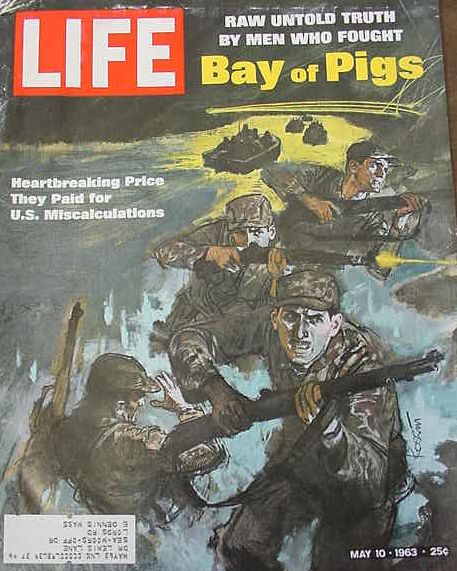
On December 11, 1959, Colonel J.C. King, head of the CIA Western Hemisphere Division, in a secret memorandum to CIA Director Allen Dulles recommended that:
"Thorough consideration be given to the elimination of Fidel Castro. None of those close to Fidel, such as his brother Raul or his companion Che Guevara, have the same mesmeric appeal to the masses. Many informed people believe that the disappearance of Fidel would greatly accelerate the fall of the present Government."
The Caribbean Playground for the CIA
http://alexconstantine.blogspot.com/2008_08_01_archive.html
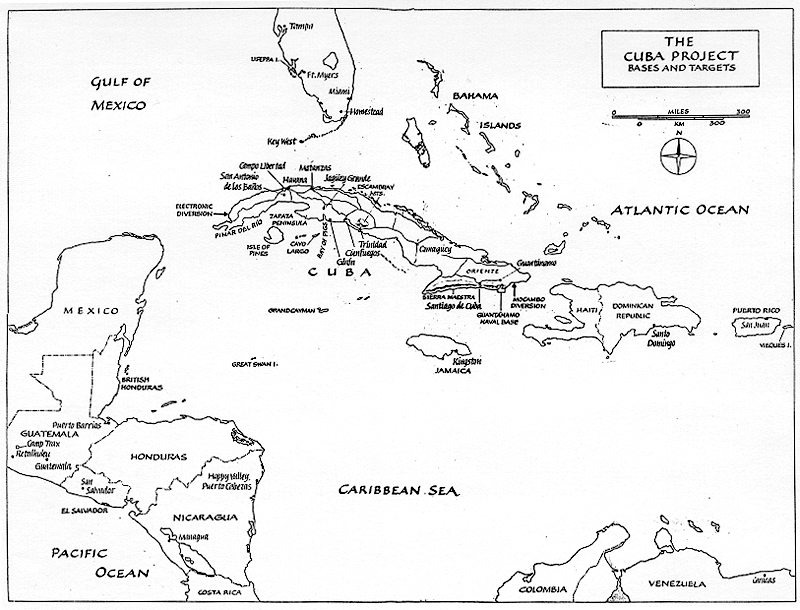
Thursday, August 28, 2008
Lessons Not Learned at the Bay of Pigs
" ... The Bay of Pigs debacle provided ample warning of the dangers inherent in any interventionist foreign policy. ... "
By Howard Jones
8-18-08
Mr. Jones is the author of the just-published book, The Bay of Pigs (Oxford University Press).
On April 17, 1961, a small band of 1500 Cuban exiles invaded their former homeland at the Bay of Pigs in an attempt to overthrow Fidel Castro. Masterminded by the CIA, the operation hinged on covert action, a pre-emptive strike, and, its greatest novelty, an arrangement with the Mafia to assassinate Castro and set off a popular insurrection. The Kennedy administration had taken a new direction in foreign policy, one that rested on assassination and military force. Indeed, the assassination of Castro was just one part of an executive action program under development inside the CIA that aimed at regime change by simply eliminating troublesome state leaders.
[EDITOR: Assassination and regime change were NOT new CIA M.O.; Allen Dulles under Eisenhower's "New Look" began it to avoid overt U.S. military actions]
The landing, as is well known, was a spectacular failure. Castro not only survived the invasion but outlasted ten presidents despite every effort to force him from office-including at least six attempts at assassination.
The question is, what lessons can be extracted from this fiasco of nearly half a century ago? The short answer is that "regime change" has remained a central part of American foreign policy, meaning that the White House failed to learn anything constructive at the Bay of Pigs.
[EDITOR: the reason is that "regime change" works--to further the profits of American secret elite's business operations just as MG Smedley Butler concluded in the 1930s with his book, War is a Racket. RC didn't happen in the 1961 invasion because of military incompetence which we will go into great detail here to elaborate. The American people must regain control of their own government or else it will continue to be used by the secret elites to do things like "regime change"]
We should start with the CIA. The agency had appeared invincible after its covert triumphs in Iran and Guatemala in the 1950s-which was why the Eisenhower administration authorized it to plan a covert program in Cuba that unexpectedly escalated from guerrilla tactics into an amphibious military operation. At this point, such a highly complex enterprise should have come under the purview of the Joint Chiefs of Staff, but the CIA jealously guarded its mandate, telling the Joint Chiefs that this was "not a military operation" and "You will not become involved in this."
The CIA did not use common sense in partnering with the underworld. Its operatives have often recruited help from unsavory characters-but in this case, they went beyond the pale. "Assassination was intended to reinforce the plan," insisted Richard Bissell, chief architect of the operation. Castro's death would make the invasion "either unnecessary or much easier." Castro had stripped the Mafia of its casinos and other businesses, leaving a thirst for vengeance that provided the CIA with a cover story for plausible deniability-the notion, first stated publicly by agency director Allen Dulles, that one can escape culpability for an act by instituting a loose chain-of-command that leaves no trail of evidence.
Plausible deniability, however, was an illusion. The CIA assured the White House that it could deny complicity in one of the most open secrets in the annals of secret history. From the beginning came warning signs. The CIA established a training camp in Guatemala for Cuban dissidents run by U.S. Army Special Forces-all known by the Latin public, American newspapers, Castro's spies, and the Soviet news agency Tass. The invasion would take place on April 17, reported the Soviet embassy in Mexico City to Moscow earlier that month.
Nevertheless, it was an illusion that Kennedy clung to, particularly because political considerations began to take priority over military strategy. Concern about public exposure led him to reject the original plan for a dawn landing at Trinidad, an anti-Castro town of 18,000 inhabitants that offered potential for a popular uprising, several landing docks, geographical isolation from the regime's forces, and close proximity to the Escambray Mountains, home of a thousand anti-Castro guerrillas and a base for future operations. Kennedy, however, opposed a Normandy-like invasion that exposed U.S. involvement and called for an alternate site allowing a quiet, night-time landing dependent on surprise-which undermined the chances of a popular uprising.
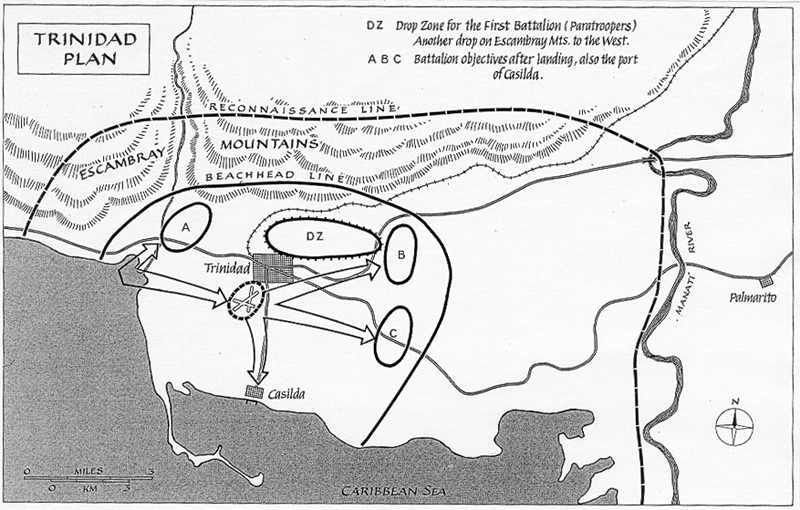
[EDITOR: WTFO? JFK was a PT boat commander. He landed troops on occasion. Trinidad could have been landed on at night. What was going to happen when the sun rose anyway? Ice cream trucks? Here is how Trinidad was to unfold:
utdallas.edu/library/collections/speccoll/Leeker/history/BayOfPigs.pdf
There was still another important change that happened in March 61: The initial plan had been to stage the invasion in the vicinity of Trinidad. "Plan for Landing. The landing plan provided for simultaneous landing at first light on D-Day of two reinforced rifle companies of approximately 200 men each over two beaches southwest of Trinidad and the parachute landing of a company of equal strength immediately north of Trinidad. The remainder of the force was to land over one of the two beaches in successive trips of landing craft. Naval Gunfire. Two LCI each morning mounting eleven 50 caliber machine guns and two 75mm recoilless rifles were to provide naval gunfire support at the beaches. Tactical Air Operations. The plan provided for a maximum effort surprise strike (15 B-26) at dawn of D-1 on all Cuban military airfields followed by repeated strikes at dusk of the same day and at first light of D-Day against any airfields where offensive aircraft were yet operational." 143
However, this "TRINIDAD Plan" was rejected by the Department of State, because to them, it looked like a World War II invasion and would be too obviously attributable to the United States. So on or about 11 March 61, President Kennedy decided that it should not be executed and that possible alternatives should be studied. As according to the new plan any tactical air operations were to be conducted out of an airfield on Cuba, to whom those operations could then be attributed, the Zapata Peninsula of Central Cuba with the new airfield at Playa Girón was chosen, that is the actual Bay of Pigs.
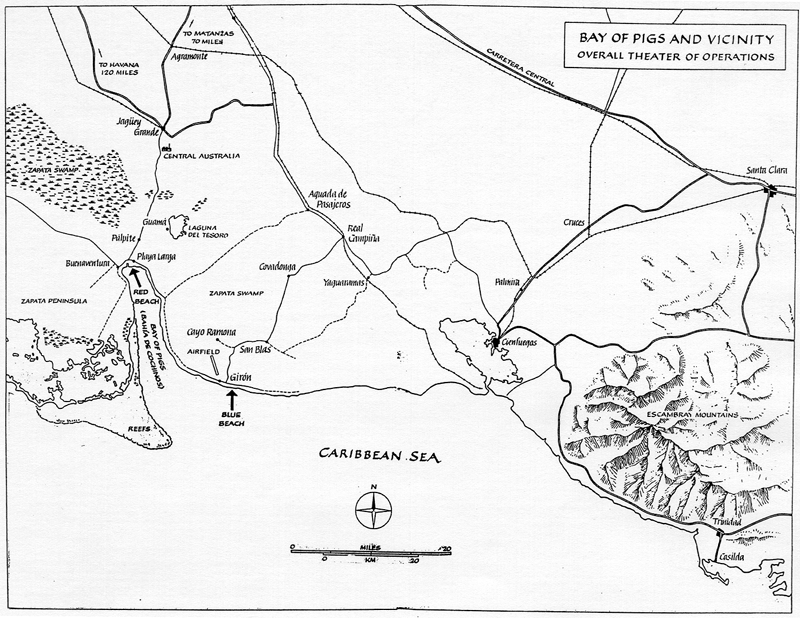
Bissell all too quickly found another landing spot-Zapata, whose focal point for the invasion was much closer to Havana-the Bay of Pigs. But the Zapata peninsula, known as the "Great Swamp of the Caribbean," was sparsely populated, which virtually eliminated an insurrection, and it had no landing docks and was rimmed by shark-infested waters too deep for anchoring in some areas and ribbed with razor-edged coral reefs capable of ripping the bottoms of boats as well as the legs of men. Its beaches wrapped around a million miles of hot tropical wilderness that was overrun with tangled mangrove trees and shrubs, nearly impenetrable thickets, alligators and crocodiles, ferocious pigs, poisonous snakes, voracious insects, and millions of sharp-shelled, toxic red land crabs that in the spring of every year (the time of the invasion) scurried out of the jungle, carpeting the passageways and the beaches in their haste to breed in the sea. Furthermore, the landing site lay eighty miles from the Escambrays, no longer affording a sanctuary because of distance and the deadly swamp lying between. If Bissell was aware of these problems, he did not alert the president to them.
The strategists underestimated the enemy. The CIA and the Joint Chiefs assumed that Castro's forces were lukewarmly loyal and too poorly trained to run the tanks, fight effectively, and pilot his small air force of B-26s, Sea Furies, and T-33 jet trainers. To assure success, the CIA planned two days of pre-invasion strikes by its own B-26s-D-2 and D-1 bombing and strafing that would disable Castro's air and ground forces-followed by D-Day air cover. But Kennedy cut the number of planes in the initial D-2 strikes from sixteen to eight, and then canceled the D-1 operations. Finally, he called off the air cover for D-Day-all to hide the American hand and maintain plausible deniability.
Moreover, the Kennedy administration did not seriously consider the opposition's arguments that even success, which was unlikely, would damage America's international stature. The president dismissed the warnings of Ambassador to India and close confidant John Kenneth Galbraith, Senators J. William Fulbright and George Smathers, Undersecretary of State Chester Bowles, and former Secretary of State Dean Acheson. White House adviser and historian Arthur M. Schlesinger Jr. wrote extensive memos forecasting a public relations catastrophe that would undermine the good will and credibility amassed by the young president in his first months in office. Regardless of the outcome at the Bay of Pigs, the United States would stand as the imperial colossus from the north.
Instead, the White House relied on luck and ingenuity to smooth over the cracks in the plan. Kennedy ignored his own instincts in succumbing to his unusual attraction to guerrilla warfare and the James Bond mystique. Still clinging to the fig leaf of plausible deniability and trusting in the CIA and Pentagon experts as well as in his Midas touch, the president approved the plan. So confident were the planners in a last-minute resort to direct U.S. military action if necessary that they drew up no exit strategy in the event of failure.
In a three-day battle, everything that could go wrong for the Cuban brigade did.
Kennedy's decision to change the landing site from Trinidad to Zapata, and to call off the D-1 and D-Day air strikes doomed the operation from the start. The first move eliminated any chance of a popular uprising; the second left the invasion force with no air cover. Not only did the sharply curtailed D-2 strikes warn Castro of an invasion, but the D-1 and D-day cancellations surrendered the skies to his planes and permitted the more expeditious arrival at the battle scene of his Russian tanks and thousands of militia.
Crucial to the outcome was the absence of a mass uprising. The CIA had not established a network of connections with the local populace; Castro had broken the back of any potential insurrection by clapping thousands of suspects into prison; the invasion had occurred in a place remote and isolated from populated areas; the guerrillas in the mountains were poorly armed and prepared; and the poison plot had failed when the potential assassin feared discovery and sought asylum in the Mexican embassy in Havana.
The most incisive appraisal of the invasion came from Castro, who attributed the brigade's failure to lack of air cover. The rebel planes dropped their airborne battalions too close to the beaches, allowing his tanks and artillery to enter the three causeways leading to the battle sites. The landing spot was superb in military terms, but only if the invaders had closed the causeways and with air protection held the beachhead long enough to build a military and naval base, announce a provisional government, and seek recognition and outside aid. They had a "good plan, poorly executed."
Kennedy's nightmarish experience at the Bay of Pigs certainly helped him stand up to the Soviets in the ensuing Cuban missile crisis; yet one doubts that such a crisis would have occurred without the Bay of Pigs. It is questionable whether Soviet leader Nikita Khrushchev would have challenged him at Vienna to pull out of Berlin, but it is inconceivable that he would have risked placing missiles in Cuba had the young president thrown out an invasion plan pockmarked with flaws and aimed at a country posing no threat to U.S. security. Indeed, the Kennedys became so obsessed with Castro that during the missile crisis they spent valuable time planning his elimination out of vengeance for his welcoming the missiles.
But-and here is the critical point-both the president and his brother ignored the lessons left by the Bay of Pigs. Less than two weeks after the invasion and months before the missile crisis, the president gave contingent approval to an air- and marine-force assault on the Havana area followed by the landing of 60,000 American troops. While the Joint Chiefs worked out a detailed plan in the fall of 1961, Kennedy appointed CIA legend Edward Lansdale to head a top-secret program code-named Operation MONGOOSE which, with Robert Kennedy as its real leader, sought to eliminate Castro by any means necessary-including assassination. When MONGOOSE failed and White House attention turned to other trouble spots, the CIA tied the executive action plan to a revived collaboration with the Mafia. In the meantime, both before and after the missile crisis, the agency conspired with a potential assassin to eliminate Castro-Army Major Rolando Cubela, an associate of Castro who had become disenchanted with the political direction of the revolution. On the very day president Kennedy was assassinated in Dallas, Cubela (code-named Amlash) was meeting in Paris with a CIA operative, making plans for killing Castro either by sniper fire or in the course of a military coup.
President Kennedy soon afterward removed Bissell from his CIA post but praised his "enduring legacy." Bissell had left a lasting mark on foreign policy-but not the type the president had in mind. In a statement that revealed an unintended double meaning if not a healthy dose of naiveté, Kennedy administration insider Richard Goodwin later noted that "Latin America was considered a kind of training ground for Southeast Asia." Indeed, covert tactics aimed at regime change became the norm in Africa and the Middle East as well as in Latin America and Southeast Asia as Washington became enamored of what it could accomplish by clandestine and deniable means.
The Bay of Pigs debacle provided ample warning of the dangers inherent in any interventionist foreign policy. Yet the warning remains unheeded-as shown in Vietnam and Iraq.
http://hnn.us/articles/52561.html
Casualties and losses
FAR
176 killed (Regular Army)
4,000-5,000 killed, missing, or wounded
(Militias and armed civilian fighters)
Assault Brigade 2506
118 killed
1,201 captured
Background
AmeroNazi Richard Nixon as Vice President concocted the whole "Bay of Pigs" thing to regain Mafia night clubs and sugar and tobacco money-makers back into the hands of his Nazi Banker and Mob puppet masters.
historyofcuba.com/history/baypigs/pigs3.htm
Nixon hatches plan
INVASION at Bay of Pigs
"Events are the ephemera of history."
Fernand Braudel
Menu | Intro | The Plan | Invasion | Victory / Defeat | Aftermath | References
The Plan
Vice President Richard Nixon was devoted to the idea of opposing Castro as early as April 1959, when Castro visited the U.S. as a guest of the American Society of Newspaper Editors. "If he's not a communist," said Nixon, "he certainly acts like one." On March 17 1960, President Eisenhower approved a CIA plan titled "A Program of Covert Action against the Castro Regime."
The plan included: 1) the creation of a responsible and unified Cuban opposition to the Castro regime located outside of Cuba, 2) the development of a means for mass communication to the Cuban people as part of a powerful propaganda offensive, 3) the creation and development of a covert intelligence and action organization within Cuba which would respond to the orders and directions of the exile opposition, and 4) the development of a paramilitary force outside of Cuba for future guerrilla action. These goals were to be achieved "in such a manner as to avoid the appearance of U.S. intervention."
Official diplomatic relations were broken on January 1961, nine months after the plan was approved.
The operation came to life when Eisenhower approved an initial budget of $4,400,000. The budget included $950,000 for political action; $1,700,000 for propaganda; $1,500,000 for paramilitary; and $250,000 for intelligence collection. The actual invasion, a year later, would cost U.S. taxpayers over $46 million.
In a meeting at the White House on January 3 1961, described by Richard Bissell, CIA Director of Plans, in his book Memoirs of a Cold Warrior: from Yalta to Bay of Pigs, Eisenhower "seemed to be eager to take forceful action against Castro, and breaking off diplomatic relations appeared to be his best card. He noted that he was prepared to 'move against Castro' before Kennedy's inauguration on the twentieth if a 'really good excuse' was provided by Castro. 'Failing that,' he said, 'perhaps we could think of manufacturing something that would be generally acceptable.' ...This is but another example of his willingness to use covert action-specifically to fabricate events-to achieve his objectives in foreign policy."
By the time Kennedy took office in January 1961, he had already made serious commitments to the Cuban exiles, promising to oppose communism at every opportunity, and supporting the overthrow of Castro. During the campaign, Kennedy had repeatedly accused Eisenhower of not doing enough about Castro.
Eisenhower, Kennedy and other high-ranking U.S. officials continually denied any plans to attack Cuba, but as early as October 31 1960, Cuban Foreign Minister Raúl Roa, in a session at the U.N. General Assembly, was able to provide details on the recruitment and training of the Cuban exiles, whom he referred to as mercenaries and counterrevolutionaries. [The CIA recruits were paid $400 a month to train, with an additional allotment of $175 for their wives and more for their children.]
The original plan called for a daytime landing at Trinidad, a city on the southern coast of Cuba near the Escambray Mountains, but Kennedy thought the plan exposed the role of the United States too openly, and suggested a nighttime landing at Bay of Pigs, which offered a suitable air-strip on the beach from which bombing raids could be operated. Once the bay was secured, the provisional Cuban government-in-arms set up by the CIA would be landed and immediately recognized by the U.S. as the island's legitimate government. This new government would formally request military support and a new "intervention" would take place.
Bissell wrote: "it is hard to believe in retrospect that the president and his advisers felt the plans for a large-scale, complicated military operation that had been ongoing for more than a year could be reworked in four days and still offer a high likelihood of success. It is equally amazing that we in the agency agreed so readily."
A nighttime amphibious landing (which, according to Bissell had only been accomplished successfully once in WWII) diminished the possibility that a mass uprising would be able to join the invading forces. In addition, the new location made it practically impossible to retreat into the Escambray Mountains.
The plan, however, seemed to breed what Néstor T. Carbonell describes in the book, And the Russians Stayed: the Sovietization of Cuba, as infectious optimism. "Castro's fledgling air force was to be destroyed prior to the invasion," he writes. "Enemy troops, trucks, and tanks would not be able to reach the brigade; they would be blasted from the air. To allay any fears of a Castro counteroffensive, the CIA briefer asserted that 'an umbrella' above would at all times guard the entire operation against any Castro fighter planes that might remain operational."
Once Kennedy became aware of the plan, opposition to the invasion was subtly discouraged. Various memos and notes kept from meetings prior to the invasion warned of potential problems and legal ramifications. At a meeting on January 28 the Chairman of the Joint Chiefs of Staff spoke strongly against invasion on the grounds that Castro's forces were already too strong. At the same meeting, the Secretary of Defense estimated that all the covert measures planned against Castro, including propaganda, sabotage, political action and the planned invasion, would not produce "the agreed national goal of overthrowing Castro."
On March 29 Senator Fulbright gave Kennedy a memo stating that "to give this activity even covert support is of a piece with the hypocrisy and cynicism for which the United States is constantly denouncing the Soviet Union in the United Nations and elsewhere. This point will not be lost on the rest of the world-nor on our own consciences."
A three-page memo from Under Secretary of State Chester A. Bowles to Secretary of State Dean Rusk on March 31 (Foreign Relations of the United States, Cuba, 1961-1963, Doc. No. 75, page 178) argued strongly against the invasion, citing moral and legal grounds. By supporting this operation, he wrote, "we would be deliberately violating the fundamental obligations we assumed in the Act of Bogota establishing the Organization of American States."
At a meeting on April 4 in a small conference room at the State Department, Senator Fulbright verbally opposed the plan, as described by Arthur Schlesinger in the Pulitzer Prize-winning book A Thousand Days: "Fulbright, speaking in an emphatic and incredulous way, denounced the whole idea. The operation, he said, was wildly out of proportion to the threat. It would compromise our moral position in the world and make it impossible for us to protest treaty violations by the Communists. He gave a brave, old-fashioned American speech, honorable, sensible and strong; and he left everyone in the room, except me and perhaps the President, wholly unmoved."
Five days before D-Day, at a press conference on April 12, Kennedy was asked how far the U.S. would go to help an uprising against Castro. "First," he answered, "I want to say that there will not be, under any conditions, an intervention in Cuba by the United States Armed Forces. This government will do everything it possibly can... I think it can meet its responsibilities, to make sure that there are no Americans involved in any actions inside Cuba... The basic issue in Cuba is not one between the United States and Cuba. It is between the Cubans themselves."
"One further factor no doubt influenced him," wrote Schlesinger, "the enormous confidence in his own luck. Everything had broken right for him since 1956. He had won the nomination and the election against all the odds in the book. Everyone around him thought he had the Midas touch and could not lose. Despite himself, even this dispassionate and skeptical man may have been affected by the soaring euphoria of the new day."
Overall Operation ZAPATA military commander was USMC Colonel Jack Hawkins (1920-):
Colonel Jack Hawkins USMC
spartacus.schoolnet.co.uk/JFKhawkins.htm
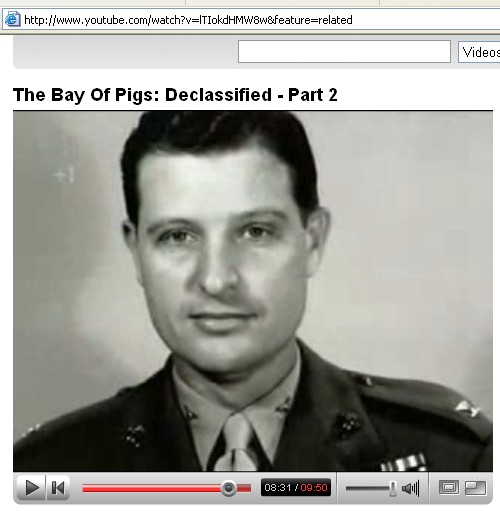
Jack Hawkins was born in Roxton, Texas in 1920. His family moved to Fort Worth and was a student at the local high school. After graduating from the United States Naval Academy as a second lieutenant he joined the U.S. marines in 1939. He spent time at the marine corps basic school for officers before being sent to China where he served with the fourth marines in Shanghai.
During the Second World War he was captured by the Japanese at Corregidor in the Philippines and spent 11 months as a prisoner of war. He escaped with several other Americans and two Filipino convicts who served as guides, and joined a guerrilla unit for seven months before getting to Australia via submarine in November 1943. In 1945 Hawkins was involved in the invasion of Okinawa.
After the war Hawkins served three years in Venezuela as adviser to the Venezuelan marine corps before returning to Camp Lejeune, North Carolina. Hawkins also took part in the Korean War and helped plan the battalion landing plan at Inchon. He then served for three years as an instructor on amphibious landings in marine corps schools. This was followed by a post at the marine corps school in Quantico.
Promoted to full colonel in 1955, he became commander of the Amphibious Forces at Little Creek, Virginia. In September, 1960, Colonel Hawkins was assigned to the Central Intelligence Agency (CIA). He joined the Cuba Task Force and was given direct responsibility for military training operations. Hawkins was told "that the CIA was planning to land some exile troops in Cuba and they wanted a marine officer with background in amphibious warfare to help them out with this project...."
The Bay of Pigs operation was directed out of the "Miami Station" (also known as "JM/WAVE"), which was the CIA's largest station worldwide. It housed 200 agents who handled approximately 2,000 Cubans. Robert Reynolds was the CIA's Miami station chief from September 1960 to October 1961. He was replaced by career-CIA officer Theodore Shackley, who oversaw Operation Mongoose, Operation 40 (including Porter Goss, Felix Rodriguez, Barry Seal), and others. When Bush became CIA Director in 1976 he appointed Ted Shackley as Deputy Director of Covert Operations. When Bush became Vice President in 1981, he appointed Donald Gregg as his National Security Advisor.
Zapata Oil
Coincidence that entire operation called Zapata?
Oil well platforms used to launch attacks on Cuba: is this to circumvent Lodge act since a platform isn't "U.S. territory"?
Coincidence that operation shifted from Trinidad area in mountains where likely to be successful to swampy Zapata penninsula? WTFO? OPSEC?
http://en.wikipedia.org/wiki/Zapata_Corporation
Zapata Corporation
Zapata Corporation (NYSE: ZAP) is a holding company based in Rochester, New York and originating from an oil company started by a group including the former United States president George H. W. Bush. Various writers have alleged links between the company and the United States Central Intelligence Agency.
Contents
1. Early business history
2. Connections with the CIA
2.1 FBI and CIA memos
2.2 Allegations by former CIA staff
2.3 Allegations of the involvement of a former CIA officer in the foundation of Zapata
2.4 Bay of Pigs
2.5 Watergate
2.6 Iran-Contra affair
3. Decline
4. Glazer era
5. References
5.1 Public records
5.2 Zapata
5.3 George Bush
5.4 CIA
5.5 Others
6. External links
Early business history
The company traces its origins to Zapata Oil, founded in 1953 by future-U.S. President George H. W. Bush, along with his business partners John Overbey, Hugh Liedtke, Bill Liedtke, and Thomas J. Devine. Bush and Thomas J. Devine were oil-wildcatting associates.[1] Their joint activities culminated in the establishment of Zapata Oil.[1] The initial $1 million investment for Zapata was provided by the Liedtke brothers and their circle of investors, by Bush's father and maternal grandfather-Prescott Bush and George Herbert Walker, and his family circle of friends.
Hugh Liedtke was named president, Bush was vice president; Overbey soon left. In 1954, Zapata Off-Shore Company was formed as a subsidiary of Zapata Oil, with Bush as president of the new company. He raised some startup money from Eugene Meyer, publisher of the Washington Post, and his son-in-law, Phillip Graham.[2][3]
Zapata Off-Shore accepted an offer from an inventor, R. G. LeTourneau, for the development of a mobile but secure drilling rig. Zapata advanced him $400,000, which was to be refundable if the completed rig did not function. If it did function, LeTourneau would get an additional $550,000 together with 38,000 shares of Zapata Off-Shore common stock.
Zapata Corporation split in 1959 into independent companies Zapata Petroleum, headed by the Liedtkes,and Zapata Off-Shore, headed by Bush funded with $800,000.[4] Bush moved his offices and family that year from Midland, Texas to Houston. In 1963, Zapata Petroleum merged with South Penn Oil and other companies to become Pennzoil.
According to a George H. W. Bush-biographer Nicholas King, in the late-1950s and early-1960, Zapata Off-Shore concentrated its business in the Caribbean, the Gulf of Mexico, and the Central American coast.[5] The U.S. government began to auction off mineral rights to these areas in 1954. In 1958, drilling contracts with the seven large U.S. oil producers included wells 40 miles (64 km) north of Isabela, Cuba, near the island Cay Sal. In July 1959, Cuba's Batista government was overthrown by Fidel Castro. Zapata also won a contract with Kuwait.
In 1962, Bush was joined in Zapata Off-Shore by a fellow Yale Skull and Bones member, Robert Gow. By 1963, Zapata Off-Shore had four operational oil-drilling - Scorpion (1956), Vinegaroon (1957), Sidewinder, and (in the Persian Gulf) Nola III.
In 1960, Jorge Diaz Serrano of Mexico was put in touch with Bush by Dresser. They created a new company, Perforaciones Marinas del Golfo, aka Permargo, in conjunction with Edwin Pauley of Pan American Petroleum, with whom Zapata had a previous offshore contract. The deal with Pemargo is not mentioned in Zapata's annual reports. A Bush spokesman in 1988 claimed the deal only lasted seven months, from March to September 1960. Zapata sold Nola I to Pemargo in 1964.
By 1964, Zapata Off-Shore had a number of subsidiaries, including: Seacat-Zapata Offshore Company (Persian Gulf), Zapata de Mexico, Zapata International Corporation, Zapata Mining Corporation, Zavala Oil Company, Zapata Overseas Corporation, and a 41% share of Amata Gas Corporation.
Bush ran for the United States Senate in 1964 and lost; he continued as president of Zapata Off-Shore until 1966, when he sold his interest to his business partner, Robert Gow, and ran for the U.S. House of Representatives.
In 1966, William Stamps Farish III, age 28, joined the board Zapata Board.
Zapata's filing records with the U.S.Securities and Exchange Commission are intact for the years 1955-1959, and again from 1967 onwards. However, records for the years 1960-1966 are missing. The commission's records officer stated that the records were inadvertently placed in a session file to be destroyed by a federal warehouse and that a total of 1,000 boxes were pulped in this procedure. The destruction of records occurred either in October 1983 (according to the records officer) or in 1981 shortly after Bush became Vice President of the United States (according to, Wison Carpenter, a record analyst with the commission).
Connections with the CIA
Various writers have suggested that Zapata Off-Shore, and Bush in particular, cooperated with the Central Intelligence Agency (CIA) beginning in the late 1950s.
FBI and CIA memos
Memo from FBI Special Agent in Texas, regarding call by "GHW Bush of Zapata Off-Shore Drilling Company" received 75 minutes after JFK's murder Memo from J. Edgar Hoover, referring to "Mr. George Bush of the CIA", briefed 24 hours after JFK's murder " [2] Federal Bureau of Investigation (FBI) memoranda have been offered to show connections between the CIA and George H. W. Bush during his time at Zapata. The first memo names Zapata Off-Shore and was written by FBI Special Agent Graham Kitchel on 22 November 1963, regarding the John F. Kennedy assassination at 12:30 p.m. CST that day. It begins: "At 1:45 p.m. Mr. GEORGE H. W. BUSH, President of the Zapata Off-Shore Drilling Company, Houston, Texas, residence 5525 Briar, Houston, telephonically furnished the following information to writer. .. BUSH stated that he wanted to be kept confidential. .. was proceeding to Dallas, Texas, would remain in the Sheraton-Dallas Hotel."
A second FBI memorandum, written by J. Edgar Hoover, identifies "George Bush" with the CIA. It is dated 29 November 1963 and refers to a briefing given Bush on 23 November. The FBI Director describes a briefing about JFK's murder "orally furnished to Mr. George Bush of the Central Intelligence Agency. .. [by] this Bureau" on " December 20, 1963.
When this second memorandum surfaced during the 1988 presidential campaign, Bush spokespersons (including Stephen Hart) said Hoover's memo referred to another George Bush who worked for the CIA.[6] CIA spokeswoman Sharron Basso suggested it was referring to a George William Bush. However, others described this G. William Bush as a "lowly researcher" and "coast and beach analyst" who worked only with documents and photos at the CIA in Virginia from September 1963 to February 1964, with a low rank of GS-5.[7][8][9] Moreover, this G. William Bush swore an affidavit in federal court denying that Hoover's memo referred to him:
"I have carefully reviewed the FBI memorandum to the Director, Bureau of Intelligence and Research, Department of State dated November 29, 1963 which mentions a Mr. George Bush of the Central Intelligence Agency. ... I do not recognize the contents of the memorandum as information furnished to me orally or otherwise during the time I was at the CIA. In fact, during my time at the CIA, I did not receive any oral communications from any government agency of any nature whatsoever. I did not receive any information relating to the Kennedy assassination during my time at the CIA from the FBI. Based on the above, it is my conclusion that I am not the Mr. George Bush of the Central Intelligence Agency referred to in the memorandum." (United States District Court for the District of Columbia, Civil Action 88-2600 GHR, Archives and Research Center v. Central Intelligence Agency, Affidavit of George William Bush, September 21, 1988.)
Allegations by former CIA staff
U.S. Army Brigadier General Russell Bowen wrote that there was a cover-up of Zapata's CIA connections:
Bush, in fact, did work directly with the anti-Castro Cuban groups in Miami before and after the Bay of Pigs invasion, using his company, Zapata Oil, as a corporate cover for his activities on behalf of the agency. Records at the University of Miami, where the operations were based for several years, show George Bush was present during this time.[10]
Another writer[11] quotes four former U.S. intelligence officials saying Bush was involved with the CIA prior to the Bay of Pigs:
Robert T. Crowley and William Corson of the CIA:
Bush was officially considered a CIA business asset, according to Crowley and Corson. "George's insecurities were clay to someone like Dulles", William Corson said. To recruit young George Bush, Robert Crowley explained, Dulles convinced him that "he could contribute to his country as well as get help from the CIA for his overseas business activities." [Bush] was, according to Corson, "perfect at talent spotting and looking at potential recruits for the CIA. You have to remember, we had real fears of Soviet activity in Mexico in the 1950s. Bush was one of many businessmen that would be reimbursed for hiring someone the CIA was interested in, or simply carrying a message." --Chapter 2 page 14
John Sherwood of the CIA:
Bush was at first a tiny part of OPERATION MONGOOSE, the CIA's code name for their anti-Castro operations. According to the late John Sherwood, "Bush was like hundreds of other businessmen who provided the nuts-and-bolts assistance such operations require... What they mainly helped us with was to give us a place to park people that was discreet." --Chapter 2 page 16
An anonymous official connected to "Operation MONGOOSE":
George Bush would be given a list of names of Cuban oil workers we would want placed in jobs... The oil platforms he dealt in were perfect for training the Cubans in raids on their homeland. --Chapter 2 page 16
John Loftus, in his book Secret War quotes former U.S. intelligence officials reporting the same story:
The Zapata-Permargo deal caught the eye of Allan Dulles, who the "old spies" report was the man who recruited Bush's oil company as a part time purchasing front for the CIA. Zapata provided commercial supplies for one of Dulles' most notorious operations: the Bay of Pigs Invasion. --Chapter 16 page 368
Finally, according to Cuban intelligence official Fabian Escalante in The Cuba Project: CIA Covert Operations 1959-62, Jack Crichton and George H.W. Bush raised funds for the CIA's Operation 40.
"Tracy Barnes functioned as head of the Cuban Task Force. He called a meeting on January 18, 1960, in his office in Quarters Eyes, near the Lincoln Memorial in Washington, which the navy had lent while new buildings were being constructed in Langley. Those who gathered there included the eccentric Howard Hunt, future head of the Watergate team and a writer of crime novels; the egocentric Frank Bender, a friend of Trujillo; Jack Esterline, who had come straight from Venezuela where he directed a CIA group; psychological warfare expert David A. Phillips, and others. The team responsible for the plans to overthrow the government of Jacobo Arbenz in Guatemala in 1954 was reconstituted, and in the minds of all its members this would be a rerun of the same plan. Barnes talked at length of the goals to be achieved. He explained that Vice-President Richard Nixon was the Cuban "case officer", and had assembled an important group of businessmen headed by George Bush [Snr.] and Jack Crichton, both Texas oilmen, to gather the necessary funds for [Operation 40]. Nixon was a protege of Bush's father [Prescott], who in 1946 had supported Nixon's bid for congress. In fact, [Presott] Bush was the campaign strategist who brought Eisenhower and Nixon to the presidency of the United States. With such patrons, Barnes was certain that failure was impossible." --Pages 43-44
Fabian Escalante was in the Department of State Security (G-2) in Cuba in 1960. At the time of the Bay of Pigs, Escalante was head of a counter-intelligence unit and was part of a team investigating a CIA operation called Sentinels of Liberty, an attempt to recruit Cubans willing to work against Castro. His information about Bush apparently comes from a counterintelligence operation against Tracy Barnes of the CIA.
Allegations of the involvement of a former CIA officer in the foundation of Zapata
On January 8, 2007, newly released internal CIA documents revealed that Zapata had in fact emerged from Bush's collaboration with a covert CIA officer in the 1950s. According to a CIA internal memo dated November 29, 1975, Zapata Petroleum began in 1953 through Bush's joint efforts with Thomas J. Devine, a CIA staffer who had resigned his agency position that same year to go into private business, but who continued to work for the CIA under commercial cover. Devine would later accompany Bush to Vietnam in late 1967 as a "cleared and witting commercial asset" of the agency, acted as his informal foreign affairs advisor, and had a close relationship with him through 1975.[12]
Bay of Pigs
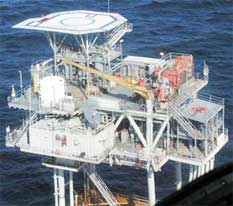
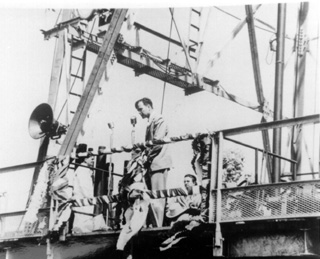
George Bush on Zapata oil rig, c.1963The CIA codename for the Bay of Pigs invasion of April 1961 was "Operation ZAPATA".[13] Through his work with Zapata Off-Shore, Bush is alleged to have come into contact with Felix Rodriguez, Barry Seal, Porter Goss, and E. Howard Hunt, around the time of the Bay of Pigs operation.[14]
CIA liaison officer Col. L. (Leroy) Fletcher Prouty alleges[15] that Zapata Off-Shore provided or was used as cover for two of the ships used in the Bay of Pigs invasion: the Barbara J and Houston. Prouty claims he delivered two ships to an inactive Naval Base near Elizabeth City, North Carolina, for a CIA contact and he suspected very strongly that George Bush must have been involved:
They asked me to see if we could find - purchase - a couple of transport ships. We got some people that were in that business, and they went along the coast and they found two old ships that we purchased and sent down to Elizabeth City and began to load with an awful lot of trucks that the Army was sending down there. We deck-loaded the trucks, and got all of their supplies on board. Everything that they needed was on two ships. It was rather interesting to note, looking back these days, that one of the ships was called the Houston, and the other ship was called the Barbara J. Colonel Hawkins had renamed the program as we selected a name for the Bay of Pigs operation. The code name was "Zapata." I was thinking a few months ago of what a coincidence that is. When Mr. Bush graduated from Yale, back there in the days when I was a professor at Yale, he formed an oil company, called "Zapata", with a man, Lieddke, who later on became president of Pennzoil. But the company that Lieddke and Mr. Bush formed was the Zapata Oil Company. Mr. Bush's wife's name is Barbara J. And Mr. Bush claims as his hometown Houston, Texas. Now the triple coincidence there is strange; but I think it's interesting. I know nothing about its meaning. But these invasion ships were the Barbara J and the Houston, and the program was "Zapata." George Bush must have been somewhere around.[16]
John Loftus writes: "Prouty's credibility, however has been widely attacked because of his consultancy to Oliver Stone's film JFK." but notes on page 598 that: "While his credibility has suffered greatly because of his consultancy to Oliver Stone's film JFK, his recollections about the CIA supply mission have been confirmed by other sources."[17]
Nevertheless, researcher James K. Olmstead claims to have discovered a CIA memorandum which states that the boats were leased, not purchased, by the Garcia Line Corporation with offices in Havana and New York City. The owners were Alfredo Garcia and his five sons. The CIA was using the Rio Escondido for "exfiltrating anti-Castro leaders......prior to 1961 BOP planning." It had brought out Nino Diaz, and Manolo Ray. Its captain Gus Tirado was well known to the CIA. Eduardo Garcia met with two CIA agents in NYC and D.C. to arrange the use of the Garcia ships for the invasion. The alleged price was $600.00 per day per ship plus fuel, food and personnel.
Eduardo selected and hired 30 men who were "executioners for Batista" Miro Cardona of the Frente and the CIA did not like the choice of men hired to protect the Garcia ships. "Nobody questioned that Eduardo was coming along with the expedition. "I'm going to be in charge of my ships", he said.
Memorandum From the Chief of WH/4/PM, Central Intelligence Agency (Hawkins) to the Chief of WH/4 of the Directorate for Plans (Esterline) The Barbara J (LCI), now enroute to the United States from Puerto Rico, requires repairs which may take up to two weeks for completion. The sister ship, the Blagar, is outfitting in Miami, and its crew is being assembled. It is expected that both vessels will be fully operational by mid-January at the latest. In view of the difficulty and delay encountered in purchasing, outfitting and readying for sea the two LCI's, the decision has been reached to purchase no more major vessels, but to charter them instead. The motor ship, Rio Escondido (converted LCT) will be chartered this week and one additional steam ship, somewhat larger, will be chartered early in February. Both ships belong to a Panamanian Corporation controlled by the Garcia family of Cuba, who are actively cooperating with this Project. These two ships will provide sufficient lift for troops and supplies in the invasion operation.
Felix Rodriguez, Porter Goss, Barry Seal, and others, Mexico City 22 January 1963
The Bay of Pigs operation was directed out of the "Miami Station" (also known as "JM/WAVE"), which was the CIA's largest station worldwide. It housed 200 agents who handled approximately 2,000 Cubans. Robert Reynolds was the CIA's Miami station chief from September 1960 to October 1961. He was replaced by career-CIA officer Theodore Shackley, who oversaw Operation MONGOOSE, Operation 40 (including Porter Goss, Felix Rodriguez, Barry Seal), and others. When Bush became CIA Director in 1976 he appointed Ted Shackley as Deputy Director of Covert Operations. When Bush became Vice President in 1981, he appointed Donald Gregg as his National Security Advisor.
Kevin Phillips[18] discusses George Bush's "highly likely" peripheral role in the Bay of Pigs events. He points to the leadership role of Bush's fellow Skull & Bones alumni in organizing the operation. He notes an additional personal factor for Bush: the Walker side of the family (who initially funded Zapata Corporation) had apparently lost a small fortune when Fidel Castro nationalized their West Indies Sugar Co. Edwin Pauley was "known for CIA connections", according to Phillips, it was Pauley who put Pemargo's Diaz and Bush together.
Watergate
Phillips and others have detailed subsequent involvement by Zapata associates in the Watergate affair. George Bush, as Richard Nixon's ambassador to the United Nations, allegedly urged his former Zapata partner Bill Liedtke to launder $100,000 to the White House plumbers. After Nixon's 1972 re-election, he appointed Bush as Chairman of the Republican Party National Committee. When the laundering was exposed, those involved included several CIA officials: E. Howard Hunt, Frank Sturgis, Eugenio Martínez, Virgilio González, and Bernard Barker. A discussion of the laundering appears on the Nixon tapes for June 23, 1973.[19]
Iran-Contra affair
Note from Bush to Rodriguez, December 1988
Michael Maholy alleges[20] that Zapata Off-Shore was used as part of a CIA drug-smuggling ring to pay for arming Nicaraguan Contras in 1986-1988, including Rodriguez, Eugene Hasenfus and others. Mahony claims Zapata's oil rigs were used as staging bases for drug shipments, allegedly named "Operation Whale Watch." Mahony allegedly worked for Naval Intelligence, U.S. State Department and CIA for two decades.
Decline
Zapata, under Robert Gow's direction, acquired a controlling interest in the United Fruit Company in 1969. Robert's father, Ralph Gow, was on United Fruit's board of directors.
Gow apparently left Zapata in 1970. He took with him from Zapata Peter C. Knudtzon. Ties to the Bush family continued. In 1971 both Jeb Bush and George W. Bush worked for Gow's new company, Stratford of Texas (also known as Stratford of Houston). Stratford imported tropical plants. According to Knudtzon, George W. Bush reportedly flew for Stratford to Florida and Guatemala.[21] Stratford evidently had ties to a large commercial plantation in La Democracia, Huehuetenango, Guatemala.
In the 1970s, under chairman and CEO William Flynn, Zapata expanded its business to include subsidiaries in dredging, construction, coal mining, copper mining and fishing.
By the late 1970s, saddled with weak operations, high debt and low return on investment, the company again began undergoing changes in management and direction. Lead by John Mackin, who succeeded William Flynn, the company began selling off some of those businesses and refocused on offshore oil and gas exploration and production.
In 1982 chief operating officer Ronald Lassiter assumed the role of CEO, and presided over a decade of loss-making brought on by the collapse of oil prices. Zapata Off-shore became Zapata Corporation in 1982. Its stock performed poorly. By 1986 Zapata was one of the bad loans that shook the foundations of San Francisco-based Bank of America, with a debt of more than $500 million and a fiscal year loss of $250 million. The company announced several restructurings during those years and managed to stave off bankruptcy, but continued to incur major losses. In 1990 the oil drilling company proposed selling its entire fleet of offshore drilling rigs to focus solely on fishing. The company had not had a profitable quarter in more than five years.
Zapata Offshore continued on as an offshore drilling company until the early 1990s when it was purchased by Arethusa Offshore which a few years later sold the rigs to Diamond Offshore. Still struggling with debt by 1993, Zapata signed a deal with Norex America to raise more than $100 million through a loan and stock sale. But financier Malcolm Glazer, owner of the Tampa Bay Buccaneers NFL franchise and at the time owner of 40 percent of Zapata, did not want his holdings diluted and filed a lawsuit to block the deal.
Glazer era
By 1994 the company had come under Glazer's control, after a proxy fight. Glazer became chairman of Zapata, replacing Ronald Lassiter, and in 1995 Avram Glazer was named CEO and president of Zapata. De facto headquarters moved from Houston to Rochester, New York. It no longer engaged in exploration, but owned several natural gas service companies. It also produced protein products from the menhaden fish. In subsequent years Zapata sold its energy-related businesses and focused on marine protein.
Between 1998 and 2000, Zapata tried to position itself as an internet media company under the "zap.com" name. The company's stock boomed and crashed along with other dot-coms, and in 2001 the company conducted a 1 for 10 reverse stock split. The venture was cited by many investment journalists as an example of a company jumping on the internet bandwagon without any relevant experience. This period is probably best remembered for Zapata's unsolicited (and unsuccessful) takeover bid of the Excite internet portal.[22]
During this period Zapata also built up a controlling stake in Safety Components International, a manufacturer of air bag fabrics and cushions.
On December 2, 2005, Zapata Corporation Chairman, Avie Glazer, announced the sale of 4,162,394 shares, 77.3%, of Safety Components International to Wilbur L. Ross, Jr. for $51.2 million. The company sold its remaining stock in Omega Proteine on December 1, 2006, leaving it with no active subsidiary.
References
1.^ a b Withheld (sanitized, unclassified document), Central Intelligence Agency (29 November 1975). "Memorandum: To: Deputy Director of Operations; Subject: Messrs. George Bush and Thomas J.". NARA Record Number: 104-10310-10271. http://www.maryferrell.org/mffweb/archive/viewer/showDoc.do?docId=12758&relPageId=2.
2.^ Hasty, Michael (February 5, 2004). "Secret admirers: The Bushes and the Washington Post". Online Journal. http://web.archive.org/web/20040405042234/http://onlinejournal.com/Media/020504Hasty/020504hasty.html.
3.^ Perin, Monica (April 23, 1999). "Adios, Zapata! Colorful company founded by Bush relocates to N.Y.". Houston Business Journal. http://houston.bizjournals.com/houston/stories/1999/04/26/story2.html.
4.^ "Zapata Oil Files, 1943-1983". George Bush Personal Papers. George Bush Presidential Library. Archived from the original on 2007-08-20. http://web.archive.org/web/20070820095146/http://bushlibrary.tamu.edu/research/find/Doncol1/bushpaps.html#Series:%20Zapata%20Oil%20Files,%201943-1983.
5.^ King, Nicholas (1980). George Bush: A Biography. Dodd Mead. ISBN 0396079199.
6.^ "John Fitzgerald Kennedy". American Patriot Friends Network. www.apfn.org/apfn/jfk2.htm.
7.^ "Bush called FBI when JFK died". The Houston Chronicle. December 21, 1991. newsmine.org/archive/deceptions/assassinations/jfk/bush-calls-fbi-on-jfk-assasination-cia-briefing.txt.
8.^ [www.voxfux.com/features/bush_world_class_criminal.html George Bush: World Class Monster]
9.^ Date: Thu, 4 January 1996 20:14:32 GMT
10.^ Russell Bowen (1991). [1] The Immaculate Deception: The Bush Crime Family Exposed.
11.^ Prelude to Terror Joseph J. Trento
12.^ [2],[3],[4]
13.^ See Beschloss, p.89
14.^ Porter & 'the boys': Goss Made His "Bones" on CIA Hit Team
15.^ in the book, UNDERSTANDING SPECIAL OPERATIONS (1989) and on his website
16.^ Chp 1, Part III: 1961-1963: Prouty's Military Experiences 1941-1963
17.^ John-Loftus.com
18.^ American Dynasty
19.^ White
20.^ CONTACT: The Phoenix Project, March 26, 1996
21.^ Chapter 3: The 1970s
22.^ Suzanne Galante (May 21, 1998). "Excite rejects Zapata's bid". CNET News.com. http://news.cnet.com/2100-1001-211454.html.
Public records
SEC filings of Zapata Corporation
Zapata Offshore Annual Reports, Microform Reading Room, Library of Congress.
Transcript and audioof a "smoking gun" tape of Nixon telling Haldeman and Ehrlichman about the "Bay of Pigs" and "Texans."
National Security Archives documentation of GHW Bush's CIA involvement in the early 1960s.
United States District Court for the District of Columbia, Civil Action 88-2600 GHR, Archives and Research Center v. Central Intelligence Agency, Affidavit of George William Bush, September 21, 1988.
George Bush personal papers
Zapata
"Adios, Zapata! Colorful company founded by Bush relocates to N.Y.", Houston Business Journal, April 26, 1999
Franklin, H. Bruce, "Net Losses", Mother Jones, March 2006 - extensive article on role of Menhaded in ecosystem and possible results of overfishing. Retrieved 21 February, 2006
George Bush
Kevin Philips, Dynasty: Aristocracy, Fortune and the Politics of Deceit in the House of Bush, (2004), esp. pp.200-208.
Russell Bowen, The Immaculate Deception: The Bush Crime Family Exposed (1991).
Joseph McBride, "The Man Who Wasn't There: 'George Bush,' CIA Operative", The Nation, July 16/23, 1988, p. 42.
Joseph McBride, "Where Was George?", The Nation, August 13/20, 1988, on the whereabouts of GHW Bush on 22 November 1963.
Nicolas King, George Bush: A Biography.
Webster Tarpley & Anton Chaitkin, George Bush: The Unauthorized Biography, Chapter 8.2 (1991), and "Bush as a covert CIA operative during the early 1960s". Tarpley and Chaitkin are associated with Lyndon LaRouche.
Laura Hanning 2004, Study of Evil - A World Reappraised: supporting documents, photos, letters, part III George Herbert Walker Bush
Anthony L. Kimery, "George Bush and the CIA: In the Company of Friends", Covert Action Quarterly, Summer, 1992.
"George HW Bush and Felix Rodriguez: the tale of two old friends"
The Mafia, CIA & George [HW] Bush, Pete Brewton, S.P.I. Books, 1992
CIA
Robert T. Crowley of the CIA (Quoted by Joseph J. Trento) Prelude to Terror (2005)
William Corson of the CIA (Quoted by Joseph J. Trento) Prelude to Terror (2005)
John Sherwood of the CIA (Quoted by Joseph J. Trento) Prelude to Terror (2005)
Prelude to Terror Chapter 2 pg. 13 Recruiting George H. W. Bush [5]
Richard Bissell, Reflections of a Cold Warrior, (Yale University Press, 1996).
David Atlee Phillips, The Night Watch.
E. Howard Hunt, Give Us This Day (New Rochelle: Arlington Press, 1973)
Michael R. Beschloss, The Crisis Years: Kennedy and Khrushchev, 1960-63 (New York: Edward Burlingame Books, 1991), p. 89 refers to "Operation ZAPATA" as the codename for the Bay of Pigs operation.
Others
Leroy Fletcher Prouty, The Secret Team (1973).
Michael Maholy (of Yankton, SD)[6]
Daniel Yergin, The Prize, (1991).
Rodney Stich (former FAA investigator) Defrauding America (1994), and The Drugging of America (1999).
External links
Zapata Corporation
Retrieved from "http://en.wikipedia.org/wiki/Zapata_Corporation"
Categories: Companies listed on the New York Stock Exchange | Agriculture companies of the United States | Family businesses
Order of Battle
CIA's Assault Brigade 2506
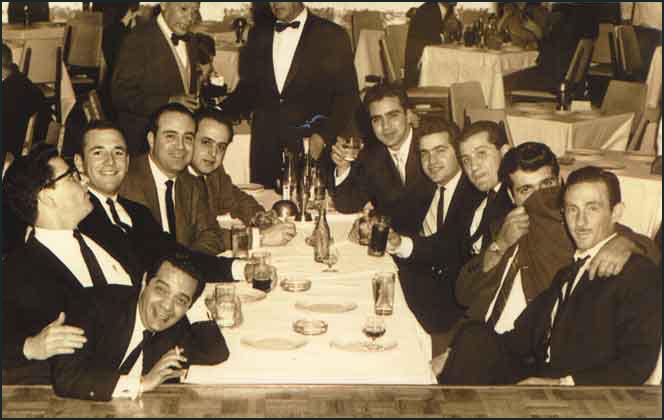
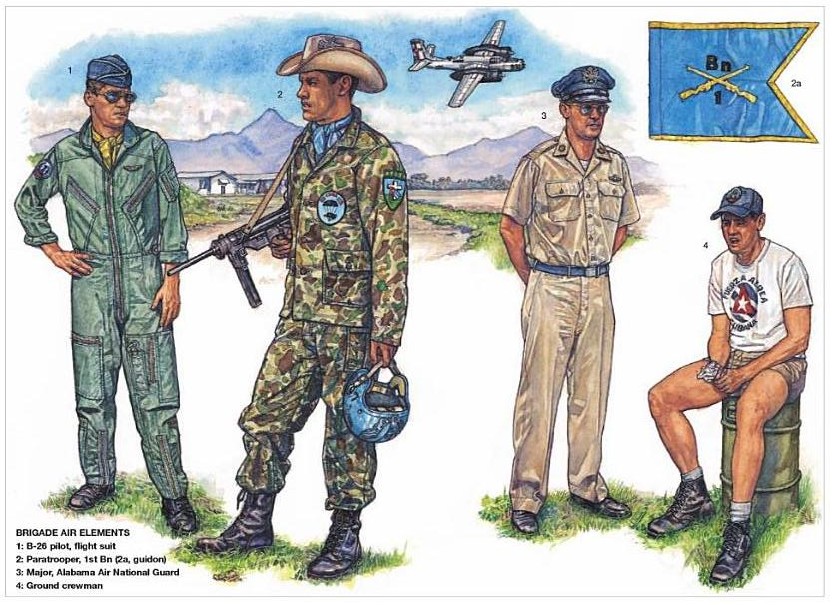
>1,500 Cuban exiles
(c. 1,300 landed)
2 CIA agents
www.seeingred.com/Copy/2.5_cubasuit2.html
It had five transport gunboats, two modified LCI artillery war units, three LCV landing craft for transporting heavy equipment and four LCVP troop-carrier landing craft. For air operations, the mercenaries were backed by 16 x B-26 The members of the mercenary brigade received military training from American instructors at bases in the United States, Guatemala and Puerto Rico. They received monthly allowances to support their families provided by the United States government which spent a total of 45 million dollars to finance the operation.
http://timelines.com/1961/4/16/cia-brigade-2506-invasion-fleet-converges-on-rendezvous-point-zulu-south-of-cuba
The Brigade consisted of five battalions with a total strength of 1,258 infantrymen and approximately 300 men for the supply services. The battalions had the actual strength of a United States infantry company and almost no heavy weapons.
There was no artillery and the only support was given 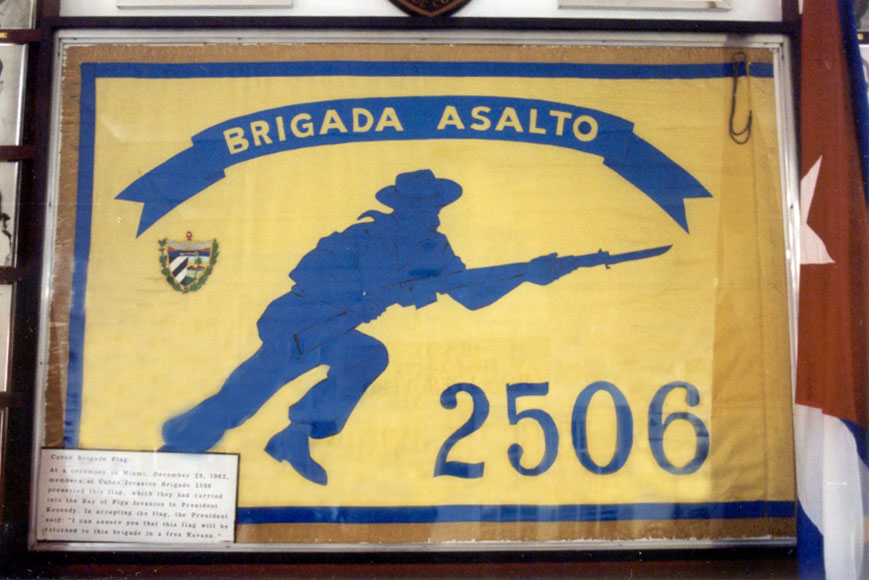
fighter bomber planes, 6 x C-46, 8 x C-54 transport planes and 2 x Catalina seaplanes. They had 5 x M-41 Sherman Walker BullDog tanks, with 76-millimeter guns; 10 armored cars equipped with .50-caliber machine-guns; 75 x bazookas; 60 x mortars of different caliber; 21 x recoilless cannons, 75-millimiter and 57-millimeter; 44 x machine-guns .50-caliber and 39 x light and heavy machine-guns .30-caliber; 8 x flame-throwers; 22,000 hand-grenades; 108 x Browning automatic rifles; 470 x M3 submachine-guns; 635 x Garand rifles and M1 carbines; 465 x pistols and other light weapons.
by six Mark IV Sherman tanks 5 x M41 Walker BullDog light tanks which joined the invasion in three LCTs and were landed before the infantrymen. Apparently the lack of sea transports forced the planners of the operation to reload the LCTs with the motorized equipment, land it , and then return to the troop transports to pick up the infantrymen. Each LCT carried two tanks, two trucks, and two jeeps. The infantrymen were armed with Garand [8-shot, 7.62mm x 82mm] semi-automatic rifles and M1 [.30 caliber short cartridge] carbines plus heavy weapons consisting of 6 x 60mm [light] mortars, 6 x 81mm [medium] mortars, and 6 x 107mm [4.2 inch heavy] mortars. A number of 57mm recoilless rifles and .50 caliber [12.7mm heavy] machine guns was also used by the expeditionary forces.
2506 Mortars
In less than 72 hours, the Cuban revolutionary forces overwhelmingly crushed the powerful invading mercenary brigade.
latinamericanstudies.org/baypigs-2.htm
http://en.wikipedia.org/wiki/Bay_of_Pigs_Invasion
Castro's Cuban FAR
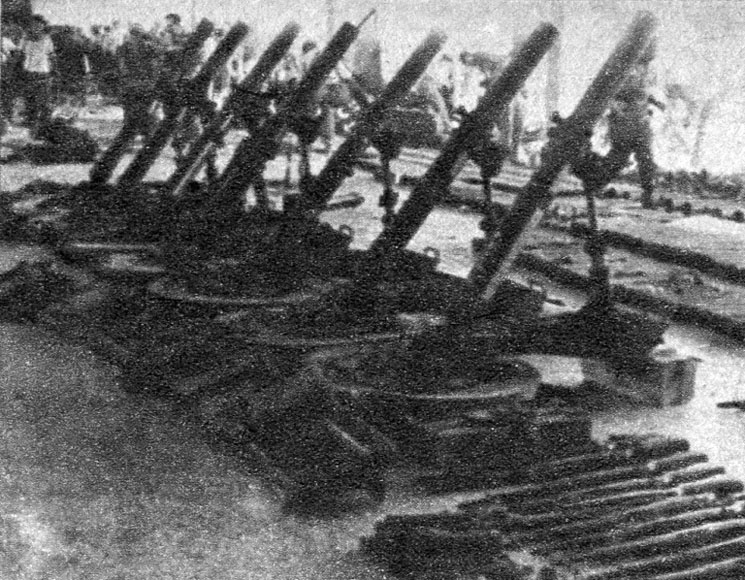
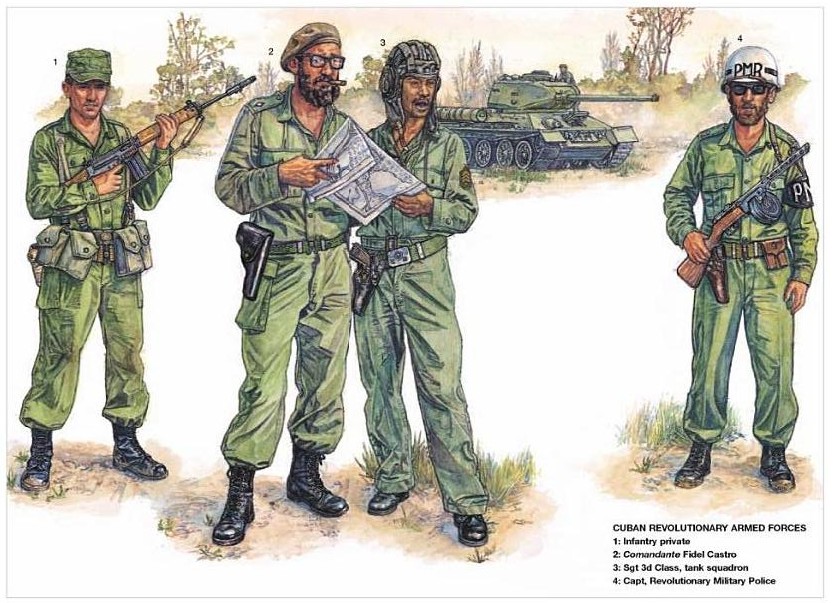
c. 25,000 army
c. 200,000 militia
c 9,000 armed police
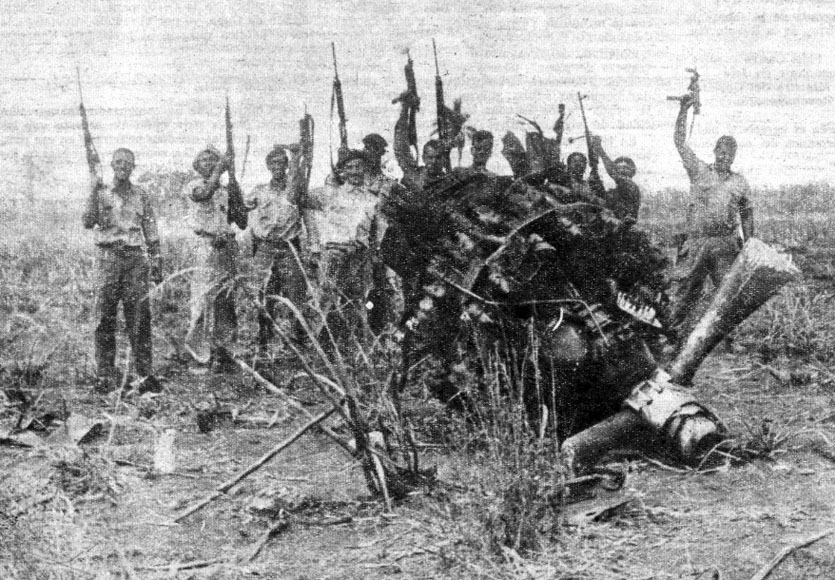
In early 1961, Cuba's army possessed Soviet-designed T-34 and IS-2 Stalin tanks, SU-100 self-propelled [turretless] "tank destroyers", 122mm howitzers, other artillery and small arms, plus Italian 105 mm howitzers. The Cuban air force armed inventory included Douglas B-26C Invader light bombers, Hawker Sea Fury fighters, and Lockheed T-33 jets, all remaining from the Fuerza Aérea del Ejército de Cuba (FAEC), the Cuban air force of the Batista government.[14]
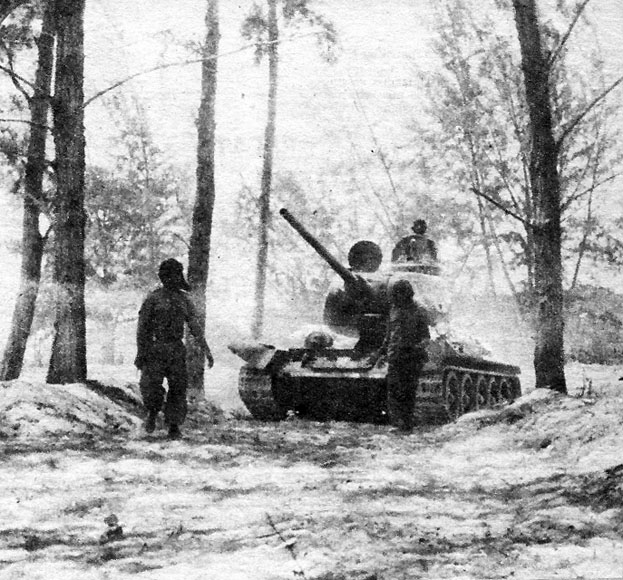
Anticipating an invasion, Che Guevara stressed the importance of an armed civilian populace, stating "all the Cuban people must become a guerrilla army, each and every Cuban must learn to handle and if necessary use firearms in defense of the nation."[18]
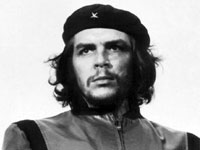
Following the air strikes on airfields on April 15, 1961, the FAR managed to prepare for armed action at least four T-33s, four Sea Furies and five or six B-26s. All three types could be armed with machine guns and rockets for air-to-air combat and for strafing of ships and ground forces. CIA planners had reportedly failed to discover that the U.S.-supplied T-33 jets had long been armed with M3 [.50 caliber heavy] machine guns. The Sea Furies and B-26s could also carry bombs, for attacks against ships and tanks.[40]
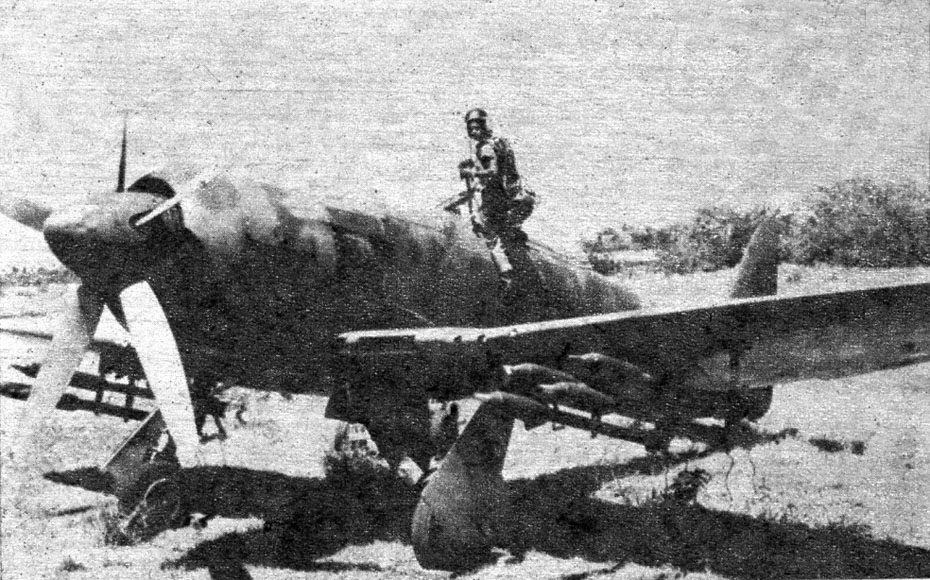
Late on April 16, 1961, the CIA/Assault Brigade 2506 invasion fleet converged on
"Rendezvous Point Zulu", about 65 km (40 miles) south of Cuba, having sailed from Puerto Cabezas, Nicaragua where they had been loaded with troops and other materiel, after loading arms and supplies at New Orleans. The U.S. Navy operation was code-named BUMPY ROAD, having been changed from CROSSPATCH on 1 April 1961[11]. The fleet, cryptically labelled the "Cuban Expeditionary Force" (CEF), included five 2,400-ton (empty weight) freighter ships chartered by the CIA from the Garcia Line and outfitted with anti-aircraft guns. Four of the freighters, Houston (code name Aguja), Río Escondido (code name Balena), Caribe (code name Sardina), and Atlántico (code-name Tiburon), were planned to transport about 1,400 troops in 7 battalions of troops and armaments near to the invasion beaches. The fifth freighter, Lake Charles, was loaded with follow-up supplies and some Operation 40 infiltration personnel. The freighters sailed under Liberian ensigns. Accompanying them were two LCIs (Landing Craft Infantry) "purchased" from Zapata Corporation then outfitted with heavy armament at Key West, then exercises and training at Vieques Island. The LCIs were Blagar (code-name Marsopa) and Barbara J (code-name Barracuda), sailing under Nicaraguan ensigns.
The CEF ships were individually escorted (outside visual range) to Point
Zulu by U.S. Navy destroyers USS Bache, USS Beale, USS Conway, USS Cony, USS Eaton, USS Murray, USS Waller. A task force had already assembled off the Cayman Islands, including aircraft carrier USS Essex with task force commander John A. Clark (Admiral) onboard, helicopter assault carrier USS Boxer [EDITOR logical to assume with marines onboard], destroyers USS Hank, USS John W. Weeks, USS Purdy, USS Wren, and submarines USS Cobbler and USS Threadfin. Command and control ship USS Northampton and carrier USS Shangri-La were also reportedly active in the Caribbean at the time. USS San Marcos was a Landing Ship Dock that carried three LCUs (Landing Craft Utility) and four LCVPs (Landing Craft, Vehicles, Personnel). San Marcos had sailed from Vieques Island. At Point Zulu, the 7 CEF ships sailed north without the USN escorts, except for San Marcos that continued until the seven landing craft were unloaded when just outside the 5 km (3mi) Cuban territorial limit.[5][17][41]
Invasion
Invasion day (17 April)
During the night of 16/17 April, a mock diversionary landing was organized by CIA operatives near Bahia Honda, Pinar del Rio Province. A flotilla of small boats towed rafts containing equipment broadcasting sounds and other effects of a shipborne invasion landing. That was the source of Cuban reports that briefly lured Fidel Castro away from the Bay of Pigs battlefront area.[5][27]
At about 00.00 on April 17, 1961, the two CIA LCIs Blagar and Barbara J, each with a CIA "operations officer" and an Underwater Demolition Team (UDT) of five frogmen, entered the Bay of Pigs (Bahía de Cochinos) on the southern coast of Cuba. They headed a force of four transport ships (Houston, Río Escondido, Caribe, and Atlántico) carrying about 1,300 Cuban exile ground troops of Assault Brigade 2506, plus tanks and other armour in the landing craft. At about 01.00, the Blagar, as the battlefield command ship, directed the principal landing at Playa Girón (Blue Beach), led by the frogmen in rubber boats followed by troops from Caribe in small aluminum boats, then LCVPs and LCUs. The Barbara J, leading Houston, similarly landed troops 35 km further northwest at Playa Larga (Red Beach), using small fiberglass boats. Unloading troops at night was delayed, due to engine failures and boats damaged by unseen coral reefs. The few militia in the area succeeded in warning Cuban armed forces via radio soon after the first landing, before the invaders overcame their token resistance.[27]

At daybreak at about 06.30, 3 FAR Sea Furies, 1 B-26 and 2 T-33 jets started attacking those CEF ships still unloading troops.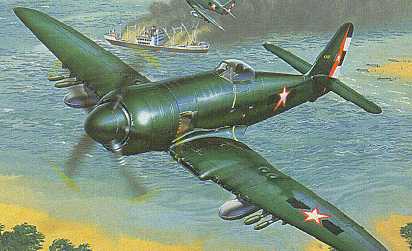
At about 07.00, 2 x FAL B-26s attacked and sank the Cuban Navy Patrol Escort ship El Baire at Nueva Gerona on the Isle of Pines.[38] They then proceeded to Giron to join two other B-26s to attack Cuban ground troops and provide distraction air cover for the paratroop C-46s and the CEF ships under air attack. At about 07.30, 5 C-46 and one C-54 transport aircraft dropped 177 paratroops from the parachute battalion of Assault Brigade 2506 in an action code-named Operation FALCON.[42] About 30 men plus heavy equipment were dropped south of Australia sugar mill on the road to Palpite and Playa Larga, but the equipment was lost in the swamps and the troops failed to block the road. Other troops were dropped at San Blas, at Jocuma between Covadonga and San Blas, and at Horquitas between Yaguaramas and San Blas. Those positions to block the roads were heavily maintained for two days, reinforced by ground troops from Playa Girón.[13]

At about 08.30, a FAR Sea Fury piloted by Carlos Ulloa Arauz crashed in the bay, due to stalling or anti-aircraft fire, after encountering a FAL C-46 returning south after dropping Paratroops. By 09.00, Cuban troops and militia from outside the area had started arriving at Australia sugar mill, Covadonga and Yaguaramas. Throughout the day they were reinforced by more troops, heavy armour and T-34 tanks often carried on flat-bed trucks.[13] At about 09.30, FAR Sea Furies and T-33s attacked with rockets the Rio Escondido, that "blew up" and sank about 3 km south of Girón.[14]
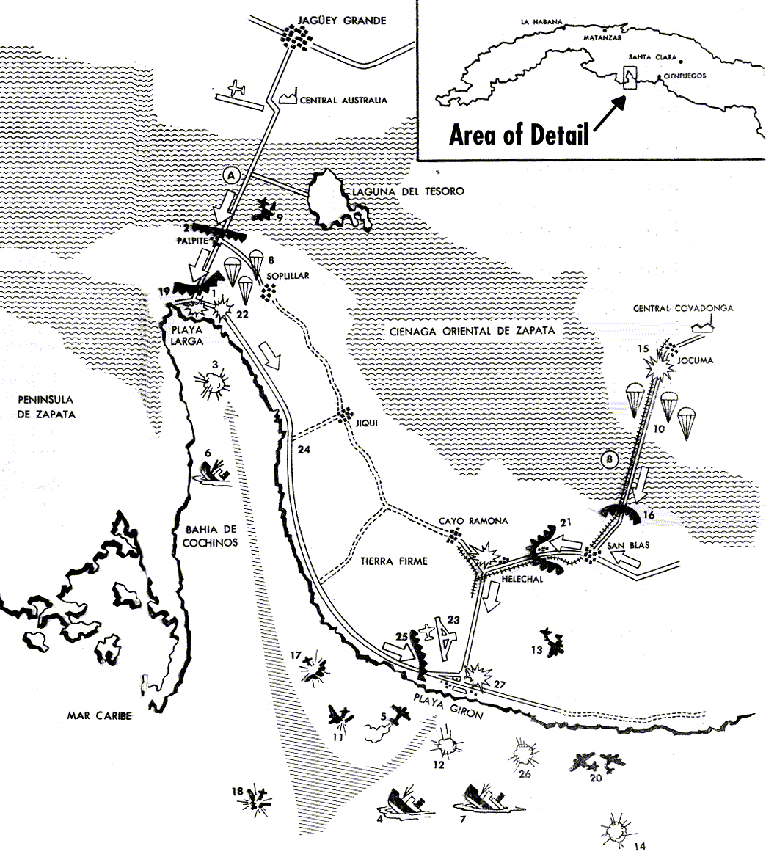

At about 11.00, a FAR T-33 attacked a FAL B-26 (serial number 935) piloted by Matias Farias who then survived a crash-landing on the Girón airfield, his navigator Eduardo Gonzales already killed by gunfire. His companion B-26 suffered damage and diverted to Grand Cayman Island; Pilot Mario Zúñiga (the "defector") and navigator Oscar Vega returned to Puerto Cabezas via CIA C-54 on 18 April. By about 11.00, the two remaining freighters Caribe and Atlántico, and the CIA LCIs and LCUs, started retreating south to international waters, but still pursued by FAR aircraft. At about 12.00, a FAR B-26 exploded due to heavy anti-aircraft fire from Blagar, and pilot Luis Silva Tablada (on his second sortie) and his crew of three were lost.[16]
By 12.00, hundreds of militia cadets from Matanzas had secured Palpite, and cautiously advanced on foot south towards Playa Larga, suffering many casualties during attacks by FAL B-26s. By dusk, other Cuban ground forces were gradually advancing southwards from Covadonga and southwest from Yaguaramas towards San Blas, and westwards along coastal tracks from Cienfuegos towards Girón, all without heavy weapons or armour.
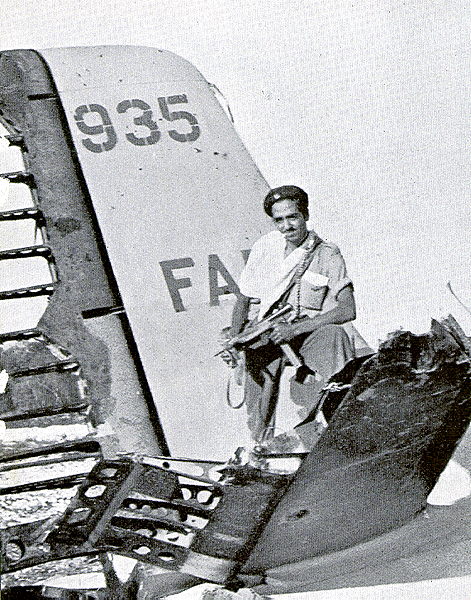
LT Del Pino by his armed T-33 Shooting Star
During the day three FAL B-26s were shot down by T-33s, with the loss of pilots Raúl Vianello, José Crespo, Osvaldo Piedra and navigators Lorenzo Pérez-Lorenzo and José Fernández. Vianello's navigator Demetrio Pérez bailed out and was picked up by USS Murray. Pilot Crispín García Fernández and navigator Juan González Romero, in B-26 serial 940, diverted to Boca Chica, but late that night they attempted to fly back to Puerto Cabezas in B-26 serial 933 that Crespo had flown to Boca Chica on 15 April. In October 1961, the remains of the B-26 and its two crew were finally found in dense jungle in Nicaragua.[38][43] One FAL B-26 diverted to Grand Cayman with engine failure. By 16.00, Fidel Castro had arrived at the central Australia sugar mill, joining José Ramón Fernández whom he had appointed as battlefield commander before dawn that day.[13]
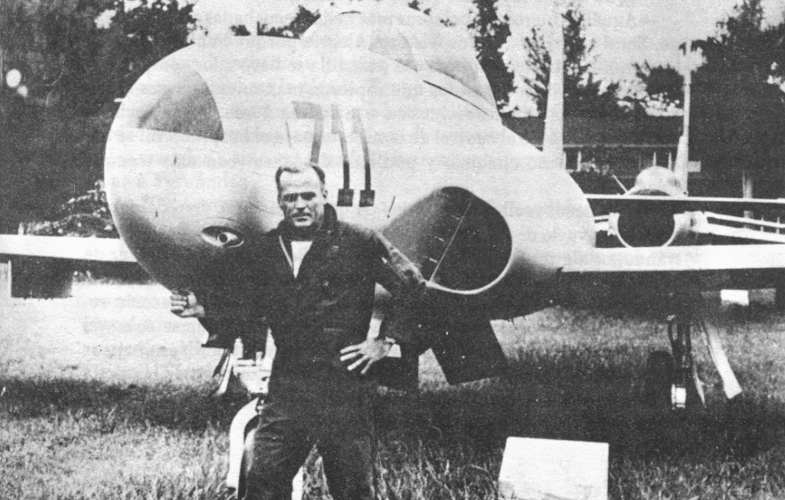
On April 17, 1961, Osvaldo Ramírez (then chief of the rural resistance to Castro) was captured in Aromas de Velázquez and immediately executed.[44] The CIA was unaware or unconcerned at this repression's effects on the planned operation.[17]
At about 21.00 on 17 April 1961, a night air strike by three FAL B-26s on San Antonio de Los Baños airfield failed, reportedly due to incompetence and bad weather. Two other B-26s had aborted the mission after take-off.[16][40] Other sources allege that heavy anti-aircraft fire scared the aircrews, the resultant smoke perhaps a convenient excuse for "poor visibility".[13]

Czechoslovakian-made M-53 quad 12.7mm anti-aircraft machine gun
Invasion day plus one (D+1) 18 April
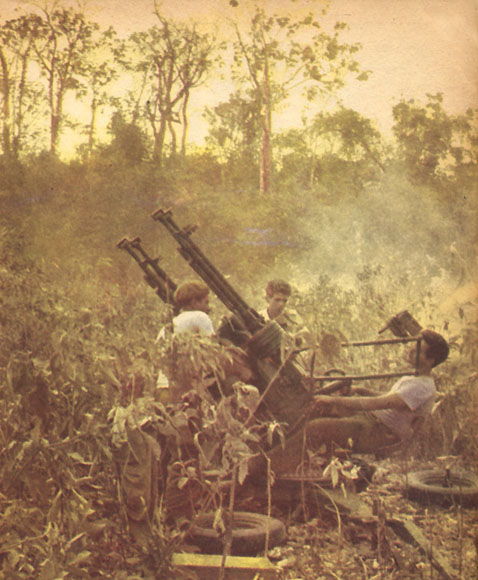
By about 10.30 on 18 April, Cuban troops and militia, supported by tanks, took Playa Larga after Brigade forces had fled towards Girón in the early hours. During the day, Brigade forces retreated to San Blas along the two roads from Covadonga and Yaguaramas. By then, both Fidel Castro and José Ramón Fernández had re-located to that battlefront area.[13]
At about 17.00 on 18 April, FAL B-26s attacked a Cuban column of 12 civilian buses leading trucks carrying tanks and other armour, moving southeast between Playa Larga and Punta Perdiz. The vehicles, loaded with civilians, militia, police and soldiers, were attacked with bombs, napalm and rockets, suffering heavy casualties. The 6 B-26s were piloted by two CIA contract pilots plus four pilots and six navigators from Assault Brigade 2506 air force.[27][38] The column later re-formed and advanced to Punta Perdiz, about 11 km northwest of Giron.[13]
Invasion day plus two (D+2) 19 April
During the night of 18 April, a FAL C-46 delivered arms and equipment to the Girón airstrip occupied by Assault Brigade 2506 ground forces, and took off before daybreak on 19 April.[45] The C-46 also evacuated Matias Farias, the pilot of B-26 serial "935" (code-named Chico Two) that had been shot down and crash-landed at Girón on 17 April.[42]
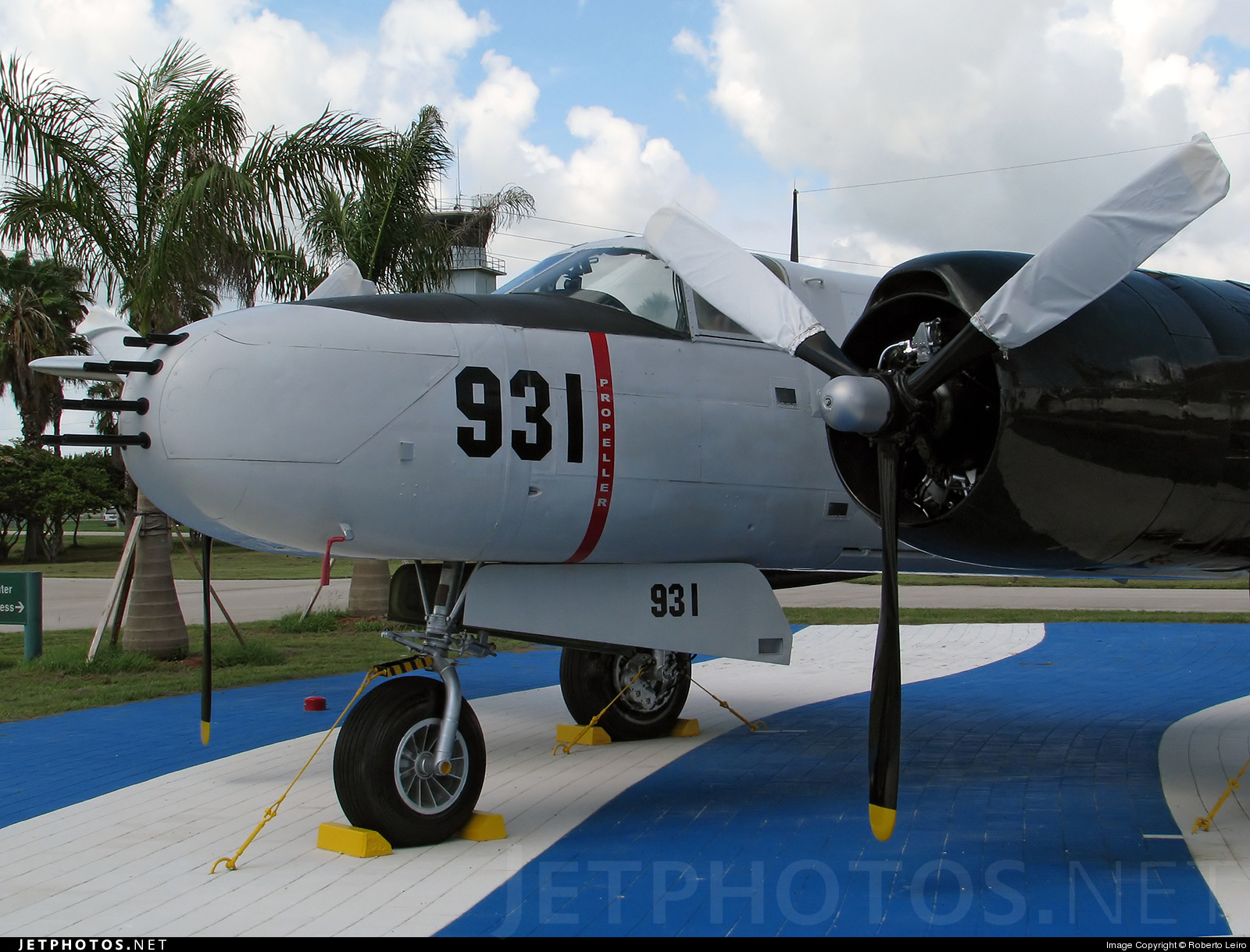
The final air attack mission (code-named Mad Dog Flight) comprised 5 B-26s, four of which were manned by American CIA contract air crews and pilots from the Alabama Air Guard. One FAR Sea Fury (piloted by Douglas Rudd) and two FAR T-33 (piloted by Rafael del Pino and Alvaro Prendes) shot down two of these B-26s, killing four American airmen.[17]
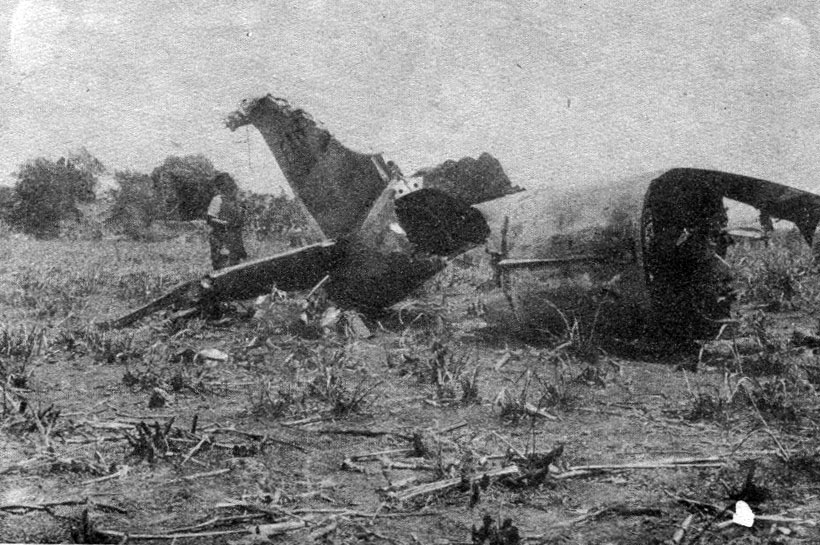
USS Essex
Combat air patrols were flown by Douglas A4D-2N Skyhawk jets of VA-34 squadron operating from USS Essex, with nationality and other markings removed. Sorties were flown to reassure Brigade Soldiers and pilots, and to intimidate Cuban government forces without directly engaging in acts of war.[38]
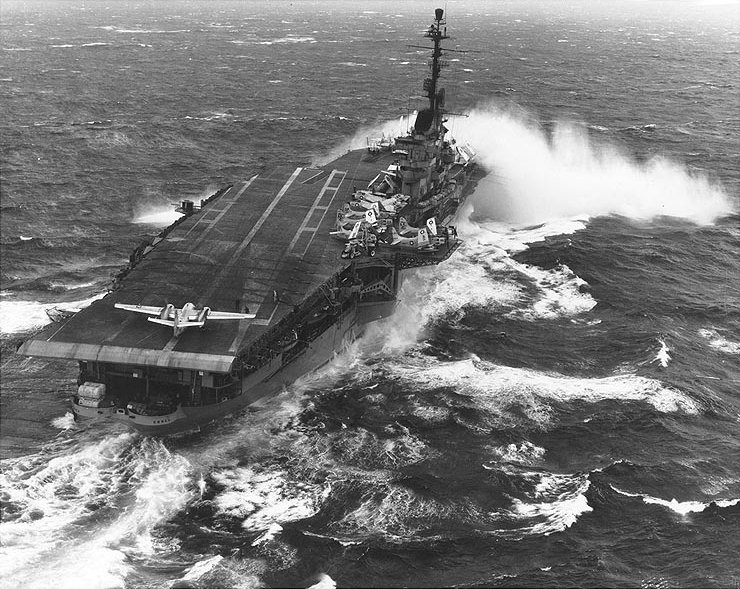
A section of A-4 SkyHawks
Without direct air support, and short of ammunition, Assault Brigade 2506 ground forces retreated to the beaches in the face of considerable onslaught from Cuban government artillery, tanks and infantry.[14][46][47][48]
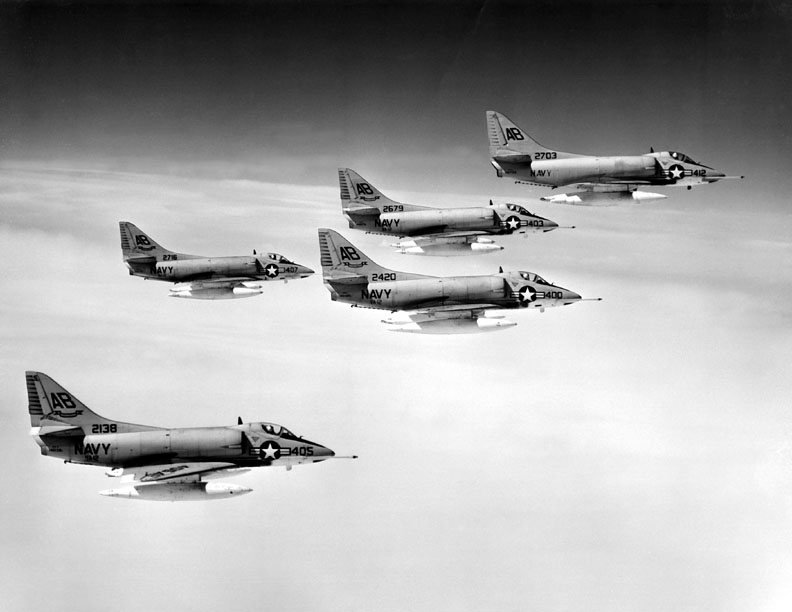
Late on 19 April, destroyers USS Eaton (code-named Santiago) and USS Murray (code-named Tampico) moved into Cochinos Bay to evacuate retreating Brigade Soldiers from beaches, before opportunist firing from Cuban army tanks caused Commodore Crutchfield to order a withdrawal.[27]
Invasion day plus three (D+3) 20 April
From 19 April until about 22 April, sorties were flown by A4D-2Ns to obtain visual intelligence over combat areas. Reconnaissance flights are also reported of Douglas AD-5Ws of VFP-62 and/or VAW-12 squadron from USS Essex or another carrier, such as USS Shangri-La that was part of the task force assembled off the Cayman Islands.[27][38]
On 21 April, Eaton and Murray, joined on 22 April by destroyers USS Conway and USS Cony, plus USS Threadfin (submarine) and a CIA PBY-5A Catalina flying boat, continued to search the coastline, reefs and islands for scattered Brigade survivors, about 24-30 being rescued.[45]
Aftermath
Casualties
Aircrews killed in action totaled 6 from the Cuban air force, 10 Cuban exiles and 4 American airmen.[16] American Paratrooper Eugene Herman Koch was killed in action, and the American airmen shot down were Thomas W Ray, Leo F Baker, Riley W Shamburger and Wade C Gray.[27] In 1979, the body of Thomas "Pete" Ray was repatriated from Cuba. In the 1990s, the CIA admitted to his links to the agency, and awarded him the Intelligence Star.[49] 114 Cuban exiles from Assault Brigade 2506 were reportedly killed in action.[27]
Cuba's losses during the conflict are variously reported as 4,000 killed, wounded or missing [6], or about 5,000.[7] Cuban sources report over 2,200 casualties[50]. The final toll reported was 176 killed in action in Cuban armed forces during the conflict.[5] That number might be for Cuban army losses only, not including militia or armed civilian loyalists, so a total of around 2,000 (perhaps as many as 5,000, see above) Cuban militia may have been killed, wounded or missing in action. The 15 April airfield attacks left 7 Cuban dead and 54 wounded.[5]
Prisoners
On 18 April, 1961, at least seven Cubans plus two CIA-hired U.S. citizens (Angus K. McNair and Howard F. Anderson) were executed in Pinar del Rio province. On 20 April, Humberto Sorí Marin was executed at Fortaleza de la Cabana, having been arrested on 18 March following infiltration into Cuba with 14 tons of explosives. His fellow conspirators Rogelio Gonzalez Corzo (alias "Francisco Gutierrez"), Rafael Diaz Hanscom, Eufemio Fernandez, Arturo Hernandez Tellaheche and Manuel Lorenzo Puig Miyar were also executed.[6][13][24][35][51]
Between April and October 1961, hundreds of executions took place in response to the invasion. They took place at various prisons, including the Fortaleza de la Cabaña and El Morro Castle.[6] Infiltration team leaders Antonio Diaz Pou and Raimundo E. Lopez, as well as underground students Virgilio Campaneria, Alberto Tapia Ruano, and more than one hundred other insurgents were executed.[10]
About 1,204 Assault Brigade 2506 members were captured, of which nine died from asphyxiation during transfer to Havana in a closed truck. In May 1961, Fidel Castro proposed to exchange the surviving Brigade prisoners for 500 large farm tractors. The trade rose to U.S. $28 million.[8] On 8 September 1961, 14 Brigade prisoners were convicted of torture, murder and other major crimes committed in Cuba before the invasion, five being executed and nine jailed for 30 years.[3] Three confirmed as executed were Roman Calvino, Emilio Soler Puig ('el Muerte') and Jorge King Yun ('el Chino').[14][35] On 29 March 1962, 1,179 men were put on trial for treason. On 7 April 1962, all were convicted and sentenced to 30 years in prison. On 14 April 1962, 60 wounded and sick prisoners were freed and transported to the U.S..[3] On December 21, 1962, Cuban Prime Minister Fidel Castro and James B. Donovan, a U.S. lawyer, signed an agreement to exchange 1,113 prisoners for U.S. $53 million in food and medicine; the money was raised by private donations. On 24 December 1962, some prisoners were flown to Miami, others following on the ship African Pilot, plus about 1,000 family members also allowed to leave Cuba. On 29 December 1962, President John F. Kennedy attended a "welcome back" ceremony for Assault Brigade 2506 veterans at the Orange Bowl in Miami, Florida.[14]
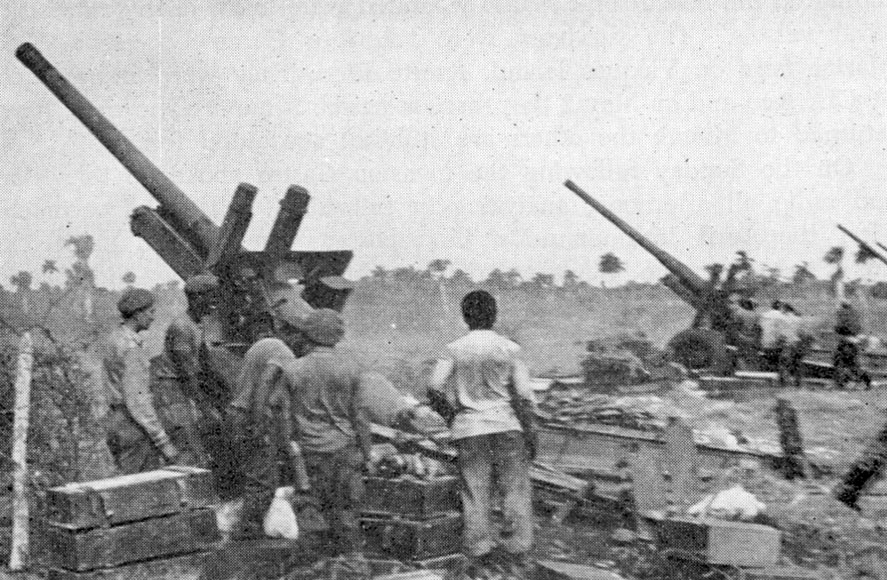
http://en.wikipedia.org/wiki/USS_Essex_(CV-9)
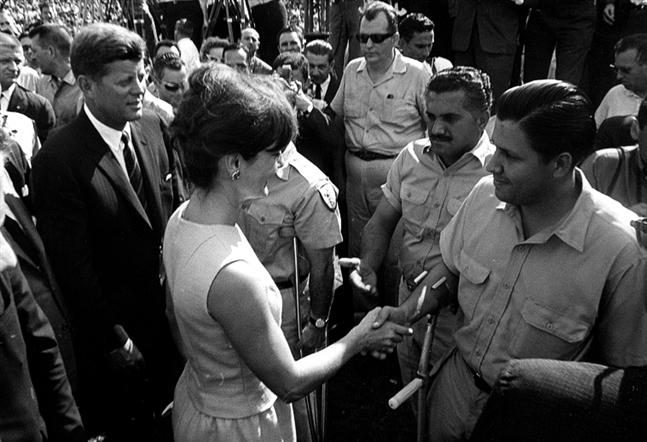
Bay of Pigs and Cuban Missile Crisis
In April 1961, Essex steamed out of Jacksonville, Florida on a two-week "routine training" cruise, purportedly to support the carrier qualification of a squadron of Navy pilots. 12 x A4D-2 Skyhawks had been loaded aboard. The pilots were from attack squadron VA-34 Blue Blasters. The A4D-2Ns were armed with 20mm cannon, and after several days at sea all their identifying markings were crudely obscured with flat gray paint. They began flying mysterious missions day and night with at least one returning bearing battle damage. Not generally known to Essex crew was that they had been tasked to provide air support to CIA-sponsored bombers during the ill-fated Bay of Pigs Invasion. The naval aviation part of the mission was aborted by President Kennedy at the last moment and the Essex crew sworn to secrecy.[1]
A-4 SkyHawk cut-away drawing
In the early-to-mid 1960s, standard US Navy A-4B Skyhawk squadrons were assigned to provide daytime fighter protection for ASW aircraft operating from some Essex class U.S. anti-submarine warfare carriers, these aircraft retained their ground- and sea-attack capabilities. The A-4B model did not have an air-to-air radar, and it required visual identification of targets and guidance from either ships in the fleet or an airborne E-1 Tracer AEW aircraft. Lightweight and safer to land on smaller decks, Skyhawks would later also play a similar role flying from Australian, Argentinean, and Brazilian upgraded World War II surplus light ASW carriers, which were also unable to operate most large modern fighters.[15][16][17]
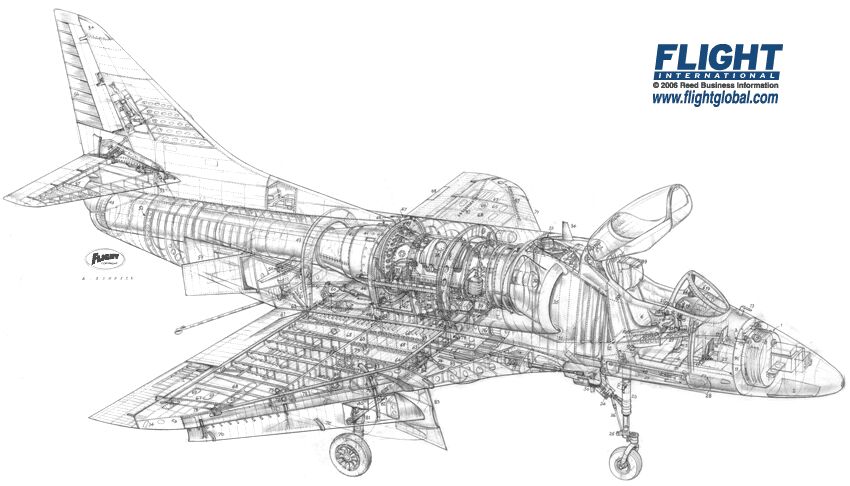
20mm cannon in wing root of an A-4
Primary air-to-air armament consisted of the internal 20mm (.79 in) Colt cannons and ability to carry an AIM-9 Sidewinder missile on both underwing hardpoints, later additions of two more underwing hardpoints on some aircraft made for a total capacity of four AAMs. Only two confirmed A-4 air-to-air kills have ever been made, both with Zuni rockets designed for use against ground targets.
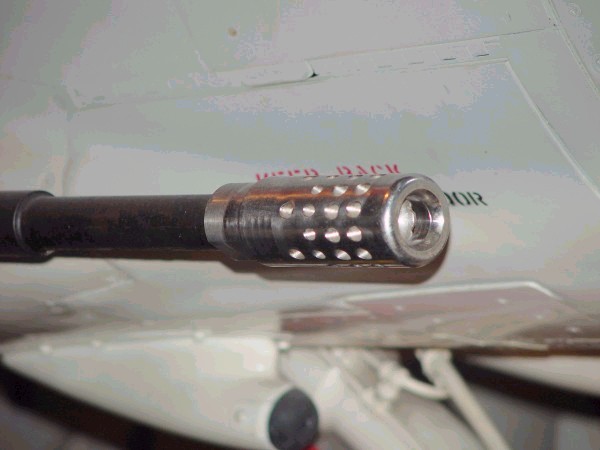
http://forum.axishistory.com/viewtopic.php?f=58&t=146060&p=1287947
reocities.com/urrib2000/Tanques3-e.html
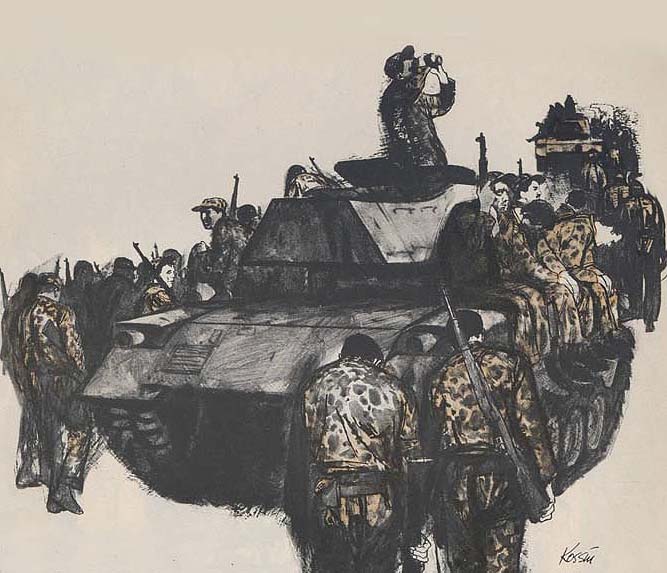
M41 Walker Bulldog ...Five [light] tanks of this type formed the 4th Tank Battalion of the 2506 Brigade of Cuban exiled, that disembarks in Bay of Pigs on April 17, 1961. The M41 landed since barges LCU by Giron. They intensely fought, supporting the infantry, achieving to defeat 5 x T-34-85[s], together the recoilless rifles and the [2.36" and 3.5"] bazookes, until they were defeated, losing 2 destroyed and the remainder damaged or abandoned without munitions. Cuba send one M41 to the USSR, that was studied for the Soviets, and that today is exhibited in the Kubinka Museum of Moscow. Another are exibited in the Museum of Giron Beach.
globalsecurity.org/military/library/report/1984/EJR.htm
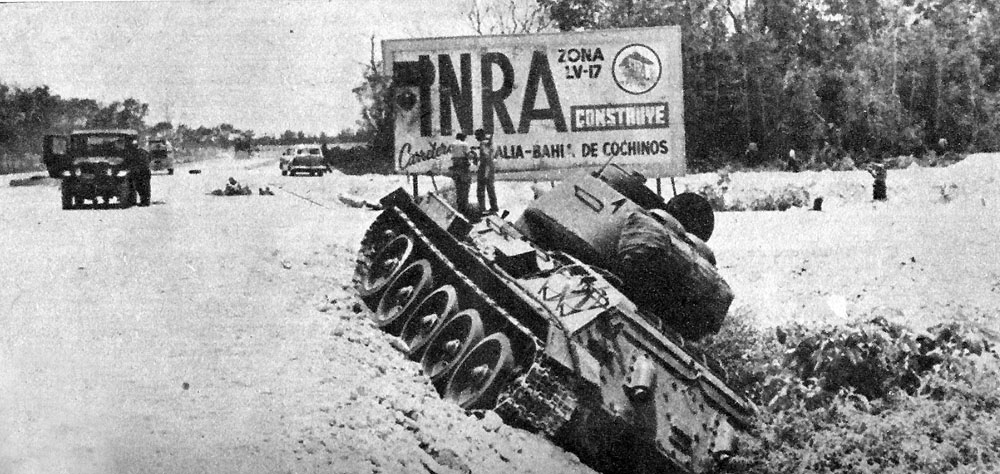
The Bay of Pigs: A Struggle For Freedom
CSC 1984
SUBJECT AREA History
WAR SINCE 1945 SEMINAR
The Bay of Pigs: A Struggle for Freedom
Major Joe R. English
2 April 1984
Marine Corps Command and Staff College
Marine Corps Development and Education Command
Quantico, Virginia 22134
ABSTRACT
Author: ENGLISH, Joe R., Major, U.S. Marine Corps
Title: THE BAY OF PIGS: A STRUGGLE FOR FREEDOM
Publisher: Marine Corps Command and Staff College
Date: 16 March, 1984
This paper presents a review of the invasion of Cuba in April, 1961, by a group of Cuban exiles. This invasion became known as the Bay of Pigs invasion because of the area where the landing took place. The invasion force was financed and trained by the CIA with the full knowledge and approval of the Executive branch of our government.
The operation was conceived under the Eisenhower administration as a guerrilla insertion. It was passed on to the Kennedy administration where it was expanded to the final product of a full-scale invasion by the brigade of exiles.
Although the project was run by the CIA, it was so compartmentalized that virtually no one had all of the details of the operation. The Military was brought in very late to review the plans and lend some covert support to the actual invasion.
A force of 1,443 landed on the Southern shores of Cuba in the early morning hours of 17 April, 1961. They established a beachhead and held it for three days against overwhelming numbers of Cuban forces led by Fidel Castro. After three days, they literally ran out of ammunition and the vast majority of the invaders were captured and held prisoner for over a year before being ransomed to the Government of the United States.
This paper covers the Bay of Pigs Operation from beginning to end with a view toward explaining what happened. It does not deal in detail with why events occurred and decisions were made. The reasons for the failure of the operation are covered in an appendix which sets forth the conclusions of the Taylor Commission which was chartered by President Kennedy immediately after the operation to analyze the results.
Aside from the description of the events leading up to and during the Bay of Pigs operation, the paper deals with an analysis of the invasion plan from the standpoint of METT. It also looks at the performance of the Brigade in light of the principles of war. The result is a look at a bargin-basement amphibious operation which presents an opportunity to view both its successes and its failures.
[EDITOR: author is already conjuring up excuses to distance the BOP from the USMC status quo as if more money and bigger egos operating incompetent minds will be any less a failure?]
The net result is a reinforcement of the Marine Corp's [BS] amphibious doctrine.
[EDITOR: TOTAL FUCKING BULLSHIT! The BOP is a warning that the USMC is headed to complete and utter disaster, you status quo monger! This is what happens when the USMC narcissist foot-slogger, mentality is employed.]
TABLE OF CONTENTS
List of Figures page ii
Prologue page 1
Chapters
I. U.S. Political Considerations page 3
II. Formation of Frente and Brigade Training page 20
III. The Plan page 30
IV. The Invasion page 35
V. Ransom page 87
VI. Conclusions and the Principles of War page 95
Appendixes
A. Memorandum 2 & 3 from Taylor Commission Report page 109
B. Cuban Project Time Line page 119
C. Invasion Time Line page 121
Bibliography page 124
FIGURES
Figure
I. Cuban Project Organization 1959-1961 page 7
II. TRINIDAD Plan page 14
III-1. Planned Disposition of Forces page 38
III-2. General Disposition of Forces at the End of D-Day page 66
IV. General Disposition of Forces at the End of D+1 page 78
PROLOGUE
This paper presents a review of the invasion of Cuba in April 1961, by a group of Cuban exiles. This invasion became known as the Bay of Pigs invasion because the landing took place near the Bahia de Cochinos on the Southwestern coast of Cuba. The invasion force was financed and trained by the CIA with the knowledge and approval of the Executive branch of the United States government.
[EDITOR: FALSE. USMC Colonel Hawkins and other U.S. military men trained Assault Brigade 2506. If this is going to be a report that lies and distorts to protect the USMC then it should be ignored.]
The operation was conceived under the Eisenhower administration as a guerrilla insertion. It was passed on to the Kennedy administration where it was expanded to the final product of a full scale invasion by the Brigade of exiles. Although the project was run by the CIA it was so compartmentalized that virtually no one individual had all the details of the operation. The Military was brought in very late to review the plans and lend some covert support to the actual invasion.
A force of 1,443 landed on the shores in the early morning hours of 17 April, 1961. They established a beachhead and held it against a numerically superior enemy for three days before they literally ran out of ammunition and were captured, killed or escaped. The examination of this operation provides the military student a small scale model of an amphibious operation which can provide a validation of U.S. Marine Corps Amphibious doctrine. Closer study of Brigade performance also demonstrates areas of battle study particularly valuable to the small unit leader such as the effective use of the reserve, tactical use of terrain, and the value of a viable command and control system.
The story of Brigade 2506 is set forth in this paper from beginning to end. The foundation for the operation is laid from both the standpoint of the preparation of the force and the political requirement for the mission. This is followed by a detailed description of the invasion and subsequent fighting. The capture and imprisonment of the members of the Brigade and their subsequent release are described. The analysis and conclusions are based primarily on the actual combat performance of the Brigade in light of the Principles of War as set forth in Marine Corps doctrine.
Appendices contain the results of the Taylor Committee which was appointed by President Kennedy to investigate the reasons for the failure of the operation. The information in the following report was compiled from a number of publications dealing with the subject to include; books, magazine articles, newspaper reports, speeches, and government documents. The result is a look at a bargain basement amphibious operation which presents the opportunity to view both its successes and its failures.
CHAPTER I
U.S. Political Considerations
The third week of April, 1961 was a fairly normal one for most of the United States and the American people. The eyes of the news media were focused on the war crimes trial in Israel of Adolph Eichmann, former Nazi Chief of the Gestapo's "Jewish Affairs" section. The Soviets were grabbing global headlines by placing Major Yuri Alekseyvich Gargarin into the first manned orbit of the Earth. There was just beginning to be public awareness of the guerilla tactics of the Pathet Lao fighting the pro-Western loyalists in Southeast Asia. [1].
On Wednesday, April 12, 1961, President Kennedy held a routine weekly press conference in the afternoon. The American people and the world were watching the fledgling administration closely to determine how effective it would be. It is interesting to note that after brief introductory remarks, the first question asked at the press conference was: "Mr. President, has a decision been reached on how far this country will be willing to go in helping an anti-Castro uprising or invasion of Cuba? What could you say with respect to recent developments as far as the anti-Castro movements in Cuba are concerned?"
The President replied: First, I want to say that there will not be, under any conditions, an intervention in Cuba by the United States Armed Forces. This government will do everything it possibly can, and I think it can meet its responsibilities, to make sure that there are no Americans involved in any actions inside Cuba ... The basic issue is not one between the United States and Cuba. It is between the Cubans themselves. I intend to see that we adhere to that principle and as I understand it, this administration's attitude is so understood and shared by the anti-Castro exiles from Cuba in this country. [2].
Over the past few months there had been numerous indications that United States relations with Cuba were in jeopardy. There had been reports of an unknown "force" training at bases outside the United States. The reports inferred that this "force" was training for an invasion of Cuba.
In reality these rumors were very true. The force was Brigade 2506, a unit made up of approximately 1500 Cuban exiles intending to invade their Cuban homeland and overthrow the government of Fidel Castro. On the day of the President's press conference, the Brigade had moved from their training camps in Guatemala to their embarkation port at Puerto Cabeza, Nicaragua. At this point, it is necessary to present some back-ground before describing the execution and the results of Operation PLUTO; the attack of a force of Cuban exiles upon their Cuban homeland at the Bahia de Cochinos (The Bay of Pigs).
On New Year's day 1959, Fidel Castro had ousted the Batista government and seized control of the government of Cuba. At first it looked as if Fidel Castro might establish a regime favorable to United States policy in the Caribbean. In the beginning, there was no clear indication of his philosophy or intentions for ruling Cuba. Over the next few months, however, it became increasingly apparent that he was not going to be easy to deal with as a neighbor and his policies demonstrated an increasingly socialist point of view.
By March of 1960 it was realized, by political world leaders, that the policies of the government of Fidel Castro were not compatible with the goals or interests of the United States. Within the highest levels of the United States government, a search began for a solution to the situation. It was during this time that the seeds were planted that would eventually bear the fruit that would be Operation ZAPATA.
Castro was rapidly becoming an irritant to the United States. It was obvious to the Eisenhower administration that no overt actions could be taken within the structure of international law to remedy the Cuban situation. The President chose to exercise the option of covert action to depose or discredit the Cuban leadership. With the concurrence of the Special Group, he asked Allen Dulles, the head of the CIA, to put together a "program" for dealing with Castro. [3]. (The Special Group consisted of a deputy Under Secretary of State, the deputy Secretary of Defense, the Director of the CIA, and the special assistant to the President for National Security Affairs. It was authorized by the National Security Council Directive NSC 5412/2 and was the most secret operating unit of government at the time.) Dulles called on the head of the CIA plans division, Richard Bissell, to begin to put together a program for covert action. Thus, the "Cuba Project" was born.
The CIA had proven to be quite capable in the overthrow of Latin American governments and had staged an extremely successful operation in Guatemala in 1954. Eisenhower had been elated with the results of the operation and so the CIA began making plans for a similar project for Cuba. Early in the planning phase of the operation, it became obvious that the operation would be expensive and could not be totally concealed within the agency's budget. At a cabinet meeting on August 18, 1960, the President approved $13 million and the use of some Department of Defense personnel and equipment. This money was programmed for the training of a Cuban guerrilla force outside the U.S. It became apparent at this time that no U.S. military personnel were to be used in a combat status. [4.]
The initial plan included a series of independent operations which would come together as the government of Cuba began to crumble. First, Howard Hunt and Gerry Droller were sent to Miami to try to form a coalition of all the splinter groups of Cuban exiles there; to form a representative group to function as a government in exile (See Figure I). [5]. The many groups were constantly fighting among themselves and no basis for trust could be established among them. It became imperative that a group of leaders be brought together before any other operations commenced. This leadership would be the only way to lend an air of legitimacy to the training and equipping of a revolutionary force.
Second came the job of recruiting, equipping, training and delivering a group of guerilla fighters to undermine the Cuban government. They would act as a nucleus for anti-Castro citizens in Cuba to join, and later train and equip the local populace as the uprising began. Toward this end, the agency set up a recruiting network in Miami and soon had enough Cuban volunteers to begin initial training. They established training centers within the United States in violation of their guidelines: in Florida, in Louisiana, Texas, Virginia, and the Jungle Warfare Training Center in Panama.
The third function was to set up a propaganda network. David Phillips, who had handled the propaganda program for the Guatamala scenario, began to set up a similar program for the Cuba Project. He put a radio transmitter in operation on Swan Island off the coast of Honduras and began broadcasting with a group of Cuban refugees, delivering anti-Castro speeches between musical selections. The initial estimate was that six months would be required to stimulate the desired results.
The fourth and final area of the project still remains highly classified, but most certainly existed. This involved a plot to dispose of Castro by assassination. The success of this endeavor would have made the rest of the operation unnecessary. However, although there seems to have been several attempts to poison Castro, none were successful. There are strong indications that the agency utilized members of the American underworld in their efforts, and are somewhat embarrassed by the evidence that has come to light since the operation. [6].
While Radio Swan continued to pour propaganda broadcasts into the Cuban homeland, preparations for training camps were established in Guatemala. An agreement was reached with the government of Guatemala whereby a large plantation, belonging to Roberto Alejos, was leased and transformed into a large training camp for the Cuban guerilla force. This camp became known as Base Trax and was the primary training site for the ground forces for the Bay of Pigs operation. The training of Cuban volunteers for guerilla tactics continued through October 1960, with approximately 300 Cubans receiving their training there.
In early November 1960, the administration decided to scrap the guerilla operation for three reasons: (1) It became apparent that supplying the guerillas by air drops would be extremely difficult. (2) As Castro's regime became more allied with the Communist block nations, he was receiving more arms and ammunition, and thus beginning to re-equip his military. (3) The Castro regime's control over the civilian population was much tighter than had been anticipated, making a long guerilla campaign undesirable.
[EDITOR: typical lazy American BS. Unless the population is on your side, even toppling the regime will not last. Insurgency requires a struggle.]
On November 4, 1960, the C.I.A sent a cable to Base Trax officially cancelling guerilla training for all but 60 of the Cubans. It specified how future training should be handled and indicated that the force would now be trained for conventional warfare with an emphasis upon amphibious assault training. 7. This cable indicated a major change/escalation of the type operation to be mounted in Cuba and occurred only four days prior to the Presidential elections of 1960. Simultaneously, an airfield at Ratalhuleu had become a major construction project funded by the American government. It became operational in September 1960 and training began there for the Cuban pilots of the Brigade Air Force. Their aircraft consisted of C-46 and C-54 transport aircraft, and a few B-26 medium bombers. These aircraft were not chosen at random. All had been sold widely on the world market after World War II. They were all reliable, generally well-suited to the missions to be performed, and all in service with Castro's Cuban air Force. Little or no attention was paid to the fact that Castro's pilots were flying a different model of B-26 than the ones flown by the exiles. [8]. This fact will prove to be of great importance later on.
The Cuban flyers were trained by a group of American pilots recruited by Major General Reid Doster, head of the Alabama National Guard. Most of the American aviators he used were without current military ties but all had extensive multi-engine experience and most had flown in combat. They had a difficult task, since most of the Cuban students had less than 100 hours of flying time and few had any experience with the heavy, multi-engine aircraft they would be flying; but a few had airline experience or had been members of the air force under Batista. These men quickly became the leaders of the fledgling Brigade Air Force.
As the training of the Cuban invasion forces continued, events on the political scene changed. The 1960 presidential election was over and Kennedy was the victor. It became apparent that the operation could not be executed prior to the shift of power in the White House; because of this on November 27, 1960 president-elect Kennedy was briefed on the plan. He was disturbed only by the small size of the Brigade and encouraged Allen Dulles to continue with the development of the force. [9].
Over the course of the next few weeks, there followed an escalation of the operation. A plan was put before the Special Group calling for a landing of 600-750 men, preceded by air strikes. With the change from guerilla operation to actual invasion, air power became a very important consideration. For such a small force to gain a beachhead they must have absolute air superiority to avoid being picked apart by Castro's air force.
[EDITOR: what do you mean by "actual invasion" crap? How one fights is not the GOAL; author probably implies a drive on to the capital Havana to remove Castro from power by force.]
Up until this time the administration had directed the Department of Defense to provide any assistance required by the CIA. There had been no provision for an actual briefing of the Defense Department as to exactly what was occurring and what assistance the plan required. Some of the requests for DOD assistance had been delayed to the point that the CIA had gone up the chain of command to expedite them. This understandably upset the military leadership. Under Secretary of Defense James Douglas learned that the CIA was planning an "over-the-beach" landing in Cuba. He requested and received a meeting with the President and CIA director Dulles. He desired to dissociate the Department of Defense with a plan that seemed impractical. The knowledge of the existing plan remained at the Secretary of Defense level--and was not passed to the JCS.
Without knowledge of the CIA plan, the JCS appointed a committee to study what could be done to unseat Castro. The Committee, headed by Brigadier General David Gray, produced a report containing six alternatives: (1) economic warfare; (2) blockade; (3) infiltration by a guerilla force; (4) a guerilla force with U.S. backing; (5) U.S. air and naval warfare with no invasion; or (6) all out invasion. The committee suggested that nothing short of step 4 would work. After a briefing on the report of the JCS committee, President Kennedy, on January 28, 1961, ordered the JCS to review the CIA plans. General Gray headed the committee to review them. The committee soon learned that so compartmentalized were the CIA operations that no actual written plan existed. The committee was briefed orally for two days by the principals involved in various phases of the operation. They then compiled their notes and presented in written form the plan that had been briefed to them.
They produced what became known as The TRINIDAD Plan. The general scheme was to land the Brigade near Trinidad on the southern shore of Cuba. This had been reported to be an area where opposition to Castro flourished. Intelligence indicated that a popular uprising would occur soon after the landing of the Brigade; hence the Brigade was really designed as a body around which forces could build. Each of the unit leaders had been trained to lead a unit one step larger, i.e., platoon leaders were company commander capable. The plan assumed that the Brigade would flesh out within a few days after landing. The guerilla forces trained at Base Trax would be operating in the Escambray Mountains nearby and would link up with the invasion force, further adding to its size. (Sea Figure II). [10].
[EDITOR: this is Option #4, which IS GUERRILLA WARFARE--not a march on the capital city. ]
General Gray reported, on January 31, 1961 to the JCS, the findings of his committee. He estimated the chances of success as "fair" and re-emphasized the requirement for absolute air superiority. On February 3, 1961, the Chiefs sent a report to the White House and the CIA. They advised that the chances of achieving military success was favorable, but advised that the ultimate success would depend on political factors such as the actual popular uprising and the ability to build a substantial force. They also left themselves a loophole by saying that their assessment of the combat worth of the forces was, of course, based on 3rd and 4th hand reports on their condition, training, and equipment.
President Kennedy received a briefing on the JCS views of the CIA plan. At the meeting, the President did not seem to be overly enthusiastic about the plan; he reminded Bissell as the meeting ended that he reserved the right to cancel the whole idea at any time up to the day before D-day. [11]. Later, when the dissolution of the Brigade was discussed, the President's advisors pointed out that the release of the Cubans could cause serious political problems as they spread across the U.S. and Latin America and began telling people what they had been doing in Guatemala. The President reflected that the simplest solution would be to let them go to the destination of their choice: Cuba. [12].
[EDITOR: the inability to disarm the Cuban exiles as an excuse to send them to die on Cuba according to a plan that was deliberately made not not allow them to be successful is a VERY REAL POSSIBILITY since both JFK and Dulles made themselves incommunicado during the invasion. The possibility that the secret elites wanted to dispose of the Cuban exiles must be kept as a possible motivation. Employing the TRINIDAD plan would take LONG-TERM EFFORT by airdrop resupplying them in the Escambray mountains etc.]
As plans and training continued, Hunt and Droller had still not been able to form an effective coalition government-in-exile in Miami. The infighting of the Cuban politicos seemed to intensify as the Brigade forces increased their readiness. Equally important, intelligence sources on conditions and social attitudes within Cuba were offering conflicting information concerning how the Cuban population would react to the effort to oust Castro. CIA sources were almost unanimously optimistic about the potential for popular uprising once the spark had been ignited by the invasion forces. Media coverage and reports of people who visited Cuba, however, dispelled the rumors of poverty and discontent; such reports noted that Castro was riding an increasing wave of popularity, his land reform program and the nationalization of large U.S. corporate assets within Cuba.
[EDITOR: translation is Castro was giving away land and U.S. corporation facilities and stuff to the Cuban people to buy their loyalty to him.]
On March 11, 1961, President Kennedy held a meeting in the cabinet room. This meeting probably influenced the eventual outcome of the operation more than any other since the conception of the "Cuba Project". Everyone expected the President to make the "go-no, go" decision on the operation. Richard Bissell presented a brief on the TRINIDAD Plan. The Trinidad area had many significant advantages. It was located a substantial distance from Havana, with troop and aircraft concentrations. Only one main road existed which would act as a military supply route and axis of advance for Castro's forces. This road could be easily cut by destroying one bridge. The population was fairly large and had demonstrated support for the guerilla forces already operating in the nearby Escambray Mountains. There were port facilities and docks in Casilda which could be used for unloading large amounts of ammunition and supplies quickly.
From a military standpoint, the area was extremely well-suited for the operation. From a political standpoint a major drawback existed. The small airfield there could not support operations of the B-26 bombers. This would eliminate the facade that the air strikes were originating within Cuba and would make the knowledge of U.S. involvement a certainty.
[EDITOR: So fucking what? BRING BULLDOZERS AND LENGTHEN THE AIRFIELD, WTFO? Hadn't any of these idiots participated in WW2? We built airfields from NOTHING all the time. From jungle. Do Cuban exiles swim in cash to buy B-26 bombers in the first place? Who are you kidding that they got these except as freebees from Uncle Sam?
President Kennedy rejected the plan as much too spectacular; and he stated his preference for a more quiet landing, preferably at night, with no basis for U.S. intervention.
[EDITOR: LAND ON TRINIDAD AT NIGHT, WTFO?]
He summed up the problem by stating that, the greater the military risks, the smaller the political risks, and vice versa. He adjourned the meeting by tasking the agencies involved to find a compromise plan that would reduce the divergence of risk of both political and military concerns. [13].
A task force worked to find an option which would meet the President's requirements. On March 15, 1961, the JCS approved a plan calling for a landing on the north coast of Oriente Province near Bahia de Cochinos (The Bay of Pigs). The military aspects of the terrain were not as favorable as those at Trinidad, but were deemed acceptable. The area was bordered by the Zapata Swamps on the flanks, and there were few access roads to allow Castro's forces to approach.
There were no docks or port facilities, but the Bay allowed the force to land well away from the sea. Most important, the airfield at Giron was 4900' long and could ostensibly support B-26 operations. (The CIA later learned that only 4100' were usable but this did not alter the plan.) By changing to the Bay of Pigs area the Brigade lost the ability to move into the mountains and revert to guerilla warfare. The President was not told this and still thought they had this option.
[EDITOR: "REVERT" to guerrilla warfare? THAT WAS SUPPOSED TO BE THE MAIN GOAL. What was the GOAL of landing at the BOP? To land, declare a Free Cuban government and beg for U.S. military rescue? JFK just said NO U.S. military involvement. Are we playing a game of "chicken"?]
After receiving a briefing on the modified plan, Kennedy advised the CIA to proceed with the operation. Again, he reminded them that he reserved the option of canceling the operation within one day of its execution. [14]. Military planning now began in earnest. Time was considered a critical factor, since Soviet weapons were daily pouring into Cuba by the shipload. The most critical factor became the forecast date for Cuban pilots to complete flight training in MIG aircraft. This training which took place in Czechoslovakia, was thought to be near completion. Once these pilots returned to Cuba, they would eliminate any chance for the Brigade to obtain the required air superiority.
[EDITOR: how about upping the ante and training Cuban exiles to fly F-86 jets? If the RUSSIANS are helping the Castro Cubans WTF does it matter if the U.S. is seen helping the exiles? No one is fooling anyone here.]
ENDNOTES
(Chapter I)
1. "Stopped in the Swamp", Time, 21 April 1961, p. 19.
2. Public Papers of the President of the United States: John F. Kennedy, (Jan 20 - Dec 31, 1961, Washington, D.C.:
GPO, 1962), p. 258.
3. Peter Wyden, Bay of Pigs, (New York: Simon & Schuster, 1979) p. 24.
4. Maxwell D. Taylor, Memorandum 1 Taylor Commission Report, "Narrative of the Anti-Castro Cuban Operation
Zapata" (Washington, D.C.: GPO, 1961, sanitized version declassified May 8, 1977), p. 8.
5. Howard Hunt, Give Us This Day, (New York: Arlington House, 1973), p. 20.
6. Warren Hinckle and William W. Turner, The Fish is Red, (New York: Harper & Row, 1981), p. 29.
7. Haynes Johnson, et al., Bay of Pigs, (New York: W.W. Norton & Company, 1964), p. 54.
8. Wyden, p. 176.
9. Wyden, p. 68.
10. Wyden, p. 91.
11. Wyden, p. 92.
12. Wyden, p. 100.
13. Wyden, p. 100.
14. Wyden, p. 102.
CHAPTER II
Formation of Frente and Brigade Training
Over the same time period that the U.S. political decisions were being made, Howard Hunt was trying to organize the Cuban exile leaders into some sort of provisional government-in-exile. This had proven to be no easy task because of all the fighting among the different Cuban exile groups.
Hunt originally set up his organization in Mexico City, in an effort to keep the perception of U.S. involvement to a minimum. He began working there with representatives of five major exile organizations. Sanchez Orango led the Triple A; Tony Verona represented the Rescate; Justo Carrillo the Montecristi Group; Manuel Artime the Revolutionary Recovery Group (MMR); and Dr. Jose Rasco the Christian Democratic Movement (MDC). After much deliberation, these groups formed a coalition which was called the Frente Revolucionavo Democratico (FRD or Frente as they became known). [1].
The Mexican government was not happy to have a group of revolutionaries operating within the country. They initiated surveillances, searches, and general government harassment, which made it clear, to all members of the Frente, as well as, to Hunt and his organization, that their presence was not desired. Finally, after approximately three months of operations in Mexico, Hunt moved the organization to Miami.
Although the Frente was by no means representative of the entire Cuban community nor a tightly-knit group, it did serve to give a common cause to the Cuban exiles. The Frente became instrumental in influencing young Cuban males to flock to the CIA recruiting offices to join the Brigade. Through the exile newspaper sponsored by the CIA the dreams of contra-revolution were kept alive among the many exiles in the Miami area. The changes of membership and leadership over this time period are too numerous to state, as are the squabbles and political upheavals that occurred. However, a few points are germane and should be made. First, is the relationship that evolved between the Cuban exile political leadership and the Brigade. All members of the Frente knew that their ultimate goal was the overthrow of the Castro regime by military force. They also knew that this force was to be the Brigade, which was being formed and trained in Guatemala. As the political heads of the exile movement, they assumed that the Brigade was their army and that they would control it. They believed that the Brigade's objective would be to install them as the governing body of Cuba after Castro's fall.
The members of the Brigade, however, did not share this view. They were loyal to the individual representatives who made up the Frente, but were not overwhelmed by allegiance to the Frente itself. In general, they viewed the operation as a military project and as long as the supplies, equipment, and promises of landing on the Cuban shores kept coming, they felt above the stormy world of the politicians. They felt that once the government of Castro had toppled, they would have a lot to say about who gained control of the new government. This had become the Cuban way, and they held the military might -- the real power.
These feelings were, no doubt, fostered by the attitudes of the operatives within the U.S. organization. Because of the compartmentalization of the operation, there was little or no direct interface between the political and military operations within the CIA organization. Any decision affecting both, went up-the-chain and then back down, with no coordination at lower levels authorized. The only time Hunt and his military counterpart met face-to-face was at meetings at Quarters Eye (CIA headquarters) in Washington, D.C. On these rare occasions, they stated their opinions, and decisions were made by higher authorities.
This lack of teamwork among the U.S. organizers could not help but affect the Cubans that they worked with. One major flare-up occurred which almost caused the cancellation of the whole project. A few malcontents created a division among the members of the Brigade, leading to open hostility between the factions. The political leaders found out about this and decided to visit the training camp and speak to their men in order to smooth over the problems. U.S. authorities denied them permission to visit the camps. This sent the politicians into an uproar.
The military leaders at the camp in Guatemala gathered up the malcontents and separated them from the Brigade. Since they could not just turn them loose to tell the world of the operation, they had to be detained. They were taken to a prison camp in the Peten Jungles in northern Guatemala and held until after the Cuban landings. [2]. This did not totally quiet the friction among the Brigade's, but did allow for training to continue.
Finally, approximately two months later, Hunt finally persuaded his superiors to allow a committee from the Frente to visit the camps. In the beginning, it looked as though this junket would be a disaster because the Frente discovered, for the first time, exactly what power was exerted over the Brigade, as well as over their organization, by their U.S. mentors. Then they came to realize that without the U.S. organization to support and hold them together, they really had no way of accomplishing their goals. They gathered the Brigade together and spread oil on troubled political waters. When they left Guatemala, the Brigade was again a single unit and had rededicated itself to the mission of overthrowing the Castro government. [3].
Another incident which increased the awareness of the Frente as to actual control of the operation, came when Colonel Martin Elena resigned his post as nominal head of the invasion forces. The Cuban colonel presented Hunt with a long list of complaints about being kept in the dark on military subjects and, in general, about his lack of authority. He complained that he could not effect satisfactory planning for the invasion without better knowledge of the Brigade, their capabilities, and supplies. He (and in effect the leaders of the Frente) was told that his planning would not be necessary. The operation was much too complicated and certainly, far too important, to be left to Cuban tacticians. The entire invasion would be planned and coordinated by U.S. planners. Colonel Elena was at that point left with no alternative except to resign. [4].
[EDITOR: ALL of 2506's officers should have threatened to resign and stood behind Colonel Elena to insure they didn't get a suicide mission]
These incidents, as well as numerous other indications, some small and some large, revealed that the Cuban exiles were not totally in charge of their own destiny. In spite of this, neither the politicians nor the military leaders lost the naive faith that whatever the U.S. was doing for and with them was certainly in their best interest. They fully realized that they had no hope of reaching their goal without the full military, political, and, most important, monetary support of their U.S. benefactors. Indeed, all they had to do was observe the great accomplishments that had been made in assembling and training the Brigade even the foundation of the Frente.
Although not all inclusive, this background information should bring the events leading up to the Bay of Pigs invasion into a clearer focus. By March 1961, Radio Swan had been operating for seven months, providing music and propaganda to the residents of the Cuban mainland and to the Cuban exiles in Florida and scattered throughout Mexico, Central America, and the Caribbean Basin. The radio station also served the function of passing messages in code to the operatives working inside Cuba and to the guerrilla forces fighting in the Escambray Mountains.
Both intelligence sources and the news media carried conflicting reports of the political and socio-economic situation in Cuba. A solid judgement on how the population would react to an exile invasion and the possible overthrow of the Castro government could not be made. The U.S. decision makers tended to be somewhat optimistic in their estimates and were ready to believe that at least a portion of the population would join in an uprising against the government. History had proven that the Cuban people, generally, were ready to back a counter-revolutionary power, if they thought it had a chance for success.
The Frente, although a very fragile coalition, became a viable political organization. Although made up of a volatile membership, it had a sturdy framework and the organization would stand up and present the image of a government-in-exile. This fulfilled their mission as the U.S. backers did not show their concern of who would provide the future leadership of the Cuban nation once the Castro regime had been ousted. Anything would be better than the government that now existed. Actually, the more the power was split among the various factions, the easier it would be for the diplomats of the U.S. to make their choice and throw their support behind "their man" after the invasion.
The Brigade had been formed and trained. Although they were still involved in training exercises in Guatemala, they were considered, by U.S. military experts who had inspected them, to be combat ready. [5].
[EDITOR: this contradicts the author's earlier statements that the U.S. military was not involved which are nothing more than attempt to preclude blame directed at his vaunted USMC. The U.S. military's JCS approved the plan. We refused to let the Cubans participate in the planning process = U.S. invasion, U.S. failure]
Even though they were definitely a para-military organization, the Brigade's invasion force had grown to almost 1,500 men, all fairly well-trained and exceptionally motivated to accomplish the amphibious operation at the Bay of Pigs and then move on to Havana.
[EDITOR: FINALLY! SOMEONE STATES THE OBJECTIVE: MARCH ON HAVANA. Where was the planning details for marching on Havana? Are they going to walk or go by trucks? Again, "fairly well-trained" is a description one can describe U.S. marines out of high school, too. Good cannon fodder in reality.]
The Brigade was made up of a true cross-section of the Cuban populace. Students comprised the largest group, but there were representatives from most professions, as well as, farmers, fisherman, and other workers. Many had wives and children, some of whom were still in Cuba. The majority were Catholic, but there were also protestants and some Jews. The majority were white, but there were approximately 50 negroes and some others with mixed blood. Only about 140 had been professional Soldiers, while most of the rest had no previous military training. They were, however, united by their democratic ideals, sense of duty, and unanimous conviction that the invasion would be successful. [6].
The Brigade air force was operating from the American-built base at Retalhuleu, Guatemala. Their aircraft consisted of 16 B-26 medium bombers, 4 four-engined C-54 transports, and 5 [C-46] twin- engined transports. The B-26's had been stripped of their tail and waist guns to allow them to operate with enough fuel to make the round-trip from Central America and still deliver their bombs. Their only self-protection was four cannon mounted in the nose.
[EDITOR: FALSE, YOU MARINE IGNORAMAS GRUNT. 8 x .50 caliber heavy machine guns were in the nose. The QUESTION that has to be asked is IF the TAIL GUNS could have saved many of the B-26s from being shot-down by Castro Cuban T-33s and Sea Furies? I think the answer is YES.]
The planners considered this adequate since they hoped to eliminate Castro's miniscule air force on the ground.
[EDITOR: a foolish GAMBLE that failed. Good planners STACK-the-deck in their favor.]
Although many training missions were still being flown, some combat exposure had been gained by the transport pilots who had flown missions to drop supplies to the guerrilla forces operating within Cuba.
[EDITOR: Grayston Lynch says they still were only good enough for daylight paradrops.]
Clandestine operations within the Cuban homeland had not proven very successful. All attempts to assassinate Castro had been foiled. [7]. Each attempt was thwarted by either Castro's intuition or the failure of the operatives involved. [8]. The guerrilla forces operating in the Escambray Mountains were slowly being eliminated by Castro's army and were quickly becoming totally ineffective. [9].
[EDITOR: if so, now was the time to bolster them with Assault Brigade 2506, which should be kept with guerrilla skills.]
Many of the radio operators who had been infiltrated into Cuba were still available, but they had been given no orders concerning what their part in the plan was or how to carry it out. They were severely limited in their movement by the Castro regime's mass search for subversives that resulted in hundred of Cuban citizens being jailed.
On the U.S. political scene, there were beginning to be doubts by many important people. The President's advisors were reluctant to voice these doubts and an attitude was developing which would later be often analyzed but seldom understood. This would become known as the phenomenon of "assumed consensus". Since virtually no one spoke of their doubts, each began to think no one else had any. Thus, no real, hard questions were voiced, and the common feeling existed that everyone was in agreement.
[EDITOR: sounds like the daily reality in the USMC]
History shows that this was not the case. As is so often the case within a highly-compartmentalized organization, the fact that no one had brought a detail to another's attention did not necessarily mean that someone else was taking care of it. From an operational standpoint, things were thought to be ready to come together. The general planning was complete. The Brigade forces (both ground and air) were ready. The propaganda mission seemed to be on track and the political organization had been brought together. All that was necessary for Operation PLUTO to commence was the approval of the President.
[EDITOR: "PLUTO" wasn't this "ZAPATA"? When did it change?]
ENDNOTES
(Chapter II)
1. Hunt, p. 44.
2. Johnson, p. 61.
3. Hunt, p. 133.
4. Hunt, p. 158.
5. Johnson, p. 66.
6. Peter Lazo, Dagger in the Heart (New York: Funk & Wagnalls, 1968), p. 258.
7. Hinckle & Turner, p. 37
8. Wyden, p. 110.
9. U.S. News and World Report, 1 May 1961, p. 39.
CHAPTER III
The Plan
This is an excellent point to leave things while we examine the situation from the military standpoint of METT (mission, enemy, terrain and weather, and troops).
I. Mission
A. The mission of the operation was two-fold.
1. Political - The political mission: to over-throw the Castro government in Cuba. This would be followed, initially, by the establishment of a coalition government made up of the members of the Frente.
2. Military - The military mission: to conduct an amphibious assault coordinated with an airborne assault to seize and establish a beachhead in the vicinity of Bahia de Cochinos. Initial objectives were the beaches and existing port facilities at Playa Larga and the airfield at Giron. The Brigade should function as a Cadre for the additional patriots who would come from the common uprising against the Castro government and then to break out of the beachhead and press on to Havana to oust the existing government through force-of-arms.
[EDITOR: sitting in a swamp waiting for an uprising to materialize sounds like waiting for the "Great Pumpkin".]

II. Enemy
A. General - Fidel Castro knew that some form of military action was imminent. He also knew that his island nation, with some 2,000 miles of coastline and enormous areas of sparse population, presented an invader's paradise. He had done his best to whip the populace into a frenzy of invasion fever over the past few months. He had formed local militias all over the island and had armed them with the equipment which had been steadily arriving from the Communist bloc nations. He was also well aware that there were plans being made to attempt to assassinate him; he therefore, tightened his personal security. His major desire became more and better intelligence. He knew about the Guatemalan training camps and fully expected an invasion at anytime. He only wished he could find out the time and place that it would come. [1].
B. Air - Castro had a minimal air force. The air assets were disorganized and the available pilots lacked flying experience. The air force was not organized into squadrons or any type of conventional units. Each airport, and whatever planes happened to be there, relied upon instructions from headquarters in Havana. The planes were old and the maintenance personnel inexperienced and hampered by a lack of spare parts. The small number of planes that were considered operationally capable were not considered to be combat-capable. The force had a limited capability for early warning against a surface attack and could make raids against lightly armed invaders. [2]. The Cuban air force consisted of about 15 x B-26's inherited from Batista, 3 x T-33 jet trainers, and approximately 6 x British Sea Fury light [fighter-] bombers. There were an undetermined number of transport aircraft which would not be a factor in the invasion. Castro had also received some MIG aircraft from the Soviet bloc, but these had not been assembled. Currently a group of 50-60 Cuban pilots being trained in Czechoslovakia who were due to return sometime around the end of April. [3].
[EDITOR: author's numbers are all wrong; not a surprise since he can't figure out the nose armament of 2506's B-26Bs.]
C. Ground -
1. Castro's ground forces were formidable when compared to the Brigade. His total force had been built around some 250,000 militiamen, armed mainly with "light, modern, submachine guns made in Czechoslovakia". These were augmented by "some 15,000 young men of an elite corps, Communist and pro-Communist fanatics, armed with new Belgian FN [FAL] rifles, firing 20 round clips at a rate of 600 rounds per minute." Along with this, the regular army of Cuba totaled about 40, 000 men armed with Russian equipment. There was also a tank force equipped with approximately 100 Russian T-34 tanks which were fast and highly mobile. [4].
2. All of these troops were well-armed, well-trained, and highly motivated to the defense of their homeland. They were deployed throughout Cuba because they did not know where the invasion would come. This wide deployment constituted their only major weakness, since it would take some time to mass the forces in any given area.
III. Terrain and Weather
A. The beachhead was to be established at the head of the Bay of Pigs. This bay is some 15 miles-long and three to five miles wide on the southwest coast of Cuba. The area encompassed by the beachhead was sparsely populated by, generally uneducated people. The major industry of the area was the making of charcoal; although there were a few makeshift docks, no major port facilities existed. The area was surrounded by the Zapata swamps, which are almost impenetrable. There was one major road to the north which would provide the most likely avenue-of-approach for the Castro forces, and another to the northwest which could provide a limited approach. The area was served by limited electric power and had no telephone facilities. The town of Giron, approximately 12-14 miles southeast of the head of the Bay, had an airfield with 4100 feet of usable runway (out of a total length of 4,900 feet).
B. The area around Playa Larga at the head of the Bay was the site of a major construction project. Castro enjoyed fishing in the area and had begun construction on a major resort. This construction had brought jobs and prosperity to an otherwise undeveloped part of Cuba and had made the local populace fiercely loyal to the Castro regime.
C. Weather was not a factor.
[EDITOR: WTFO? What kind of moron says the above?]
IV. Troops
A. Ground - Brigade 2506 consisted of 1443 well-armed and well-trained Cuban exiles. Their training had been mostly in small-unit tactics and amphibious assault. All small-unit leaders had been trained to move up one level as the ranks were expected to swell with the anticipated influx of anti-Castro Cubans, once the Brigade was ashore. The force was well-supplied and would land with 10 days of supply for the initial landing force, plus enough weapons and ammunition to equip those who were expected to join them from within the civilian population. The majority of the force was armed with M-1 carbines and Browning Automatic Rifles (BAR's). They had some anti-tank weapons and were supported by light artillery.
B. Air - Air cover would be provided initially by aircraft flying from bases in Nicaragua and, once the airfield at Giron had been secured, the Brigade air force would operate from there. [5].
The major weakness of the Brigade, was the relatively small number of troops in respect to both the numerically superior enemy, and in regard to the scope of the mission. It is also considered a weakness that the leaders were executing a plan in which they had no role in the planning evolution.
[EDITOR: this clueless moron marine is only looking at the QUANTITY of the forces involved. His lack of understanding of the QUALITATIVE overmatch situation vis-a-vis 2506 vs. Castro's Army is troubling. I hope he is no longer in the USMC. So 1, 400 foot troops backed by a mere 5 x M41 light tanks were supposed to march on Havana, defeat 250, 000 troops with over 100 x T34/85 medium tanks, SU-122mm turret-less assault gun tanks, lots of 122mm artillery etc. and topple Castro?]
ENDNOTES
(Chapter III)
1. Wyden, p. 103.
2. Johnson, p. 70.
3. Lazo, p. 117.
4. U.S. News and World Report, p. 38.
5. Johnson, p. 85.
CHAPTER IV
The Invasion
This was the situation when the base commander at Camp Trax, Guatemala received the mobilization order on 9 April, 1961. The time had come to move the Brigade from Guatemala to Base Trampoline, the spring-board for the operation.
This would be Puerto Cabeza, Nicaragua. It took three days to move the entire Brigade to Base Trampline. The majority of the equipment was staged there already or had been moved from Guatemala as early as April 2, 1961. The CIA had chartered six freighters (slow, old, rusty, and very unmilitary looking), all about 2400 tons, from the Garcia Line.
[EDITOR: Oh, fuck! They don't look military! What a fucking marine narcissist this author is.]
The shipping corporation had offices in both New York and Havana, but it was not pro-Castro in any way. These ships had proceeded to New Orleans, Mobile, and other Gulf Coast ports, where they had been pre-loaded with the majority of the Brigade's supplies, ammunition, aviation gasoline, and other supplies.
[EDITOR: so much for "plausible denial" from the U.S.; I suppose the Cuban exiles grew all this ammo in their backyards, too]
Then they were to proceed to Puerto Cabezas. Upon arrival there, the crews of the ships were told they were to deliver the Brigade to the shores of Cuba and were given the opportunity to quit. One captain and six crewmen did; they were replaced with no problems. [1]. In Puerto Cabezas, the ships were fitted with machine guns for self-protection, although this was considered to be a formality since the Cuban air threat would be neutralized.
[EDITOR: Type of MGs? Mounts? This is critical as to what kind of umbrella could be shot above the ships etc.]
When the Brigade assembled at Base Trampoline, the leaders met for a briefing of the operation. This was the first time that the details of the plan for the landing had been discussed with them. Operation ZAPATA called for landings at three points -- Plays Larga, called Red Beach; Giron, Blue Beach; and a point twenty miles east of Giron cutting the road to Cienfuegos, Green Beach.
[EDITOR: earlier you said it was called "Operation PLUTO", WTF is the correct name? Too bad San Roman didn't proceed with Green beach landings, those troops would have been only 31 miles away from the Escambray mountains...]
Giron was the center of invasion. There, at Blue Beach, Pepe San Roman would land his men and establish his command post. From Red Beach to Green Beach, the Brigade would control 40 miles of Cuban coastline. The 1st Battalion of Paratroopers would be dropped in three places -- along each road crossing the swamps; at La Horquito, in front of Yaguaramas; at Jocuma, in front of Covadonga; and along the road from Central Australia to Playa Giron. Del Valle, their commander, would establish his headquarters at San Blas. Thus, the Brigade's initial holdings would extend inland for more than 20 miles.
[EDITOR: would they keep Castro's M1938 122mm artillery out of 11.7 km range from the beaches and airfield?]
Olivia would land at Playa Larga with the 2nd and 5th Battalions of infantry. Near Playa Larga, a Paratroop detachment would seize an airport and town called Sopillar. San Roman would land at Giron with the 6th Battalion of infantry, the 4th or armored Battalion, and the Heavy Gun Battalion. The 4th Battalion would send a reinforced company with 2 [M41 light] tanks to support the Paratroopers at San Blas; the rest of the battalion would enter the Playa Giron Airfield, a major objective, and be held in reserve until needed The Heavy Gun Battalion Artillery was to give general support to the Paratroopers, and also the 3rd Battalion of infantry which was to land at Green Beach. (See Figure III-1 for Planned Disposition of Forces.)
[EDITOR: first I heard of a "heavy gun" battalion...what type of guns?]
The invasion plan carefully allocated supplies from D-Day to D-Day + 10; then from the tenth day after the invasion to the twenty-first day, and on to the thirtieth day. On D-Day itself, 72 tons of arms, ammunition, and equipment; enough to support four thousand men, would be unloaded. In the next ten days, 415 tons more were to be unloaded, followed by 530 and then 607 tons. Everything was worked out, ton-by-ton, day-by-day. The plan was superb. [2].
[EDITOR: It was now? Says who? Day 1's ammo was all that was off-loaded and it ran out by Day 3. Plan superb? You sure you want to say this when later on the clusterfuck is going to fail and you will need to distance it from the USMC similar botched practices?]
Throughout the briefing, questions were asked about the capability of Castro's planes to interfere with the landing and subsequent operations ashore. These questions were always given the same reassuring answer: Castro's planes would be destroyed on the ground before the landing was commenced. This was said so often and so confidently that the Cuban leaders did not question these assumptions or how it would be done. The Brigade leaders were told, "there will be a plane over all the major roads of Cuba every five minutes. The Brigade ships are loaded with four thousand gallons of gasoline, so the air force will begin immediate missions once the field at Giron is seized." 3.
It should be noted here that no mention of any alternate plan was made. Such a plan had, in fact, been made but not communicated to the Cubans. The CIA officials decided that if the alternate plan were to be briefed to the Cubans, it might weaken their resolve when things got rough.
[EDITOR: what kind of insecure macho idiots are you advising that they cannot tolerate a back-up Plan B?]
Instead, they were told that if things went seriously wrong they should contact the base camp, via radio, for further instructions. This decision sentenced the Brigade to be committed to only one course-of-action, as it took away any contingency--except to hold-the-beachhead, at any costs. [4].
[EDIOR: Amen! Finally the author scores a major truth. Plan B should have been to Fire & maneuver to the Escambray mountains--in fact it should have been PLAN A]
When the briefing was completed, the Cubans left the building feeling confident. The plan they had heard sounded complete, solid, and workable. They had full confidence in the American planners and so they were full of optimism as they walked to the pier around 1700, 14 April, 1961. There, they said farewell to their American advisors, talked about how they would see them all later in Cuba, and boarded the ships which would sail them into the glorious invasion. The Brigade was on its way.
In Washington, the moment-of-truth arrived. Although, during subsequent investigation many people professed to have doubts about the ability of the force or the plan, no objections were raised when it mattered.
[EDITOR: FALSE. Colonel Hawkins had confronted Bissell with the fatal flaws of the plan and wanted to leave the operation]
Richard Bissell had been pressing President Kennedy for days for a final decision. The President had reserved the right to cancel the operation until 24 hours before D-Day. That time was approaching rapidly. Although Kennedy was still non-committal, he had stressed again and again, in public and in private, that American military personnel would not be directly involved in the operation. He had, however, approved the use of U.S. naval ships in a support and air cover role.
The USS Essex and her battle group of 5 escort destroyers were ready to escort the five Garcia Line freighters to a rendezvous point just outside the Bay of Pigs. They had only one task: to ensure that the Cubans got to the beaches, not to assist them once the landing was made. The Essex had taken aboard a squadron of new A-4D Skyhawks--but their mission was yet undefined.
While the Brigade's invasion force steamed toward their destiny, things were not entirely quiet. Nino Diaz and a reconnaissance group of 160 men prepared to execute a diversionary landing approximately 30 miles east of Guantanamo in the early hours of Saturday morning April 14, 1961. As they neared the shore, they saw what they thought were cigarettes being smoked by a number of militiamen along the coast. They aborted the landing and returned to their small cruiser off the coast. As dawn broke, they were well over-the-horizon to wait and try again the next night. The failure of this group to land was blamed on the weakness of the Cuban leader. The failure of this diversionary raid had a profound effect on the success of the real invasion, since its mission was to draw Castro's forces to the east and confuse his command. [5].
For the pilots at Puerto Cabezas, the morning brought an air of excitement. Although some had flown supply drops for guerrillas over Cuba, today would be the day that they struck the first blow for the freedom of their homeland. That morning they would attack Cuba. As they received their mission briefings, they learned that two planes were to attack Managua, two San Antonio de los Banos, two Santiago de Cuba, four Ciudad Libertad (Castro's main air base), and one plane to attack San Julian and Baracoa. Shortly after the briefings, the attacks on Managua and San Julian were cancelled, with no explanation given.
As the pilots at Puerto Cabezas finished their briefing, they were asked for volunteers to fly special missions. There were many volunteers, but only three pilots were chosen. These men were taken away from the main group and given special briefings. They were told that, under no circumstances, were they to discuss the mission they were about to fly with anyone for a period of five years. Their mission was to provide the cover story for the rest of the attack on Cuba. They were to fly to the U.S., where they would land and say that they had defected from Castro's air force. They were to take credit for the raids on Cuba and were given a story to release to the press. Afterwards, they were to "vanish" and would be returned to Puerto Cabezas to resume their part in the operation. [6].
The pilots were assigned aircraft numbers FAR 933 and FAR 915. [7]. Some of the panels were removed from the aircraft and had bullets fired through them to give them a battle- worn appearance. The aircraft proceeded to the United States where one landed at Miami International Airport and the other at Boca Chica Naval Air Station at Key West, Florida. Both aircraft landed with an engine feathered. The pilots were whisked away by U.S. Customs and Immigration officials and their identities were not released to the press. Later, statements were released giving the story provided for them by the CIA.
The statements, as printed in the major newspapers, read that the pilots were three of a group of four who had been planning for some three months to escape Cuba. They said that the government did not trust its pilots and would only allow the planes to be fueled enough for each mission, but not enough for them to reach asylum in the U.S. On the day before their escape, they had seen one of their group, whom they mistrusted, talking to some Castro officials. This had made them nervous and they had decided to leave the next morning. After takeoff, they had bombed and strafed military targets around their bases and then flown to Florida where they asked for asylum. [8].
The real strikes against the Cuban bases took place at dawn on April 15, 1961. The 8 B-26's to be used were loaded with two 500-pound demolition bombs, ten 200- pound fragmentation bombs, and eight rockets. They also carried eight machine guns in the nose with 2800 rounds of ammunition. These B-26's were the A-26 Invader derivative of the World War II Martin Marauder, but they differed from those flown by Castro forces; the exile aircraft had an all metal nose vice the plexiglass nose of the Cuban model.
A-26B Invaders had 8 x .50 caliber heavy machine guns in the nose; re-designated as "B-26Bs" they later were named back to "A-26"
[EDITOR: FALSE! FALSE! FALSE! The Martin B-26 Marauder was a COMPLETELY DIFFERENT AIRPLANE FROM THE DOUGLAS A-26 INVADER! The Marauder was not continued in USAF service after WW2 and the A-26 was re-designated the "B-26". Sheesh. Do marines read reference books or do fact checks? At least he got the 8 machine guns in the nose. Now why couldn't he go up to his earlier pages and compare this fact with his 4 cannon in the nose false statement?]
Further, in order to easily identify them to the friendly forces, they had a wide blue stripe painted on the fuselage. This deception was to prove ineffective.
The Brigade aircraft departed Puerto Cabezas between 0230 and 0300 Sunday morning and proceeded to their individual holding points off the coast of Cuba. Timing was crucial, since the attacks on all targets were to begin simultaneously. However, Castro was no fool. Although his intelligence network left a lot to be desired, he certainly had access to the U.S. news media. The American press had been reporting for several days that signs of an invasion were evident. He knew that his tiny air force would be the primary target for any aggressive action. He had taken what measures he could to ensure that his operational aircraft were widely dispersed and well-camouflaged. He put the crews of the anti-aircraft batteries on an increased readiness posture and waited for the expected attack.
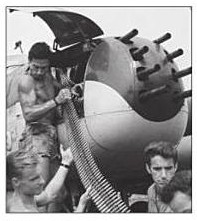
Cuban 23mm Anti-Aircraft Gun
As dawn broke over Cuba, the airstrikes commenced. The first taste of combat for the Brigade pilots was sweet. They delivered their ordnance with determination and made attack after attack through heavy anti-aircraft fire. The damage they inflicted was heavy, but not crippling to the Cuban air force which was their primary target.
Initial pilot reports "put damage at 50% of the offensive air capability of Camp Libertad, 75-80% aircraft destruction at San Antonio de los Banos, and the destruction at Santiago included 2 B-26's, 1 DC-3, 1 Lodestar, and 1 T-33 or Sea Fury. Subsequent photographic studies and interpretation assessed a greatly reduced estimate of the damage, amounting to five aircraft definitely destroyed, and an indeterminate number of other planes suffering some damage. The attacking force lost one aircraft and crew to enemy anti-aircraft fire." [9].
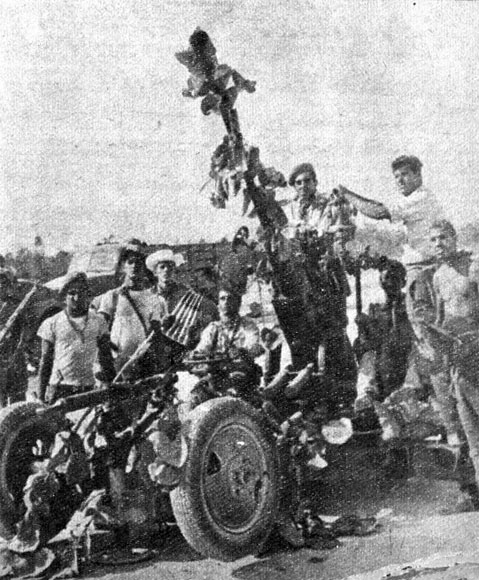
Czech-made, M53 Quad 12.7mm HMG Anti-Aircraft Gun
In the aftermath of the air strikes, Castro took his accusations to the U.N. that the strikes were the work of the Americans. He feverishly denied that the attacks had been made by defecting Cuban pilots flying his own airplanes, and challenged the U.S. to present the pilots at the U.N. for questioning.
The news media in the U.S. were in a frenzy. Although they were not allowed to meet with the pilots who had landed at Miami and Key West, they interviewed virtually everyone else. News releases came from the State Department denying U.S. complicity in the raids, but statements from the President's office and the Pentagon were conspicuously absent. While the statement of the pilots were dutifully printed, the media also hinted that there were many discrepancies in them. The cover story could not be sustained over a long period. On the day of the strikes, the story fulfilled its purpose and lent credibility to the U.S. position that the strikes were not sponsored by the American government.
Dean Rusk, the U.S. representative to the U.N., was not told of the deception and made an eloquent defense to Castro's accusations on the floor of the General Assembly. He was later very upset when he learned the truth, feeling that he had been duped by the administration.
[EDITOR: NO! NO! NO! Adlai Stevenson was our rep at the U.N.]
Although the story of the B-26's landing in Florida and their crews defecting achieved the desired effect of casting doubt on U.S. involvement, it was later to have a seriously adverse effect on the operation. The political pressure put on the administration, as result of the initial air strikes caused the President to be extremely hesitant to launch further strikes without first having the Brigade in control of the airfield at Giron. This left the remnants of Castro's air force free to operate against the Brigade on the beaches. It negated the assumption of air superiority, on which the plan was based, and very likely turned the tide of the battle.
In the wake of the air attacks, it became even more obvious to Fidel Castro that his island nation was on the verge of being invaded. He had reports from his agents, as well as, the American media reports that the Brigade had left their training bases. He knew they must be on their way. As Castro weighed the invader's options, he felt that there were two major courses of action available. A series of small, widely-spaced landings, or a single major amphibious assault. Several smaller landings would prevent the invaders from suffering a single crushing defeat. Numerous pockets of resistance along the coastline would split his forces and severely test his command and control network. This option also left choice of landing and then operating as a network of guerrilla groups.
[EDITOR: General Student on Crete in 1941 did this "multiple ink spot" strategy and it worked even against the Allies who knew EXACTLY what he was doing via ULTRA intercepts.]
He felt that if the Brigade landed in one area, with all of their men it would be to his benefit. In his opinion, a frontal assault by the Brigade would allow his numerically superior forces to liquidate the enemy rapidly. Castro's concluded that the Americans would not allow the Brigade to risk everything on a single beachhead. A total defeat would bring with it too much discredit, both for the U.S. and for the counter-revolutionary movement.
[EDITOR: Castro under-estimated American laziness and stupidity.]
Acting on his decision, Castro studied the coast for probable landing sites. Then he sent small groups of 100-500 men to these sites to keep watch and build defensive positions. The area around Trinidad (the original site chosen for the operation) was especially heavily fortified, as were all approaches to the mountainous areas, to prevent the forces from gaining access to the terrain which Castro knew from experience would favor guerrilla operation. There was nothing left to do but watch and wait. [11].
The offices of the CIA, State Department, Pentagon, and the White House were buzzing with activity. Everything was ready for the invasion, the wheels were turning and the first blow had been struck; but still President Kennedy had not given the authorization for the actual invasion to commence. There had been numerous meetings, over the past few weeks, all of them ending without a decision. The only person who had aired any doubts about the operation had been Senator Fulbright; but he had been very moderate in his attack of the plan. Everyone felt the decision would be to go with the operation, yet there was an air of hesitancy until the formal approval was given.
The 24-hour deadline passed. Finally, about mid-day on D-1, 16 April, 1961, President Kennedy phoned Richard Bissell and gave him the go-ahead. [12]. The mood at CIA headquarters immediately became one of jubilation. It was a tremendous relief to finally know that the year's worth of effort and millions of dollars spent on the operation would not be scrapped at the last minute.
The decision of President Kennedy to continue had been based on the following logic:
It offered what appeared to be a last chance to overthrow Castro by Cubans before the weapons and technicians acquired from the Communists and the repressive internal measures which would make the task too hard without overt U.S. intervention. It was recognized as marginal and risky, but the Cuban Brigade, if not used quickly, would become a political liability, whereas used in a landing it might achieve important success before Castro became too strong. Even if unable to hold the beachhead, something would have been accomplished as the Brigade could turn guerrilla and provide a strong reinforcement to the resistance movement on the island. [13].
[EDIOR: WHERE WAS THE TANGIBLE PLANS AND GEAR FOR PLAN B--a 51-MILE EXODUS TO THE ESCAMBRAY MOUNTAINS? JFK should have insisted on seeing it in the OPLAN. He could read a map. He read 1200 words-a-minute. Why didn't he ask how 2506 would move to the mountains?]
Upon notification, the extensive propaganda program conceived by the CIA was executed as planned. Radio Swan and 11 other CIA controlled stations began an intense propaganda blitz. They also included in their broadcast coded messages for operatives inside Cuba to execute pre-planned missions. Most of these were never carried out. The only failure was the planned leaflet drop by the Brigade air force planes. The tactical decision was made, that bombs would be more necessary than the leaflets and so, the drops were cancelled.
Late Sunday afternoon, a very significant event occurred at CIA headquarters in Washington. The message giving the order for the dawn airstrikes the following morning was drafted and sent to the Deputy Director of the CIA for release. He asked the operative who brought him the message if the strike had been cleared. The operative, who was aware that the strike had been an integral part of the plan, replied that they had been cleared. As a precaution the Deputy Director decided to check with Dean Rusk. After a few minutes, McGeorge Bundy, the special assistant to the President, telephoned the Deputy Director and informed him that no strikes were to be flown in support of the operation until the airstrip at Giron had been secured. If further consultation on the matter was required, it should be discussed with the Secretary-of-State. [14].
[EDITOR: if that was the fiction, send a small unit ahead of everyone else and "secure" the Giron airfield.]
In reflection, this decision must have been made in light of the political pressure brought to bear on the United States at the U.N., as a result of the cover story told by the pilots who had landed in Florida the previous day. The administration was not willing to risk dropping the final shreds of denial of complicity in the operation, even for something as important as the chance to finish off Castro's air force before the invasion began.
Richard Bissell was called in and appraised of the situation. He knew at once that the strike was vital to the operation; he and the Deputy Director [USAF MG Charles Cabell] then met with Rusk at the State Department. Rusk listened to the two men's objections of the cancellation of the air strikes and agreed to call the President for a decision. They listened as he told the President that they were in his office and were urging reconsideration of the decision to cancel the strikes. He reported their opinion that the strikes were very important to the success of the landing, and then stated, "I am still recommending, in view of what's going on in New York, that we cancel." [15]. The president agreed.
What were probably the most important air strikes of the invasion, were cancelled on political grounds.
[EDITOR: so here its former U.S. Army INFANTRY Colonel in CBI in WW2 Rusk telling JFK to not finish-off the Cuban AF; a man who surely must have felt being strafed and bombed by Japanese planes...disgusting.
A new message was drafted and sent to Puerto Cabezas, canceling the strikes. It arrived just after the engines had been started on the strike aircraft. When the senior American official read it, he immediately sent a protest back to Washington. Fresh U-2 photographs indicated that Castro had at least 2 T-33's and some Sea Furies operational. It was vital that these aircraft be destroyed. [16]. He received a reply quickly restating the cancellation. No one in the Department of Defense or JCS chain- of-command was questioned on the effect of the cancellation, or for that matter even notified until the following morning.
To the average American, the reason for the failure of the Bay of Pigs operation was the lack of air cover. The strike that had just been cancelled had been designed to decimate Castro's air force on the ground, thus eliminating the need for defensive air cover for the Brigade. This would allow the Brigade pilots to concentrate their efforts on offensive [close] air support for the ground operations. If Castro was able to operate any tactical aircraft at all, the Brigade would be at their mercy throughout the invasion.
The CIA immediately recognized the seriousness of the cancellation of the air strike and took what action they could. They immediately notified the Brigade leaders and warned them that enemy air attacks would be likely during the invasion. They ordered the ships to expedite unloading and to withdraw from the beach before dawn. They set up a schedule to give the ground force continuous B-26 cover during daylight hours and had the JCS alert the naval forces to the possibility of receiving the mission of providing air cover. The deputy director of the CIA personally called on the Secretary of State and requested that the U.S. Navy provide air cover and early warning destroyers to protect the now vulnerable ships of the Brigade. The request was put to the President. He disapproved the air cover, on the grounds of the President's original policy of no direct involvement by the U.S. military. He did, however, authorize the use of the early warning destroyers for ship escort, with the proviso that they were restricted from operating any closer than 30 nautical miles from the Cuban shore. [17].
[EDITOR: CIA should have used their propensity for rebellion to launch the strikes to finish-off the Cuban AF anyway. It beats losing an invasion and assassinating a President later. An ounce of prevention...]
The men of the Brigade were very crowded aboard the freighters. The ships, which were not designed for troop transport, were overloaded with supplies and equipment and the men slept wherever they could find space. It did not matter, as the voyage was short and spirits were soaring because of the imminent action. During the trip, plans were completed, last-minute orders issued by small unit leaders, and some training was conducted. Aboard the Atlantico, the machine guns installed aboard the ship for protection were being fired for training when the hastily-welded, deck plate broke loose. There was a group of 20 men sleeping on the deck below, and the barrel of the gun dropped and fired through the deck. One man was killed and two wounded, one very seriously. The captain broke radio silence and asked for help. The USS Eaton, a destroyer, responded and took the wounded men aboard for medical treatment. They were the first casualties of the invasion.
Around noon on April 16, 1961, the officers of the Frente met at the Statler Hilton in New York City and drafted an announcement for later release of the commencement of the invasion. They then left, via the kitchen exit, to avoid reporters and drove to Philadelphia. There, they boarded a small private plane and were flown to Opa-Locka Airfield in Florida; there they remained under guard in an old barracks to await their planned trip to Cuba after the invasion force had secured a beachhead. [18]. These men, the highest officials of the Cuban government-in-exile, felt that they were being held prisoner by the Americans at the very time when they should have been with their men. They were not at all satisfied with their treatment over the next two days.
Shortly after 2000 on the night of April 16, 1961, D-1, the lead Brigade ship and four other freighters of the Garcia line rendezvoused with the USS San Marcos. The San Marcos was the landing ship dock (LSD) which had brought the landing craft for the Brigade to use. The San Marcos transferred three landing craft utility (LCU) and four landing craft vehicle and personnel (LCVP) to the Brigade, exactly 30 nautical miles off the Cuban coast. These craft were already loaded with trucks, jeeps, and some tanks. Just as the transfer was complete, a landing craft mechanized (LCM) arrived under its own power and was also transferred to the Brigade. This was the final step for the invasion, and now, the Brigade, in control of its landing craft, was fully operational for the first time.
The Brigade fleet sailed into the mouth of the Bay of Pigs and split their formation, proceeding to their assigned areas -- Blue Beach at Giron and Red Beach at Playa Larga. The landing at Blue Beach was designated the main attack and the landings at Red Beach and Green Beach were the supporting attacks.
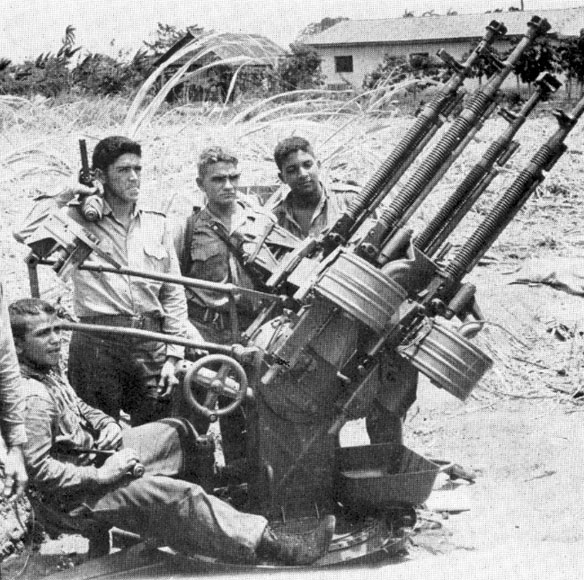
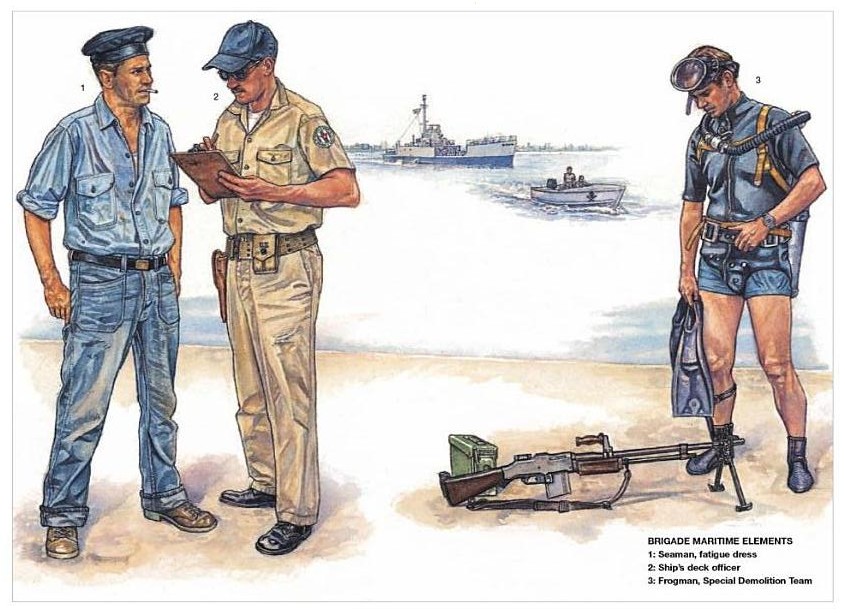
The initial operation of the invasion was the landing of the advance force of the 2nd Battalion. When the advance force of frogmen disembarked from the Blagar they were surprised to find that one of the CIA agents [Grayston Lynch?], who had been their advisor, had decided to accompany them to the beach. It was not his intention to land with them but only to see them safely ashore.
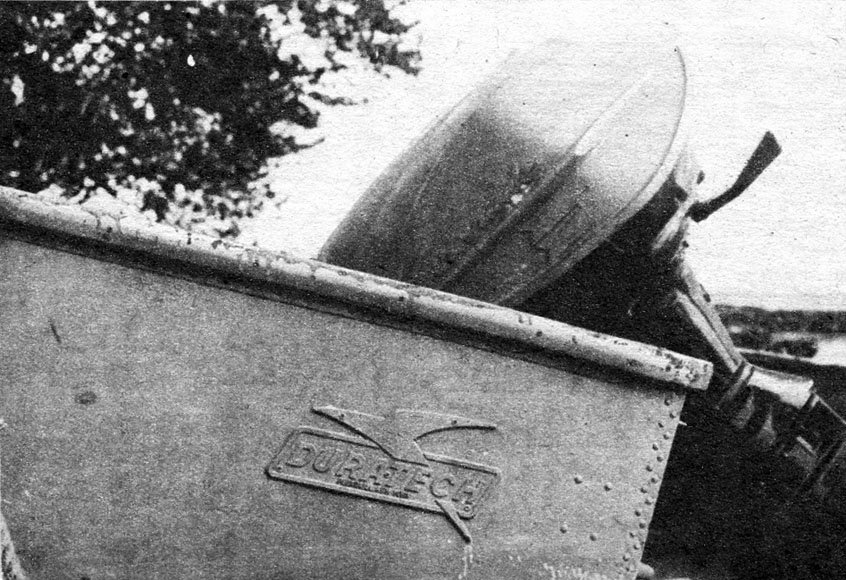
The landing party would go ashore in an 18-foot Catamaran with two 70 horsepower outboards. It would tow a rubber raft which would be manned about 600 feet from the beach and be used for the final approach. They planned to land near a rock jetty on the extreme right of the beach and then to place marker lights ashore to guide the landing craft to the landing site. Intelligence sources indicated that the area should be quiet, and that the bulk of the population were construction workers who should be asleep at the time of the landing.
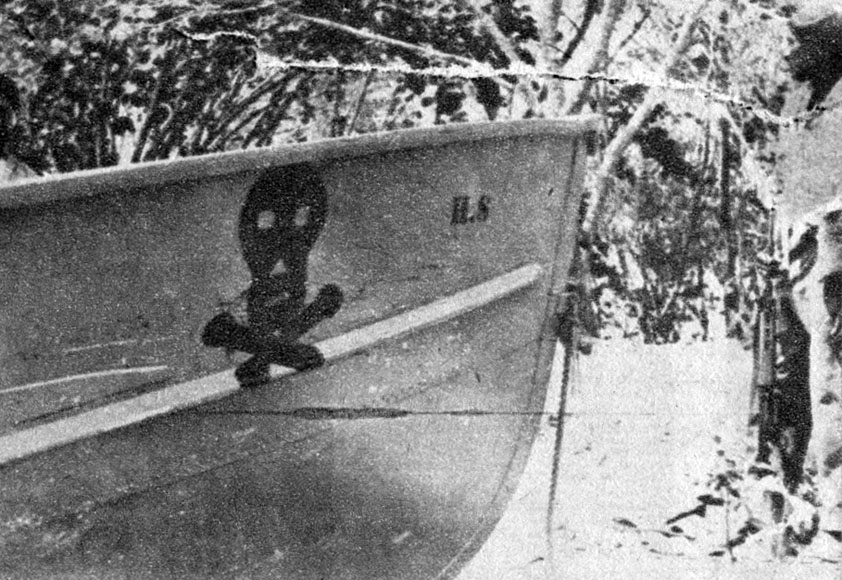
As the Cuban exiles came in sight of the area, they were totally surprised. The Cubans had installed bright arc-type vapor lights at the construction sites along the beach and there were small groups of Cubans scattered there talking among themselves. To the landing party, the area was lit up like an amusement park. The American advisor saw immediately that the landing site had to be changed on-the-spot. He knew that the change would cause confusion, but made the decision to alter the location of Red Beach. He also decided, that for the change to work, that he would have to land himself and conduct the operation. [19]
The American advisor joined the Cubans in the rubber raft and they proceeded toward the darker section in the center of the beach. About 150 yards off shore, one of the beach marker lights suddenly started blinking. Someone covered it almost immediately, and found the switch to be in the "off" position. A short circuit had caused it to come on.
About eighty yards off-shore, the engine bottomed out on a sharp coral reef that ran almost the entire length of the beach. This reef had shown up on the reconnaissance photos, but had been interpreted as sea weed. This would prove to be an extremely costly error.
[EDITOR: why you must do in-person recon of beach landing sites DAYS before actual landings]
The men got out of the raft into waist deep water and waded toward the shore. They were about fifty yards off shore, when they heard a jeep coming down the beach. It stopped adjacent to them and swung its headlights around onto them. The American fired on the jeep with a BAR [7.62mm x 82mm "30.06" cartridges, heavy and hard to control on full-auto, but an excellent weapon] and was joined by the Cubans. They riddled the jeep with machine gun fire and knocked out the headlights. They did not take any return fire. These were the first shots fired in the Bay of Pigs invasion. [20]
[EDITOR: so much for "stealth" landings]
Immediately after the incident, the lights all over the town went off. A truck loaded with militiamen started down the beach toward them. The men of the advance force radioed the Blagar and requested help. They were soon engaged in an intense firefight with the militiamen. San Roman decided to begin the landing of the Brigade. He was in one of the lead landing craft and soon had enough men ashore to establish a small beachhead.
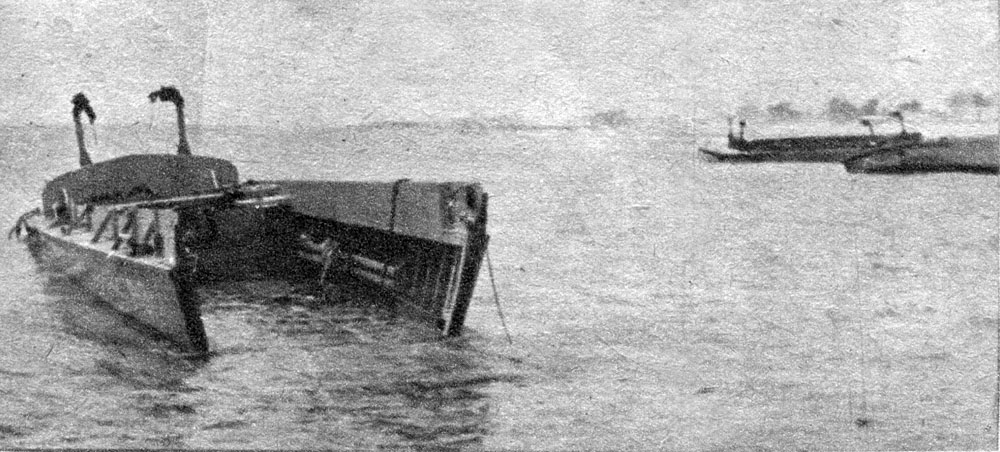
The trouble really began when the first wave of the main force headed ashore from the Caribe. The reefs were unknown to the invasion force until their boats struck them at full speed. Many boats sank on the spot, and most were at least delayed. The invasion schedule was delayed and the advantage of surprise had been lost. The frogmen worked throughout the night to find a safe path through the reef for the invasion forces landing craft.
[EDIOR: Hawkins! Where was your pre-planning beach recons?]
The 4th Battalion was landed and given the mission of securing the air strip. Intelligence had indicated that it would require some engineering support to become usable.
[EDITOR: if this was so, why not stick to the TRINIDAD Plan's air strip?]
Photos indicated piles of sand and gravel on the runway, and that some trees would have to be cut down to allow for a safe approach. But San Roman was informed that the air strip was secure and usable. The expected obstacles did not
exist. The Brigade aircraft now had a place from which to operate on Cuban soil. [21]
[EDITOR: if controlling the airfield was the pre-condition to launch the strikes on Castro's AF why didn't as soon as this happened they radioed back to launch the planes? It was still dark out. Bissell/Cabell were not on the ball to find/create a loophole to get those planes launched ASAP]
As San Roman set up his headquarters in Giron, the orderly unloading of vehicles and supplies commenced. Although the beachhead at Blue Beach was secure, Castro's militiamen had been able to transmit the alarm to troop and air force headquarters in Havana before the Brigade had destroyed a microwave antenna in the area. San Roman evaluated the situation and made the decision to cancel the landing at Green Beach and consolidate its troops, equipment, and supplies at Blue Beach. [22]
[EDITOR: would this delay or speed-up the landings?]
In spite of resistance, all vehicles and tanks were unloaded at Blue Beach by 0730. All personnel were ashore by 0830. [23]
[EDITOR: HOW MANY total vehicles?]
At Red Beach, the American advisor (a CIA man) who had disobeyed his orders, and the Cuban frogmen were able to place their marker lights, in spite of immediately coming under fire from Castro's forces.
[EDITOR: too bad such a CIA man were not in Nicaragua willing to send the strike in to finish off Castro's planes!]
They radioed back to the Barbara J and the Houston to expedite the landing, and set up a hasty defense of the beachhead against a rapidly increasing militia force.
As the Houston came within range, the machine guns on the beach opened up on her. The attack was answered by her gunners, catching the frogmen in a crossfire. She was able to silence the guns from the shore, but in the process one of the frogmen was killed. This was the first Brigade casualty of the invasion.
[EDITOR: good thing the cargo ships had guns at all! Good job, CIA]
Erneido Olivia, the commander of the Brigade forces at Red Beach, also saw the need for his leadership ashore earlier than expected. He changed the landing sequence and came ashore in one of the first waves with his staff. [24]
[EDITOR: good leader.]
The 2nd Battalion was very slow in coming ashore. The navy landing craft were planned to be utilized for the movement of the heavy vehicles and supplies. Personnel were primarily to be transported in small, fiberglass launches with outboard engines. This caused a major problem, as the outboard motors proved to be unreliable as numerous failures occurred. The small launches did not have much freeboard and were unable to withstand the heavy seas. Many were swamped on their way to the beach. Although there were only 185 men in the 2nd Battalion destined for Red Beach, by 0530 all of the men were still not ashore. The 5th Battalion never did get ashore because of the boats and poor leadership. [25]
[EDITOR: WTFO? What were you doing Hawkins? Why weren't they trained to paddle in if the outboard motors failed? All men must be drown-proofed (gear floats via waterproof bagging) and able to SWIM in with weapons in worse-case scenario. Give them swim fins. So what did the entire 5th battalion do for the next 3 days?]
Once ashore, Olivia ordered his men to seize and destroy the microwave station in Playa Larga. When the station was seized, the equipment was found to be warm and all the transmit switches were in the "on" position. The alarm had been broadcast from there, also.
At 0315, Fidel Castro received the news of the invasion. He was informed of the landings at Playa Larga and Giron and ascertained that his militiamen in the area were resisting. Castro ordered confirmation of the information, and quickly received it. Fidel then alerted the forces that were in the area, consisting of several platoons of militia stationed at the Central Australian Sugar Mill and a battalion containing three mortar batteries in Matanzas Province. The troops at Central Australia were not able to mobilize until dawn and the others a little while later. Castro also ordered three battalions from Las Villas Province to Yaguaramas and Covadonga to protect the other two major highways into the Zapata Swamps. He issued orders to the air force to commence its attack at dawn on the ships at Playa Larga and Giron. [26]
Castro recently recounted the BOP invasion; as a guerrilla fighter he knows the importance of TBATE--the terrain.
Castro planned to crush the invasion at Playa Larga first, since it was the furthest inland. Then his forces would attack the beachhead at Giron, flanked by the swamps with few cross-roads. He knew that the landing of the provisional government must be prevented at all costs. After outlining his plan and issuing initial orders, Castro departed for the Bay of Pigs.
[EDITOR: at this point, 2506 should hold Castro coming south at Playa Largo, then move everyone else in flying columns to the east into the Escambray mountains. The chance for a coup de main surprise attack all the way up to Havana was thwarted.]
The situation at 0400-0530 was fairly stable. Beachheads had been established at both Red and Blue Beaches. Men and equipment were pouring ashore (although slower at Red Beach). Both San Roman and Olivia established their headquarters and command posts, but were at that time unable to communicate with each other.
[EDITOR: Let me guess; they had never rehearsed an actual amphibious landing anywhere, had they?]
The Brigade had pushed inland in both areas and the airstrip had been secured at Giron. Although considerable confusion existed, the plan was generally being followed except for the cancelled landing at Green Beach.
Then the Brigade received word that Castro still had operational aircraft and that they should expect to be attacked from the air at dawn. They were advised to have the ships put back to sea before the attacks began, and expect them to return the following night. There was no time to coordinate such a change.
[EDITOR: then why then were the ships sitting ducks at dawn and destroyed?]
At 0600, the frogmen reported that they had charted a path through the reefs. At 0625, as the landing craft from the Blagar were moving the tanks and troops of the Heavy Gun Battalion ashore, they were attacked by a B-26. The B-26 was soon joined by a T-33 and several Sea Furies. The remainder of the Heavy Gun Battalion, as well as the 3rd and 6th Battalions, were forced to land while receiving heavy fire from the air. [27]
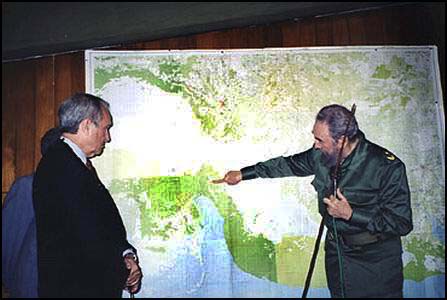
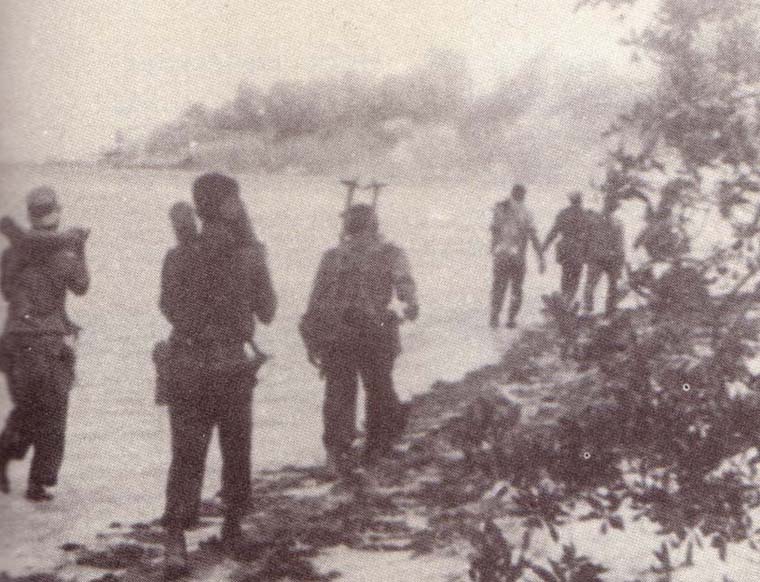
At 0630 the Houston was crippled by air attack. The captain grounded her on the west shore of the Bay of Pigs, about five miles from Red Beach. [28] The 5th Battalion was aboard the Houston when she was hit, along with ammunition and fuel for the Brigade. The field hospital was also aboard the Houston. Most of the men of the 5th Battalion were able to get ashore, although they could not get organized, and never became a viable unit throughout the battle. At least twenty-eight men died in the sea.
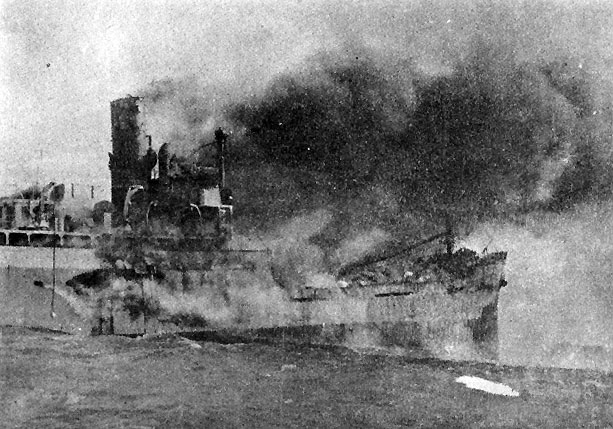
The first air attack ended at 0700. The Brigade had been able to bring down 2 of Castro's B-26's, but had suffered great losses themselves. The doctors on the beaches were overwhelmed with casualties, and many of their medical supplies had been lost when the Houston was sunk. Most of the Radio equipment that had been brought ashore, had been soaked with salt water, and was inoperable.
[EDITOR: any waterproofing done beforehand?]
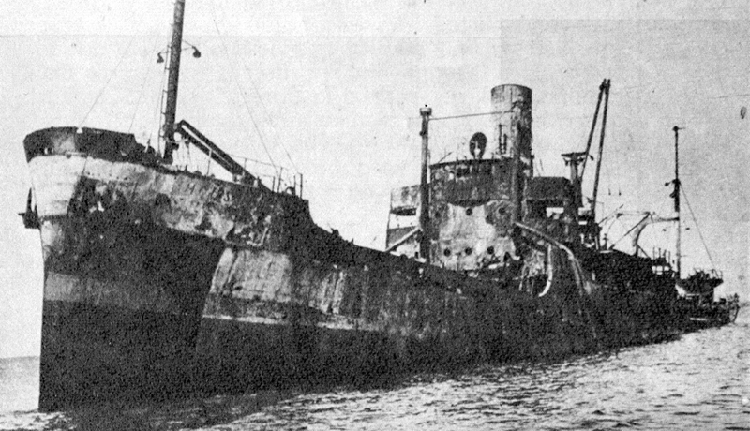
In the confusion of the landing and air attacks, units had been separated, and command and control disintegrated and adequate communications ceased. Despite these problems, the beachhead was secure and Castro's ground forces in the area were unable to gain ground against the Brigade.
At 0730, the men of the Brigade saw the 5 C-46's and 1 C-54 pass overhead with Paratroop units enroute to the drop zones. In the drop zone north of Playa Larga, the heavy equipment was dropped first, followed by the Paratroopers. The equipment landed in the swamps and was never seen again. The advance force also landed there and was ineffective for a considerable period of time. The other units landed under fire and some fell behind enemy lines. Several were killed while still in their parachutes.
[EDITOR: they should have dropped at NIGHT to precede the invasion. They might have even taken out the microwave transmitter; at least taken the airfield ASAP so that Rusk/JFK would be satisfied so the air strikes to finish off the Cuban AF would be launched. However Hawkins was a typical arrogant USMC type--and didn't understand 3D Airborne maneuver. Landing together by daylight the Paras blocked roads, but even then THEY WERE TOO CLOSE TO THE BEACHES as Castro himself pointed out later. Where was the Airborne advisor for Operation ZAPATA/PLUTO whateverthefuck it was called?]
The other Paratroop units landed safely without organized opposition and proceeded to their blocking positions along the roads to Covadonga and Yaguaramas. These blocking positions were each manned by almost 20 men; their weapons consisted of a 57mm [recoilless rifle] cannon, a .30 caliber [medium] machine gun, a [2.36" or 3.5"] bazooka, and an [BAR or Johnson 41?] automatic rifle squad. Fortunately, they were heavily equipped, since they came under attack shortly after getting into position. They performed well in the engagement on Eastern front.
The airborne drops secured two of the three main roads. But the road to the north of Playa Larga to Central Australia remained open. But this was where Castro's forces concentrated and therefore posed the major threat to the exiles. San Blas was the only area where any real support for the Brigade was shown by the populace. A number of local citizens offered assistance to the paratroopers, volunteered to carry supplies and water, and worked as nurses. 5 civilians volunteered to fight; they were given uniforms and weapons and integrated into the Brigade unit. [29]
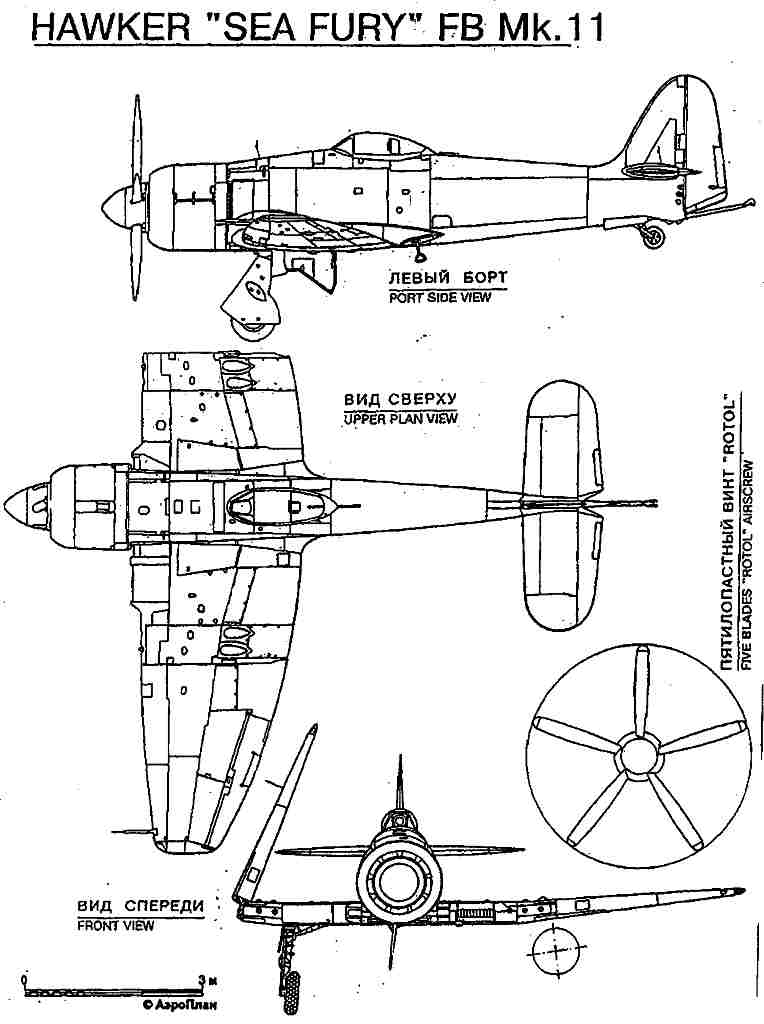
Back at Red Beach, the air attacks were renewed. A Sea Fury scored a direct hit on the Rio Escondido. She had 200 [55 gallon] barrels of aviation fuel stored above decks and the Sea Fury slammed a rocket directly into the middle of the AVGAS. The fire extinguishers abroad were totally inadequate for the [11, 000 gallons] gasoline fire and the captain saw immediately that his ship was lost. He gave the order to abandon ship and called the Blagar for assistance. The crew abandoned ship and were all rescued, with only one man sustaining any injuries. After the crew left, the ship was totally destroyed by three tremendous explosions, the sound of which were heard all the way to Giron. [30]
The loss of the Rio Escondido dealt a particularly heavy blow to the Brigade. Her cargo was vital for the fighting force. She had aboard the first 10 days mount out of ammunition, fuel, food, and medical supplies for the entire force. Equally important, however, she had the communications van aboard, which was the heart of the brigade radio communication system, and provided the only means of communication with the Brigade aircraft.
Two of the Brigade's five ships had now been destroyed, along with their valuable cargo. Another ship, the Barbara J had been damaged by machine gun fire and had lost two of her engines, and was taking on water.
The leaders of the Brigade, hampered by extremely poor communications, could not make an accurate evaluation of the situation. San Roman, the commander of the Brigade could not contact any of the units outside the immediate area of
Blue Beach. He had never had any radio communications with the Paratroopers and he could not even talk to the ships which had brought him to the beach and were to resupply him.
About 1000, San Roman made radio contact with Olivia at Red Beach. The news was not good. Olivia reported his units all ashore and involved in heavy fighting, except for the 5th Battalion which was no where to be found (they had abandoned the Houston five miles from Red Beach and were never to enter the battle). Olivia reported that he had no communications with the Paratroopers, who had dropped to the north of him; but he felt that something had gone wrong, since the enemy was still coming down the road that they-were supposed to be blocking (the Paratroopers in this zone were either lost or retreating by this time). He asked San Roman to send a tank and a squad of infantry to reinforce him. San Roman agreed, and immediately dispatched the tank and infantry. [31]
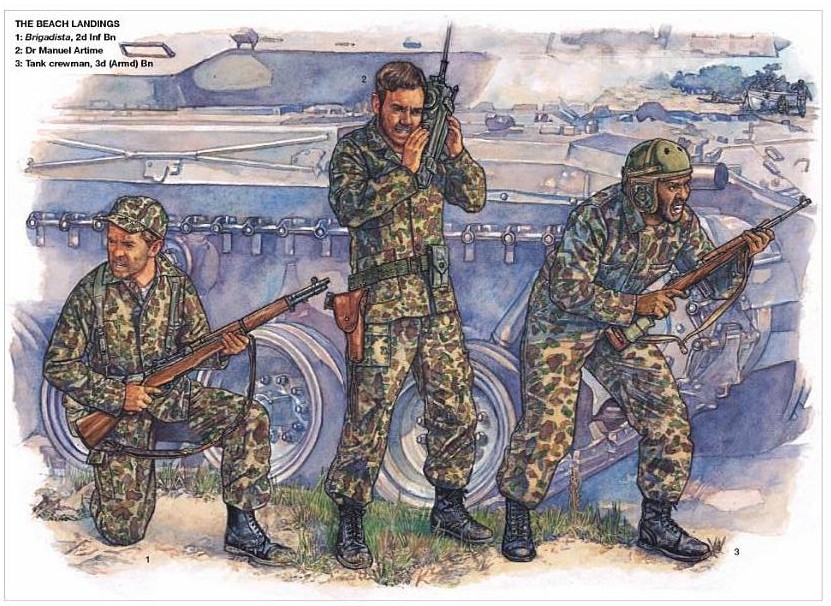
By noon of D-Day, San Roman was beginning to put together the situation. The Brigade was pinned down on the beachhead. Their supply lines were temporarily cut when the ships put back to sea. They had very limited communications, with most messages being sent by messenger. They had received only limited air support from the Brigade aircraft, and were almost constantly under fire from Castro's planes. Still, the Brigade had established itself a shape and appeared capable of giving the Castro units a full measure of battle.
[EDITOR: Minus 5th battalion San should have switched to Plan B--block the road leading into Playa Larga and get his forces moving east to the Escambray mountains! He no longer had any chance of marching on to Havana. No popular uprising.]
The battle plan of the Castro forces was becoming apparent and it surprised the Brigade leaders. They had assumed that Castro's main thrust would be from the east through San Blas to Giron road.
[EDITOR: WHY would they ass u me this? Castro is in Havana to the north, duhh.]
They had deployed their forces to defend against this expected attacks.
[EDITOR: this is fine--this is the direction you need to be going! Make them the spearhead!]
It was now becoming obvious that Castro was attacking with his main force from the north down the road and railroad bed from Central Australia; this would drive a spearhead into Playa Larga and Red Beach. This was the more lightly defended area of the Brigades forces and could certainly not withstand a heavy sustained attack.
[EDITOR: this is fine! Rear Guard action! Don't defend this to the death--get your main body moving east!]
Meanwhile, the war in the air was not going well. One of the C-46's, which had dropped its Paratroopers, had been shot down by a Sea Fury earlier in the day as it had turned back out to sea.
[FALSE--lying marine syndrome again--the C-46 by turning into the Sea Fury made it go away.]
A B-26 had been shot down by a Castro T-33 as it made a bomb run in support of the Brigade, and another was forced to ditch into the sea about halfway back to Puerto Cabezas, Nicaragua, after having one engine shot out and additional heavy battle damage. One Brigade pilot reported that he had been receiving fire from two Castro aircraft when U.S. Navy jets had joined on them. The Castro planes had broken off and fled, but the Navy jets had never fired on them. [32]
A Brigade C-46 on a resupply mission tried to land at the Giron airport. However, he turned back within sight of the beachhead when informed over the radio by a B-26 pilot that 2 T-33's were in the area.
The Brigade now had full control of an usable airfield but it could not be used because Castro had been able to maintain air superiority.
[FALSE: you can certainly use it at night, careless-with-the-facts, marine fucktard author.]
The four remaining ships had left the coast and had been ordered to proceed beyond the 12 mile limit. The Atlantico and Caribe had pulled out first, with the Blagar escorting the crippled Barbara J. Although under air attack, none suffered significant damage and the Blagar even managed to shoots down a B-26 which crashed so close that wreckage ended up on fire on decks.
The ships planned to rendezvous about 50 miles out to sea and then to move back to the twelve mile limit during the night. They would then unload their cargo onto the remaining landing craft and lighter it ashore. The men on the ships knew that the Brigade was using so much ammunition that they would need resupply after the first days fighting.
The Barbara J and Blagar reached the rendezvous point, but were unable to communicate with the other two vessels. The Atlantico and Caribe had actually left the area and headed south. Navy destroyers intercepted the Atlantico 110 nautical miles south of the beachhead and convinced her to return; she would not arrive in the area again until 1830 on D+1, 18 April, 1961. Another destroyer did not overtake the Caribe until she was 218 nautical miles south; she was never again available for resupply to the Brigade before the beachhead collapsed. [33]
As D-Day drew to an end, the Brigade held a tenuous position. They maintained the beachhead around both Red and Blue Beach, as well as the airfield at Giron. The forces at Red Beach were bearing the brunt of the action; casualties were high and ammunition and supplies were low. The Castro forces were threatening to push down the road into Playa Larga, while the Cuban Air Force controlled the skies.
Brigade air support had been weak and they had lost four aircraft. 2 ships supply ships of the Brigade were sunk, and 2 more had completely departed the area. Most of the medical supplies had been lost with the field hospital aboard the Houston and medical treatment for the wounded was scarce.
[EDITOR: vital supplies must be cross-loaded all ships not placed in one. Hawkins?]
Overall, the situation looked bleak--but not hopeless. (See Figure III-2 for actual deployment of forces at the end of D-Day.) [34]
Meanwhile it had been an eventful day back in Washington. The personnel manning the command post were receiving only sketchy details of how the operation was proceeding. Generally, with the poor communications, they were operating about 12 hours behind events at the beachhead. Much of their information was coming from what the Brigade pilots saw and reported in their debriefings back in Nicaragua. They were getting some details from the men aboard the Blagar and the Barbara J but, it too, was second hand and not timely.
They knew that the supply of ammunition was getting low and ordered air drops from the base in Nicaragua for the night of the 17th. Missions were flown by 4 C-54's and 2 C-46's. Of these, five of the drops were successful but the cargo of the sixth was blown into the sea. [35]
[EDITOR: pretty damn good for folks who were judged unable to do night drops in training! Go 2506!]

The Barbara J and the Blagar were ordered to resume resupply after nightfall. Some supplies were delivered ashore, but the limited remaining landing craft were not able to sustain the needs of the Brigade.
[EDITOR: so these ships were dependant upon small boats and once lost fucked? Where was the Plan B?]
It had been a day filled with failure. One of the most puzzling of these had been the failure of the CIA to notify the network of infiltrators and Cuban underground of the invasion, even after it had begun. One infiltrator later reported that around noon of D-Day, he finally received a message that the invasion had begun and to blow the bridges between Playa Larga and Central Australia. He could not do this because of the massive Cuban mobilization. It would have made little difference anyway, since the militia had crossed the bridges he was ordered to destroy six hours earlier. The failure to use the covert forces available to the CIA cost them the opportunity to divert Castro's forces and allowed them to focus on the actual site of the Brigade's invasion. [36]
[EDITOR: no fucktard, marine...the failure to drop the Paras at night by SURPRISE to blow these bridges up were the PLANNING FAILURE of incompetent USMC egomaniac Colonel Hawkins and staff--who think poorly like YOU--and didn't even think of using the Airborne for this because it threatens weak marine egos. However, the whole defend the beach-head-to-the-death madness was crap---Plan A should have been to maneuver to the Escambray mountains. Sabotage actions by Paras to blow these bridges would have slowed Castro long enough to effect this movement. ]
Political turmoil reigned in New York and Washington. The cover story, told by the "defecting pilots" who had landed in Florida, had been broken by a reporter who had inspected one of the planes and found it to be a different model than those flown by Castro's air force. He had found the bombay hinges covered with undisturbed dust and grease and the guns uncocked and unfired. He also noticed that the rocket mounts were disconnected and covered with corrosion. [37]
[EDITOR: so 2506 loses 2 B-26s to this masquerade? At least have them bomb and strafe something en route to the USA.]
The disclosure of this information had unleashed chaos within the United Nations. The Soviet Premier, Niketa [Nikita] Khrushchev, had sent a strongly worded message to President Kennedy in which he denounced the U.S. aggression and accused Kennedy of threatening world peace. The Soviet leader promised that the Soviets would support the Castro regime, even if it meant armed intervention.
But some of the news media had bought the official cover story put forth by the government: that there had been no invasion, and the action in Cuba was attributed to a small number of Cuban exiles (200-300) trying to land supplies for the underground. However, others did not believe it.
In the United Nation, ambassador Stevenson was doing his best to hold off the charges of the Cubans that the attack had been launched by mercenaries paid, trained, and supplied by the U.S. government. With a great deal of showmanship, he read off a list of the more prominent participants in the Brigade and the Frente. As he would read a name, he would give the position the man held in Cuba prior to leaving for the United States. The list was quite impressive and included almost two thirds of Castro's original cabinet.
At the CIA, the situation was becoming all too obvious. Even though the officials recognized the first signs of failure, there was very little they could do little about it. The CIA Command Post had already ordered the air drop of resupply ammunition and given orders to the ships to continue resupply operations after nightfall. Now, all they could do was just wait and hope the Brigade could change the situation through the application of its combat power.
[EDITOR: you mean head for the Escambray mountains, there was no marching on Havana.]
The Joint Chiefs had taken all steps to ensure they would be ready if called upon to intervene in the battle. They were ready to offer any support ordered by the President and had moved several aviation units within striking distance to bases in the south. The Navy, which was the closest service to being actually involved, was ready to assist with air cover, escort, or naval gunfire, as soon as the order was issued. Still, President Kennedy clung to his policy that the U.S. military forces would not be involved in the invasion of Cuba.
At Opa Locka airfield, just outside Miami, Florida, the Cuban exile officials of the Frente were still waiting to be transported to the beachhead. They still remained under strict guard in the old barracks, but had been furnished with a radio by their guards. They had it tuned to Radio Swan and were receiving only reports that the invasion forces were winning the battle. This made them even harder to control. They were anxious to fly immediately to their homeland and be part of the victory.
[EDITOR: why weren't Frente trained to parachute jump? Drop them into Giron airfield immediately if you need a "provisional government" excuse to get JFK to commit U.S. troops. If that was never going to happen, IMMEDIATELY move to the Escambray mountains, use your fighting strength to break into them--not hold a swamp.]
It looked like it was going to be a long night for the men at Red Beach. They had caught a Cuban column in an ambush late in the afternoon and efficiently annihilated it. From the prisoners they had taken, the exiles learned that Castro was massing his forces at Central Australia; this meant there would be a major attack that night. Olivia had the men of the Brigade prepare defensive positions astride the main road and railway bed. [38]
At Blue Beach, San Roman was also ordering his men into the defense for the night. There had been periods of heavy fighting along both roads into the area as Castro's forces had probed his positions. Now, as nightfall came, the advance post on the road to Covadonga had come under heavy artillery fire; San Roman interpreted this as the preparation for an attack. San Roman assessed the situation well and sent the 4th Battalion to Red Beach to reinforce Olivia.
Olivia placed these reinforcements into his line. He deployed 6 mortars, and all the shells he had, to support his front and flanks, and sent 3 [M41] tanks to cover two crossroads where they had excellent fields-of-fire. He kept nothing in reserve as he prepared for what would become the "fiercest battle of the Bay of Pigs".
Back in New York City, the CIA's public relations office released what the press called the Cuban Revolutionary Council's Bulletin Number 3. It read:
The Cuban Revolutionary Council wishes to announce that the principle battle of the Cuban Revolt against Castro will be fought in the next few hours. Action today was largely of a supply and support effort to forces which have been mobilized and trained inside Cuba over the past several months. The tremendous army of invincible Soldier-Patriots has now received its instructions to strike the vital blow for the liberation of their beloved country. Our partisans in every town and village in Cuba will receive, in a manner known only to them, the message that will spark a tremendous wave of internal conflict against the tyrant. [39]
What a contrast with the actual situation at the Bay of Pigs. San Roman expected the ships to begin unloading sometime shortly after dark, and had a large work party standing by. He was sorely disappointed when no ships or landing craft arrived. He sent a 25-foot launch with a radio operator out to sea to try and locate the vessels.
They spent the entire night trying to establish radio contact with their supply ships. But their efforts were in vain. The Cuban crews aboard the Blagar and the Barbara J refused to return anywhere near the beaches.
[EDITOR: we cannot let this cultural disconnect pass. The malignant narcissists in the USMC go out of their way to call everyone else in DoD "pussies" and what not; even their own marine "support" personnel. You treat people like shit and it becomes a self-fulfilling prophesy. And don't even try to say "this couldn't happen in the USN"--when it already has happened. At Guadalcanal, supply ships had to leave the marines or be sunk--because we had lost control of the sea to the Imperial Japanese Navy. It wasn't about being a "pussy"--it was about being sunk and losing the supplies or being able to return later and deliver them. Here, yes the Cubans were being pussies since they were safe at night--but notice how on the first day they got caught in the open and lost 2 ships to air attacks. Something has to give. If you want the Navy to help you, it starts by treating them with RESPECT and making them want to help you as well as bolstering their own warrior ethos by arming and armoring their ships or better yet use submarines so they can withstand attacks. Macho FIDO crap talk isn't going to stop ships from being sunk from a SYSTEMIC GIDO undermatch that needs to be corrected through better equipment. Another help would be catapult-launched SEAPLANES owned & operated by the cargo ships to insure liaison (communications) even if radios don't work.
Overall, this whole linear war, lemming foot Soldier-from-a-rucksack-held-on-a-thin-umbelical-by-bureaucratic-resupply has to stop. Each squad of men should have their own tracked light tank carrying all the supplies they need to finish the entire mission so when they off-load they have everything they need and are self-sufficient.]
The first attack of the night soon occurred, but it did not come from the expected direction. The advance guard from San Blas made unexpected contact with a Cuban armored column. They planned to hold for a long as possible then fall back to another blocking position: but the Cuban forces were overpowering and all resistance gave way. The Brigade unit was lucky to have its remnants evacuated by trucks in front of the advancing hostile column.
The unit fell back a safe distance and was joined by a mortar unit. The observers saw the Castro forces coming down the road, advancing in the light of their own trucks and tanks. They held their fire until the enemy was well in range and then thoroughly routed Castro's column. The mortars halted any further advance toward San Blas for the rest of the night.
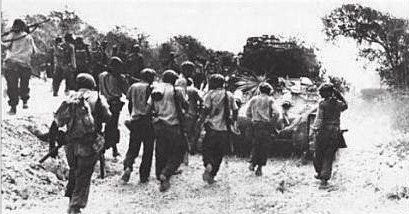
Shortly after this advance was stopped, the Paratroop company established contact in a position along the road to Yaguaramas. They had intercepted enemy radio transmissions and knew they were opposed by 4 infantry battalions and 2 companies of tanks. They allowed the lead units to close almost to their positions and then opened fire. The Cubans were hit hard and went into the defense. [40]
Assault Brigade 2506 3.5" Bazookas: Plenty of Ammo, Too
At 2000, the Brigade forces at Playa Larga came under fire from batteries of 122mm artillery. Olivia, fortunate enough to gain access to the enemy radio frequency, learned that the enemy was being reinforced with 40 tanks. He immediately deployed his bazookas to the front lines closest to the road. At 2355, the shelling stopped. Castro's artillery had fired more than 2000 rounds, but these had had little effect because of the long narrow front and entrenched positions of the Brigade. [41]
[EDITOR: Oliva a competent tactician had his men dig-in, Bravo, Sir]
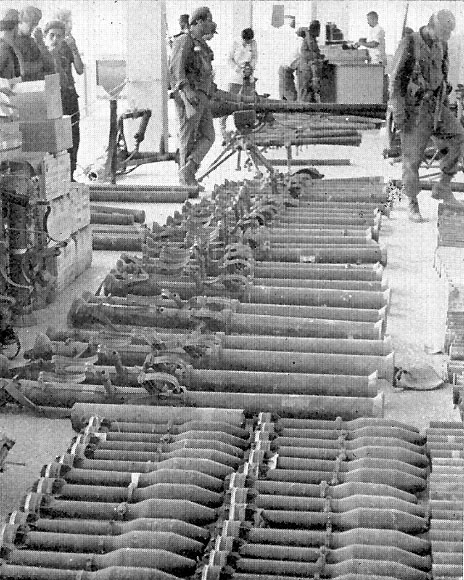
Castro troops dismount from a T34/85 Medium Tank A tremendous difference in forces existed, but the ideal defensive terrain made the difference. As the column of tanks rolled through the crossroads, the first two were knocked out by the Brigade tanks firing from a fixed position. As a third Castro tank came around the two disabled vehicles, a Brigade tank rammed into it, backed away, and then fired point-blank. He damaged the tread and the Castro tank withdrew. By 0020 the narrow road was so blocked with burned out tanks, that those behind them were useless.
[EDITOR: "ideal" terrain would be in the mountains, moron.]
Then, came the infantry assaults. At 0100, Olivia called in the mortar fire on the infantry with deadly results. The battle continued through the night. At 0445, the Brigade tanks pulled back, out of ammunition. The enemy tanks kept coming, working their way past the wreckage and toward the Brigade's lines. As one would be knocked out by Brigade bazooka fire, another would take its place. [EDITOR: where were the AT mines?] Just at dawn, when the situation was the most desperate for the Brigade forces who were almost out of ammunition, the tanks began to retreat. An hour later, a Castro tank rolled into the crossroads. The driver got out, surrendered, and stated he wanted to join the Brigade. He explained to Olivia that over the night Olivia's 370 troops had faced and defeated over 2,100 men (300 regular soldiers, 1600 militia, and 200 policemen) and over 20 tanks. The enemy had suffered over 500 killed and over 1000 wounded; Olivia had lost 20 dead and 50 wounded. [42] [EDITOR: defenders have a 3-to-1 advantage as they are DOWN & FIRING as the attackers have to be UP & MOVING.]
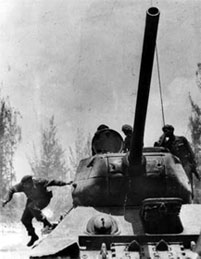
Castro's Army and Militia suffered heavy losses at the hands of Assault Brigade 2506 Olivia's forces were heartened by this information, but had no ammunition with which to hold their position.
[EDITOR: scavenge weapons/ammo from the dead enemy?] At 0900, they mounted the remaining trucks and proceeded to Giron where they thought resupply would be waiting. Not only was resupply not waiting at Blue Beach, but San Roman had trouble of his own there. [EDITOR: if they could truck themselves to Giron, they should be able to truck to the Escambray mountains, too.] His position had started receiving heavy artillery fire around 0400. He had committed his reserve by splitting it and putting the troops in blocking positions along the two roads coming in from the east and northeast. He also had established a blocking position along the road to Playa Larga to the northwest. He knew that Olivia would be coming to Blue Beach to consolidate the forces, but did not know how many enemy troops would be following him.
During the night 6 B-26's had launched around 0230 from Puerto Cabezas and arrived over Cuba at dawn in an attempt to catch Castro's aircraft on the ground and destroy them. Luck was not with them however, for the targets were obscured by heavy haze and low cloud cover. The mission was aborted. [43]
When the men from Red Beach arrived at Giron, the only fighting still continuing was in the area of San Blas, where the Castro column was still stalled by the Paratroopers and mortar fire. Olivia and San Roman met and studied their situations. They had troops in contact along the road to the northeast, and expected to come under attack by forces coming down from the northwest from Playa Larga at any time. All units were low on ammunition, and mortar shells had been rationed since midnight. They felt that if the brigade could hold out until nightfall, resupply would certainly occur either from the ships or by air drop.
Olivia suggested that the Brigade strike to the east through Cienfuegos and try to reach the Escambray Mountains where they could conduct guerrilla operations. San Roman opposed this plan for several reasons. He considered the mountains to be too far away. In order to reach them, they would have to fight their way through Cienfuegos, which he believed contained a large Castro troop concentration; also they were very low on ammunition. There weren't enough trucks available to transport everyone in the Brigade and, if they were to stand any chance of resupply, the Brigade would have to remain on the coast so the ships and planes could find them. He made the decision to hold the beachhead. [44]
[EDITOR: False, False, False. You ride your men there in relays or WALK. Imagine that, an infantryman WALKING. Scavenge ammo and weapons from dead Castro Cubans, before breaking-out. Move along the coast--so the airdrop planes could spot you AT NIGHT and drop to you. This was a very bad decision. Oliva was right. If the Cubans had been allowed to participate in their own plans this could have been war-gamed]
At 1030, radio contact was finally established with the Blagar. San Roman requested resupply of food, ammunition, medical supplies, and communications equipment. He was promised that it would be delivered that night by LCU and air drop. This sealed his decision to remain at Giron. The Blagar told him that if things really got bad they would evacuate the Brigade from the beaches. San Roman replied, "I will not be evacuated. We will fight until the end here if we have to." [45]
[EDITOR: what a fatalistic inflexible attitude--with other men's lives. He should have been relieved on the spot by Oliva.]
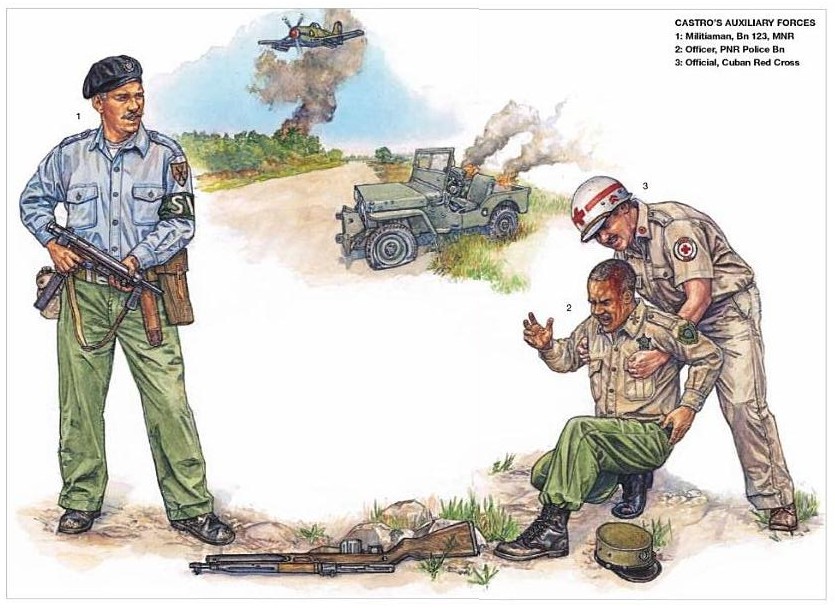

At 1100, the enemy began another push at San Blas. San Roman pulled the 3rd Battalion off the blocking positions on the road to Cienfuegos to the east and moved them to San Blas. They were fresh, and until this time had seen no combat.
[EDITOR: they should have spearheaded the movement east through Cienfuegas if necessary--they had all their ammo, right?]
He took the 6th Battalion, who were from Red Beach, and placed them in the blocking positions on the road to Playa Larga. He called in the Paratroopers who were in the advanced positions north of San Blas. He only had one artillery piece to support them as they broke contact and returned to San Blas. For some reason, the Castro force of over 20,000 men did not pursue them. If they had, the Brigade would have been destroyed on-the-spot. [46]
[EDITOR: what KIND of artillery piece was that?]
That day the Brigade was under almost continuous air attack. They were bombed and strafed by Castro's planes throughout the beachhead. There were Brigade missions flown that day, but many were flown by American CIA pilots. The Brigade pilots had made the early launch, which had been aborted, and many were too exhausted to fly the 6- hour round trip again.
Shot-down 2506 B-26B: notice the Cubans are scavenging for .50 caliber ammo
The American advisors filled in for them. They were authorized to do so by CIA officials without the knowledge of President Kennedy. Kennedy was not to find out for two years that 4 American pilots had been shot-down and killed in the Bay of Pigs operation. [47]
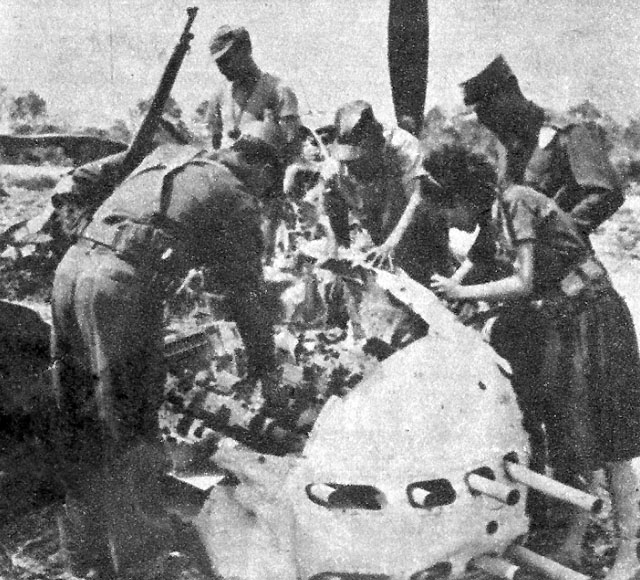
6 B-26 sorties were flown in mid-afternoon and attacked a long column of vehicles and tanks approaching Giron from Playa Larga. The air attack destroyed the column by inflicting 1800 casualties and wiping out 7 tanks. The planes used bombs and rockets and also delivered napalm for the first time during the operation. The men of the Brigade knew nothing about these attacks, hence they felt that they had received no air support at all. [48]
Only once did the members of the Brigade see any friendly air support; that day two U.S. Navy A-4 Skyhawks from the carrier Essex flew over the beachhead on a reconnaissance mission. The men of the Brigade were excited when they first saw the planes, but were disheartened when they did not deliver any support. [49]
The Brigade, somehow, made it through the rest of the afternoon, D+1, Tuesday April 18, 1961, without any further major action. Their ammunition supply was critical. The Castro forces, although superior in number, had been bloodied badly each time they had mounted a major attack. They applied continuous pressure to the ever shrinking perimeter of the beachhead, but were not anxious to mount a major attack on any front. Their lack of major offensive action reflects the respect they had gained for the Brigade during the initial battles.
[EDITOR: RESPECT isn't going to save your asses. Neither will resupply. YOU ARE AN UNTENABLE POSITION IN LOW GROUND. Get moving to the mountains--while the enemy is licking his wounds.]
At 1800, on D+1, the disposition of Brigade forces was as shown in Figure IV. [50] Although food, ammunition, and medical supplies were in short supply, the Brigade leaders had still not given up hope. They retained the faith that the U.S. would not allow them to fail and would step in with assistance at any time. Once again, the Brigade looked forward to a long night. The leaders had been told that resupply would begin shortly after nightfall, and they desperately needed it to hold on for another day.
Shortly after 1800, Castro's forces started pounding the advance posts with artillery. A short time later, the Brigade blocking positions on both the East and West fronts made contact with Castro's advance guards. A major push began at San Blas, but was halted before it gained momentum by sending 2 tanks to reinforce the positions.
About 1900, a Brigade C-54 made an air drop of supplies over the Giron airfield. The wind blew all of the supplies into the swamp, where a work party labored all night but only recovered a small percentage of the drop. Another C-54 arrived and made a second drop over the beaches. These supplies were blown into the sea. A group of frogmen were dispatched and were able to recover about half of these supplies.
At one point during the night, San Roman thought the Castro forces were massing for an attack on his Western front. He committed his reserve, the 2nd Battalion, to that position of the line but the attack never came. The only action throughout the night were light skirmishes, as the Castro forces probed the Brigade's line.
At sea, the Barbara J and the Blagar knew the situation was bad. They were about 50 nautical miles south of the beaches. The crews worked against time, trying to manually load supplies into 3 LCU's. They did not think they could get to the beaches and out again before daylight. They knew that if the ships were caught during daylight by Castro's aircraft, they would all be destroyed. The ships sent the following message to Puerto Cabezas: "Barbara J, BLAGAR, and LCU's cannot arrive Blue Beach, discharge and leave by daylight. Request jet cover from U.S. in beachhead area." Their next message read: "BLAGAR proceeding Blue Beach with 3 LCU's. If low jet cover not furnished at first light, believe we will lose all ships. Request immediate reply." [51]
There was only one man who could grant this request --President Kennedy. He was dismayed by the news coming from Giron. The President could not, however, view the invasion in a fishbowl, but had to keep in mind the world situation. He had answered Khrushchev's morning dispatch with stern words of his own but Kennedy was still not ready to commit American forces to save the Brigade. He did concede to provided limited escort for the Brigade aircraft for one hour on Wednesday morning, April 19, 1961, from 0630 to 0730.
Abroad the USS Essex, all markings were painted off the carrier's A-4 Skyhawks. The crews were briefed, that they would rendezvous with a flight of Brigade aircraft at 0630 and provide them air cover while they performed their mission. The jets were not to attack ground targets, but were supposed to keep the Castro planes from attacking the Brigade aircraft.
The Brigade had only 7 of its original 16 B-26's left. Again, American pilots had to be used to substitute for the Cubans, who were too exhausted or who refused to fly. 4 B-26's, two manned by Americans and two by Cubans, launched from Puerto Cabezas at around 0200, Wednesday, D+2. One of the planes, crewed by Cubans developed engine trouble and turned back shortly after take-off. The other three proceeded toward Giron. They arrived in the air an hour before the jets were to be launched, but were unaware of this. They proceeded to their targets. The results were disastrous.
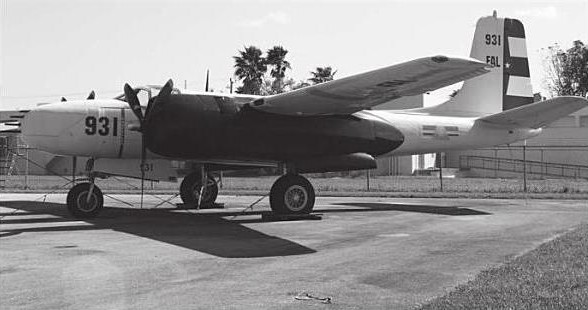
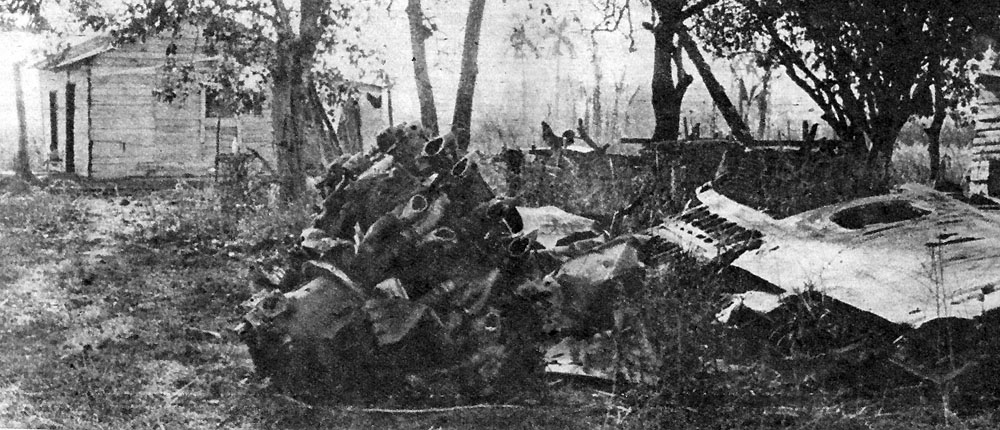
One B-26 was shot down over land in the area of Central Australia. Another was hit by ground fire and crashed into the sea on fire. Both were piloted by the American crews. The third hit targets in the San Blas area, but was damaged by ground fire. He limped back to Puerto Cabezas with thirty-nine rounds through the fuselage and one engine shot out. This was the last bombing mission flown by the Brigade air force. [52]
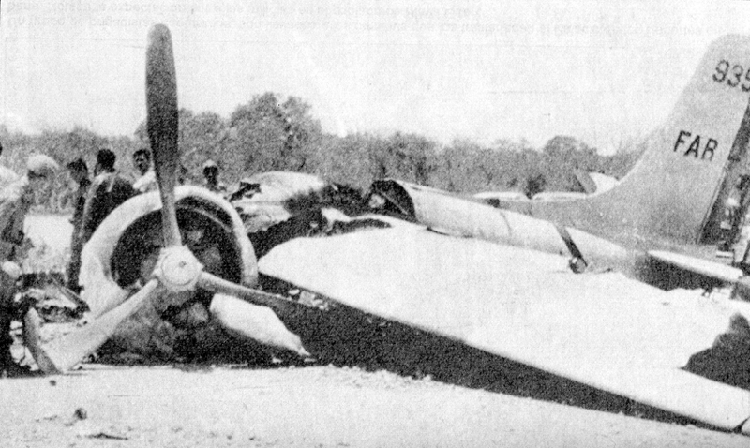
At the same time that they were striking their targets, a C-46 landed at the Giron airstrip. He delivered 850 pounds of rockets, ammunition, maps and communication equipment. 3 aircraft had been launched, but 2 had turned back. The C-46 picked up a wounded pilot who had crashed in the area on Monday and left after being on the ground for only about 10 minutes. This would be the only aircraft to operate from the strip at Giron throughout the entire operation.
After transferring her cargo to the LCU's and steaming toward Blue Beach, the captain of the Blagar had sent a request for a destroyer escort into the beach. He claimed that without such an escort, His crew would mutiny. CIA leaders felt that it would be hopeless to ask for a destroyer escort in light of the political climate in Washington; therefore, radioed orders to the Blagar to abort and rendezvous at a point 60 miles south of Blue Beach. This ended the last opportunity to resupply the Brigade. [53]

As the B-26 pulled off his last bombing run at San Blas, the Brigade ground commander there sensed the confusion among the Castro forces caused by the air attack. He quickly organized the Paratroop unit and the 3rd Battalion there for a counterattack. He faced a vastly superior number of forces, but moved forward to exploit the success of the air attack. For some reason it worked. The Castro front folded, broke and ran. After a few minutes, however, the attack faltered. The 3rd Battalion was out of ammunition, fell apart, and began a disorganized retreat.

[EDITOR: such attacks should be launched only to spoil a larger attack and to collect enemy weapons/ammo.]
At 1000, Castro's troops entered San Blas and pushed through it toward Giron. There was virtually nothing to stop them until they reached the blocking positions just outside Giron. The Castro forces rolled up on these positions about 1100. The men there, reinforced by two tanks, held out until they too were out of ammunition. This happened about 1400 and then they fell back into the town of Giron. [54]
At around 1000, a tank battle developed on the Northwest front. Olivia held the line there and poured mortar fire onto the oncoming tanks. He was finally able to force the Castro forces to retreat and regroup. The attack was renewed around 1400, and just as the Brigade lines were starting to fail, Olivia ordered a counterattack. This desperate measure worked and the line held. Olivia pulled his forces back into Giron to establish new fighting positions. [55]
Castro in a tank directing the battle
San Roman heard the tanks rumble into Giron from the northeast. He realized the Brigade could not hold. He sent a final message to the Blagar. It read: "Am destroying all my equipment and communications. Tanks are in sight. I have nothing left to fight with. Am taking to the woods. I cannot wait for you." [56] San Roman destroyed his headquarters and moved into the swamps.
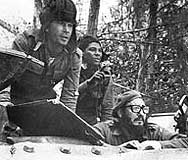
Browning .30 caliber Medium Machine Guns Left by 2506
As Olivia pulled his men back to Giron, he went to look for San Roman. He found tanks and machine guns abandoned haphazardly out of ammunition. Men were wandering around aimlessly with nowhere to go and no way out of the beachhead. Many were trying to get out to sea in small boats and rafts. Within right of the shore was the
Destroyer USS Eaton. She had come in close enough to make an evaluation of the situation on the beaches. San Roman was already gone and his headquarters destroyed.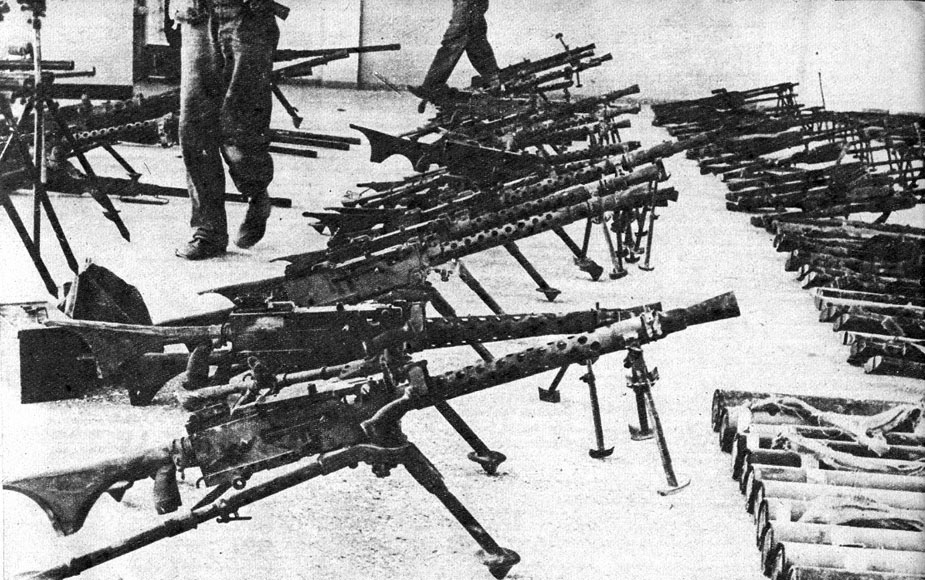
[EDITOR: the time to re-position in good order was lost in the preceding 2 days.]
Olivia formed a small unit of the men he could find and marched them to the east toward Cienfuegos. A short distance out of Giron, the column was strafed by two Sea Furies and a T-33. The unit broke up and fled individually into the swamps. This ended the last organized fighting of the Bay of Pigs campaign. The Brigade was gone. The beachhead had fallen. The invasion had failed. [57]
ENDNOTES
(Chapter IV)
1. Wyden, p. 133.
2. Johnson, pp. 83-84.
3. Johnson, p. 25.
4. Johnson, p. 26.
5. Taylor Report, Memo 1, p. 15.
6. Wyden, pp. 174-175.
7. New York Times, 16 April 1961, p. 4, col. 1.
8. New York Times, 16 April 1961, p. 4, col. 1.
9. Taylor Commission, Memo 1, p. 15.
10. Wyden, p. 180.
11. Johnson, p. 89.
12. Taylor Report, Memo 1, p. 15.
13. Taylor Report, Memo 1, p. 15.
14. Taylor Report, Memo 1, p. 17.
15. Johnson, p. 199.
16. Wyden, p. 193.
17. Taylor Report, Memo 1, p. 18.
18. Wyden, p. 207.
19. Wyden, p. 218.
20. Wyden, p. 219.
21. Taylor Report, Memo 1, p. 18.
22. Taylor Report, Memo 1, p. 18.
23. Johnson, p. 105.
24. Johnson, p. 109.
25. Taylor Report, Memo 1, p. 20.
26. Johnson, p. 110.
27. Johnson, p. 111.
28. Taylor Report, Memo 1, p. 20.
29. Johnson, p. 115.
30. Wyden, p. 230.
31. Johnson, p. 115.
32. Wyden, p. 235.
33. Taylor Report, Memo 1, p. 21.
34. Taylor Report, Memo 1.
35. Taylor Report, Memo 1, p. 21.
36. Johnson, p. 121.
37. Time, April 28, 1961, p. 19.
38. Johnson, p. 126.
39. Johnson, p. 129.
40. Johnson, p. 132.
41. Johnson, p. 134.
42. Johnson, p. 138.
43. Wyden, p. 270.
44. Wyden, p. 274.
45. Johnson, p. 143.
46. Johnson, p. 145.
47. Wyden, p. 278.
48. Taylor Report, Memo 1, p. 23.
49. Johnson, p. 144.
50. Taylor Report, Memo 1.
51. Johnson, p. 151.
52. Johnson, p. 155.
53. Taylor Report, Memo 1, p. 24.
54. Johnson, p. 158.
55, Wyden, p. 282.
56. Johnson, p. 167.
57. Wyden, p. 286.
CHAPTER V
Ransom
The next few days were a mass of confusion for the survivors of the invasion. As the ammunition had run out, various parts of the beachhead had broken down at different times. As a unit would run out of ammunition, it would break-up into small groups and either make for the open sea in the few small boats that remained or strike out through the swamps.
For the men who escaped via the sea, a U.S. task force patrolling the coast to pick them up. There is no accurate count of how many members of the Brigade were rescued at sea, but the number appears to be around 150. [1] One group of twenty-two men boarded a twenty-two foot sailboat and set out to sea. They sailed for fifteen days before being picked up by an American freighter, 178 miles south of the Mississippi River. 10 of the 22 men had died at sea. [2]
For those who escaped into the swamps, being captured was the least of their worries; mere survival was difficult. Some lasted longer than others, but virtually all of them were destined to either die in the swamps or to be captured by Castro's forces. The swamps consisted of mire and thick vegetation, but very little water. The swamps contained little to eat except snakes, lizards and an occasional bird.
They were constantly harassed by helicopters flying overhead and random shelling of the swamps by artillery. The troops could not navigate through the thick swamps, and eventually all were forced to return to the roads where the militia patrols were waiting for them.
[EDITOR: ALL Soldiers should have SERE Level "C" training. The days of the linear war lemming are over...have been over.]
The prisoners were taken back to Giron where they were kept under guard for several days. They were interrogated by officers of Castro's army and questioned by reporters. Castro thus achieved quite a propaganda coup from the round-up of Brigade prisoners.
After the interrogations were complete, the prisoners were transported to the Sports Palace in Havana for initial detention. Although they were generally treated well, there was one incident where 149 prisoners were loaded onto an enclosed semi-trailer truck at Giron and transported to Havana; unfortunately, 9 men died of suffocation during the transit. [3]
A total of 1,189 men of the Brigade became Castro's prisoners. 114 had died in the operation and around 150 had made their way back to safety in one way or another. For the prisoners, the coming months would be harder than the fighting during the invasion. The entire group of over 1, 000 prisoners were held for several days in the Sports Palace, where they were made to sit on the hard seats for 21 hours-a-day. Then they were called forth, one at a time, and interrogated. Several were taken to a television station where, during a live broadcast, they were questioned by a panel. Some of the answers were more than Castro wanted the public to hear, so the broadcasts were stopped after four days.
Fidel Castro himself appeared before the assembled Brigade on the night of April 26, 1961. He delivered a speech which lasted from 2330 until after 0300 the next morning; in it the Brigade was berated for its criminal activities and labeled as pawns of U.S. imperialism. Castro ended the speech by telling the men that although he knew they should all be shot, which was what they deserved, he would not kill them, but would spare the lives of those not guilty of committing war crimes. (This meant primarily war crimes under the Batista regime, not during the invasion).
The leaders, San Roman, Olivia, and several others, were kept isolated from the Brigade and from each other. They were interrogated thoroughly, and sometimes brutally, about their training and about the invasion, with special emphasis on the American role in all phases of the operation. Although they all felt betrayed by the United States, none of the Brigade leaders told their interrogators anything about the American participation and very little about the actual invasion.
[EDITOR: they WERE betrayed by the U.S. Government.]
During the night of May 13, 1961, the Sports Palace was emptied and the entire Brigade was transferred to the unfinished 5-story Havana Naval Hospital. Here, the men were treated much better. They were assigned twenty to a room and allowed to bathe and sleep on mattresses.
In a speech to the National association of Small farmers on May 12, 1961, Castro finally divulged his plan for his prisoners. He told the farmers: If imperialism does not want its worms to work, let it exchange them against tractors and agricultural machinery! Of course, those among such blackguards that may have committed murder, we cannot exchange against anything. Those that have assassinated are not subject to exchange. All others, all others, we will exchange with imperialism, against five hundred bulldozers, if it is interested in rescuing them." [4]
Castro had the prisoners elect a committee of 10 men, specifically excluding the leaders of the Brigade, to go to Washington and carry his demands to the U.S. government. They left Cuba for Miami on May 19, 1961. A committee was formed in the United States at the request of President Kennedy to meet with the delegation. The committee was not officially sanctioned by the administration, who felt that it could not deal with any representative of Castro since diplomatic relations had been severed with Cuba in January of 1961. Instead, it was a bipartisan committee of four citizens, ostensibly operating as concerned individuals forming a private organization. The committee became known as the Tractor-for-Freedom Committee.
What had seemed a fairly simple and routine matter to the President soon became a political hot potato. When the Senate met on 22 May, many senators demanded that the administration make its position clear, as to the government with the committee. Many of the lawmakers felt that the nation was being blackmailed by Castro into ransoming the Brigade. Congress felt that the bulldozers would be used to increase Castro's military power instead of for agriculture and that was the last thing the United States wanted.
After much debate, The Tractors-for-Freedom committee offered Castro 500 wheeled tractors with agricultural attachments instead of the bulldozers, which could ostensibly be used for military purposes. Castro refused the offer by sending a fiery cable to the committee restating his demands.
On June 13, 1961, a committee delegation went to Havana to negotiate release terms with Castro. Fidel told them he would accept 500 bulldozers or their equivalent in cash, credit or other farm machinery, as long as any combination of these added up to $28 million. When the Committee returned to Washington with the demands, the administration concluded that the demands were impossible in the light of the current political situation, and disbanded the committee.
On July 17, 1961, the Brigade prisoners were taken from the Naval Hospital to the Castillo del Principe. This was an old castle which now served as a prison. The men were herded into the cells they would occupy for the next year and the doors slammed shut. The men of the Brigade were faced with months of despair but few gave up hope.
On Thursday morning, March 29, 1962, the largest mass trial in Cuba's history began by assembling the Brigade in the courtyard of the prison. A 5-man tribunal sat in judgement of 1180 men (6 had died during imprisonment and 3 had escaped), all to be judged as one. The Brigade turned down the services of a court-appointed defense counsel and told the tribunal that their actions needed no defense. The trial lasted four days and left something to be desired from a strictly legal standpoint. On the fourth day of the trial, final summations were given and the tribunal went into deliberation.
Before the verdict was announced, the Cuban Families Committee sent a cable to Castro, saying that they had pledges for the $28 million he had requested. They would deliver the amount in foodstuffs shipped from the U.S. No answer was immediately given by the Cuban leader.
On Sunday, April 8, 1962, Castro announced to the world the sentence of the tribunal. The men of the Brigade were sentenced to thirty years imprisonment. He then went on to announce that he would ransom the prisoners for various amounts. He wanted $500,000 each for Olivia and San Roman, while the remainder of the Brigade had been divided into three groups. Their freedom could be purchased for $25,000 per man in the first group; $50,000 per man in the second group; and $100,000 per man in the third group. The total for the entire Brigade came to $62 million. [5]
Castro released 60 of the most seriously wounded prisoners and was paid their ransom through the Royal Canadian Bank. The money had been raised through the Cuban Families Committee. Negotiations for the remainder of the prisoners dragged on for months. Each time a solution was almost reached, Castro would change the conditions, putting the release of the prisoners just out of reach of the negotiators.
Finally, an agreement was reached. This involved complicated transfers of drugs, medicine, medical and surgical supplies, and foodstuffs, to the Cuban government. The items had been donated by private corporations in the United States, induced by large tax incentives provided by the government.
On the morning of December 23, 1962, the freighter, African Pilot docked in the Havana harbor, and commenced unloading the first of many shipments of drugs and supplies. At 1700, that afternoon, the first planeload of prisoners took off for Florida. At 2145, on December 24, 1962, the last planeload of prisoners arrived in Miami. As Pepe San Roman stepped down the boarding ladder, the assembled members of the Brigade saluted him. 6. Now the invasion was over.
ENDNOTES
(Chapter V)
1. Wyden, p. 303.
2. Johnson, p. 201.
3. Johnson, p. 303.
4. Johnson, p. 229.
5. Johnson, p. 282.
6. Johnson, p. 341.
CHAPTER VI
Conclusions and the Principles of War
Immediately after the collapse of the beachhead in Giron, President Kennedy appointed a committee to study the operation. In a letter of April 22, 1961, he charged General Maxwell Taylor, Robert Kennedy, Admiral Arleigh Burke, and Allen Dulles, to "study over governmental practices and programs in the area of military and paramilitary, guerrilla and anti-guerrilla activity, which fall short of outright war with a view toward strengthening our work in this area." [1] He directed special attention to the lessons which could be learned from the recent events in Cuba (the Bay of Pigs invasion).
Although the committee began work immediately, it was hamstrung by the fact that the leaders and participants of the invasion were imprisoned in Cuba. Despite this it set about interviewing everyone they could locate who had a hand in the invasion. These included the decision-makers; the planners, both military and CIA; the advisors who had trained the Brigade; and the operatives who had carried out the political and propaganda portions of the operation. They also questioned the few members of the Brigade who had been able to escape and return to the U.S.
The results of the committee's investigations were not designed to cover up anything or to place the blame on any particular individual. It had only one goal; to find out what happened, how and why it occurred, and how this type of disaster could be prevented from repeating itself. [2]
[EDITOR: if this were true blame should have rested on JFK for canceling the TRINIDAD location plan that would have worked and meddling with the air strikes necessary to thwart the Cuban AF.]
The result was four memorandums from the committee to President Kennedy. Memorandum Number I contained a narrative of the events during Operation ZAPATA. Memorandum Number II discussed the immediate causes of failure of the operation. Memorandum Number III contained the conclusions of the Cuban Study Group and Memorandum Number IV was the recommendation of the Cuban Study Group. Initially, these documents were so sensitive as to be classified "Eyes Only" and were hand carried to designated individuals. A sanitized version was declassified and released in March, 1977. (See appendix I for transcripts of Memorandums II & III.)
The foregoing has been the story of the Bay of Pigs invasion of 17-19 April, 1961, from conception to the return of the Brigade to U.S. soil. Volumes have been written concerning the operation, how and why it failed. However, another way to make an interesting analysis would be to take the operation out of its context as a political event, and examine it as a conflict between opposing military forces. To compare the battle, from the Brigade standpoint, to the principles of war and see which were used effectively and which were not.
The principles to be examined will be objective, offensive, mass, economy-of-force, maneuver, unity of command, security, surprise, and simplicity. Some of these elements must be incorporated during the planning stage and some during the execution phase. Both of these will be discussed, although it must be remembered that the Brigade leaders were not part of the planning evolution but were presented with the completed plan and expected to execute it. It should be noted that both Olivia and San Roman were products of U.S. Army formal schools and could be expected to be aware of these principles.
[EDITOR: let's not smugly start pontificating about Clausewitz's MOSSE MUSS. We are talking about gaining the support of an entire nation to a new government--not just beating a rival Army in a lethal sports scrimmage]
The principle objective states that "every military operation must be directed toward a clearly defined, decisive and obtainable objective." [3] In the case of the Brigade's invasion, clear objectives were laid down for the, initial stage (amphibious stage) of the operation. The forces crossing Red Beach were to assault, seize, and defend the town of Playa Larga, and control the road leading south from Central Australia within the beachhead. The forces landing across Blue Beach were to assault, seize, and defend the town of Playa Giron, and the airfield and dock facilities adjacent to it. They were to control the roads leading into the beachhead from Cienfuegos, Yaguaramas, and Covadonga. The Paratroopers were to drop on the forward edges of the beachhead and set up blocking positions along the enemy avenues-of-approach in their zone. These objectives were clean, concise, and attainable.
In fact, this portion of the plan was executed well, with the exception of the Paratroopers dropping out of their planned drop zones.
[EDITOR: LIAR, LIAR, PANTS ON FIRE; the Paratroopers landed 2/3 where they were supposed to, you weak-egoed marine. And then, they blocked the roads they were assigned, IT WAS HAWKIN'S FAULT FOR NOT HAVING THEM DROP WHERE THEY COULD BLOCK AND DESTROY BRIDGES FOR SIGNIFICANT INTERDICTION EFFECTS.]
The problems came after the initial objectives were taken. There was no real plan for a breakout from the beachhead to continue the operation to fulfill the ultimate goal of liberating the country.
[EDITOR: Amen. And the FAULT FOR THIS LIES WITH USMC COLONEL HAWKINS AND STAFF. AND BISSELL OF THE CIA.]
The fact that problems in unloading supplies prevented further movement inland aside, there was no coordinated plan to do so in any event. For the planners to deliver the Brigade to the beaches and then not give them further guidance was, at very least, short-sighted. The lack of a plan limited the scope of the operation to the establishment of the beachhead and then "see what happens next".
The principles of offensive action states that "offensive action is necessary to achieve decisive results and maintain freedom-of-action. It permits the commander to exercise initiative and impose his will upon the enemy, to set the pace and determine the course of the battle, to exploit enemy weaknesses and rapidly changing situations, and to meet unexpected developments." [4]
The Brigade was forced into the defensive almost immediately upon landing. They faced a force which was numerically superior on terrain favorable to the defense. They were never quite able to consolidate the beachhead as planned, and the lack of communication handicapped them severely. They were able to use the offense on a limited basis by staging counterattacks to turn the momentum of Castro's forces attacks. In general, their action was almost entirely defensive, as could be expected without a formal plan for action once their initial objectives were achieved.
The principle of mass states that "superior combat power must be concentrated at the critical time and place for a decisive purpose. Superiority is adjudged by relating available force to that of the enemy's and results from the proper combination of the elements of combat power." [5]
[EDITOR: only Oliva realized this OPerational ART (OPART) and wanted to move 2506 where it could have a decisive effect in the Escambray mountains as a guerrilla force. San wanted to be decisively engaged and was defeated.]
On initial examination, it would appear that the Brigade never had a chance to employ the principle of mass in the face of vastly superior numbers of forces. This is not true. Although Castro had many times the number of men and weapons than the Brigade possessed, he was forced to employ them on very narrow fronts. The terrain canalized his approach to the battle area, to the point that, only the lead elements of the column were able to engage the Brigade. The leaders of the Brigade chose sites of engagement where they could bring all of their limited combat power to bear on a lead element and therefore, in effect, maintain superior force in the actual battle area. The Brigade leaders proved to have an excellent ability to read the situation and commit their tanks and supporting fires at the moment that they would inflict the most damage, physical or psychological, on the enemy.
There was, of course, no way that the Brigade positions could be sustained for an indeterminate length of time in the face of such overwhelming odds. Eventually, the sheer number of Castro's forces was able to wear away the Brigade's defenses. The Brigade was still holding its own when they ran out of ammunition. Although the end result was inevitable, victory would have cost Castro dearly had the supplies held out.
The principles of economy-of-force states that, "skillful and prudent use of combat power enables the commander to accomplish the mission with a minimum expenditure of resources." [6] This principle implies that the most efficient expenditure of resources will allow you to have the combat power to commit at a decisive point in the battle.
If there is an area of weakness in the Brigade's performance, it would have to be the violation of this principle, especially during the first 24 hours of action. The Brigade came ashore, established defensive positions, and became engaged with the enemy almost immediately. For the vast majority of the men, this was their first exposure to combat. Although they had been well-trained, they showed very poor fire discipline in both individual weapons or supporting arms. They fired constantly without using aimed fire and consequently, consumed about three days of supply in the initial 24 hours. This should have been expected from green troops, and better controlled by small unit leaders and gun crew supervisors.
[EDITOR: 2506 nearly failed in ALL areas of war practice. And you lying fucktard the typical USMC unit would have fared no better at either ammunition usage or outcome had they done the same mission without air supremacy. What did we call that one? Wake Island?]
In defense of the men of the Brigade, it should be noted, that there was really little need for tight fire discipline, in light of the planned logistical support. They had landed with five days of supply and another ten days of supply were to be offloaded from the Houston. Not only this, but there were to be enough arms and ammunition to support all of the indigenous personnel who were expected to join the ranks of the Brigade. There should have been an ample supply of ammunition, even with the poor fire discipline.
[EDITOR: make your mind up, lying fucktard. Is wasting ammo bad or not? You are now just trying to distort "how great the amphibious operation is" when you miss the point. Since ships can deliver LOTS of stuff, DON'T BE DELIVERING FOOT SLOGGERS WITH CRAP HAND WEAPONS! DELIVER TRACKED, MECHANIZED FORCES THAT HAVE ALL THEY NEED AND CAN'T HAVE IT DENIED THEM--FOR WHATEVER THE REASON. You fail, USMC fucktard for maximizing amphibious means with line infantry foot-slogging--which is what 2506 emulated from Colonel Hawkins USMC--and paid for it with their lives.]
In an effort to adhere to this principle the 5th Battalion was held in reserve and not committed. They were staged aboard the Houston, where they could be employed on either front as required. Unfortunately, any advantage this gave the Brigade was lost when the Houston sank five miles south of Red Beach. The 5th Battalion broke up and never became effective again throughout the invasion.
The principle of maneuver states, "the object of maneuver is to dispose forces in such a manner as to place the enemy at a disadvantage and thus achieve results which would otherwise be more costly in men and material." [7]
Maneuver was never a major factor for either side.
[EDITOR: THE FUCK IT WASN'T! WTF do you think Castro coming down from the north was? Hop-scotch lessons? Castro's MANEUVER bottled up 2506 backs-pinned against the water's edge.]
The terrain positively dictated precise avenues-of-approach for Castro's forces and restricted his ability to outflank or maneuver against the Brigade forces. Once he had committed a force down a narrow roadway or railway bed, there were but two directions to proceed, attack or withdraw.
The Brigade was able to employ maneuver units on a limited basis, especially in setting up blocking positions and ambushes. The fact that they kept their front lines fairly fluid meant that Castro's forces advanced at a very slow pace to avoid ambush.
San Roman was also able to move his tanks around the battlefield to work along or to reinforce an area requiring fire support. He was able to keep his lines from collapsing on several occasions by sending tanks and infantry to another part of the front. although they were holding limited space, and were backed against the sea, the Brigade forces actually had the advantage of better maneuverability over the Castro forces.
The principle of unity of command states, "unity of command obtains unity of effort by coordinated action of all forces toward a common goal. While coordination may be achieved by cooperation it is best achieved by vesting a single commander with the requisite authority." [8]
Unity of command in Operation ZAPATA must be viewed from several vantage points. From the standpoint of the actual combat operation, San Roman was in complete control of his forces. He vested some of the combat leadership in Olivia on Red Beach, but he retained control as the commander of the Brigade forces. Although his efforts were outstanding, he was operating in a vacuum. San Roman was, in effect, only the Commander Landing Forces (CLF), and the Commander Amphibious Task Forces (CATF) was, in effect, President Kennedy in Washington, D.C.
[EDITOR: He was in complete control? Are you like a moron? He didn't have radio or ANY contact with many of his units.]
Although San Roman did an outstanding job of employing his force tactically, he remained out of contact with the man who was in full control of the operation. President Kennedy and his staff were making decisions without adequate knowledge of the situation (due, in part, to the loss of the communications equipment aboard the Houston). The chain-of-command stretched from the oval office to the Zapata swamps. When messages were sent either way, there was a built in time lag, i.e., the order was given for the supply ships to return to the beaches but by the time it was received, the unloading would have been during daylight.
The decisions being made by President Kennedy were being made in light of, not only the situation on the beaches, but also the political environment. He weighed the success of the mission against world opinion of the methods and amount of U.S. involvement necessary to achieve that success.
The net result was that there were two commanders. One tactical, committed to the goal of achieving his military objectives, and one strategic, weighing the value of that success against its cost in world opinion. The strategic commander, President Kennedy, did not have the same resolve to see the mission through as did the tactical commander, San Roman. Regardless, the key to the success of the invasion lays not in the hands of San Roman fighting on the beaches of Cuba, but with President Kennedy in the political world of Washington, D.C. Unfortunately, on his shoulders also rests the responsibility for the failure of the invasion.
[EDIOR: what this marine author says is such total BS it defies rebuttal. There was no unity of command either at the BOP or in Washington D.C.]
Another facet of the operation that must be brought out under the subject of unity-of-command, is the lack of concurrent and parallel planning. As stated earlier, the Brigade was given the completed plan and expected to execute it. They had no hand in the planning process and certainly, no input in decisions which would normally be made by the commander. This must have left Olivia and San Roman somewhat ignorant of many facets of the operation, no matter how well it was briefed to them.
The next principle, that of security, states that "security is essential to the preservation of combat power. Security is achieved by measures taken to prevent surprise, preserve freedom-of-action, and deny the enemy information of friendly forces." [9]
On the ground, the Brigade performed in an excellent manner placing forward positions to act as security posts. They covered these small units with supporting arms and had them dig-in successive positions to allow for a defense-in-depth. They were generally in contact with the leading edge of Castro's forces throughout the battle and were generally able to hold off large attacking forces with a very small number of men, especially on the Eastern fronts.
Security of the Brigade forces from air attack, conversely, was far from adequate and cost the Brigade dearly. At no time were they able to protect themselves from Castro's air assaults. The enemy aircraft did little damage to the actual fighting forces and delivered very little close air support. Instead, they concentrated on destroying the Brigade's ships and supplies, thus defeating their ability to sustain the operation. They also denied the Brigade's aircraft access to the beachhead, thus negating any capability for them to support the ground forces as planned.
[EDITOR: False. The transports were able to airdrop supplies to 2506.]
The major effect, other than the destruction of supplies and shipping, was the denial of the Brigade air force the use of the airfield at Giron. Had the airfield at Giron been available, the Brigade planes could have quadrupled their sortie rate, improved coordination with the ground forces, and in general provided the Brigade ground forces with meaningful support; but the airfield was unusable because Castro's planes would most certainly have destroyed the Brigade's small air force on the ground.
[EDITOR: False again. Had 2506 thought ahead it could have set-up a FAARP at Giron airfield and used it at NIGHT. Had 2506 had jets like F-86s they could have launched them at dawn and cleared the skies of Castro T-33s and Sea Furies. Transport planes could have each TOWED a F-86 behind them with pilot inside and engine idling to not use fuel to get them there. An one-time launch using JATO rockets from rails or a flat deck on a cargo ship are other options.
Hence the almost 7-hour round trip to Puerto Cabezas almost did away with their usefulness. The principle of surprise states that, "surprise can decisively shift the balance of combat power. By surprise success out of proportion to the effort expended may be obtained. Surprise results from striking an enemy at a time, place, and in a manner for which he is not prepared." [10]
Although Fidel Castro was certainly aware that some type of military action was forthcoming, he did not know when, where, or most importantly, what type of force he would face. The failure of the diversionary landing near Guantanamo had a profound effect on the success of the main invasion. Castro was poised and ready to react. Had the diversionary landing gone as planned, he would have most likely committed at least a portion of his forces to that area, giving the Brigade more time to prepare their positions.
San Roman was able to use the element of surprise in his small unit tactics and use of supporting arms as well. He relied heavily on the ambush and could stop the movement of Castro's column by pouncing on the flanks of the lead elements with small groups. He would commit only a few mortars to a fight and then, at a moment when the tide of battle could be turned, he would unleash massed fire from the other mortars, artillery, and tanks, forcing the Castro forces back just as they sensed victory.
The final principle is that of simplicity. It states, "simplicity contributes to successful operations. Direct, simple plans and clear, concise orders minimize misunderstanding and confusion." [11].
San Roman had no choice but to keep his tactics simple. He was out-manned, out-gunned, and surrounded on three sides with his back to the sea.
[EDITOR: he let himself get pinned down and he STAYED pinned down. Simple & Stupid. Sometime what's needed is COMPLEX--get off your ass and move and get into a winning position. If you want to really be simply, roll-over and die--which is what San did.]
He had virtually no communication equipment and relied heavily on messengers. This meant that once he was committed to a course of action, it could be changed only with extreme difficulty. He had to lay out a concept for an operation and then rely on his subordinates to implement it. However, if he had had radio communications, it may have caused him to try more grandiose schemes of maneuver, which may not have worked as well.
[EDITOR: BS you fuckwad marine simpleton. What he should have done was complex and that is conduct a delaying action so his main body could maneuver into the Escambray mountains. Fuck you and your ignorant "simplicity" guaranteeing defeat]
This look at how the Brigade operated with respect to the principles of war, should indicate that they generally adhered to good solid tactics which served them well. The fact that the Brigade was able to hold on for 3 days, in the face of such an overwhelming force, is testimony to their training, motivation, tactics and leadership. They proved themselves to be a formidable force, by inflicting over a ten-to-one kill ratio on the Castro forces. The Brigade lost only 114 men during the invasion, while the Castro forces lost approximately 1, 250 men.
[EDITOR: the marine narcissist fuckwad wants to fall back on macho and quantitative body counts; I have news for him; wars are about ADULT matters like who is going to control governments and peoples and resources. 2506 LOST. Reverting to macho vanities isn't going to make Cuba free, but makes for great excuses for losers. The goal in war is to WIN; not make elegant excuses.]
The debate will surely continue about the possible outcome of the invasion if it had received air support, along with any number of other "ifs". The invasion is long since past, but should never be forgotten, if for no other reason than its participants. This was the battle of 1,443 men in a desperate struggle to free their homeland. Their failure to do so is our failure as a nation also for sometime in the future, we may be forced to pay a much dearer price to accomplish the same mission.
[EDITOR: typical smug American egomaniac thinking we will be the hero in the end when we were the villains all along.]
ENDNOTES
(Chapter VI)
1. Taylor Report, cover letter.
2. Johnson, p. 220.
3. FMFM 6-1, Marine Division (Washington, D.C.: GPO, 22 March 1978), p. 2.
4. FMFM 6-1, p. 2.
5. FMFM 6-1, p. 2.
6. FMFM 6-1, p. 2.
7. FMFM 6-1, p. 3.
8. FMFM 6-1, p. 3.
9. FMFM 6-1, p. 3.
10. FMFM 6-1, p. 3.
11. FMFM 6-1, p. 3.
APPENDIX A
13 June 1961
Memorandum No. 2
IMMEDIATE CAUSES OF FAILURE OF THE OPERATION ZAPATA
SUMMARY
1. The proximate cause of the failure of the ZAPATA Operation was a shortage of ammunition which developed from the first day of the landing, April 17th, and became increasingly critical until it resulted in the surrender of the landing force about 0400 on April 19th.
2. There were three primary reasons for this shortage of ammunition. The logistical plan for the landing made ample provision for ammunition with the men and in floating reserve. However, upon landing there is evidence that the Cubans wasted their ammunition in excessive firing, displaying the poor ammunition discipline which is common to troops in their first combat.
3. Far more serious was the loss of the freighters Rio Escondido and Houston through air attack at about 0930 on the morning of April 17th. The RIO was a particular loss as it had 10 days of reserve ammunition on board, as well as other important supplies. The Houston should have been able to land most of its supplies before being hit, but the unloading was delayed by trouble with the outboard motors of the ships boats as well as by the apparent lethargy of the 5th Battalion charged with the unloading.
4. The air attack which sunk these ships caused all others in the landing area to put out to sea, as the only available protection in the absence of control of the air, with the order to rendezvous 50 miles off the coast. The freighters Atlantico and Caribe headed south and never stopped until intercepted by the U.S. Navy at points 110 miles and 218 miles, respectively, south of Cuba.
5. The Caribe was so far away that its cargo, principally aviation supplies, was never available for movement to Blue Beach while the fight lasted. The Atlantico, which had considerable ammunition on board, did rejoin the other ships of the expedition at 1816, April 18th, at a point about 50 miles south of the beach and transferred her supplies to the waiting two LCI's and three LCU's for a night run to the beach.
6. By the time the supplies were transferred and the convoy had started north it was too late to hope to resupply the beach under cover of darkness. The convoy commander asked CIA Operational Headquarters, Washington, for destroyer escort and U. S. Navy jet cover without which he believed that he would lose his ships to air attack the next morning. He added that without U.S. Navy support the Cuban crew would mutiny if sent back to the beach.
7. As a result of these messages, CIA Headquarters, feeling that it would be futile to order these ammunition craft to attempt a daylight unloading, called off the mission and the attempt to get ammunition to the beach by sea ended. The President was not requested for specific authority to extend the air cover to protect the ammunition convoy.
8. These causes for the ammunition shortage rested in turn on others which lay deeper in the plans and organization of this operation and the attitude toward it on the part of Government officials. The effectiveness of the Castro Air Force over the beach resulted from a failure to destroy the airplanes on the ground (particularly the T-33's whose importance was not fully appreciated in advance) before or concurrently with the landing. This failure was a consequences of the restraints put on the anti-Castro Air Force in planning and executing its strikes, primarily for the purpose of protecting the covert character of the operation. These restraints included: the decision to use only the B-26 as a combat aircraft because it had been distributed widely to foreign countries; the limitation of pre-landing strikes to those which could be flown from non-U.S. controlled airfields under the guise of coming from Cuban strips, thus eliminating the possibility of using jet fighters or even T-33 trainers; the inability to use any non-Cuban base within short turn-around distance from the target area (about nine hours were required to turn around a B-26 for a second mission over the target from Nicaragua); prohibition of use of American contract pilots for tactical air operations; restriction on munitions, notably napalm; and the cancellation of the strikes planned at dawn on D-Day. The last mentioned was probably the most serious as it eliminated the last favorable opportunity to destroy the Castro Air Force on the ground. The cancellation seems to have resulted partly from the failure to make the air strike plan entirely clear in advance to the President and the Secretary of State, but, more importantly, by misgivings as to the effect of the air strikes on the position of the United States in the current UN debate on Cuba. Finally, there was the failure to carry the issue to the President when the opportunity was presented and explain to him with proper force the probable military consequences of a last minute cancellation.
9. The flight of the Caribe and Atlantico might have been prevented had more attention been paid in advance to the control of the ships to include the placing of some American aboard. The CIA officer responsible for all the ships involved was a [ ] who was aboard the LCI Blagar with no means to control the freighters, or, indeed, to locate them after they disappeared. Only the initiative of the U.S. Navy in the vicinity brought them back to the scene of action. The absence of Americans on board these vessels was an application of the general order to keep Americans out of the combat area. This order had been violated in a few cases, but it was apparently not considered important to do so in the case of the freighters.
10. The lack of full appreciation of the ammunition situation at the end of D+1 in the CIA Operational Headquarters was largely the result of the difficulty of keeping abreast of the situation on the beach, and the location and movement of the ships at sea from the distance of Washington. Also, there was a confidence in the supply of the beach by air which turned out to be unjustified. Had there been a command ship in the sea area with an advance CIA command post on board, a more effective control would have been possible.
11. The Executive Branch of the Government was not organizationally prepared to cope with this kind of paramilitary operation. There was no single authority short of the President capable of coordinating the actions of the CIA, State, Defense, and USIA. Top level direction was given through ad hoc meetings of senior officials without consideration of operational plans in writing and with no arrangement for recording conclusions and decisions reached.
13 June 1961
Memorandum No. 3
CONCLUSIONS OF THE CUBAN STUDY GROUP
1. It is concluded that:
a. A paramilitary operation of the magnitude of ZAPATA could not be prepared and conducted in such a way that all U.S. support of it and connection with it could be plausibly disclaimed. Accordingly, this operation did not fit within the limited scope of NSC 5412/2. By about November 1960, the impossibility of running ZAPATA as a covert operation under CIA should have been recognized and the situation reviewed. The subsequent decision might then have been made to limit the efforts to attain covertness to the degree and nature of U.S. participation, and to assign responsibility for the amphibious peration to the Department of Defense. In this case, the CIA would have assisted in concealing the participation of defense. Failing such a reorientation, the project should have been abandoned.
b. Once the need for the operation was established, its success should have had the primary consideration of all agencies in the Government. Operational restrictions designed to protect its covert character should have been accepted only if they did not impair the chance of success. As it was, the leaders of the operation were obliged to fit their plan inside changing ground rules laid down for non-military considerations, which often had serious operational disadvantages
c. The leaders of the operation did not always present their case with sufficient force and clarity to the senior officials of the Government to allow the latter to appreciate the consequences of some of their decisions. This remark applies in particular to the circumstances surrounding the cancellation of the D-Day strikes.
d. There was a marginal character to the operation which increased with each additional limitation and cast a serious doubt over its ultimate success. The landing force was small in relation to its 36-mile beachhead and to the probable enemy reaction. The air support was short of pilots if the beach was to require cover for a long period. There were no fighters to keep off such Castro airplanes as might escape the initial air strikes. There were few Cuban replacements for the battle losses which were certain to occur on the ground and in the air. It is felt that the approval of so marginal an operation by many officials was influenced by the feeling that the Cuban Brigade was a waning asset which had to be used quickly as time was against us, and that this operation was the best way to realize the most from it. Also, the consequences of demobilizing the Brigade and the return of the trainees to the U.S.A., with its implication that the United States had lost interest in the fight against Castro, played a part in the final decision.
e. The Cuban Expeditionary Force achieved tactical surprise in its landing and, as we have said, fought well and inflicted heavy casualties on the enemy. Although there had been considerable evidence of strong pockets of resistance against Castro throughout Cuba, the short life of the beachhead was not sufficient to trigger an immediate popular reaction, and Castro's repressive measures following the landing made coordinated uprisings of the populace impossible. The effectiveness of the Castro military forces, as well as that of his police measures, was not entirely anticipated or foreseen.
f. In approving the operation, the President and senior officials had been greatly influenced by the understanding that the landing force could pass to guerrilla status, if unable to hold the beachhead. These officials were informed on many occasions that the ZAPATA area was guerrilla territory, and that the entire force, in an emergency, could operate as guerrillas. With this alternative to fall back on, the view was held that a sudden or disastrous defeat was most improbable. As we have indicated before, the guerrilla alternative as it had been described was not in fact available to this force in the situation which developed.
g. The operation suffered from being run from the distance of Washington. At that range and with the limited reporting which was inevitable on the part of field commanders absorbed in combat, it was not possible to have a clear understanding in Washington of events taking place in the field. This was particularly the case on the night of D+1 when an appreciation of the ammunition situation would have resulted in an appeal for U.S. air cover and an all-out effort to supply the beach by all available means.
h. The Joint Chiefs of Staff had the important responsibility of examining into the military feasibility of this operation. By acquiescing in the ZAPATA Plan, they gave the impression to others of approving it although they had expressed their preference for TRINIDAD at the outset, a point which apparently never reached the senior civilian officials. As a body they reviewed the successive changes of the plan piecemeal and only within a limited context, a procedure which was inadequate for a proper examination of all the military ramifications. Individually, they had differing understandings of important features of the operation apparently arising from oral briefings in the absence of written documents.
f. Although the intelligence was not perfect, particularly as to the evaluation of the effectiveness of the T-33's, we do not feel that any failure of intelligence contributed significantly to the defeat.
j. The planning and conduct of the operation would have been improved if there had been an initial statement of governmental policy, assigning the mission and setting the guidelines within which it was to develop. Thereafter, there was a need for a formalized procedure for interdepartmental coordination and follow-up with adequate record-keeping of decisions.
2. In the light of the foregoing considerations, we are of the opinion that the preparations and execution of paramilitary operations such as ZAPATA are a form of Cold War action in which the country must be prepared to engage. If it does so, it must engage in it with a maximum chance of success. Such operations should be planned and executed by a governmental mechanism capable of bringing into play, in addition to military and covert techniques, all other forces, political, economic, ideological, and intelligence, which can contribute to its success. No such mechanism presently exists but should be created to plan, coordinate and further a national Cold War strategy capable of including paramilitary operations.
BIBLIOGRAPHY
Books
Hinkle, Warren and William W. Turner. The Fish is Red. New York: Harper and Row, 1981.
Hunt, Howard. Give Us This Day. New York: Arlington House, 1973.
Johnson, Haynes, et al. Bay of Pigs. New York: W.W. Norton and Company, 1964.
Lazo, Peter. Dagger in the Heart. New York: Funk and Wagnall's, 1968.
Periodicals
New York Times, 16 April 1961.
"Stopped in the Swamp," Time, 21 April 1961. Time, 28 April 1961.
U.S. News and World Report, 1 May 1961.
Government Publications
FMFM 6-1. Marine Division. PCN 139 000400 00. Washington, D.C.: GPO, 22 March 1978.
Public Papers of the President of the United States:
John F. Kennedy. 20 January, 1961 ... 31 December, 1961. Washington, D.C.: GPO, 1962.
Taylor, Maxwell D. "Narrative of the Anti-Castro Cuban Operation ZAPATA." Memorandum 1 Taylor Commission
Report. Washington, D.C.: GPO, 1961. Sanitized version declassified 8 May 1977.
Taylor, Maxwell D. "Immediate Causes of Failure of the Operation ZAPATA." Memorandum 2 Taylor Commission
Report. Washington, D.C.: GPO, 1961. Sanitized version declassified 8 May 1977.
Taylor Maxwell D. "Conclusion of the Cuban Study Group." Memorandum 3 Taylor Commission Report. Washington, D.C. GPO, 1961. Sanitized version declassified 8 May 1977.
ANALYSIS
latinamericanstudies.org/bay-of-pigs/classified-disaster.htm
National Review
December 31, 1996
CLASSIFIED DISASTER
The Bay of Pigs operation was doomed by presidential indecisiveness and lack of commitment.
By JACK HAWKINS
THIRTY-FIVE years ago, 1,500 exiled Cuban patriots landed on the south coast of their country, at the Bay of Pigs, in a gallant effort to free Cuba from Communist rule. They were abandoned on the beach without the supplies, protection, and support that had been promised by their sponsor, the Government of the United States. They had no chance of succeeding in their mission, and nearly all of them were captured or killed.
[EDITOR: FALSE. As we will detail there were several FIDO things 2506 could have done to salvage a victory from their predicament. YES, it would have been much better if through GIDO the situational deck was stacked in their favor.]
For 35 years, bound by my oath not to reveal classified information, I kept silent about the fatal errors in judgment that led to this disaster. Now this information is no longer classified, and I believe the facts should be reported.
My involvement with the Cuba Project began during the Eisenhower Administration. In late August of 1960, the commandant of the marine corps, General David Shoup, told me that the CIA had requested the services of a marine officer to assist in the landing of a small force of Cuban exiles. I had the required experience in amphibious operations, and also in guerrilla warfare (Philippines, 1943), and so he was assigning me to the job. I reported to the CIA on September 1.
At the CIA, I was assigned duty as Chief of the Paramilitary Staff of the Cuba Project, responsible directly to the Chief of the Cuba Project, Mr. Jacob Esterline.
I soon learned that the Cuba Project had been initiated by President Eisenhower in January 1960, when it had become clear that Castro was a Communist bent not only on establishing a Communist state in Cuba--but also on subverting other Latin Arnerican countries. President Eisenhower decided that Castro should be overthrown and directed the CIA to prepare plans to that end.
The concept of the operation, developed by the CIA before involved training paramilitary teams of Cuban exiles to be introduced secretly back into their country for purposes of intelligence, sabotage, propaganda, and political and guerrilla activity. Each team would have a radio capable of communicating with the United States. It was planned also to form a small infantry force of 200 to 300 men that could be sent in to augment guerrilla activity fostered by the teams.
The project was flawed from the outset owing to diplomatic/political considerations. The safest and most efficient venues for both training camps and bases of operations would have been in the United States or Puerto Rico. However, the CIA was anxious not to have the operation appear to be run by the United States, and so training camps and airfields were established in Guatemala and Nicaragua, at extremely unsuitable locations. The training camp in Guatemala was located on the side of a remote volcano with very little level ground. Conditions there were extremely crowded and became health-threatening as additional recruits arrived. And from the airfield in Nicaragua chosen for tactical air operations, Cuba was just barely within range of the B-26 bombers procured by the CIA for the exile air force.
If the Cuban forces had been trained here, they could have been ready for action months earlier than they were, an important consideration. While the preparations continued, the Soviet Union was pouring great quantities of arms and other materiel into Cuba, enabling Castro to organize and equip large militia forces and consolidate his security system for control of the Cuban people. In view of these rapidly growing capabilities, the Deputy Director for Plans at the CIA, Mr. Richard Bissell, decided that the planned infantry force of 200 to 300 would not be large enough; more like 1,500 men would be needed to establish a serious presence in Cuba. I expressed reservations about a force this large in view of the increased difficulties in recruiting, training, and providing support. However, President Eisenhower directed that preparations be made for a larger force.
In late 1960 and early 1961, teams of paramilitary agents were landed in many places on the Cuban coast. Most of the teams established radio communication with the CIA, but some were captured immediately and never heard from again. The surviving teams reported that there were large numbers of men in all provinces of Cuba who were willing to fight against Castro if they were armed. The CIA tried to supply arms and ammunition to some of the teams by nocturnal parachute drops, but without success. The Cuban pilots were not experienced enough for these difficult missions, and our request for permission to use American contract pilots was denied, again so that the U.S. would not appear to be too deeply involved. The only sizable delivery of arms through the efforts of the agent teams was made by sea to a 400-man guerrilla unit operating in the Escambray mountains of central Cuba. About 1,000 guerrillas operated in this area in separate groups for many months.
Soon after President Kennedy's inauguration, Mr. Bissell briefed him about the Cuba Project. The new President was interested and scheduled a series of meetings at the White House involving the Secretary of State, Mr. Dean Rusk; the Secretary of Defense, Mr. Robert McNamara; the Chairman of the Joint Chiefs of Staff, Gen. Lyman Lemnitzer; and Mr. Bissell. Each of these officials brought assistants to these meetings, and I usually accompanied Mr. Bissell.
President Kennedy emphasized that operations would have to be conducted in such a way that U.S. involvement could be "plausibly deniable." This was the fundamental mistake underlying the other fatal errors that led to the failure of the operation. It should have been apparent to all concerned that the recruiting of large numbers of Cubans in Miami, followed by the landing of a well-armed Cuban exile force in Cuba with air support, would be attributed to the United States. If that was held to be unacceptable, the operation should have been canceled; if it was not canceled, it should have received the support required for success. As it was, the Administration neither escaped blame nor succeeded in liberating Cuba.
THE crucial point at issue was air support. Throughout my participation in the Cuba Project, I frequently emphasized, both orally and in formal correspondence, the absolute necessity for complete destruction of the opposing air force at the outset of the operation. In January 1961, in a memorandum to higher CIA authority, I recommended that the landing operation be canceled if sufficient air operations were not to be allowed. In another memorandum in early 1961, I stated flatly that if Castro's aircraft were not all destroyed before the troop transports arrived at the landing beaches, a military disaster would occur. An unarmed freighter cannot approach a hostile shore, drop anchor, and unload troops, supplies, and equipment while under fighter and bomber attack. Mr. Rusk did not seem to grasp this point. At the White House meetings, it became clear that he was unalterably opposed to any air operations whatsoever. To my surprise and chagrin, neither Mr. McNamara nor Gen. Lemnitzer spoke up in these meetings in defense of the necessity of eliminating Castro's air force completely by preliminary air strikes. And so, when the recommendations of the State Department conflicted with those of the CIA, the President usually adopted Mr. Rusk's position.
Absolute control of the air was essential not only for the landing but also for further operations in Cuba. Our Cuban Brigade was small and could not be expected to undertake operations beyond its initial lodgement unless the strength of the opposing militia was seriously reduced by combat losses-or by defection to our side. Many of the militia were of dubious loyalty to Castro and might well have turned against him had this operation been properly launched.
[EDITOR: disagree again. 2506 could have and should have went to the Escambray mountains 51 miles away. Let's say they were not opposed. What was the plan's objective? They were supposed to march on Havana? Split the island in half and cut the main highway?]
As the spring of 1961 approached, the Brigade, now up to planned strength, and its supporting tactical air force of 16 x B-26s were nearing readiness for combat.
[EDITOR: were they armored to survive low-level attacks?]
Commercial freighters were chartered for the operation, 4 for the assault phase and 3 for follow-on delivery of supplies.
[EDITOR: unless those 4 ships were delivering armored vehicles, 2506 would have been better off having all 7 ships full of supplies and landing their men by C-46/C-54s at the Giron airfield]
Meanwhile, the time element was becoming critical. The Soviet Union continued delivering arms and equipment to Cuba and was training jet pilots for Castro in Eastern Europe. Soon Castro would have a modern jet air force, and a paramilitary effort to overthrow him would have no chance of success.
After long study, the Paramilitary Staff had concluded that by far the best place, and probably the only place, where a successful landing (i.e., one likely to lead to the overthrow of Castro) could be made was at Trinidad near the middle of the southern coast of Cuba. Good landing beaches were available very near the Escambray mountains, where, as noted above, anti-Castro guerrillas were already operating. The Brigade could quickly establish itself in these mountains and incorporate the guerrillas already there.
[EDITOR: AMEN. Totally concur.]
The Excellent TRINIDAD Plan Trinidad
The Paramilitary Staff prepared a complete plan for the TRINIDAD operation, which was presented to the President and his advisors. Mr. Rusk strongly opposed the plan, saying that it was too much like an invasion and too easily attributable to the United States. He thought the Soviet Union might be provoked to the extent of taking action against the United States in Berlin or elsewhere in the world.
[EDITOR: Dude! It is an invasion! Get over it! There's no soft-peddling it. There's also the possibility that thew secret elites didn't want Castro to be over-thrown in order to heat-up the cold War. Both JFK and Dulles were incommunicado when the invasion launched]
Once again, the President agreed with Mr. Rusk. He rejected the TRINIDAD plan and directed that a plan be developed that would be less noisy and less like an invasion. He also adopted the restriction advanced by Mr. Rusk that an airfield capable of supporting B-26 operations would have to be captured on the first day so that all air operations could be attributed to that field.
[EDITOR: why didn't they modify the TRINIDAD plan to a NIGHT landing? The airfield there looks capable of B-26 landings and take-offs. If not bring bulldozers and lengthen the runway.]
This was the first fatal error made by President Kennedy: rejecting a plan that offered a good chance of success and placing "plausible deniability" ahead of military viability.
Pursuant to Mr. Bissell's oral instructions to me, the Paramilitary Staff studied the entire coast of Cuba in an effort to find a landing area that would satisfy the President's requirements. We found that the only place on the Cuban coast which did so and could be held even for a minimal time was at the Bahia de Cochinos (Bay of Pigs).
I reported this orally to Mr. Bissell and briefly described the area. Behind the beach lay a long narrow strip of flat, scrub-covered land from three to six miles in depth and forty miles wide. This land was cut off from the interior by a great swamp, impassable except for three narrow causeways approaching the beach from the north and a coastal road from the east, all of which could probably be blocked for a time by the Brigade (and on the other side of the swamp by Castro's militia).
I pointed out to Mr. Bissell that the Brigade could hold on there for only a limited time and would have no hope of breaking out through the swamp and reaching guerrilla country in the Escambray mountains eighty miles away.
[EDITOR: WTFO? Supply them enough motor vehicles to move rapidly to the Escambray mountains. Or bicycles. Or fly most troops in to Giron airfield. Actual distance is only 51 miles--you can WALK this. This is what walking infantry brags all the time that they do. WTF do you think Castro did to take Havana from even farther away--the San M mountains? What kind of USMC lazy, defeatist crap is this?
Comparison of BOP to Castro's Rebel March
OK, so you are not going to the Escambray mountains...where the fuck are you going then?]
However, since the Bay of Pigs was the only place that met the President's requirements, Mr. Bissell decided on the spot that we would have to go ahead on that basis. This was another fatal error, as Mr. Bissell later acknowledged, lamenting that he had never informed the President that landing at the Bay of Pigs ruled out the possibility of guerrilla warfare in the Escambray mountains.
[EDITOR: FALSE. Provide mobility to get to the Escambray mountains. What the hell did you do when evading the Japanese, Colonel Hawkins?]
Our plan for the Bay of Pigs landing provided for an attack on three Cuban military airfields by 16 x B-26 bombers on April 15, the landing itself during darkness in the early morning of April 17, and a second 16-bomber attack against the military airfields at first light on April 17. The President approved the plan and directed that all preparations continue. However, he also stated that he would not finally decide whether to execute the operation until 24 hours before it was scheduled to begin.
Not long after this, the Chief of the Cuba Project, Mr. Esterline, and I had a serious talk about the outlook for the Bay of Pigs operation and found ourselves in complete agreement that it was certain to fail. We went to Mr. Bissell at his home on a Sunday to attempt to dissuade him from continuing with the operation. We even went so far as to say that we did not want to be parties to the disaster we believed lay ahead.
[EDITOR: Typical USMC defeatism. What about Plan B? Instead of lingering around for 3 days and using up supplies as 2506 actually did, they could have been moving immediately to the Escambray mountains and been there long before their supplies ran out. What did seize & hold of low swamp ground achieve?
If you felt so strongly why didn't you threaten to resign or go to the press?]
Mr. Bissell tried to reassure us and implored us not to let him down. He said he thought he could persuade the President to permit an increase in our air capability to ensure destruction of Castro's air force. But he gave no assurance about other weaknesses of the plan.
[EDITOR: that's when the competent and resourceful professional provides by GIDO "Plan B"; in this case a way to get to the Escambray mountains. Ovila realized this in the middle of the battle. This is also more proof that Hawkins was the wrong man to advise this operation.]
I thought that after hearing unequivocal predictions of complete disaster from his two principal staff officers who were most familiar with the military aspects of the plan, Mr. Bissell would re-examine the whole operation. It had become obvious that the military requirements for a successful operation and the President's insistence on plausible deniability were in irreconcilable conflict. However, Mr. Bissell could not bring himself to give up on the plan. This was another fatal error.
On April 14, devastating instructions [for] me from the White House. The President informed Mr. Bissell that he wanted the number of participating aircraft reduced to the minimum. Mr. Bissell, without consulting Mr. Esterline or me, volunteered to cut the number by half, from 16 to 8 -- although 16 was considered the minimal number for destroying 18 opposing aircraft scattered on three different fields. The President accepted Mr. Bissell's offer. Military failure was now virtually assured.
[EDITOR: being a tad bit inflexible are we? If you know you will not command the air, adjust your plan so surface ships are off the horizon and out-of-sight from the beach by dawn.]
The attack was carried out the next morning with only 8 B-26s, and our fears were confirmed when post-strike photography revealed that half of Castro's military aircraft, including five fighters, had escaped destruction. These posed a deadly threat to the landing and to our B-26s as well.
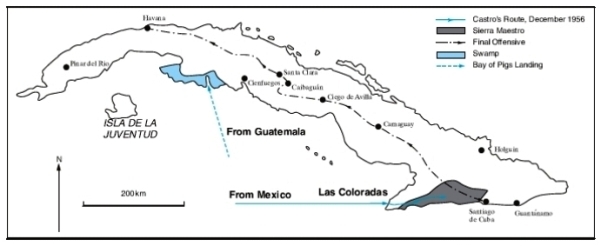
News of the attack spread rapidly. At the United Nations, Ambassador Adlai Stevenson, a leading figure in the Democratic Party, who had not been informed about the operation, denied U.S. involvement. When he learned the truth, he was outraged and protested to the President that this affair was extremely embarrassing both to the President and to him. He was reinforced in that position by Mr. Rusk.
This led the President to make another decision, which made disaster absolutely certain. I was in the CIA operations room at about 10 P.M. on April 16, three hours before the troops were to commence landing, when Mr. Esterline hurried in with an ashen face and told me that the President had canceled the second attack on Castro's air force, the one scheduled for first light the next morning. Appalled, I rushed to the telephone and called Mr. Bissell, who was at the State Department, and urged him in the strongest terms to call the President and explain that the invasion force faced certain destruction unless the order was reversed. I predicted that our troop transports would be under air attack and some or all would be sunk.
[EDITOR: why were you not there on the ships at sea to effect FIDO? Or at the Nicaraguan air field if you think AIR was the critical element. Do a Sam Damon and order the air strikes to knock out the Cuban AF--put your bird colonel's wings down on the table. Or if you are going to run political interference to get significant GIDO, then get off your ass and get a back-channel to Bobby Kennedy or somebody. The men of 2506's lives are depending on you. WHY isn't JFK in town to be accessible while a major invasion is under way? What about Truman's "the buck stops here"?]
After my plea, Mr. Bissell and General C. P. Cabell, the Deputy Director of the CIA, spoke to Mr. Rusk. He telephoned the President, who had left Washington, and told him that the CIA wanted to reinstate the air strike that he believed the decision should be changed. McGeorge Bundy, the National Security Advisor, seconded Rusk's advice. The cancellation remained in effect.
[EDITOR: unless I'm reading this wrong, but this contradicts Colonel Prouty who says Bundy was the one who said "NO!". This presents unless--I'm mistaken in the reading--that both Rusk and Bundy told the President he should reverse his decision and let the B-26s finish off the Castro air force. Didn't PT-109 get strafed and bombed by the Japanese Zeros and float plane versions (Rufes) several times? Wouldn't he know this is a vital military task?]
This final incredible mistake doomed Assault Brigade 2506. The President himself had initially approved the original operation plan, which provided for forty B-26 sorties in preliminary air strikes. After his last-minute cuts, only eight sorties were flown, a reduction of 80 per cent.
While Washington floundered, the troops of Assault Brigade 2506 landed successfully in darkness. But when morning came, Castro's fighters and bombers attacked, and they continued to attack all day. Unloading supplies from the ships was impossible. Two ships were sunk, and the remaining two had to flee at top speed.
[EDITOR: supplies could be off-loaded at night.]
The Brigade fought hard and well for three days and was not overrun or driven from its position. With their supply ships either sunk or chased away, the troops eventually ran out of ammunition and had to surrender.
[EDITOR: "Had to" surrender? Says who? Why were they sitting their defending a swamp? They should have been moving to the Escambray mountains IMMEDIATELY upon landing]
During three days of combat, from 3,000 to 4,000 casualties were inflicted upon Castro's hard-core militia, mostly by B-26 attacks on troop convoys. The hard-core militia, the only troops trusted by Castro, were limited in number and could not long have endured casualties of such magnitude.
[EDITOR: Is Hawkins a marine aviator? Battle accounts indicate most casualties were caused by 2506 ground forces. Regardless, what are you saying here? The purpose of the landings were to engage in combat with Castro's forces and attrit them? Are we in Vietnam yet?]
Before the surrender, Admiral Arleigh "31-knots" Burke, the Chief of Naval Operations, requested permission from the President to have carrier aircraft eliminate the rest of Castro's air force and fly cover and support for the Brigade, and to use Navy landing craft to evacuate the troops from the beach. The President refused.
It was noteworthy that when the Brigade landed, the defending militia unit fought little and surrendered quickly. About 150 men were captured, and nearly all volunteered to join the Brigade and fight against Castro. Civilians in the landing area also volunteered to help the Brigade.
THESE facts confirmed that our concept of the operation had merit, and that, if the landing had been made at Trinidad as recommended, and with adequate air support, the objective of overthrowing the Communist government might well have been accomplished.
[EDITOR: True. But, knowing you needed to get to the Escambray mountains why didn't you adapt the BOP landings to get there from there?]
But, as things turned out, Assault Brigade 2506 was left stranded on the beach, shamefully misled and betrayed by the Government of the United States. The last message from Jose "Pepe" San , the Brigade Commander, was, "How can you people do this to us?"
[EDITOR: YOU did it to yourself by not what-iffing your own plans, Pepe and having a "Plan B". As commander its both your fault and your responsibility. You failed. Don't get me wrong, JFK was wrong with what he did and impeachment proceedings should have been commenced against him--not an assassination operation.]
Less than four months into the Kennedy Administration, the Bay of Pigs fiasco caused the U.S. Government to be perceived as weak, irresolute, and inept. Undoubtedly, Chairman Khrushchev was reassured that he had little to fear from the United States as he pressed on with his plans to turn Cuba into a Soviet armed camp.
If those plans had been aborted at the outset, there would have been no missile crisis bringing us to the brink of nuclear war, and Cuba would be a free and prosperous country today.
[EDITOR: I concur. However, it was the CIA and the advising military's fault for not finding a way to win in spite of the meddling and bungling JFK.]
Jack Hawkins is a retired colonel in the United States marine corps.
latinamericanstudies.org/bay-of-pigs/site.htm
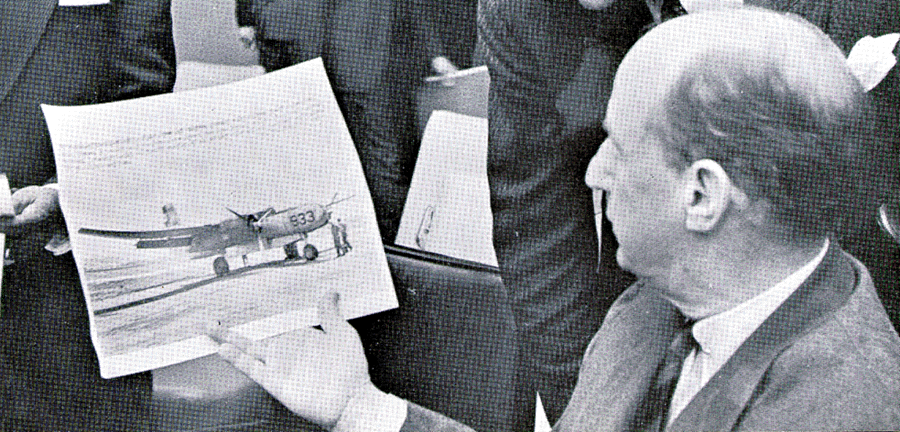
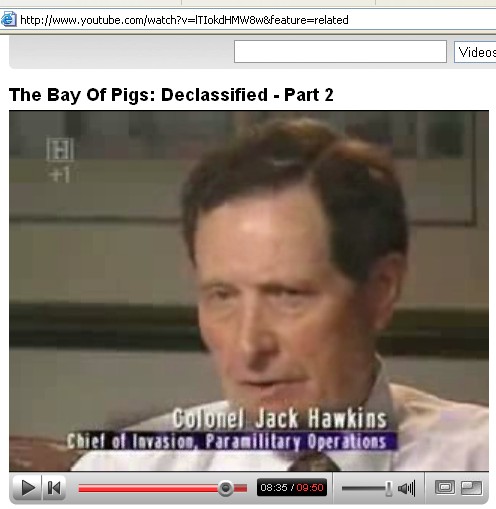
The Miami Herald
January 5, 1997
Site change called fatal to invasion
Bay of Pigs bad choice, planner says
BAY OF PIGS PLANNER: Retired Col. Jack Hawkins.
"Landing at the Bay of Pigs could not possibly succeed and was going to end in disaster. That's the word I used."
JACK HAWKINS, invasion planning chief
When Kennedy vetoed the original landing site, invaders `had no chance,' an ex-CIA officer says.
Did switch doom Bay of Pigs?
By DON BOHNING
Miami Herald Staff Writer
Breaking a 35-year silence, the chief of the CIA's planning staff for military aspects of the 1961 Bay of Pigs invasion says the effort was doomed from the day, a month before the operation, when President Kennedy ordered the landing site changed to one that would attract less attention.
Jack Hawkins, a retired marine corps colonel, said in an interview that after he and his staff drafted the new plan, shifting the landing from the city of Trinidad, on Cuba's south coast, about 80 miles westward to the Bay of Pigs, he had "decided this plan has no chance. It is going to fail.'' He said efforts to convince superiors of that were of no avail.
What eventually became known as the Bay of Pigs began in January 1960 when the Eisenhower administration decided that Cuban leader Fidel Castro should be ousted, an effort Kennedy continued after becoming president. It evolved from sending in teams of agents to develop resistance, into a small guerrilla-type infiltration of 200 to 300 men to join existing guerrillas, and, finally, into a full-scale landing at the Bay of Pigs by a CIA-sponsored Cuban exile brigade of about 1,500 on April 15, 1961.
The hope was not for Castro's immediate overthrow but to seize a beachhead, generate morale problems and defections within the Castro forces and eventually provoke a general uprising.
[EDITOR: OK, fantastic. Thanks for clarifying the BOP objective. Then this means you get your asses over to the Escambray mountains ASAP--not linger and hold a swamp.]
Instead, the landing ended in disaster when B-26 air strikes reduced by Kennedy failed to knock out Castro's air force. Castro forces captured 1,189 exile invaders, 114 others died and 150 were unable to land or never shipped out. The captured invaders were ransomed by the Kennedy administration for $53 million in food and medicine. They returned to Miami on Dec. 23, 1962.
The paramilitary staff, which Hawkins headed, was responsible for organizing, training and equipping the Cuban exile brigade and preparing the plans for its landing in Cuba. Although staff personnel changed at times, said Hawkins, they averaged 6 U.S military and 18 CIA officers. Hawkins reported directly to Jake Esterline, the CIA's project chief for the invasion.
The interview with The Herald was the first Hawkins has given to a daily newspaper journalist since the Bay of Pigs, although he wrote a first-person article in the year-end edition of The National Review, a conservative journal published by William Buckley.
In the wide-ranging December interview at his home in Fredericksburg, Va., Hawkins also:
Questioned Kennedy's commitment to the Cuba project initiated under President Eisenhower, based in part on Hawkins' own observations at Oval Office meetings.
Speculated that the lack of commitment may have been partially due to parallel assassination plots against Castro, utilizing the Mafia, that had been undertaken by the CIA in 1960 separately from the Bay of Pigs and accelerated by the Kennedy administration. Bay of Pigs planners -- with the exception of the late Richard Bissell, the CIA's director of clandestine services and the man in charge of the invasion -- were unaware of the plots until they became public knowledge years later.
[EDITOR: wasn't Castro's assassination supposed to coincide with the BOP landings in a regime collapse followed by a 2506 march on to Havana? (Plan A). And when this didn't occur--there should have been a march to the Escambray mountains for guerrilla war (Plan B). Either march on Havana or march on to the mountains.]
Said that he and project director Esterline learned only recently from declassified documents that Bissell had agreed with Kennedy to cut the number of CIA-supplied B-26 planes from 16 -- considered the minimum necessary to knock out Castro's air force on the ground -- to 8, but he did not tell them of the decision until days later, on the eve of the first air attack before the landing.
Placed the primary fault for the effort's failure "at Bissell's door. . . . It was really Bissell's operation."
Said that the State Department and Secretary of State Dean Rusk never received their share of the blame for failure of the operation by its continued obstruction.
Noted that he wrote a still-classified May 1961 "after-action'' report on the Bay of Pigs failure in which he recommended against any further covert efforts against Castro because the Cuban leader was "now already too strong to be overthrown by paramilitary operations.''
[EDITOR: this contradicts his earlier article where he thought a paramilitary uprising could overthrow Castro because he had so few loyal regular army men, which is it?]
Hawkins said he had remained silent all these years in part because "I was obligated by my oath of secrecy to the Defense Department and the CIA,'' and also out of concern about Castro retaliation against him.
"I didn't know what Castro's attitude might be, and I was wary of that,'' he said.
[EDITOR: Colonel Hawkins would be impressed to know Castro thought the plan was good, just poorly executed.]
In addition, said Hawkins, "I was really disgusted. I thought the United States had acted in an almost contemptible way about this whole thing. . . . I just sort of washed my hands of it and put it behind me, went on with my life and tried not to think about it. It was one of the most disappointing things that I ever had to do with in my life, professionally.''
Time to speak out
He said he decided to speak out when the CIA's Esterline "got in touch with me [early last year] and said he thought it was time that we told the truth about some of these things.''
Hawkins, who retains his native Texas drawl at age 80, joined the marines in 1939 after graduating from the U.S. Naval Academy. He was assigned to the Cuba project on Sept. 1, 1960, as Bissell began to expand it from a guerrilla infiltration into a larger-scale operation involving an amphibious landing, with which Hawkins had considerable experience.
As a marine officer in World War II, he was captured by the Japanese at Corregidor in the Philippines and spent 11 months as a prisoner-of-war. He escaped with several other Americans and two Filipino convicts who served as guides, and joined a guerrilla unit for seven months before getting to Australia via submarine in November 1943.
He later played significant roles in preparing for the U.S. invasion of Okinawa in 1945 and the Inchon landing during the Korean War, then served for three years as an instructor on amphibious landings in marine corps schools.
Hawkins was an instructor at the marine corps schools in Quantico, Va., when he was told "that the CIA was planning to land some exile troops in Cuba and they wanted a marine officer with background in amphibious warfare to help them out with this project.''
There were, he said, several "critical junctures'' in the operation when a "change of course by the decision-making authority at the CIA was called for if the Bay of Pigs disaster was to be avoided.''
Number of planes reduced
Among them, he cites the change in the landing site and the reduction in the number of B-26 aircraft participating in the initial attack in advance of the landing -- intended to knock out Castro's planes on the ground -- either of which should have aborted the operation.
Hawkins has praise, however, for the brigade members, who he says "fought hard and well and inflicted terrible casualties on their opponents. They were not defeated. They simply ran out of ammunition and had no choice but to surrender. And that was not their fault.''
While Hawkins considers the air support critical to any chance of success at the Bay of Pigs, he believes failure became virtually inevitable a month earlier when Kennedy, acting on the advice of Secretary of State Rusk, rejected the TRINIDAD landing as too "noisy,'' one that would attract too much attention to the United States.
The initial plan, beginning in 1960, had been to introduce trained paramilitary teams, of a few men with special capabilities, into every Cuban province, which was done. Their purpose was to develop armed resistance wherever they could and engage in sabotage and propaganda operations.
Simultaneously, it was planned to organize a small infantry force of 200 to 300 men to be infiltrated in and join 800 to 1,000 guerrillas already operating in the Escambray Mountains of Central Cuba above Trinidad.
But, said Hawkins, as the Soviets increased their shipments of arms and military equipment and Castro began to create a large militia force, Bissell decided in the fall of 1960 "that he should have a larger force to get in there, and he hit on the figure of 1,500.''
It was not until early spring of 1961 that the brigade got up to 1,500 men, according to Hawkins, with Trinidad still the targeted landing site.
Changes ordered
Word came March 11 that the president wanted a new, less "noisy'' landing site and a night instead of a dawn landing, as originally planned.
"We were very surprised when we got word that the president had vetoed the TRINIDAD plan, which we thought was the best and probably only place in Cuba where we had a chance to pull this thing off,'' Hawkins said. "It was a good plan, I thought, and we had no idea that it was going to be rejected because it had been discussed right on up to that time.''
Bissell, he said, advised him as they were standing in the corridor that the president had given four days to come up with a "quieter operation. He said this one is too noisy, too much like an invasion. Of course, it was an invasion.''
Working-around-the-clock, Hawkins and the paramilitary staff pored over maps and intelligence reports, determining that the Bay of Pigs was the only alternate place an airfield could be seized that would support B-26s, a requirement.
Hawkins said he reported this verbally to Bissell, at the same time telling him what was wrong with the site, including its isolation and relative inaccessibility.
"Bissell said right then and there on the spot, without consulting anybody else, since this is the only place that satisfies the president's requirements, then we'll go ahead with it on that basis. You draw up a plan immediately, and we'll present it to the president.''
New plan approved
A sketch of the new plan was drafted, presented to Kennedy and approved March 15, a month before the landing took place.
"After we got to drawing the detailed plan,'' Hawkins said, ``I had time to do some careful thinking about the thing. Before, I had just been doing what I was told -- get a plan. So we got it. But then I decided this plan has no chance. It's going to fail.''
Hawkins said he discussed his concerns with Esterline, the CIA's project director for the invasion, who said, "That's exactly what I think. It can't work. It's not going to work.''
He said they met with Bissell at his home in Georgetown the following Sunday and expressed their reservations.
Hawkins said the main purpose of the meeting was to insist that "if you want to go ahead with this operation at the Bay of Pigs, we want out. We just don't want to be part of a disaster, and that's just what it's going to be."
"We told him in no uncertain terms. . . . He didn't give any indication at all that he was willing to give up the landing at the Bay of Pigs. He says, 'Look, you just can't desert me at this point. I won't be able to carry on without you.' Well, we di dn't like it, but we agreed . . . we won't quit -- not now, anyway. We left there thinking that we were headed for trouble, headed for disaster.
"But,'' said Hawkins, "it's a difficult thing for a marine officer or a CIA officer to ask to be relieved of his duty. It's a serious thing to do and you don't like to do it, so we stuck with him, and the results you know.''
[EDITOR: if the U.S. military were a PROFESSION and not a bureaucracy it wouldn't be career suicide to blow-the-whistle on BS. Hawkins should have anyway, even if it cost him his colonel birds.]
Site change 'critical'
"The change of site was the critical thing that made it unlikely of causing the overthrow of Castro,'' Hawkins believes. "I always thought that it was going to take some time. If we got the brigade up into the Escambray [Mountains] and they could coordinate the other guerrillas up there and maybe get new forces, new people, out of Trinidad into the Escambray and then continue the air operations with Castro having no air, they could stay up there a long time.''
Hawkins' account differs somewhat from Bissell's, as recounted in his memoirs, Reflections of a Cold Warrior, published posthumously last year.
Bissell wrote that he remembered "meeting with Hawkins at the headquarters after a long weekend and his saying, `Well, we have developed an alternative plan to meet the president's desire for a quieter landing and we think that you will like it and approve of it. We do, and I think in some ways it's better than the original.''
[EDITOR: what an obvious pile-o-crap.]
Hawkins says "that's a lie, absolutely false. Jake and I told him that the plan could not succeed, landing at the Bay of Pigs could not possibly succeed and was going to end in disaster. That's the word I used.''
Esterline recalls the meeting the same way.
Bissell did not mention the Sunday afternoon meeting at his home with Hawkins and Esterline, which most Bay of Pigs historians now consider a key event.
Bissell acknowledged in his memoirs, however, that "there is no doubt that failure to question the viability of the move [from Trinidad] had serious repercussions.''
[EDITOR: Ya think?]
"No chance to escape"
"They had no chance to escape out of the Bay of Pigs,'' Hawkins said. "We told Bissell that. I told him that. They can't get out of there. Maybe a handful or a few individuals could get out of there and sneak away, but the bulk of them were trapped there. They can't get out.''
[EDITOR: this is BS. Castro and his ill-trained gaggle of militiamen and tanks could get TO THE BOP; then certainly 2506 could have LEFT the BOP to the east for the Escambray mountains. "What's good for the goose..."]
As for Hawkins, the change in landing sites was just one more indication of Kennedy's lack of commitment to the entire project.
"I felt that he was not strongly committed to the operation at all. When he first was briefed about it and I began to observe him when I went to these meetings, he didn't seem enthusiastic about it, but he seemed interested.''
Hawkins describes the weekly White House meetings with Kennedy on the Bay of Pigs as "essentially discussions'' that "did not resolve questions of policy. . . . As policy questions arise, they should be resolved decisively and quickly. This was not done for the Cuba Project.''
Much later, Hawkins said, when he learned "about the efforts that [Kennedy] and his brother [Attorney General Robert Kennedy] were making to assassinate Castro . . . it has occurred to me that Kennedy thought he was going to solve the problem by this method, disposing of Castro through the Mafia. And that would make the Cuban operation unnecessary, he thought."
"That's just a surmise on my part. That could have influenced him to delay. In fact, I have heard since, I don't know how reliable the information is, that the assassination was supposed to come off not long before the invasion.''
State Department's role
He also believes that Kennedy was unduly influenced by Rusk and the State Department.
"The first time I ever saw him [Rusk] at one of the presidential meetings, he made it abundantly clear that he was opposed to the operation completely. And he didn't want any air operations whatsoever.''
"I always felt that the Department of State came away from this thing without being blamed as much as they should have been blamed for what happened,'' Hawkins says now.
All of that said, Hawkins still places primary responsibility for failure with Bissell.
"I think that the primary fault must be placed at Bissell's door. It really was Bissell's operation. Mr. [CIA Director Allen] Dulles was just sort of on the fringes of this thing. He gave Bissell free hand to do what he wanted throughout this operation.''
The landing went ahead, and the invasion failed. Hawkins went back to the marine corps, but not before drafting an "after-action'' report on the operation that remains classified.
"It was very comprehensive, included everything that I knew about that was done, and drew some conclusions about it,'' Hawkins remembers.
[EDITOR: Excellent. Exactly the kind of Lessons Learned we need to do; so why hide it?]
"I recommended among many other things that no further effort should be made to overthrow Castro in this manner, by these covert means, because he is now already too strong to be overthrown by paramilitary operations.''
latinamericanstudies.org/bay-of-pigs/hawkins.htm
The Miami Herald
Wednesday, June 10, 1998
'61 report: Castro ouster would require U.S. military: Marine officer wrote after Bay of Pigs
By DON BOHNING
Herald Staff Writer
Three weeks after the U.S.-backed Bay of Pigs invasion of Cuba, the chief of the operation's paramilitary staff concluded that direct U.S. military action was the only way Fidel Castro would be ousted, according to newly declassified Central Intelligence Agency documents.
"A Communist-style police state is now firmly entrenched in Cuba, which will not be overthrown by means short of overt application of elements of United States military power,'' marine Col. Jack Hawkins wrote in a secret after-action report.
"Further efforts to develop armed internal resistance, or to organize Cuban exile forces, should not be made except in connection with a planned overt intervention by United States forces,'' Hawkins warned in his 48-page post-mortem.
The Kennedy administration took no heed, however, and within less than a year was engaged in Operation Mongoose, another covert action program relying heavily on Cuban exiles, designed to both gather intelligence and destabilize the Castro government.
Hawkins' report, dated May 5, 1961, and titled "Record of Paramilitary Action Against the Castro Government", was among 3,200 pages of material related to the Bay of Pigs invasion that was declassified last week by the Central Intelligence Agency.
The Hawkins report was the most significant of the documents declassified. They did not include a four-volume history of the aborted invasion by the late Jack Pfeiffer, a CIA historian, which remains secret.
A copy of the Hawkins report was made available to The Herald by the National Security Archive, an independent research organization and library located on the campus of George Washington University in Washington.
The declassified documents include photographs, Assault Brigade 2506 training files and National Security Council briefing papers.
In his conclusions, Hawkins cited the incompatibility between political considerations and military objectives and declared that "civilian officials of the government should not attempt to prescribe the tactics of military or paramilitary operations.''
Political-military conflict
In such a Cold War paramilitary operation as the Bay of Pigs, Hawkins said, there was "a basic conflict" between military effectiveness and political considerations.
And, he added, unless immediate survival is at issue, "political considerations tend to dominate, with the result that military measures are progressively restricted and subordinated."
"Experiences of the past few years,'' he said, "indicate that political restrictions on military measures may result in destroying the effectiveness of the latter, and the end result is political embarrassment coupled with military failure and loss of prestige in the world.''
Hawkins, 81, retired and living in Virginia, said in a telephone interview Tuesday that he believes that what he wrote 37 years ago remains valid.
"I think I was exactly right but I did not know, of course, back in those days that the Kennedy administration resumed covert operations under the name Mongoose,''
Hawkins said. "If I had known it, I would have been quite disappointed.''
"What happened with the Bay of Pigs, conflict between political and military considerations, was carried on in Vietnam by the same key people, namely [Secretary of State Dean] Rusk and [Secretary of Defense Robert S.] McNamara, with the same results,'' Hawkins said. "There were lessons learned by them, at least from the Bay of Pigs.''
Hawkins also concluded in his report that "civilian officials of the government should not attempt to prescribe the tactics of military or paramilitary operations.''
[EDITOR: the problem is that Rusk was a former Army infantry colonel in the CBI in WW2. McNamara was in the AF, too. These are men with some valid military opinions. The question is why couldn't Hawkins, armed with the details of his military situation able to sway them? Was Rusk anti-aviation in his views on war? Or did Hawkins succeed in swaying both Rusk and Bundy and it was PT-109 skipper JFK who couldn't be convinced to see sound military wisdom?]
Policy restrictions
He cited seven ``significant'' policy restrictions placed on the Bay of Pigs operation -- largely at the urging of the State Department in the ``interest of non-attributability'' -- which he said hampered its effectiveness.
The restrictions prohibited:
* Use of bases in the United States for training paramilitary forces.
* Use of an air base in the United States for supply flights in support of guerrilla forces and of the strike force when landed.
* Use of American contract pilots for aerial supply of guerrilla forces.
* Use of a base in the United States for tactical air operations in support of the amphibious landing.
* Use of American contract pilots for tactical air operations.
* Use of more effective tactical aircraft than the B-26 bomber.
* The full application of the tactical air power available.
"Cancellations at the last moment, while the troops were already off the beaches preparing to land, of the air attacks . . . against Castro's remaining tactical aircraft, doomed the operation to failure,'' Hawkins wrote.
"Paramilitary operations cannot be effectively conducted on a ration-card basis,'' Hawkins said. "Therefore, if political considerations are such as to prohibit the application of all military measures required to achieve the objective, then military operations should not be undertaken.''
Neither, said Hawkins, can "paramilitary operations of any appreciable size be conducted on a completely covert basis, and the requirement for non-attributability introduces tremendous complications in the accomplishment of what would otherwise be simple tasks.''
AIR COMBAT DETAILS
acig.org/artman/publish/article_154.shtml
Central and Latin America Database
-----------------------------------------------------------------------------
Clandestine U.S. Operations: Cuba, 1961, Bay of Pigs
By Tom Cooper
Sep 1, 2003, 11:28
-------------------------------------------------------------------------
Basically, there were three kinds of U.S. clandestine and covert operations:
- CIA operations, which were essentially para-military in nature, and usually used some kind of a front (about which usually not really much is known until today);
- covert USAF operations, flown by aircraft with or without U.S.-markings (meanwhile most of such operations were well covered in different publications)
- private enterprises, most of which worked on a smuggling for profit efforts (the history of most such operations remains to be published).
Their relatively small volume characterized the usual para-military operations organized by the CIA, with a small number of aircraft involved (except in SEA) mainly used for air-to-ground tasks. Types used foremost during the 1950s and 1960s were Douglas B-26 Invader and North American P-51 Mustang, which were available in abundance after the end of the WWII, and large number of which were now in storage, from where they could be removed without much attention from the public. If any kind of aerial opposition was expected, everything possible - sometimes short of engaging official U.S. military forces - was tried in order to neutralize it early during the operation by a concentrated counter-air operation.
[EDITOR: translation is to destroy the enemy air forces on the ground]
Despite this, several times U.S. aircraft involved in clandestine operations were engaged in air-to-air combats by local air forces, and here are the backgrounds behind such cases.
Castro and his followers in the mountains before seizing Havana in 1959
On 31 December 1959 the Cuban dictator Batista was forced to flee the country as the rebels lead by Fidel Castro occupied Havana after almost four years of civil war. The USA were one of the first countries which recognized the new government in Cuba, but in the following months a rift developed in reaction to the lynch-justice of the new government, which also nationalized all the U.S.-owned capital on the island. As the tensions rose, Washington put Cuba under economic sanctions, and Castro then turned to the Soviet Union for help, thus causing a stand-off which very much lasts until today.
Initially, the CIA - at the time a secret service which was very active organizing different subversive activities against plethora of governments around the world - planned not to leave Castro as long in power: in the case of Cuba, already in September 1960 the organization and planning of the Operation called "PLUTO" were initiated.
The Operation PLUTO was organized within a remarkably short period of time, between September 1960 and March 1961, and mainly based on the fact that after the fall of Batista thousands of Cubans have left the country and settled in the USA. Many of these could be recruited for taking part in the counter-invasion--which was to start an uprising against the new - increasingly communist - regime under Castro. The original plans for "PLUTO" saw landings of small parties, which would fight a guerrilla war and undertake subversive operations, but the response from the Cuban exiles was such, that it soon become clear, that a much larger operation - a true invasion, which would also need support from the air - could be organized.
In total, the Operation PLUTO was actually well prepared - even if the intelligence was poor - and had fairly serious chances for a success if executed in aggressive manner with proper support from the air. It was based on three aspects:
- successful recruitment of enough Cuban exiles,
- successful organization of resources - including B-26s
- training of the needed invasion- and support-forces in at least two countries (Guatemala and Nicaragua).
In August 1960, the CIA established the "Camp Trax" near Retalhuleu, in Guatemala, which has got its own airfield. Simultaneously, in Miami, a number of Cuban exiles were gathered in order to be trained as pilots and technical personnel at Homestead AFB, and the former Opa Locka NAS. Meanwhile, no less but 1, 400 Cubans were recruited, and most of them were organized into the "Assault Brigade 2506", which was to become the main fighting force.
In order to better conceal the preparations for the invasion, the CIA organized a series of front companies, and ever since, a pretty good overview of these became available. The first group of exiled Cubans destined for being trained as pilots were gathered at Opa-Locka, a disused marine air base near Miami. Despite a large number of trained Cuban personnel, some U.S. citizens were needed to train them and maintain aircraft. Both the U.S. and Cuban flying and technical personnel were recruited via the "Double-Check Corporation", with the help of Gen. Doster, the then commander of the Alabama National Guard. Doster gathered some 80 Americans, between them many experts for the B-26s from the 117th TRW, USAF, and at least 60 Cubans. Via the company Intermountain Aviation a total of 26 x B-26Cs were purchased. Of these, 20 were considered as useful and made fully operational. Other companies supporting the Operation PLUTO were the "Civil Air Transport" (CAT), a company founded by former General Chennault already in 1946 (foremost for operations in China). CAT was regularly purchased by the CIA, and turned into "Pacific Corporation" Holding, which included the new main company, "Southern Air Transport" (SAT) and operated also two smaller companies, the "Air America", and "Air Asia".
In order to better conceal the size of the Operation PLUTO, the Invaders and their crews were officially controlled by the "Caribbean Marine Aero Corporation", which was also paying the Cuban crews. The training of the crews was officially undertaken by the "Zenith Technical Enterprises Inc.", while all the transport aircraft were operated by the CAT and its subsidiaries. The small arms were purchased via the - in Carribic very well known - Interarms company, owned by the well-known arms dealer Sam Cummings. By November 1960, the training of the exiled Cuban crews was so far that they were moved from Fort Lauderdale and Opa-Locka to Retalhuleu, in Guatemala, to get additional training on B-26s, C-46s, and C-54s. The more experienced Cuban pilots have already started to fly their first missions over Cuba, transporting dissidents, saboteurs, arms, and ammunition. Despite many problems with poorly marked drop-zones and poor communications, by March 1961 no less but 68 such missions were flown over Cuba. 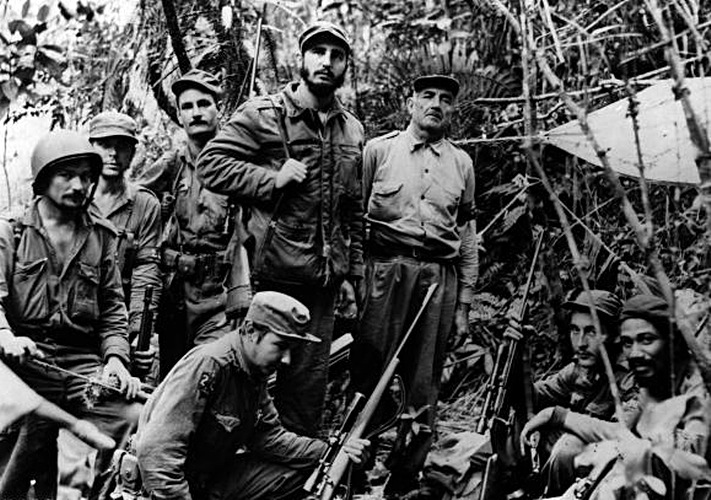
C-46 at Secret Nicaraguan Air Base
Despite the purchase of many aircraft, it was obvious that all the men and heavy weapons could never be delivered to Cuba by transport aircraft only.
[EDITOR: I take exception to this. The men with man-portable weapons could very easily be flown in to Cuba. The only things not transportable by C-46s/C-54s were large vehicles and bulk supplies.]
Therefore, five merchant ships, each 5.000dwt, were chartered from "Garcia Line", in Nicaragua. Via the "Mineral Carriers Ltd." the CIA also purchased two LCI landing crafts, and a 110m long landing ship USS San Marcos, which was actually taken out of the USN reserve. Some slight postponements were caused due to the need to use some of the Cuban crews and transport aircraft for putting down some unrest in Guatemala.
Although at least two B-26Cs were damaged in training and one crashed, and an AT-11 was shot down over Cuba on 11 March 1961 (the crew was recovered by a destroyer of the USN), by the time the Operation PLUTO was initiated, there were still up to 16 Invaders at hand. All the Invaders prepared for the operation were equipped with drop tanks taken from USAF F-84s, giving them an increased endurance. It was planned, namely, that these aircraft would be used to destroy the FAR during the early hours of the invasion, so to establish the air superiority over the bridgehead and a better part of Cuba. As already mentioned, in order to conceal the actual origins of these planes, all were painted in fake FAR-markings, getting the FAR national markings on the fin and serials on the nose. In fact, these markings were only superficially similar to those indeed used by the "original" Cuban aircraft: the FAR B-26Cs, for example, had not only a glazed nose, but were also painted in olive drab overall, while the B-26Bs of the exiles had noses with 8 machineguns and were left aluminum overall.
During the training of Cuban B-26-crews in Nicaragua, several aircraft have got a sort of a "nose-art". The "VI-RA-TE" was the "personal mount" of Capt. Raúl Vianello, and the name was a combination of the first two letters of his wife, son, and daughter. (artwork by Tom Cooper)

The Fuerza Aerea Revolutionaria (FAR-Cuban Air Force)
Before the success of the revolution, in 1959, the original Fuerza Aérea del Ejército de Cuba was a small service, mainly equipped with obsolete and surplus types supplied according to U.S. MDAP-projects, and barely operational due to the unrest within its own ranks. By 1959, it boasted at least nine (out of 12 originally delivered) B-26C Invader bombers, 12 Sea Fury FB.1s and two F-47D Thunderbolt fighters, four (out of eight) T-33A training jets, as well as one OS2U-3 Kingfisher, one C-46 and three (out of four still intact) C-47 transports, and one Beech C-45. That was also the number of aircraft the newly established Fuerza Aérea Revolutionaria - the Revolutionary Air Force (FAR) - took over at the moment of 1st establishment, in early 1960. Only few of these aircraft were actually airworthy, but the FAR was swift to call to service a number of former FAEC transport and also civilian airline pilots. Due to immense efforts of all involved, by late 1960 the new Cuban air force was actually in a pretty good shape - considering the circumstances. For example, the single Escuadron de Bombardeo, commanded by Luis Silva-Tablada (a former FAEC pilot, and comrade of quite a few of counter-revolutionary pilots which were to fly missions of the operation PLUTO) prepared six out of nine available B-26 airframes for operations. In fact, usually only between one and 3 Invaders could be considered airworthy (five of these were stationed at Antonio de los Banos airfield, south of Havana, and the main FAR air base, and one was usually held at Santiago de Cuba - where also all the grounded examples were parked), but the FAR thus possessed a valuable light-bomber asset. The situation in other Cuban units was similar. In total the most important of FAR's assets were the pilots and ground crews, which were highly enthusiastic and to prove far more capable and willing to fight than could be expected considering their training and experience, or general circumstances under which they had to work.
The situation on the other side was only slightly different, then the counter-revolutionaries were at least as enthusiastic about the operation in which they were to take part. There were certain predispositions for this enthusiasm, which were to influence it considerably later. Namely, the B-26s of the counter-revolutionaries were to operate over Cuba after starting from very distant bases - Retalhuleu in Guatemala (by then code-named "Rayo Base"), and Puerto Cabezas in Nicaragua (code-named "Happy Valley"). This would make for some round trips of up to 1400 miles and up to eight hours, mostly over the sea and with only very limited possibilities of search-and-rescue operations - which was the actual background behind the CIA going for two-engined B-26s instead for one-engined P-51Ds when planning and organizing the Operation PLUTO.
[EDITOR: can P-51Ds fly the distance or not? If so, they could have at least provided air cover against the Sea Furies and been better at warding off T-33 jets. Why was this an either P-51 or B-26 choice?]
Certainly, this was not a reason for over-enthusiasm, but then even more problems developed. The original plan for the Operation PLUTO saw the support of the Assault Brigade 2506 not only by B-26s flown by counter-revolutionary pilots, but also by the U.S. aircraft and ships of at least one USN carrier battle group. In January 1961, however, the new U.S. administration of the President Kennedy took over in Washington. Despite his sympathies for the idea, on 3 March 1961, Kennedy issued an order which would not permit any direct involvement of U.S. military, however. Even more so, he also forbade the planned large opening attack by counter-revolutionary B-26s against the Cuban air bases. These decisions were initially kept secret from the personnel of the Assault Brigade 2506, and so also counter-revolutionary pilots. When they learned about them - shortly before the start of the invasion - quite a few were disappointed and frustrated.
The Puma Strike
On Saturday, 15 April 1961, around 02:30hrs, only 8 out of at least 16 operational counter-revolutionary B-26Bs took off towards their assigned targets. The plan - called the Operation PUMA - now saw limited attacks against the FAR air bases, which would then be explained as caused by a defecting crew of the FAR. This story was to be supported by another counter-revolutionary B-26 - of course, in full FAR-markings - landing in Miami, where its crew would explain that they defected after fleeing from Cuba.
The 8 bombers were organized into three sections:
- Puma Flight, with Jose Crespo and navigator Lorenzo Pérez-Lorenzo as "Puma 1"; Daniel Fernández-Mon and navigator Gaston Pérez as "Puma 2"; and Osvaldo Piedra with navigator José Fernández as "Puma 3". Their target was the airfield Campo/Ciudad Libertad (the counter-revolutionary crews called it "Camp Libertad"; the Cubans "Ciudad Libertad).
- Gorilla Flight, consisting of "Gorilla 1" (B-26B "FAR 931"), flown by Capt. Gustavo Ponzoa with navigator Capt. Rafael Garcial Pujol, and "Gorilla 2" ("FAR 933"), flown by Capt. Gonzalo Herrera, with navigator Angel Lopez. Their target was the Antonio Maceo International Airport, Santiago de Cuba.
- Linda Flight including "Linda 1" ("FAR 929") flown by Luis Cosme, with navigator Nildo Batista; "Linda 2" with René Garcia, with navigator Luis Ardois; and "Linda 3", with Alfredo Caballero, with navigator Alfredo Maza.
Their target was San Antonio de los Banos air base. 
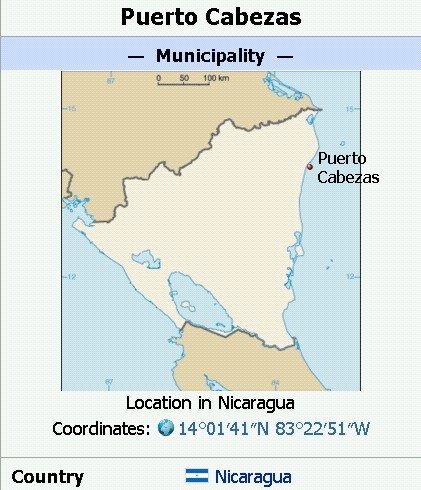
"FAR-917" (probably ex-USAF 44-34429) was the last operational B-26C with the Cuban Air Force. Flown by the Chilean instructor Legas, the aircraft was underway for its last sortie on 18 April, when hit by ground fire: Legas was forced to make an emergency landing with four 250kg bombs still aboard!

Castro's FAR B-26Cs had glass noses
Each aircraft was armed with two 250kg and ten 125kg bombs, as well as with eight [.50 caliber heavy] machineguns, mounted in the nose.
As first over their target, Santiago de Cuba, arrived the Invaders of the Gorilla Flight. They were probably spotted by a patrol boat of the Cuban Navy while approaching at medium level, but then dived to only 10 or 20 feet above the sea and continued towards the target. Once over Santiago de Cuba, Ponzoa bombed the ramp under which fuel depots were buried, while Herrera straffed AAA-emplacements. After the first turn, the planes exchanged their places and Herrera bombed, while Ponzoa tried to give him some cover. The Cubans responded with fierce fire, filling the skies with tracer caliber 23mm and 37mm, but the two Invaders then turned around positioning for their third attack. While dropping his last bombs, Capt. Gonzoa noticed one Cubana Airlines DC-3/C-47 (CU-T172) and a Cuban Navy PBY already burning, and then turned for another strafing run, during which Herrera hit several parked aircraft and also the building nearby. Despite the meanwhile fully alerted defenses and the fierce AAA fire, Capts. Ponzoa and Herrera positioned for yet another attack, during which Ponzoa hit an all-black painted FAR B-26C, causing it to burst in flames. Only then have they turned away: Herrera's plane was hit several times, causing his nose gear door to hang half open. Nevertheless, the pair landed safely at Happy Valley almost seven hours after the take-off, claiming to have destroyed the fuel depot and virtually every military and civilian aircraft they found parked on the ground (for a total of three or four B-26Cs - all of which were probably not airworthy - one C-47, and one FB.1 Fury of the FAR, and the single DC-3 of the Cubana Airlines).
As next over their target, Camp/Ciudad Libertad, the Puma Section was less successful and lucky. Some sources claimed that the Puma Section damaged "only one T-33A", but in fact there were no FAR aircraft at this airfield, as it was not used already since months. Therefore, this strike was a complete waste of time and resources. Even more so, the B-26B "Puma 3" was shot down by AAA, and crashed off the north coast of Havana, with the loss of the crew. The second Invader from this pair, the "Puma 1", was also damaged, and diverted to the NAS Boca Chica, near Key West, instead of flying back to Nicaragua.
Finally, the third pair, Linda attacked San Antonio de los Banos, and claimed the destruction of one each of T-33A ("715"), C-47, and AT-6, and another Cubana DC-3. The Linda 2? was damaged by AAA and diverted to Grand Cayman.
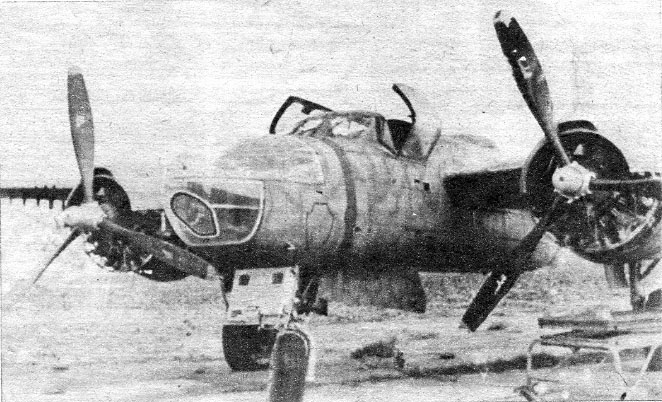
http://gallery.pictopia.com/miami/photo/8482699/
4/18/1961: Cover (page 1 section letter A) from The Miami Herald issue published Tuesday, April 18, 1961 in Miami Florida. Features INVADERS SLUG INTO INTERIOR Other headlines: CASUALTIES HEAVY AS BATTLE RAGES THROUGHOUT CUBA by DOM BONAFEDE, Herald Staff Writer with associated Herald Map of Cuba by Chief Artist FRANK GREGG "Arrows Show Where Invaders Stabbed Into Castro-Dominated Cuba ...their first objective is to cut the island-long highway, Carreterra Central"; REBEL PLAN: CUT CUBA IN HALF by JAMES BUCHANAN, Herald Staff Writer; GUNBOAT LOADED AT MIAMI PIER by JAMES BUCHANAN, Herald Staff Writer with associated photograph "Workers Prepare Gunboat for Invasion of Cuba ...ship was once a U.S. Navy subchaser" Herald Staff Photo by DAN McCOY; WHICH SIDE DO YOU BELIEVE?; 'HIRELINGS' FROM U.S. BLAMED, by The New York Times Service; LIZ, LANCASTER WIN TOP OSCARS, by AP with associated photographs of LANCASTER and LIZ; STAGE SET TO ASK EICHMANN'S DEATH, by AP with associated photo of HAUSNER; FINCH, CAROLE GET LIFE TERMS.
With this, the opening attack was over, and the CIA now initiated the "public" part of the campaign. At 0400 hrs, Mario Zuniga, a pilot of the Assault Brigade 2506, took off in the second B-26B "FAR 933" for Miami, where he landed at 0821hrs, explaining to have defected from Cuba after destroying several FAR aircraft on the ground. Only very few observers noticed that the aircraft was a B-26B, with "hard" nose that contained eight machine guns, while the FAR was flying B-26Cs, equipped with a "glazed" nose and carrying machine guns in the wings. Also, initially nobody asked any questions about the fact that the guns of the aircraft were obviously not fired: for the time being, the deception functioned.
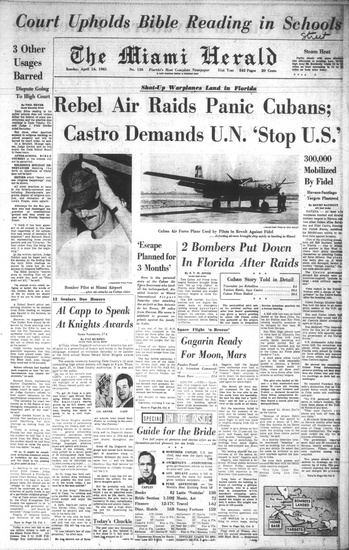
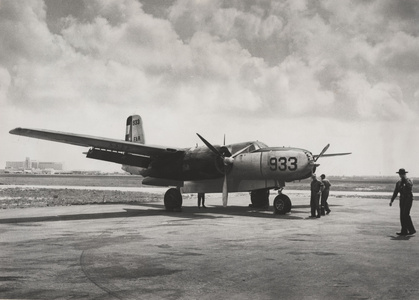
"FAR933" - actually the B-26B of the "Liberation Air Force", flown to Miami in deception campaign at the beginning of the assault on Cuba. The CIA did a reasonably good job in replicating FAR markings, however, the genuine FAR Invaders were B-26Cs - with glazed nose and machine-gun turrets.
Invaders in Air Combat
Meanwhile, an USAF U-2 returned to USA with the post-strike pictures of the Puma attack, which showed that only 5 FAR aircraft could be confirmed as destroyed on the ground, while few others were hit, but considered as damaged. With this, it became clear already at that moment, that the landing of the Assault Brigade 2506 would not be undertaken under conditions of a complete air superiority: actually, it would lack also proper air support. Because of this, the CIA and the exiled Cubans demanded permission to fly additional strikes. President Kennedy turned any such requests down, explaining that meanwhile it became clear that the B-26 that landed in Miami could not have started from Cuba. The Invaders of the counter-revolutionaries were to fly again only after some of the Cuban airfields were captured.
Obviously, the poor intelligence on the actual condition and capabilities of the FAR have left the counter-revolutionaries and the CIA under impression, that the invasion could be continued as planned nevertheless, and therefore a decision was brought to do so, even if all the air strikes planned for the 16 April were cancelled. This was a fatal mistake: the FAR was not destroyed, and now it has also got almost 48 hours to mobilize and prepare for the fighting.
Shortly after the midnight of 17 April, the first parts of the Assault Brigade 2506 landed from the merchant Barbara J. on the "Blue" beach, near Giron, which had also a small landing strip. Shortly after, the second part of the Brigade landed from Blagar on the Beach Red, near Playa Larga, in the Bay of Pigs. The first two ships were followed by the former-USS San Marco and seven landing crafts, which delivered 5 M-41 light tanks to Playa Larga. Initial Cuban resistance was weak, and the Assault Brigade 2506 had no problems in establishing a several kilometers-deep beach-head.
Nevertheless, Castro was swift to respond and the first stronger units of the Cuban Army started moving at the dawn. The FAR was also swift to send some of its fighters and light bombers into the area and these appeared just in the moment as the 5 C-46s and a single C-54 delivered 177 paras of the Assault Brigade 2506 some 7 kilometers behind the Playa Larga, in order to reinforce the beach-head (the drop was code-named Operation FALCON). As the transports turned, around a single FAR B-26C - initially misidentified as one of the counter-revolutionary aircraft - appeared near one of the C-46s, but when it opened fire, the pilot of the C-46, Capt. Eddie Ferrer, turned his transport into the Invader, passing nearly head-on and then moving towards the support ships which were armed with anti-aircraft guns and could thus offer some support. The lonely FAR B-26 then left the area, its crew later claiming to have shot one C-46 down.
[EDITOR: all transport planes should be armed with at least air-to-air missiles]
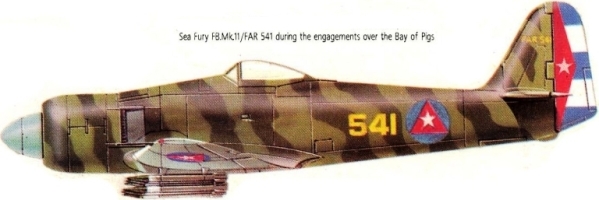
Meanwhile, around 0645hrs, the FAR Sea Fury "541", flown by Maj. Enrique Carrera-Rolas, appeared over Playa Larga and found the next merchant, Houston, which was in the process of off-loading supplies. Carreras immediately attacked and caused a considerable surprise delivering a salvo of unguided rockets very precisely: Houston was heavily hit and cached fire. It was soon clear that the ship could not be recovered, but the FAR pilots knew that more efforts were needed in order to have some effects. Consequently, three hours later several FAR Sea Furies appeared on the scene and attacked Rio Escondido - which carried most of the ammunition for the Assault Brigade 2506 - near Giron, hitting it with several rocket-salvos and gun-fire, and causing a powerful explosion.
Sea Fury
The attack of the Furies against Rio Escondido was witnessed by the crews of the two counter-revolutionary B-26Bs - belonging to the "Chico" section - which now appeared on the scene. Invader "FAR 935", flown by Capt. Matías Farías (as "Chico 2"), with Eddie Gonzalez as navigator, turned immediately behind the nearest Sea Fury and took a snap-shot while the two aircraft were mid through a turn towards each other. Then two more Furies appeared, one to the right, and another to the left of the Invader, but they "identified" the aircraft as "their". One of the two FAR fighters is believed to have been flown by Maj. Enrique Carrera-Rolas, which then turned away and towards Veradero. Capt. Farías started a pursuit and catched with the much faster Sea Fury only when Carrera-Rolas was in the landing pattern: Farías attacked and scored some hits, but the fighter retracted the gear and accelerated away. Disturbed by the communist AAA, Farías then turned away towards the Bay of Pigs, where he briefly exchanged fire with an "original" B-26C Invader, the "FAR 903", flown by Capt. Silva-Tablada. Silva-Tablada and his crew (including Mation Torres, Jesus Noa, and Gonzalez Garrinaga) were underway towards the Bay of Pigs, and they arrived there exactly in the moment as the landing crafts returned to merchants in order to take the next wave of troops, as well as ammunition and supplies. By now, the gunners aboard the ships were alerted and ready, and as the Invader approached it meet fierce opposition. The plane was hit by the AAA, lost a wing, and cart-wheeled into the water.
Returning over the bridgehead around 0700hrs, Capt. Farías was then to witness three hours of intensive combat. While the other B-26B from this pair returned back to Nicaragua, he remained on station as requested by the commanders on the ground. As first, he supported the landings at Playa Larga, and strafed the communist column underway from Cienfuegos, before supporting the Paratroopers of the Assault Brigade 2506 involved in fighting between Soplillar and Yaguaramas. By 0900 hrs, it was clear Farías would not have enough fuel to return to Happy Valley, but would rather have to divert to Grand Cayman or Jamaica. After conferencing with the local commander, however, he decided to land on the small strip which was already under the control of the Assault Brigade 2506. Just in the moment when this decision was taken, another FAR Sea Fury attacked him, but apparently missed. Turning towards the strip, Farías then noticed smoke and that the plane was damaged: what exactly caused the problems remained unknown (after all, by the time Farías was over the area for almost four hours and participated in several engagements), but while almost over the small airfield Playa Giron, his Invader was then attacked also by the FAR T-33As flown by Lt. Alberto Fernandez and heavily damaged, while his navigator was killed. Pulling up, Farías tried to shot at Fernandez which overshoot, but then his starboard engine quit and he had to crash-land. Badly injured during the landing, Farías was evacuated to Nicaragua two days later.
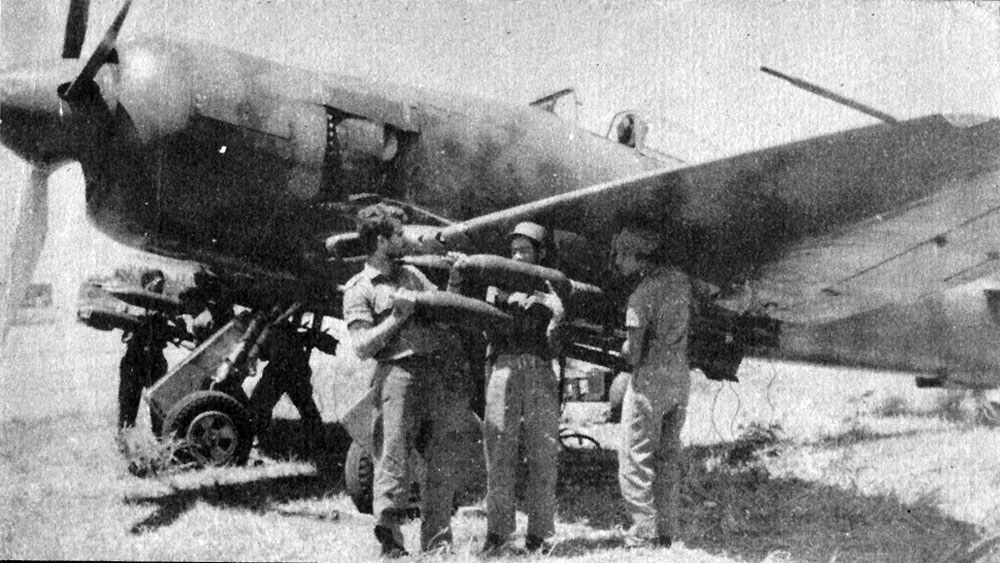
Shot-Down B-26B
The Catastrophe in the Bay of Pigs
Shortly before Farías B-26 went down, around 1000 hrs 4 other Invaders of the counter-revolutionaries appeared on the scene. 2 of them attacked a Cuban column near Pálpite, causing a heavy loss, but then more FAR fighters arrived on the scene and moments later the Invader-crews were fighting for naked survival, as - despite their lack of experience - the FAR pilots flew their planes in an admirable manner.
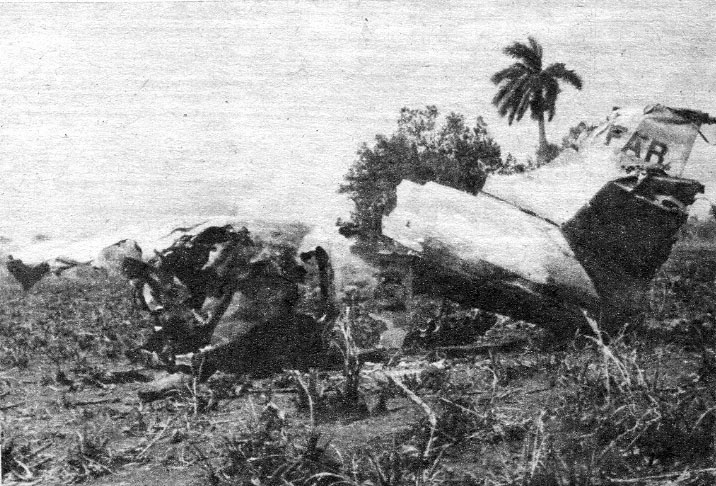
A-4 SkyHawks over an U.S. carrier
Despite an intervention by several A4D-2 Skyhawks from the U.S. carrier USS Essex (CVA-9), which tried to fly in between the FAR and counter-revolutionary aircraft, the T-33As and Sea Furies could not be stopped. The B-26 "Paloma 1", flown by Capt. Raúl Vianell, and navigator Demetrio Pérez, was shot down by the T-33A flown by FAR Capt. Alvaro Prendes. The B-26 "Lion 2", flown by Capt. Crispín García, and navigator Juan González, was shot down probably by the Sea Fury "541", flown by Maj. Enrique Carrera-Rolas. Then also the end for the rest of the "Puma" flight came, as both B-26s belonging to this section came under attack: "Puma 1", flown by Capt. José Crespo with navigator Lorenzo Pérez-Lorenzo, was badly damaged by the Sea Fury piloted by Lt. Douglas Rudd. The Invader ditched in the sea near Nicaraguan coast, but the crew was killed. "Puma 2" had no better luck: it was shot down by T-33A "703", flown by Lt. Rafael del Pino, and the crew - Capt. Osvaldo Piedra and navigator José Fernández - was killed.
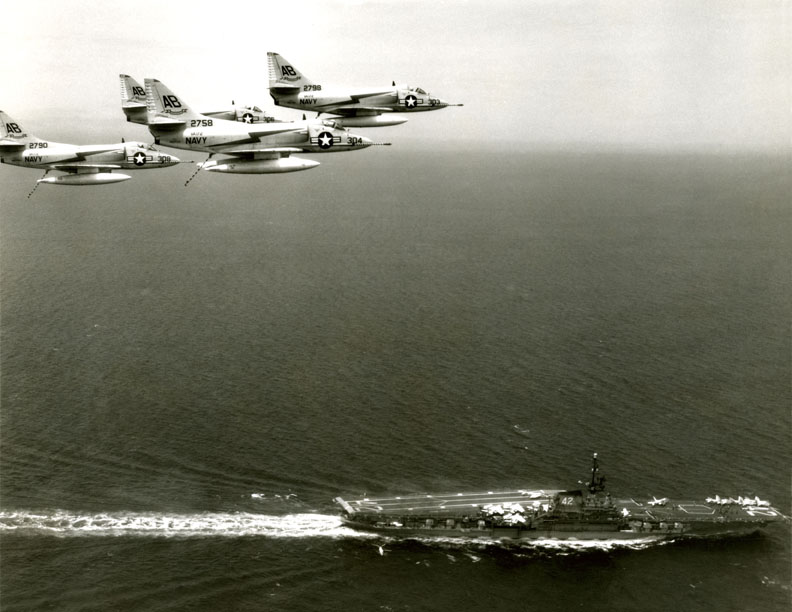
Cut-away view of the Sea Fury
After these heavy losses most of the remaining counter-revolutionary pilots, demoralized and frustrated, refused to fly additional combat sorties into the Area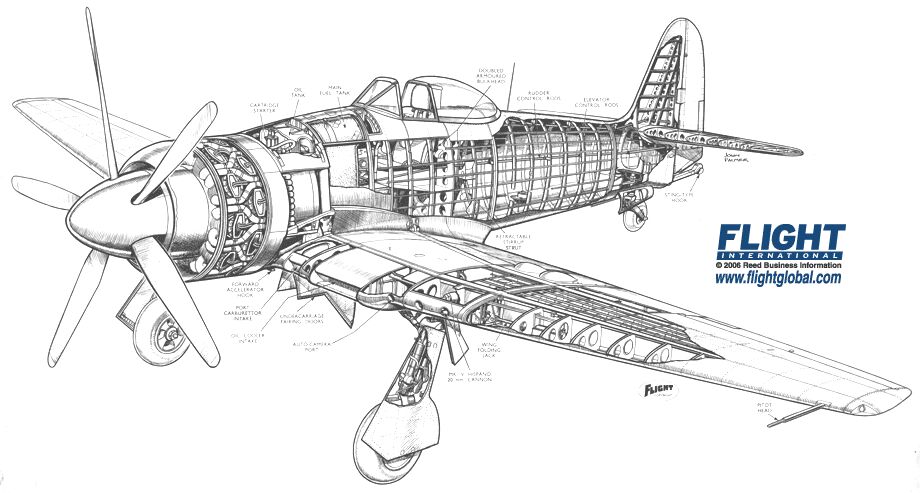
C-46 Commando
Under such conditions, there was no other possibility but to send U.S. instructors to fly combat sorties with B-26s over the Bay of Pigs on 18 April. This attack was successful in hitting the Cuban positions, and no aircraft were lost. In response, the FAR sent its last operational - out of two examples remaining intact - B-26C into the battle as well., flown by Chilean Jacques Lagas. But, while over flying the communist positions the aircraft was hit by the ground defenses and damaged, and then suffered also a mechanical failure. Lagas landed safely, but this was the last flight of any "original" Cuban B-26C Invaders.
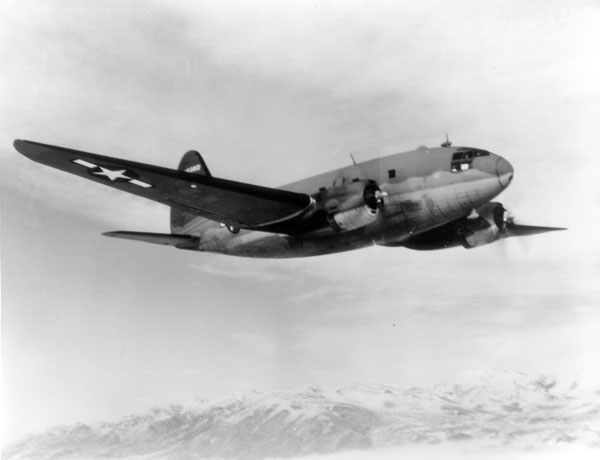
Fake "FAR-931", the B-26B flown by Capts. Ponzoa and Pujol as "Gorilla 1" on the morning of 15 April 1961, during the strike against Puerto Cabezas.
On the same day,a few aircraft from the USS Essex - with all their markings removed - were sent into reconnaissance of the area, as well as a single USAF C-130 Hercules transporter, which started from the Kelly AB, in Texas, which was to drop some supplies in the night. Due to different factors, the Hercules never reached Giron. Meanwhile, the situation of the Assault Brigade 2506 on the ground became critical as well. The two last undamaged merchants, Atlantico and Carribe, had left the area without off-loading most of their loads, and the troops were now very short with ammunition.

Jet landing on the USS Essex
For the morning of 19 April, one last large air attack was permitted to be flown by the Cuban counter-revolutionary pilots, which agreed to fly it, but only if covered by the Skyhawks from the USS Essex. After this request was turned down by Washington, however, again only the U.S. advisors showed ready to take off. So it came that the U.S. pilots William Goodwin, Thomas W. Ray, Riley Shamburger, and Joe Shannon, together with the Cuban pilot Gonzalo Herrera, manned the 5 B-26Bs readied for this mission. The bombers took of from Happy Valley at 0330 hrs, and closing to the Cuban coast even saw 4 Skyhawks of the VA-34. But, the USN fighters were only on a reconnaissance flight--and not to get involved: as soon as they spotted the arriving Invaders, they turned away. Namely, the USS Essex had got a secret order to dispatch several Skyhawks for the escort of counter-revolutionary bombers, but these missed to meet the B-26s due to communication problems. The U.S. crews attacked nevertheless.
Thomas W. Ray, underway under with the call-sign "Mad Dog 4" with navigator Leo Baker, bombed Castor's HQ in the "Central Australia" sugar factory, but was then shot down by Maj. Enrique Carrera-Rolas, which piloted the T-33 "709". Ray and Baker bailed out safely, but were then executed by the communists. The other 4 bombers managed to hit their targets as well, but then another T-33A, "711", this time flown by Capt. Alvaro Prendes, catched the leading Invader of the "Mad Dog" formation, flown by Maj. Rilley Shamburger, with navigator Wade Gray, and shot it down.
Conclusion
For all purposes, the battle was now short of being over: on the ground, no less but 1, 189 troops of the Assault Brigade 2506 were meanwhile captured - or would be catched in the following few days - while 114 others were killed. The CIA dispatched another transport to drop supplies on the same evening, but Operation PLUTO was then cancelled. The remaining 50 Cuban pilots and technicians were then flown to Miami, and all the bases used for the operation closed. The Invaders left behind at Happy Valley languished for some time before being taken over by the Fuerza Aérea de Nicaragua; few examples were even flown back to the USA, and ended at Davis-Monthan.
For the FAR, its first combat campaign was a complete and undisputed success. According to official and unofficial Cuban sources the - in part young and mainly inexperienced - FAR pilots claimed a surprisingly high number of air-to-air kills against the counter-revolutionary aircraft. Even if under a closer look most of these proved as over-claims (some Cuban sources claim no less but 16 counter-revolutionary aircraft as shot down by FAR pilots), their achievements nevertheless deserve a full credit, especially as most of the FAR pilots had no combat experience at all, and the aircraft they flew would probably be declared non-operational in most other air forces. Their achievements are even more significant if the one considers, that the official Cuban sources claimed the ten available FAR pilots to have flown no less but 70 combat sorties, while the counter-revolutionary sources indicate everything else but a confirmation for even 50% of this claim to be truth. Consequently in a very small number of combat sorties the FAR delivered the decisive blows to the counter-revolutionaries, sinking two transport ships and shooting down seven B-26B Invaders (an eight example was shot down by the AAA), thus assuring their enemy not to be properly supplied with ammunition, and left without any air cover. For all purposes, the Fuerza Aérea Revolucionaria was thus instrumental in spoiling the Operation PLUTO.
The most-successful FAR pilots were:
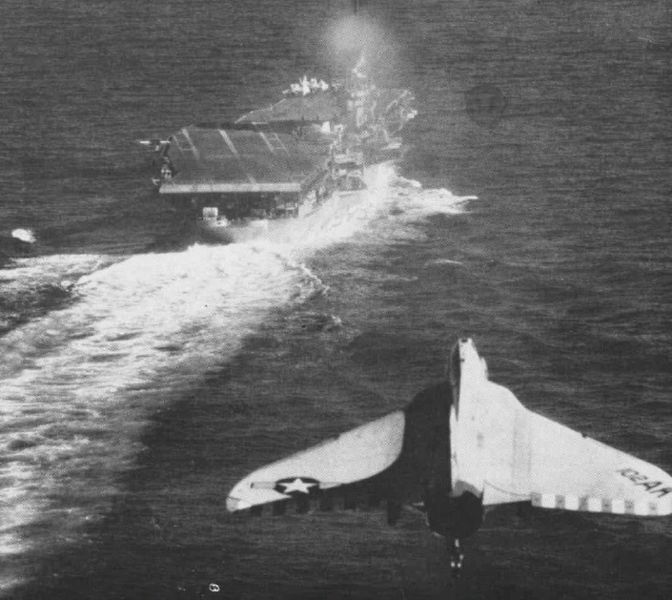
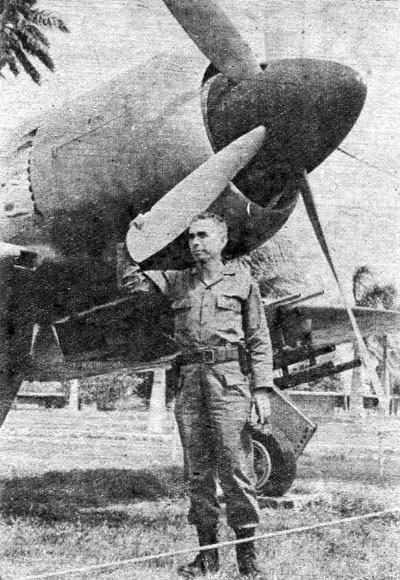
- Maj. Enrique Carrera-Rolas, for which two kills were claimed in only seven sorties flown, and which not only indeed shot down two B-26s, but also sunk one transport ship,
- Capt. Alvaro Prendes, for which three kills were claimed (two confirmed) in - supposedly - 14 combat sorties, and
- Lt. Rafael del Pino (which in the mid-1980s defected - flying his whole family in a small aircraft - to the USA, after also leading the Cuban contingent in the war in Angola), for which it was claimed to have shot down 2 B-26s (only one confirmed) in ten combat sorties,
The counter-revolutionary pilots fared at least as well. However, with their slower and less maneuverable Invaders they could simply not win the air combats against the faster Sea Furies and T-33As of the FAR. Left without the promised support from the USA, and after suffering heavy losses in repeated air combats, it was not surprising that they finally gave up in frustration. Their fate illustrated perfectly how heavily dependable on possession of air superiority operations of this kind were.
For the CIA, the Operation PLUTO became a classic synonym for a military disaster, which caused the agency to be comprehensively reorganized. The times when it was organizing clandestine para-military operations all over the world were largely over, and the CIA - subsequently put under the direct control of the U.S. Senate - was subsequently reorganized into an intelligence-gathering organization. This remained that way right until the end of the 20th Century, and was changed only after severe criticism for its inactivity in the face of increasing activity of Islamic extremists.
-----------------------------------------------------------------------------
Air Orders of Battle
CUBA
FAR
- Escuadron Persecucion y Combate: 4 x Sea Fury FB.11s (3 operational), 5 x T-33As (possibly also few P-51Ds, but none were flyable) at Camp Libertad, and San Antonio de Los Banos
- Escuadron de Bombarderos Ligeros (CO Luis Silva-Tablada; XO Jacques Lagas - a former Chilean, trained on B-26s in the USA and contracted to train Cuban pilots): 5 x B-26Cs at San Antonio de los Banos, 1 at Santiago de Cuba (plus several grounded examples)
- Escuadron de Transporte: few C-46s and C-47s at Camp (or "Ciudad") Libertad, Santiago de Cuba, and Cienfuegos
- Entrenamiento (training group), used also for liaison, flew reportedly few TBM Avengers, but also several Cessna, Beechcraft, and Piper aircraft; there was also a small helicopter arm, equipped with a small number of Bell 47s, as well as with the first Mi-1s, and Mi-4s.
USA
CIA Assault Brigade 2506
16 x B-26B Invader medium attack bombers
6 x C-46 Commando transport planes
8 x C-54 transport planes
2 x PBY Catalina seaplanes
U.S. Navy (USN)
USS Essex, CVS-9, with carrier air wing CVSG-60 embarked (code AW), including:
- VA-34 Blue Blasters, A-4D-2 Skyhawk
- VS-34 (name of the unit unknown), S-2F Tracker
- VAW-12 (Det.), AD-5W Tracker
- HS-9 Sea Griffins, HSS-1 helicopters
-----------------------------------------------------------------------------
Note: at the open-air display in the DAAFAR Museum, near Havana, a B-26B can be found, carrying the serial "933". This plane certainly never flew with the FAR, but is believed to be an ex-Portuguese example, brought from Angola as a war prize.
-----------------------------------------------------------------------------
Sources & Bibliography
- "AIR WARS AND AIRCRAFT; A Detailed Record of Air Combat, 1945 to the Present", by Victor Flintham, Arms and Armour Press, 1989 (ISBN: 0-85368-779-X)
- "Profile Publications" series, Profile Publications Ltd., Leatherhead, Surrey, from the late 1960s and early 1970s.
- Ian Allan "At War", "Postwar Military Aircraft", and "Modern Combat Aircraft" series
- THE ARMS BAZAAR, by Anthony Sampson, Hodder and Stoughton, 1977 (ISBN: 3-498-06118-6)
- "LATIN-AMERICAN MILITARY AVIATION, by J.M. Andrade, Midland Counties Publications, 1982
- NORTH AMERICAN F-51 MUSTANG IN LATIN AMERICAN AIR FORCE SERVICE, by J. Dienst & D. Hagerdon, Aerofax, 1985
- ENCYCLOPEAEDIA OF THE WORLD'S AIR FORCES, by Michael J.H. Taylor, Multimedia Books Ltd., 1988 (ISBN: 1-85260-135-3)
- THE PENGUIN ENCYCLOPEDIA OF MODERN WARFARE, by Kenneth Macksey & William Woodhouse, Penguin Group, 1991 (ISBN: 0-670-82698-7)
- WORLD'S AIR FORCES, by John Pacco, JP Publications, 1992 (ISBN: 90-801136-1-1)
- FOREIGN INVADERS; The Douglas Invader in Foreign Military and U.S. Clandestine Service, by D. Hagedorn & L. Hellström, Midland Publishing Ltd., 1994 (ISBN: 1-85780-013-3)
- AEROSPACE ENCYCLOPEDIA OF WORLD AIR FORCES, edited by David Willis, Aerospace Publishing, 1999 (ISBN: 1-86184-045-4)
-----------------------------------------------------------------------------
Further Recommended Reading
- "Bay of Pigs; the Men and Aircraft of the Cuban Revolutionary Air Force" by Doug MacPhail and Chuck Acree, posted at the website of the Latin American Aviation Heritage Society
- "Secret Warriors; the CIA's Liberation Air Force in 1954 in Guatemala" by Mario E. Overall, another excellent article posted at the website of the Latin American Aviation Heritage Society, offering an exclusively detailed insight into the organization of the typical CIA para-military operations of the time
latinamericanstudies.org/bay-of-pigs/joe-shannon.htm
Birmingham Weekly
Sept.13, 2007
The Good Fight: The True Story of the Alabama Air Guard and the Bay of Pigs
By: Jesse Chambers
Joe Shannon's life course was set forever one day in 1927, when he was just 6 years old. His dad took him to Roberts Field in Birmingham to see Charles Lindbergh make a stop on the triumphant national barnstorming tour that followed his solo flight across the Atlantic in The Spirit of St. Louis.
"I saw my first airplane up close, and I made up my mind that I wanted to be a pilot," Shannon tells me. "That's all I ever wanted to do."
Shannon, now 86, has flown everything - J-3 Piper Cubs, P-51 Mustang fighters, B-25 bombers, C-47 transports, and more. He flew in World War II and the Korean War. He was a corporate pilot after retiring from the military.
Pictures hanging in the study in Shannon's Birmingham apartment show him with such dignitaries as World War I ace Eddie Rickenbacker; Air Force general Jimmy Doolittle, who led the first bombing raids on Japan in 1942; and even Lindbergh, who Shannon was chosen to escort when he made an appearance in Birmingham in the 1970s. Shannon looks comfortable with these people. He belongs in that class.
Any of these connections to history would make Shannon a good interview, but none of them explains why I was so anxious to spend time with him, or why I found his story so moving.
Shannon is the last survivor of a group of Alabama Air National Guard pilots who flew B-26 bombers in combat at the Bay of Pigs in Cuba in April 1961, during the U.S. government's failed attempt to use Cuban exiles to invade the island and stir up a popular revolt against Fidel Castro.
One of Shannon's best friends died during the mission, along with three other members of the Alabama Air Guard. Although Shannon survived, he was forced to endure nearly two decades of silence before being allowed to tell anyone - even the families of his dead comrades - what really happened.
I'm not the first reporter to talk to Shannon, but he's my first chance to sweeten the dry facts of history with blood and flesh, to look into the eyes and hear the voice of a participant in a major historical event.
Even better, this event has a Birmingham connection - back to the Alabama Air Guard base on the north side of Municipal Airport, just blocks from the quiet working-class enclave of East Lake where I grew up.
The call to adventure
It was December 1960 when Shannon, a Lieutenant Colonel and commander of the Alabama Guard's 106th Bombardment Squadron, and Major Riley Shamburger, his friend and operations officer, were summoned to the office of their base commander.
They found Brigadier Gen. Reid Doster waiting there with two representatives from the Central Intelligence Agency. "We were not even given their names," Shannon says. The meeting was his introduction to the strange customs and shifting identities of the world of covert operations.
Doster had been asked by the CIA to recruit pilots, crewmen and mechanics willing to train and provide logistical support for a group of Cuban exiles that would fly B-26 bombers in support of an invasion. The landing would be carried out by Cuban exile ground troops, also trained and equipped by the CIA
The Alabama Air Guard unit was picked for the mission because they had flown B-26s until 1958, more recently than other U.S. guard units. Doster wanted Shannon and Shamburger, who were among his highest-ranking officers and best-qualified people, to participate.
The goal of removing Castro from power was appealing to Shannon. "I was very anti-Castro," Shannon says. "I grew up despising dictators. I didn't like the fact that he had established a Communist dictatorship right at our back door."
According to Shannon, the other guys in the Guard, including Shamburger, felt the same. "I felt like it was an opportunity, an adventure for a worthwhile cause," Shannon says.
Shannon, then 39, had his concerns, however, regarding his wife, Helen, and their children, Lauren, Joe, Jr., and Malcolm. "It was hard to agree to go on an operation like this without being able to tell my family where I was going and what I was doing," he recalls. "I didn't make a spontaneous decision. I thought about it overnight."
I asked him if Shamburger, who was 36, also needed time to think. "I don't remember," Shannon says. "I don't think he committed right on the spot. But we went together. We felt like we were in this thing together."
The two men accepted, but still needed something to tell their families. "I just told them I was going to a classified training," Shannon says. Shamburger, according to one account, told his family that he was going to train some foreign pilots on the B-26.
[EDITOR: did any think of coming up with some anti-MiG tactics for the B-26 or slower prop planes in general?]
Neither man had any reason to believe that he would never see his family again. They expected to serve only in supporting roles, not in combat.
Secret airfield, Cuban exiles & high hopes
Shannon, Shamburger and the other advisors trained the Cuban pilots in the weeks prior to the invasion at a secret airfield at Retalhuleu in the Sierra Madre Mountains in Guatemala, next to a banana plantation owned by the United Fruit Company.
The exiles - called the Cuban Liberation Air Force - flew B-26 bombers taken from the U.S. Air Force mothball fleet in Arizona and painted to look like the B-26s used by Castro's air force. "The cover story was to have been that these people were members of Castro's armed forces that defected and took their airplanes with them," Shannon says.
The efforts at secrecy didn't stop there. Shannon, Shamburger and the other Americans wore civilian clothing and assumed new identities.
"We had phony ID - phony Social Security, driver's license, home address, name and none of our clothing had American markings in it, like 'Made in the U.S.A.'' Shannon says. "It was all sanitized."
Both aircraft and personnel were, in Agency parlance, "sheep-dipped" to the CIA - meaning their true origins or affiliations were obscured in case they should be captured.
Shannon and Shamburger became full-fledged members of the CIA. This occurred in Washington, D.C., where they spent most of January and February of 1961 using their knowledge of the B-26 to assist CIA personnel who were planning the invasion. "Out of the 75 or 80 people from Birmingham and vicinity who were involved, we were the only two who were actually hired by the CIA," Shannon says. "The others were employed by a front company."
Shannon was confident in the Cubans he was training in Guatemala, although some had no combat experience. "I had never seen such a determined bunch in all my life," Shannon says. "I have never seen American pilots who were as determined."
He admired their esprit de corps. "They were closer than any group of military people that I've ever known," he says. "They were a real family. And they were real emotional about it sometimes."
Shannon identified strongly with the Cubans' cause - what they saw as the liberation of their homeland. "These people, the fact that they left Cuba and went into exile, they developed a hatred of the Cuban military and the Cuban government," he says. "They had a lot of personal reasons that those of us who fought in Word War II didn't have."
Political interference
In March 1961, just weeks before the invasion, the operation ran into problems, due largely to politics.
The CIA had cooked up the idea for the invasion in the waning months of the Eisenhower administration and, according to some intelligence analysts and historians, grossly overestimated the popular resistance to Castro within Cuba.
The recently inaugurated U.S. President John F. Kennedy was never comfortable with this plan he inherited, and - along with his advisers - meddled clumsily in the military details.
Kennedy - anxious to maintain plausible deniability regarding the U.S. role - ordered the CIA to scale back the size of the invasion and move it from Trinidad, a city on Cuba's southern coast, to a less visible site.
According to Shannon, CIA planners believed that Trinidad was a hotbed of resistance to Castro, making it an ideal place to spark a rebellion. Trinidad is also surrounded by the Escambray Mountains, meaning the exiles could have fought their way into the hills and joined anti-Castro guerrillas already operating there if the landing did not go well.
However, the high visibility of a landing at Trinidad made the president nervous. "Kennedy wanted it look from the very beginning like it was planned and executed by a bunch of Cubans in exile," Shannon says.
The CIA moved the invasion to the Bay of Pigs, or Bahia de Chochinos, also on the island's southern coast, because the nearby town of Giron had an airfield that could be used by B-26s. The site was surrounded by swamps, meaning the invaders would have no mountain escape route. "The Cubans that invaded at the Bay of Pigs were trained in the mountains in Guatemala," Shannon says. "They weren't trained for an operation into a swampland."
On to "Happy Valley"
In April 1961, two weeks before the invasion, the Cuban pilots and American advisors moved from Guatemala to another secret base - called "Happy Valley" - at Puerto Cabezas on the east coast of Nicaragua.
Shannon, Shamburger and the others prepared the Cuban pilots for a series of critically important bombing strikes on Castro's air fields.
"We knew from the beginning that the only way this operation could succeed was to have absolute mastery of the air," Shannon says. "The 16 airplanes we had planned were for the sole purpose of destroying Castro's air force."
Even a few enemy aircraft would be able to wreak havoc on the invaders, especially since the B-26s would have no fighter cover. There were no fighters available for the operation that could fly round-trip from Nicaragua.
The Cuban pilots and their advisers received a devastating blow just before the bombing runs: Kennedy ordered that the number of B-26s be reduced from 16 to 8.
According to Shannon, part of Kennedy's motivation may have been to preserve the cover story that the operation was carried out by defectors from Castro's military. "An organized, 16-plane raid on the three airfields Castro had wouldn't exactly have fit that profile," he says.
As a result, the bombing runs on April 15, two days before the invasion, did not completely destroy Castro's small air force. Even though few of his airplanes survived - "Maybe less than eight, somewhere between six and eight," Shannon estimates - this would later prove decisive.
According to Shannon, a second B-26 strike planned for dusk on April 15 was cancelled by the White House after word of the invasion reached the United Nations during the day, causing a controversy.
"If we had had the follow-up mission, there's no question in my mind that we would have destroyed the rest of his airplanes, and we knew where his tanks were concentrated," Shannon says.
A third strike on Castro's air fields, scheduled for the early morning of April 17, was also scrubbed.
Assault Brigade 2506 lost in the swamps
The invasion at the Bay of Pigs on April 17, 1961 - an amphibious assault by approximately 1,200 exiles, who called themselves Assault Brigade 2506 - was a disaster, largely because of Castro's few remaining fighter planes. "They sank two of the invading ships, one which had the reserve ammunition aboard and the other had communications equipment and field hospital," Shannon says.
Assault Brigade 2506 inflicted heavy casualties on Castro's forces but were gradually pushed back onto the beach and into the swamps. By the morning of the third day, April 19, it was clear the operation had failed. "We were terribly let down that the whole thing had collapsed, and feeling terribly sorry for the poor guys who were stranded on the beach with no re-supply, no water, nothing," Shannon says.
To make matters worse, the Cuban air crews were emotionally and physically drained by the long flights between the base in Nicaragua and the beachhead in Cuba, and only two pilots were able to fly. "Two planes weren't enough to give any kind of coverage on the beachhead," Shannon says.
This would necessitate one final heroic, and very costly, gesture by the Alabama Air Guard.
Shannon & Shamburger's final mission
The CIA base commander at Happy Valley, who called himself "Gar," received a telegram from his bosses in D.C. on April 18, 1961, authorizing the use of American pilots, as long as they remained over the beachhead and sea approaches. They were not to fly inland, which would increase the chance of them being shot down or captured, thereby confirming America's involvement.
"Cannot attach sufficient importance to fact American crews must not fall into hands enemy," the telegram reads, according to a sanitized copy obtained by Shannon in the late 1990s from declassified CIA documents. "In event this happens all precautions crews must state hired mercenaries, fighting communism, etc; US will deny any knowledge."
According to Shannon, there had been plans all along to use American pilots if the Cubans could not continue flying. "Riley and I were not included in this contingency plan," Shannon says.
On the April 19, however, only two of the designated American pilots - Thomas W. "Pete" Ray" and Billy Goodwin - were available at Happy Valley. The others had been sent temporarily on other assignments.
Gar asked Shannon and Shamburger if they would be willing to fly, even though they had been told previously by the Agency they would not be allowed to fly into Cuba due to security concerns.
"He had no authority to let us go, and we knew that we weren't supposed to go, but we had become so attached to the Cubans down there, that their fight was our fight," Shannon says. "So we agreed to fly this last-minute, desperation mission just to let these guys know they weren't forgotten."
Shannon flew that day with Carl "Nick" Sudano serving as navigator. Shamburger flew with Wade Gray. Billy Goodwin flew with James Vaughan, and Pete Ray with Leo Baker. Two Cuban pilots, Gonzalo Herrera and Mario Zuniga, refused to stand down from the mission, despite their exhaustion.
Shannon and Shamburger made landfall about 20 miles east of the Bay of Pigs, then turned and followed the coastline. It was about 6 o'clock in the morning. As they approached the beachhead, they identified a column of military vehicles as their first target.
"Riley says, 'You have the napalm. You go in first,'" Shannon recalls. "So he moved from my right wing to my left wing, and we were lined up on our first pass going into this column of vehicles, and Riley yelled over the radio, 'I'm hit! I'm hit!'"
Shannon saw white smoke coming from Shamburger's B-26. Shamburger and Gray were headed into the water in a shallow dive, at about 300 mph, and a Cuban T-33 jet fighter was on their tail.
"I knew I had to do something in a hurry, because I was probably next," Shannon says. "Being a WWII fighter pilot, my reaction was the only logical thing to do. I turned into the T-33."
Shannon also dropped his napalm and other ordnance. "I didn't drop it on or near any target," he says. "I was just getting rid of extra weight so I could get up more speed."
"That T-33 pulled up to avoid me, and I just continued on around," Shannon says. "I never did see the T-33 again. He was almost vertical when I saw him last."
Shannon, in making his escape, took advantage of the early-morning sun, which he says was hanging right on the coast: "When I turned into him, I turned into the sun, so I got as close to the water as I could, and full throttle for about five minutes, and if the T-33 tried to find me, he would have been looking into the sun and would have had a real rough time."
After about 15 or 20 miles Shannon and Sudano turned south and gained altitude for their return to Happy Valley in Nicaragua.
"I saw two unmarked navy airplanes as I was going out, and they were going in toward the beachhead," Shannon says. They were A-4 jet fighters from a U.S. Navy task force nearby - part of the vast American arsenal that went unused despite persistent rumors that the Navy might provide air cover over the beachhead.
Dealing with loss
Shannon's nickname in the service, according to one source, was "Shaky Joe," because he was so unflappable. Like many men of his generation, Shannon doesn't go for cheap displays of emotion. I discovered this during our first visit, at the Southern Museum of Flight.
What did he think when he saw Riley and Wade plunging to their deaths? Did he even have time to think?
"I don't quite remember what my reaction was at the time," Shannon says. "I know I was mad when we got back, and I wanted to go back and do some more damage to the Cubans. But I was a fighter pilot in World War II, and I saw lots of my friends go down, and it was the same sort of reaction I got then."
A few nights later on the telephone, I asked Shannon to tell me more about that anger he said he felt when he landed at Happy Valley. Was he mad at the Cubans? At the U.S. government? At the situation?
"I was probably angry at the situation," Shannon says. "I don't think the human element entered into it."
What went through Shannon's mind during that three-hour flight back to base?
"It was a feeling of sadness about having lost a friend and seeing him go down," Shannon says. "Unfortunately, that was not the first opportunity I had had to see something like that."
Shannon told me about the summer of 1943 in North Africa. He was in the U.S. Army Air Forces, flying P-38 Lightning fighters against Germans ME-109s. In one particularly bloody engagement, his fighter group lost 22 pilots in two days - including four of Shannon's friends. "There were five of us in a tent, and after two days I was the only one left, and I saw some of them go down," he says.
It was still tough to lose Shamburger.
"I wouldn't say best friends, but we were very close," Shannon recalls. "I had a lot of respect for Riley and his ability, and we partied together. In the afternoons after our work, we'd go by the Airport Inn frequently, and a lot of the mechanics from the flight line would be with us. We'd stop by and have a beer or two on our way home. Our families met together on occasion. We were just close friends. He was just a happy-go-lucky individual. He didn't care whether school kept or not."
Shannon also realized that he could easily have been the one who was killed. "I would have been the target of the T-33 if Riley had not moved from my right wing," he says.
In a third follow-up interview at Shannon's apartment, I asked one more time about the nature of his anger when he got back to base that day.

[EDITOR: Dude! Are you like Oprah Winfrey or something expecting him to break-down and cry or something to make YOU feel better? How many times are you going to ask him how upset he was? He's a COMBAT pilot and a military officer, this isn't Babwa Walters. If you want to know what its like join the military and find out for yourself. Sheesh.]
"You said you were angry at the situation. Is there anything else you can put into words?" I asked.
"Well, before we took off, we felt like it was a futile trip," Shannon says. "We knew that it wouldn't have any effect on the outcome of the war."
"Yes, sir," I say, a phrase I used a lot while talking to him. After all, underneath the hip veneer, I'm just an Alabama boy with an innate respect for men who have been in combat, especially those of the same generation as my dad, now deceased, a Navy vet born in 1921, the same year as Shannon.
"Our primary concern was to make sure that the poor guys stranded on the beach knew that they weren't forgotten," Shannon says.
So, Shannon and Shamburger - two battle-tested officers who had already seen their share of death, two men who had families waiting at home - made an almost romantic gesture for men they saw as their brothers-in-arms, flying a mission they were never supposed to fly, and only one came home to tell the tale.
Riley's and Gray's bodies were never recovered. Shannon recalls the memorial service held for Shamburger in Birmingham. "In fact, I went by and picked up Candy, their daughter, and took her to the service," he says.
Shamburger and Grey were not the only Alabamians to lose their lives that day. Pete Ray and Leo Baker were shot down and killed on the ground by Cuban Soldiers.
Aftermath
Shannon was not allowed to tell Riley's wife, Jane, what really happened. He couldn't even tell his own wife, Helen. The operation was classified, and Shannon and Shamburger had been CIA employees. "We had sort of an oath with the CIA," Shannon says.
"It was tough," Shannon says. "And other people that were involved didn't have that restriction, and I would hear stories of people talking about what was going on down there, and I knew it was not exactly as it happened, but I couldn't say anything at all about it."
The Agency began to lift the veil in the late 1970s. Shannon was out of the military then, having retired in 1972 to become a commercial pilot.
"Apparently, the CIA might have been given a lot of pressure to find out exactly what happened to these people," Shannon says, referring to the deceased Guardsmen.
"I got a call late at night from a general counsel from the CIA saying that I was free to tell the families anything they wanted to know about the whole operation," Shannon says. "I don't know which year, but it was probably at least 15 years after the operations."
Shannon was finally able to tell Jane Shamburger what happened. "Before that I don't think I ever had anything to say to her, didn't discuss it at all," he says.
Shannon says that he felt free to talk about the operation. "I assumed it was declassified as far as anyone was concerned because the families could speak to anyone they wanted to about it, and if they could, I thought I could, too," he explains.
The CIA apparently didn't feel the same way. In 1978 the Agency, while posthumously awarding the Distinguished Intelligence Cross, the Agency's highest award for bravery, to Gray, Shamburger, Ray and Baker, still asked the families not to tell anyone how their loved ones died.
It was not until 1997 that the families were invited to CIA headquarters in Langley, Va., for the unveiling of the Wall of Honor, meant to commemorate 70 people - including the Alabama Guardsmen - who had died while working for the CIA.
And it was not until May 1999 that the CIA finally admitted publicly that the four men died on assignment for the Agency at the Bay of Pigs.
The survivors began to receive some recognition. In Birmingham in 2001, Shannon, Carl Sudano and the survivors of three other participants were awarded the CIA Seal Medallion. Shannon has also received, among other honors, the Cuban Liberation Air Force Medal for Valor and an honorary membership in Assault Brigade 2506.
Many of the participants in the operation have nurtured strong friendships, sometimes by attending special events, including Bay of Pigs reunions in Miami. Shannon remains in close touch with numerous Bay of Pigs veterans, including Carl Sudano and Gustavo "Gus" Ponzoa, one of two Cuban pilots Shannon trained for an attack on Castro's airfield at Santiago de Cuba.
The ongoing battle
The main beneficiary of the operation was, ironically, Fidel Castro, who used this evidence of "Yankee aggression" to secure his status as a revolutionary hero and to tighten his grip on power in Cuba, where he remains in office to this day.
Even after 46 years, the Bay of Pigs isn't over - not for the Cuban exiles who failed to retake their island and have never been able to go home, and not for the Americans who lost four of their friends. "I think about them a lot," Shannon says.
It's not over for Castro, who still exploits the Cuban people's memory of the invasion, even when not mentioning it directly. In June of this year, in an editorial in the Cuban Communist Party's official newspaper, Castro accused George Bush of wanting to invade Cuba and warned his people that they should be prepared to make more sacrifices to remain independent.
In fact, as Shannon discovered, Castro may still have scores he'd like to settle with some of the Americans who tried to take him out.
Shannon was informed of his inclusion on a Castro "hit list" by a journalist from Los Angeles who went to Cuba in 1998 to cover the visit of Pope John Paul and subsequently visited the Cuban government's archives. "I don't know whether he saw it or somebody told him, but he got my name down there going through the archives, and he told me that I was on their 'blacklist,'" Shannon says.
Shannon received further confirmation of his presence on this list from the U.S. government in 2002. He had been invited to visit Cuba with a group from Duke University, but was warned by the State Department that it might not be safe for him. "They didn't say 'don't go,' but they suggested I not," Shannon says.
This means that Shannon - like the aging veterans of the Cuban Liberation Air Force and Assault Brigade 2506 - will probably never see Cuba, a country he almost died for.
Still, Shannon believes that Cuba has a bright future. "It may not be in my lifetime, 'cause that would have to be right away," he says, laughing, "but I think eventually they'll get rid of Castro and if they do, and get rid of his brother, and establish a more democratic type of government, I think that Cuba has all sorts of potential. They got lots of smart people down there. It's a beautiful country."
Shannon thinks a lot about what might have been. "There's no question in my mind that [the operation] would have been successful if it had been executed as planned," Shannon says. "Operations of this kind are always a compromise between military and political, and in most cases where there is a failure, the political dominates, and that was certainly the case at the Bay of Pigs."
The Southern Museum of Flight has a small but informative exhibit about the Bay of Pigs invasion. Go to www.southernmuseumofflight.org to learn more.
GROUND COMBAT DETAILS
camcocuba.org/html/news/ACUA-EN.html
ESPAÑOL
MEMBERS OF THE MILITARY ARE THE ONLY ONES WHO CAN LIBERATE THE CUBAN PEOPLE
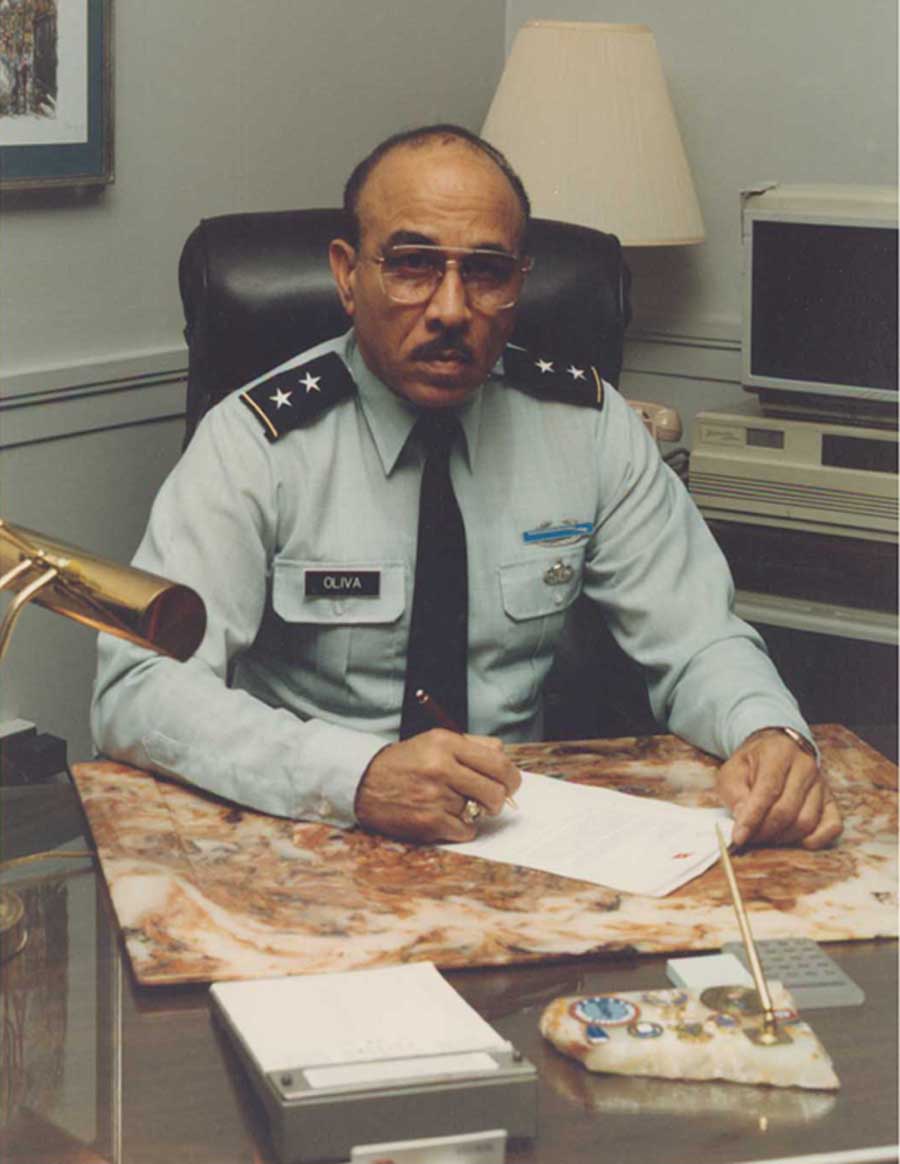
I AS CHAIRMAN OF THE CUBAN AMERICAN MILITARY COUNCIL (CAMCO), strongly believe that the men and women of the Revolutionary Armed Forces (FAR) are the only ones who, at this moment, can help free the Cuban people from that prison that is the island of Cuba. The members of the FARC are not only necessary; they are indispensable in the efforts being initiated now to accelerate the process of democratization. They have the weapons, organization and capabilities necessary to stop the consolidation of Raul's power given to him by his brother Fidel. Only the FARC, fulfilling its institutional responsibilities, can save the Cuban people, and themselves, from further oppression, misery and human rights violations.
I hope that the military is not afraid of a democratic transition or of future participation by the exile community. Neither the FAR, nor the Cuban people, should fear that exiles will take from them any property or social benefits they may have attained. On the contrary, they will bring new technology, financial assistance to reconstruct the cities, towns and the country's infrastructure, and most of all, make a reality the reunification of the Cuban family. Again, these changes should not result in harming FAR members, their families or their military institutions. In a democratic Cuba, they all will be respected and will undoubtedly provided with better opportunities and a brighter future.
I am convinced that the vast majority of the Cuban people dream of being free, but with the exception of a few courageous dissidents and political prisoners, they are doing absolutely nothing to make their dreams become reality. I sincerely hope that now that the Cuban people have the opportunity to take a closer look at their aging dictator's physical condition, they realize that the inevitable time of liberation is coming fast and that they, with the military, must do their best to accelerate the democratic process.
Erneido A. Oliva
Major Gen. (DCNG-Ret.)
Former Second-in-Command of the Assault Brigade 2506
CAMCO Chairman
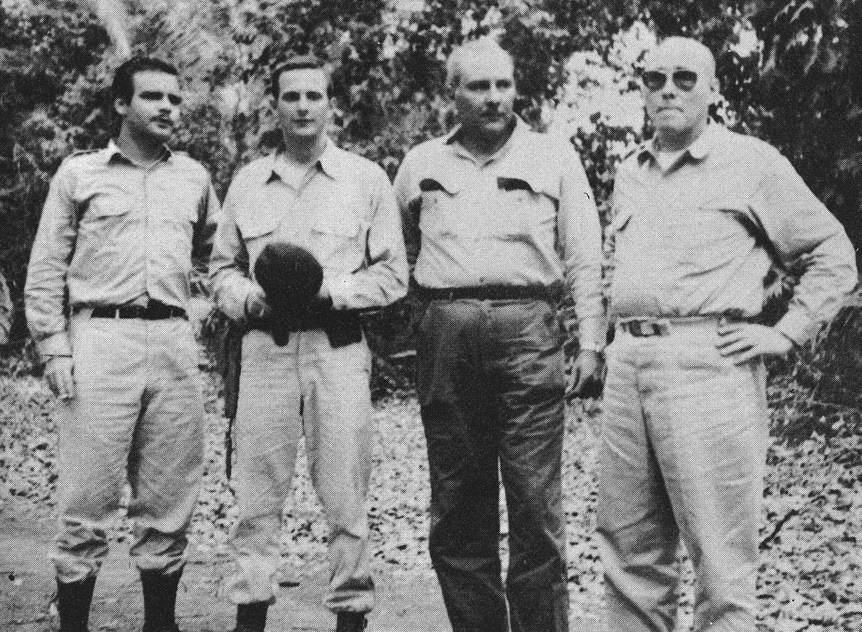
The book includes signatures of the Brigade civilian leader Dr. Manuel Artime (Left), Brigade Commander Jose Perez-San (Second from Left), Second-in-Command Erneido Oliva and other heroes of the Assault Brigade 2506
ERNEIDO OLIVA'S WATERCOLOR; A VIVID REMEMBRANCE OF THE PRISON (By R. A. Zaldivar, Herald Staff Writer)
The CIA recruited them in Miami, trained them in Guatemala and flung them " 1,400 Cuban exiles " on a mission to topple a government that had 100,000 men under arms.
They landed at the Bay of Pigs on a strip of beach bordering a vast, desert swamp in south-central Cuba.
The battle was over in three days. The United States suffered its first major foreign-policy defeat of the post-World War II era. Fidel Castro scored a victory he trumpets to this day.
In Miami, the failure of the invasion marked a turning point. The city that had sheltered the first wave of Cuban exiles " the spiritual home of the invasion " became the permanent exile "capital."
For the 1,400 exiles who called themselves Assault Brigade 2506, the Bay of Pigs is a bittersweet memory. The battle is the proudest moment of many a veteran's life " but, unfortunately, history recorded the defeat.
Erneido Oliva, then 28, a wiry artillery officer eager to prove himself, was second-in-command of the pre-dawn invasion on April 17, 1961.
"Most in the Brigade were muchachos with no experience at making war" says Oliva. But the men fought valiantly. "They left me cold" Oliva says.
The permanence of the regime and its incursions throughout the world have proved a bitter pill for the CIA planners of the Bay of Pigs.
For Oliva, the bitterness stayed behind.
The only keepsake from those days is a yellowed watercolor, torn at the edges and creased where he folded the rough paper so his wife, Graciela, could smuggle it from the visiting room of a Cuban prison (El Castillo del Príncipe).
During the dreary months of solitary confinement, Oliva worked on his watercolor.
On the still manila paper, he painted the cracked gray plaster of his cell wall. A brightly colored Cuban flag rests against the wall. An open book filled with signatures of men who fought with him sits on a simple wooden table. In front of the book lie a crucifix and a crumpled camouflage cap with the number "2506"
"We fought for our flag and for GOD," Oliva says.
Some of the men who signed the book in the watercolor died on the battlefields of Vietnam. Others are scattered throughout the United States and South America.
The watercolor now hangs in the study of Oliva's residence in a quiet Maryland suburb.
But the Bay of Pigs experience is never far from his mind.
The debacle was a lesson, "like a page in my book," Oliva says. The Bay of Pigs taught him his limits, the limits of men in combat and the limitations of American power.
On the last day of the fighting, a brigade tank was hit by a shell and caught fire, threatening to explode in the midst of Oliva's position.
"I yelled for a volunteer to drive the Sherman tank off," Oliva recalls. Jorge Alvarez, a tank driver nicknamed "Little Egg," climbed into the burning tank, managed to start it and quickly drove off.î
"We thought that would be the last time we would see him alive," Oliva says.
But "Little Egg" returned.
His face bleeding, his clothes in tatters, he militarily saluted Oliva and asked to resume his position. Before he moved to his position, "I promoted him to captain on the spot," Oliva says. "I knew we were losing. You don°t promote people when you are losing, but I promoted him anyway."
Kennedy told the Brigade leaders (Manuel Artime, José Pérez San and Oliva) that a Russian threat to Berlin had kept him from committing American firepower to the invasion.
Oliva accepted Kennedy's explanation. Other didn't.
"They thought once we were all prisoners Castro would have us shot," one veteran says. "Remember the Alamo" "Remember the Maine" "It would have been the perfect excuse to invade Cuba with American troops."
But Oliva refuses to call it a betrayal. "I felt frustrated, I felt abandoned by my allies, but I never felt betrayed. I was a Cuban fighting for my motherland," he says. "There was no time for that."
"We haven't reached the moment where the national interest of this country coincides with that of the exiles who want to go back," Oliva adds. "But it seems we're getting closer."
That is his hope now. Like the watercolor, that hope hasn't faded.
In a corner of that painting, there is a small barred window. Outside looms the fortress wall. Above the wall, a flock of black birds rises in a "V" formation against a fierce blue sky.
Oliva is now a retired major general of the National Guard of the District of Columbia (Washington, D.C.).
CUBAN ARMY SEEN AS KEY TO OUSTER OF CASTRO BAY OF PIGS VETERAN SPEAKS UP
DON BOHNING
GEN. ERNEIDO OLIVA, now retired, was second in command at the Bay of Pigs. The issue of what to do with the Brigade members, had the invasion been called off at the eleventh hour, was `more than a problem. It was a big problem,' he says.
Thirty nine years later, Erneido Oliva, deputy military commander and hero of the ill-fated Bay of Pigs invasion, sees only a single solution for ridding Cuba of Fidel Castro: a military one.
Oliva is the highest-ranking survivor of the April 17, 1961, Bay of Pigs assault, one of the true milestone events of the Cold War. Nearly four decades later, Oliva spoke with The Herald in his first extensive interview on the invasion and its aftermath, saying that the solution to the Cuba problem lies not in another exile army, but in ``the Cuban armed forces reaching the conclusion that Castro does not offer anything to the Cuba of the future. . . .
I don't want to put down the dissidents. I think it's great to have political factions in Cuba, but that will not get rid of Castro. The solution will come from the Cuban Revolutionary Armed Forces.''
Among the observations and revelations he made in the interview, some for the first time:
The issue of what to do with the Brigade members, had the invasion been called off at the eleventh hour, was ``more than a problem. It was a big problem.''
The most overlooked historical aspect of the invasion is how the Brigade members - mostly young and inexperienced - performed with mountains of motivation but only limited training.
He concurs with invasion planners that the invasion failed because of the cancellation of air support and the last-minute change in landing site from the city of Trinidad to the isolated Bay of Pigs area, because the Kennedy administration thought it would be easier to conceal U.S. involvement.
He blames the administration of President John F. Kennedy for the failure of the Bay of Pigs, but says he has never felt betrayed, ``only profoundly disappointed with an ally.''
He still considers Kennedy the only president - excluding Eisenhower - who did more than talk about getting rid of Castro by supporting post-Bay of Pigs clandestine operations against Cuba. They included one directly under the late Bobby Kennedy, President Kennedy's brother and attorney general, in which he was involved. The operations were terminated by President Johnson.
After the invasion, Oliva went on to become a major general in the U.S. Army Reserves and deputy commanding officer of the Washington, D.C., National Guard before retiring Jan. 1, 1993. Since his retirement, the 67-year-old former general has remained active in the anti-Castro effort, maintaining his residence in Maryland and largely steering clear of exile politics.
In 1997, he formed the Cuban-American Military Council (CAMCO) to encourage what he sees as the Castro solution: the Cuban Revolutionary Armed forces.
Numbering more than 1,000, CAMCO is open to any Cuban military veteran, whether it be Assault Brigade 2506, the U.S. Army or the Cuban army under Batista or Castro. Oliva has been a member of all four.
CAMCO's focus, with limited private resources, is to reach out through various means to Castro's military and ``convince them we can work together,'' that they have a role in Cuba's future.
We have said we no longer want to be fighting you, invading you and killing you. There is no war in our repertoire. It's only love and friendship,'' says Oliva.
When the time comes, I am sure that they [Cuban armed forces] will not point their weapons against the Cuban people. And that time will come . . . when Castro dies a natural death or is gone, the only ones who can really control Cuba and have a peaceful transition are the Cuban armed forces.''
The major problem, says Oliva, is overcoming their fear of what will happen to the Cuban armed forces once Castro is gone and the exiles return.
Looking at the future, they are still not sure the exiles will protect them or will provide them with the security that they need and that's exactly my message to them. . . .''
As for Assault Brigade 2506 and the invasion, some of Oliva's most revealing comments came in regard to the so-called ``disposal problem'' had there been a last-minute decision to call off the invasion.
It has long been speculated that one reason Kennedy did not call off the invasion was concern over a rebellion by Brigade members in their Guatemala training camps. Oliva confirms that there was reason for concern.
I was gung ho at that time, a guy who really was there in the training, pushing everyone, training young officers, ready to fight,'' recalls Oliva, then age 28 and one of the few professional soldiers in the camps.
If the American advisors had told them to turn in their weapons - that they were going back to the United States instead of Cuba - says Oliva, ``I would have called them some bad words and said we are not going anywhere. We are going to fight whoever is in our way. I knew that we could not go to Cuba from there because I didn't have the means to transport our troops.
But the problem that we would have created in Guatemala would have been so great, Cubans fighting the Guatemalan army, taking over Guatemala . . . I can tell you, the men that I had under my command at the time would have done anything that I told them to.
This is something that nobody has ever written about . . . the Americans were the advisers and they were 15, maybe 20. That would not stop us, because we were the guys with the weapons . . . We have esprit de corps . . . We want to fight the communists, whether we fought in Guatemala or wherever.
I am telling you that the disposal problem was more than a problem. It was a BIG problem. I think Kennedy made the right decision to say, hey, let them go to Cuba instead of bringing them back to Miami.''
So the Brigade sailed for Cuba on April 17 and its disastrous ending - recounted many times - came two days later, with 114 Brigade members killed and nearly all the rest captured, Oliva among them.
Oliva and the other captured Brigade members returned to a tumultuous December 1962 welcome in Miami's Orange Bowl after the Kennedy administration paid a $53 million ransom of food and medicine to Castro for their release ($500,000 in cash was paid for each leader of the Brigade, Artime, San y Oliva).
Overlooked in the retellings of the Bay of Pigs saga, says Oliva, is the performance of the young Brigade members ``who enlisted because they had only one motivation, to see a free Cuba. . . . Ninety-nine percent of those who were there knew that Americans were supporting us. We could not fail.
The Americans never failed before, so we are going to win. I have to risk my life but we are going to win. That was the mentality, motivation of these people. . . . After 39 years, I want for somebody to say, `you Brigadistas did an outstanding job' because they deserve it.''
Oliva blames President Kennedy and his advisors, not the troops on the beach nor the CIA or Pentagon, for the invasion's failure. That was in part because of a last-minute change in the landing site from Trinidad, on the south Cuba coast near the Escambray mountains, to isolated Playa Giron on the Bay of Pigs, about 80 miles to the west. There, it was felt, it would be easier to conceal U.S. involvement.
The Trinidad site was 400 percent better,'' says Oliva. ``We have a big air strip. . . . We have a huge bay. We have a population that could have joined us. We were close to the Escambray mountains . . . so there you have a source of reinforcement . . . from the population, from the guerrillas that were at that time in the Escambray.
But they [the Kennedy administration] considered that it was too spectacular; that it would show the involvement of the United States and that's something that they wanted always to hide,'' says Oliva.
It was naive to try and hide something like that. How could the Cubans ever have been able to mount that type of operation? I don't know what those people were thinking at the time. It was more than naive. It was stupid to think that you can hide the hands of the Americans in something like. . . .''
Still, while he blames the Kennedy administration for the invasion's failure, Oliva refuses to say the invaders were betrayed.
I was profoundly disappointed in an ally who organized and trained the Brigade but did not fulfill its moral obligations when it felt that its role was discovered and its national interests at risk,'' says Oliva.
But even in the “darkness of my isolated cells, I never felt betrayed,'' insists Oliva. ``Rather, I felt proud of my accomplishment fighting for a just cause. . . . I was not fighting for American interests. I was a Cuban citizen fighting for my native country.''
Oliva still speaks well of Kennedy, compared to other U.S. presidents.
The others made a lot of promises during their respective political campaigns while running for the presidency, but did nothing when they attained it,'' says Oliva.
Kennedy - whether motivated by guilt or revenge - quickly instituted two clandestine anti-Castro operations after the Bay of Pigs. One, after the prisoners returned, was directed by his brother, Bobby, also the attorney general, and involved Oliva and the late Manuel Artime, civilian commander of the Bay of Pigs Brigade. The other was the earlier and better known Operation Mongoose, run by the CIA from Miami.
Within less than a month after their December 1962 return from Cuban prisons, says Oliva, he and Artime met privately with Bobby Kennedy at Kennedy's Hickory Hill estate in Virginia.
The meeting was the genesis for Artime's $6-million program of paramilitary operations against Cuba from Nicaragua and Costa Rica. Oliva was, until the end of the program, in charge of the military side from the United States, serving as liaison with then Secretary of the Army Cyrus Vance and his aide, Alexander Haig.
It was also agreed at the Hickory Hill meeting, said Oliva, to constitute a Cuban unit within the U.S. Army, bringing together all those Cuban-born soldiers, then numbering several thousand, that would eventually work in collaboration with the Artime forces to “facilitate the liberation of Cuba.''
Oliva says, however, that no new invasion of Cuba was discussed at that time.
The entire program ended a year later, after Kennedy's November 1963 assassination.
Oliva, then undergoing artillery training at Fort Sill, Okla., received a call from Bobby Kennedy in January 1964, asking him to come to Washington. He did. He met Kennedy at the White House. There he told Oliva that he had bad news about the Pentagon program for training Cubans in the U.S. armed forces.
A few minutes later we went to the library, not the Oval Office, and Johnson came in and flatly told me my program with the Cubans had to be terminated. Bobby didn't say anything,'' remembers Oliva.
He told me before that he had tried to persuade him . . . he didn't want to try and persuade the president in front of me. So he was only listening, his head bowed. Pretty sad. That was a 15-minute meeting.''
ERNEIDO A. OLIVA
Born in Aguacate, Cuba. Lives with wife, Graciela Ana Portela Avila, in Fort Washington, Md. They have two grown children; their daughter, a well-known physician, and their son, an aerospace engineer.
Cuban resistance: 1960 - Leaves Cuba to become deputy commander of Assault Brigade 2506, the 1961 Bay of Pigs Invasion. Captured after the military operation. Released in December 1962, with the other members of the brigade, after the U.S. government paid a ransom of $ 500,000 for him.
Professional: 1954 - Commissioned 2nd Lt. in the Cuban Army after graduating from the Military Academy. 1955-58 - Militay Academy artillery instructor. 1956- Promoted to 1st. Lt.. 1958-59 - Student and instructor at the U.S. Army Caribbean School in Panama. 1963 - Commissioned in U.S. Army and appointed by Pres. John F. Kennedy to represent all Cuban-American personnel in U.S. armed forces. 1984 - Promoted to brigadier general, USAR. 1987 - Appointed by Pres. Ronald Reagan as the Deputy Commanding General of Washington, D.C., National Guard. 1992 - Promoted to major general of the DCNG.1993- Retired.
1997 - Created the Cuban-American Military Council (CAMCO). 2002- Appointed by Pres. George W. Bush to serve for 3 years as Member of the Board of Governors of the USO.
On this Forty-sixth Anniversary of the Bay of Pigs Invasion, I would like to share with our readers a couple of unusual untold stories of the Assault Brigade 2506 that landed at the Bay of Pigs on April 17, 1961..
Of course, Brigade members could retell numerous stories of events, some funny others sad, that occurred before, during and after the Bay of Pigs invasion. Those anecdotes, for sure, would show the dedication, courage, patriotism and unselfishness of the men who landed on Cuban beaches to bring democracy and respect for human rights to their countrymen. The brigadistas came from different backgrounds and ways of life. They were white, mulattoe and black; poor, middle class and wealthy; educated and uneducated; professionals and laborers; young and old, in summary, a cross-section of Cuban society. Each freedom fighter had his own long road filled with frustrations, suffering and sacrifices that led him from his local environment in Cuba or Miami to tough training, combat and imprisonment. But in spite of their differences, all of the members of the Brigade had at the time of the invasion the same aspirations: to bring freedom and democracy to their native land.
As in many real life stories, the Bay of Pigs invasion had both sad and happy moments. The sad moments of the story were when we realized that we had not been able to overthrow a communist tyrant and, instead, facilitated his consolidation; to learn that 114 of our comrades in arms had been killed in action or at the hands of the dictator's henchmen; and that eight honorable freedom fighters still remained in Cuban communist prisons. The happy moment came about on December 22, 1962, when the great majority of us were freed after twenty-two months of imprisonment and were finally reunited with our loved ones at Homestead Air Force Base in Florida. We were also very happy when we learned that we would have the opportunity to continue our struggle for the liberation of Cuba.
As we commemorate yet another anniversary in exile this week, I decided to insert on this CAMCO website some excerpts from my unpublished memoirs. It is my hope that in these somewhat humorous and sad stories of the "Cattle Tick Base," "The Hanged Man," and "The last desperate hours at Giron Beach," CAMCO's readers catch a glimpse of how loyalty, comradery and motivation to succeed could be developed under grueling circumstances.
CHAPTER VII "THE ASSAULT BRIGADE 2506"
42. MOVEMENT TO A NEW TRAINING SITE
As the Brigade's Armored Battalion (Bon-Blin) commander, I was busy all the time. Every day we began our training very early. Before breakfast, I held daily meetings with my Executive officer, Valentín A. Vacallao Fonte, and with José Miguel Batlle Vargas, First Company; Luis O. Rodriguez Martinez, Second Company; Angel R. Mujica Herrera, Third Company; Luis E. Martínez Castro, Heavy Weapons; and their executive officers. Most of the mornings were used for company level training but during the afternoon, I always had the whole battalion performing training under my direct command. The entire battalion was assembled for every activity before the companies were instructed to go to a particular area or classroom. I wanted to ensure that every member of my battalion knew each other and also the respective commanders of the other Brigade's units. In a couple of weeks I was able to have a very cohesive command structure in which every member was well informed of what he was expected to do. The training, provided by the American advisors, our headquarters staff or myself, was conducted as professionally as in any other regular conventional army structure. In my battalion, military discipline and courtesy was no only expected but enforced. The brigadistas who occupied officer positions fully exercised their authority throughout the chain of command.
Base Trax was getting crowded with daily new arrivals, therefore, late in January, Alejandro del Valle, the young and charismatic commander of the Brigade First Battalion of Paratroopers, our elite unit, was instructed by Frank, the American base commander, to move his unit to La Suiza Farm, a training site near the Guatemalan town of San José de Buenavista, approximately 25 miles from Base Trax, where our headquarters was located. The advisors had already selected areas that could be used as drop zones by our paratroopers. A few days later, Frank called me at his quarters and pointing to a big Guatemalan map hanging on one of the walls, he showed me the new training site selected for the Bon-Blin. My new site was located about half a mile from the paratrooper's area.
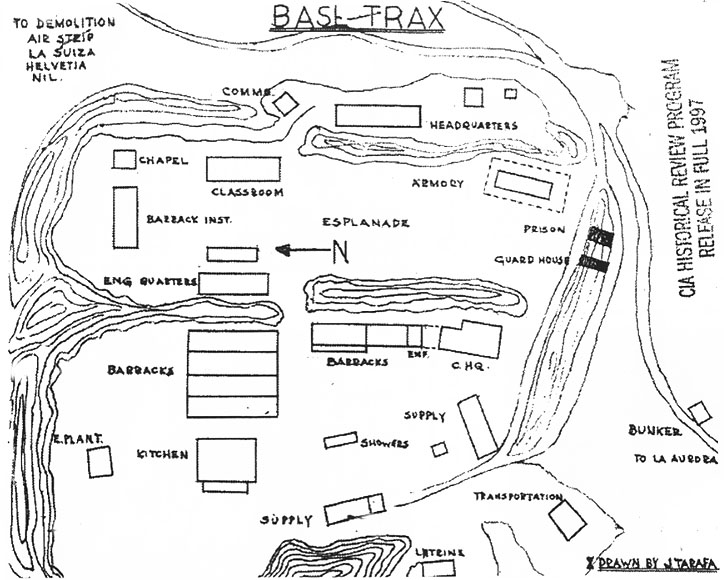
Since the brigade was organized, the Bon-Blin had been conducting solely infantry training. However, the battalion had been organized to fill up two motorized companies, a heavy weapons company and a tank company that, in the future, would have assigned five medium U.S.-made M-41 tanks with a high velocity 76 mm gun. Each tank would have a four-man crew. Of course, we did not have any heavy equipment at Trax, but I was assured by Frank that, once the battalion had landed in Cuba, it would be provided with all motorized equipment and tanks established on our table of organization and equipment (TOE). In one of our meetings, classified as "SECRET," Frank told me and the Brigade commander, Jose (Pepe) Pérez San , that some of the Bon-Blin infantry personnel would be fully transported throughout the future area of operations in heavy armored trucks equipped with .50 caliber machine guns. Reviewing the personnel records, Pepe and I had selected from my battalion the tank commander and crew. According to the plans discussed, they would depart shortly to receive armored training in military bases in the United States...
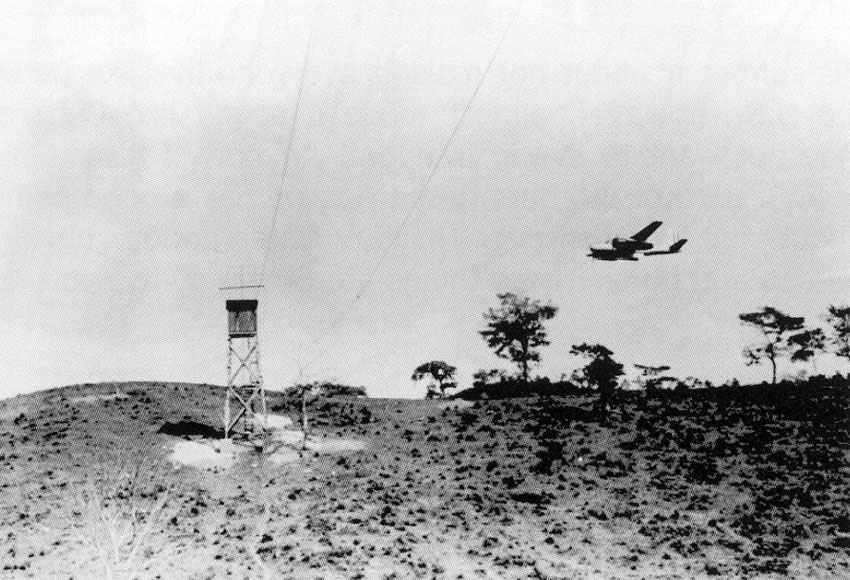
"THE CATTLE TICK BASE" -- "Garrapatenango"
The tropical vegetation we found at the new training site, near San José, was full of poisonous snakes, some resembling cobras and one very dangerous which the Indians called "yellow whiskers." At night, before "hitting the sack," the brigadistas had to violently shake out their sleeping bags, blankets and pillows to ensure that they did not contain snakes, reptiles, or any other unwelcome "visitors." In the mornings, we could not put our boots on without carefully checking them since during the night, large black tarantulas and scorpions used to hide inside, looking for a "warm home."
As it ended up, mite-like cattle ticks became our major problem at this training camp. A few yards from the new training field ran a long and narrow stream with warm blue waters that looked very peaceful, beautiful and extremely clean, at least that was what our eyes saw. It is a nice place to meditate, I thought.
At the end of the first day at the new base, after ten hours of machete work some members of my battalion asked their company commanders authorization to jump into the stream to swim and, at the same time, get a obviously necessary bath. When I received the request, I thought it was a good idea to give the exhausted men some type of recreation and decided that not only a few, but the whole battalion should take a deep in the beautiful river.
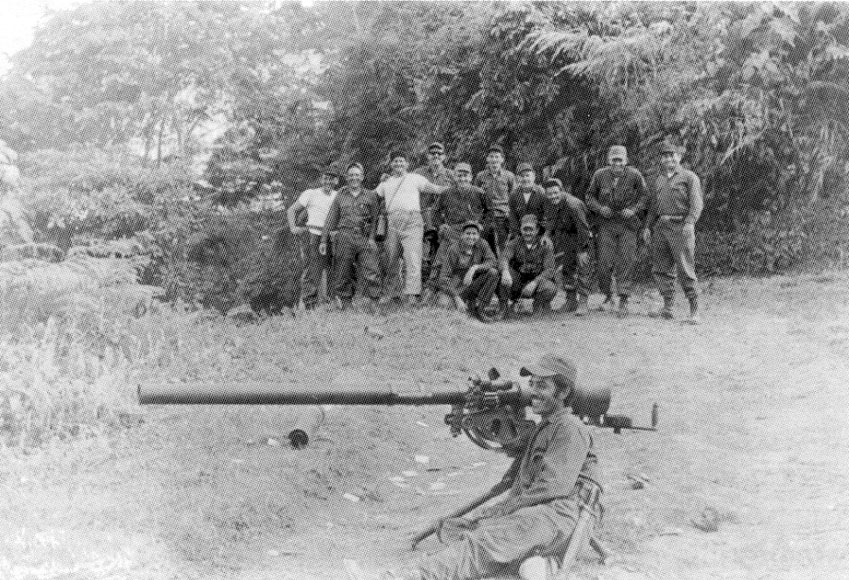
2506 had good camouflage uniforms
I had the battalion assembled and directed each company commander to take his unit to the blue and clean waters. When the units arrived at the river bank, each commander dismissed his troops and most of the brigadistas, some even still wearing their uniforms, jumped happily into the waters. Most of the men, who had carefully placed on the bank their soaps, towels and some clean uniforms, began swimming, bathing or playing with each other in the water. Suddenly, the screaming of Antonio Curbelo, my S-1 (battalion personnel staff officer) who was seated on top of a huge rock under a giant tree after finishing his bath, made me come out from the water faster that I had gone in.
When several brigadistas and I reached the officer, he showed us his body full of cattle ticks. Soon I realized that my body was also partially full of ticks. We started calling the troops that were still swimming, to come out from the river. It took us almost two days and nights to get rid of those blood-sucking creatures from our bodies. In order to pull the insects' remains off from our skin, we had to use heat. In my case, I used several of my big Cuban cigars to "evict" those parasites from their "new homes." We were told by one of the few "guajiros" (Cuban countryman) that I had in my battalion, that if the tick heads stayed inside our body, the wound produced by it would be infected. Their words immediately created a well-founded panic among the bon-blin's tough fighters.
When, the following day, with the expert assistance of Martín Loriga Sanchez, one of the brigade physicians who luckily was at that time inspecting the sanitary conditions of the camp, I finished the tedious and painful work of getting rid of the ugly ticks, my entire body was full of cigar burn marks. Unfortunately, my small supply of delicious Havanos from Miami was also gone. Our experiences with the cattle ticks led to our new base being officially named by the brigadistas "Garrapatenango" or "Cattle Tick Base" ...
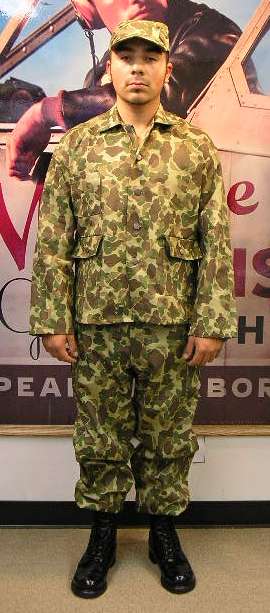
2506 Leaders examine packaged supplies
In the Bon-Blin, I had selected most of the company commanders, platoon and squad leaders from the ranks of the professional Soldiers although some were former police officers, as Batlle and Mujica, who had some military training and discipline. However, a couple of civilians who had learned fast and showed leadership potentials, as Curbelo, were also given battalion staff positions. My philosophy was that we were going to battle, not to a parade field, therefore, above all the leaders of my battalion needed to be trained and disciplined soldiers. Even the young students and civilian professionals who had not been selected for positions of responsibility in the Bon-Blin, had agreed with my concept. They had expressed their desire to be trained and led by men who could be trusted when D-Day arrived...
During those days at Garrapatenango, I often remembered the words written by General George Patton: "To be a good soldier a man must have discipline, self-respect, pride in his unit and his country, a high sense of duty, and obligation to his comrades and his superior, and self-confidence born of demonstrated ability." To me, all members of the Bon-Blin truly possessed these qualities...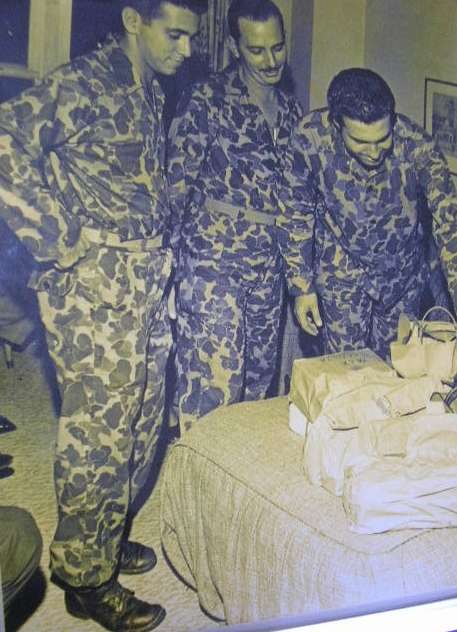
"THE HANGED MAN"
The only incident that came close to creating a big rebellion in my Bon-Blin happened during a February weekend. Frank had been very impressed by the high accuracy attained by my battalion units in a firing qualification. He wanted me to recognize the members of my Bon-command for their efforts and he informed me that he would be given several pigs and cases of beer to celebrate our exceptional training achievement.
I was very, very proud of the results of the firing training because most of the members of my battalion, most of them young men without any prior military experience, had qualified as experts firing with pistols, M-1 Garands, carbines and machine-guns. The numbers of experts were higher than of any other battalion in the brigade (including the Paratropers).
2506 Soldiers in training with Johnson LMGs
Following Frank's instructions, I authorized a big cook-out. Beer had been "officially" authorized only once since the training began the previous year. During the 1960 Christmas Eve night we had a very good Cuban-style dinner -- of course it was an excellent meal because it was cooked by Cubans, not by the CIA American cooks assigned to the brigade. That experience, however, did not end pleasantly because at midnight I had a heck of a problem trying to confiscate a few pistols from those who were so happy, and drunk, that they created a shooting gallery close to the cliffs over the Nilo River. Their aims were so erratic that the following morning, I saw the roofs of some of our barracks filled with bullet holes.
In the early morning of the authorized party at Garrapatenango, every company was assigned a small picnic area, with rustic benches made by our "engineers," where the unit "chefs" could dig the holes for the drills. Each unit commander received three 100-pound pigs. Some of our "tougher" Soldiers killed the huge pigs with knives to demonstrate how efficient they were in hand-to-hand combat. One even tried unsuccessfully to suffocate a pig with his bare hands. After a few tries, the frustrated brigadista, observing the sarcastic looks of his buddies, pulled his .45 pistol and shot the animal in the head. Every one started laughing. Others used their carbines to consummate the ritual.
By three o'clock that afternoon, I was sitting on the grass in front of my command post, drinking a cold beer and tasting a piece of a Cuban-style roasted pig, when, unexpectedly, the peaceful atmosphere and my serene thoughs were disrupted. Looking very upset a young, shouting brigadista, came running toward me. After taking a deep breath, he told me that one of the new recruits had hanged himself from a tall tree.
I immediately asked a staff officer who was standing near my tent enjoying a cold Guatemalan to bring some ropes and machetes. We all rushed to the location of the unfortunate incident. There, hanging from a huge old oak tree was a brigadista. He was so high, between the branches at the top of that two-hundred-year tree, that no one around me could identify him from the ground. Pedro Gonzalez, my aggressive, loyal and resourceful personal assistant, who was always prepared for any emergency, brought out a pair of binoculars but he was not able to identify the dead man. "His face is not familiar to me, sir," he said.
Since we could not recognize the hanged man, I began wondering how in the heck the brigadista who first saw him knew that he was a new recruit from my battalion. He could have been anyone, even a poor desperate Indian worker. Nevertheless, I thought, that man had gone through a lot of trouble to hang himself. It was very difficult to reach the location of his demise in that old gigantic tree. "He was really crazy, I thought. If he wanted to die, he should have shot himself down here, or selected a smaller tree," one of the dozens on-lookers, who had already drank a few beers, said jokingly.
In a few minutes, the word reached the other picnic areas and dozens of brigadistas came rushing to the site where I was standing. Even some of our security guards had left their posts and joined us to witness the heartbreaking happening. We all momentarily forgot about our well-deserved time-off, the cold beers, the yucas, black beans and the roasting pigs. The glee shown by my men only moments before had been overcome by despondency. How terrible, one of our compatriots had committed suicide! and we were not able to stop him, Pedro said. Some brigadistas recalled that we had three recruits who were killed in accidents before but none had committed suicide yet.
I instructed two of my best-trained Soldiers, famous for their palm tree climbing abilities, to bring the man down. Three of my medics were already there on site with their first-aid equipment, ready to apply CPR if it was needed. It took the two "tree climbing experts" ten long minutes to reach the hanged man. When they touch him, the man who until that point was considered dead with his head falling on his right shoulder, his mouth slightly open and half of his tongue hanging outside, suddenly revived. He began laughing, trying jokingly to evade the two men already at his side. I should have known better, he was a member of the First Battalion of Paratroopers that was conducting a scout exercise nearby.
The two rescuers, like the rest of us, didn't like the joke and wanted to throw the Paratrooper down from the top of the tree. But, they, reluctantly, followed my instructions and brought the joker down in one piece. Once on the ground, with the rope still hanging from the back of his neck, the culprit was brought before me. He refused to tell me the reason behind the fake hanging. But did tell me how it had been done. Early in the morning, three Paratroopers of his team that were involved in the practical joke had climbed with him the huge tree. They selected a strong branch and tied him with a heavy rope at his waist that had been pulled it up under his shirt. "It is not funny," one of my men angrily shouted. "I'm sure there is something rotten about this," another cried. However, once the prank was uncovered, most of my men, very happy to know that we had not have to change the picnic for a wake, quickly ran to their respective picnic areas. Some were laughing about the incident, others cursing at the Paratrooper for wasting their "precious" time. Most were amazed by that Paratrooper's "immaturity."
On further "tough interrogation" by my intelligence officers inside the battalion headquarters tent, the joker repeatedly said that neither he nor his accomplices had received any instruction from Alejandro, his tough battalion commander. The paratrooper then started accusing the Bon-Blin intelligence officer of retaining him against his will (he had provided only his name, rank and serial number because he considered himself a "prisoner of war").
My patience was really wearing thin with our "prisoner" when suddenly about fifty men came running toward my CP (command post). One of them cursing and screaming loudly said he was glad to see that SOB was still in our hands, in the battalion area, because he wanted to kill him. Holding a Garand rifle in his right hand and looking very upset and hostile, the brigadista told me that two of his company's three pigs had disappeared from the grills while they had gone to help the "hanged man." They demanded that the "prisoner" be immediately handed over to them to be "thoroughly interrogated, and tortured if necessary," until he had confessed who had taken the animals and where they had been hidden. Of course, I did not let them take the paratrooper away because I was really afraid that those very agitated guys could badly hurt the young man.
I fully realized that the Bon-Blin men felt very disappointed and were not joking--they wanted their three pigs back or blood was going to be spilled. The well-trained and aggressive "prisoner," remained very relaxed throughout the entire ruckus episode and calmly and "respectfully" asked me for a cigarette. I offered him one of my big Cuban cigars but he said "No, Sir, thank your famous cigars are too strong for me."
My loyal and disciplined men clearly disapproved my benevolence toward the "captured enemy." Everyone in the camps was aware that the Paratroopers were well known for stealing whatever they could put their hands on: food, ammunition, weapons, blankets, sleeping bags, anything. My company commanders had always instructed the outpost security guards to watch carefully for Paratroopers' infiltrations through their units' perimeters. The aggressiveness of Alejandro's youngsters was viewed by all of us, throughout the chain-of-command (including our advisors), as an integral part of their learning experience to survive in a hostile environment. They had been taught to be very tough, to do whatever it was necessary to stay alive in order to accomplish their assigned missions. All of us were actually quite proud of Alejandro's Paratroopers.
A few minutes after learning of the unacceptable prank, I immediately called my counterpart through the field "private hot line" telephone that we had installed in each of our headquarters tent to keep ourselves informed of whatever happened in our respective area of operation.
At my request, Alejandro promptly came to my battalion headquarters tent with a bright smile. However, this time, I did not receive him with the same enthusiasm I had always welcomed him. After twenty minutes of "unfriendly" talk, we reached an amicable compromise. I would not report the incident to neither to Frank or Pepe, my battalion would not retaliate in any way, shape or form, and his men would return immediately the three pigs with a couple of beer cases. He agreed with my demands. Reluctantly, the "thieves" (fifteen Paratroopers) brought back two full pigs; the other pig had already been "devoured" by the members of the raid team. The two additional beer cases never arrived, the Paratroopers had already consumed their assigned quota.
The Bon-Blin men never forgave the Paratroopers for stealing their food and ruining their well-deserved holiday. From that day on, a fierce rivalry and competition developed between the two battalions, without questions, the best two units of the brigade. I and the battalion American advisers, actually welcomed the competition since it gave the members of my Bon-Blin a new incentive to excel in their preparation for battle.
I used to run at the head of my battalion every evening, at the end of every training day, and always took a route that passed close or inside the Paratroopers' battalion area to give my men the opportunity to yell and curse at their new and "dangerous enemies." Alejandro and his men always responded in kind... 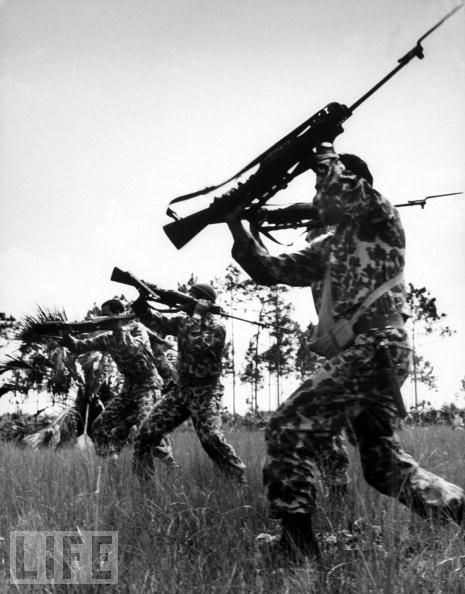
******************
THE FOLLOWING SEGMENTS HAVE BEEN PUBLISHED HERE TO HONOR THE REQUESTS MADE BY MANY CAMCOCUBA READERS.
SINCE THE E-MAIL REQUESTS KEEP COMING, I DECIDED TO PUBLISH THE FOLLOWING UNEDITED SEGMENTS OF MY NOTES.
CHAPTER XII -- THE BATTLE OF 'THE LOST BATTALION'
75. THE END OF THE HEROIC BATTLE AT "LA ROTONDA"
By 4:45 a.m. the long battle that had begun the previous evening was beginning to abate. Fighting continued, but now more subdued, with only sporadic fire being heard coming from our left flank. The Brigade tanks had such a busy night that they all had run out of ammunition in the process of finally repelling the enemy infantry's assaults. One of the tanks attached to my Task Force, commanded by Elio Alemán, came back to my command post to report to me that no ammunition was left. I ordered him to move to a close location where he could use his machine gun against any new infantry assault that might be launched against our North or West flanks. Fifteen minutes later, González Carmenati's tank also came back to my location without a single shell left for his 76 mm cannon. Nevertheless, I sent him to support the company commanded by Pedro Avila with whatever ammunition he had left for his tank machine gun, Ten minutes later, Alvarez "El Huevito" also arrived yelling that his tank gunner had spent his last ammunition a few minutes before after scoring a direct hit on a Stalin tank.
2506 2.36" Bazookas
Without tanks to defend our beachhead, I thought that it would be easy for the enemy to penetrate our positions during the anticipated next attack since we could still hear the rumblings of enemy tanks operating nearby. They were trying to clear or pass over the wreckage formed by their own destroyed tanks and move toward our positions. Three of them, one after the other, in a single column, were able to enter La Rotonda, which was like a traffic circle at the entrance of Playa Larga. However, our men were waiting for them.
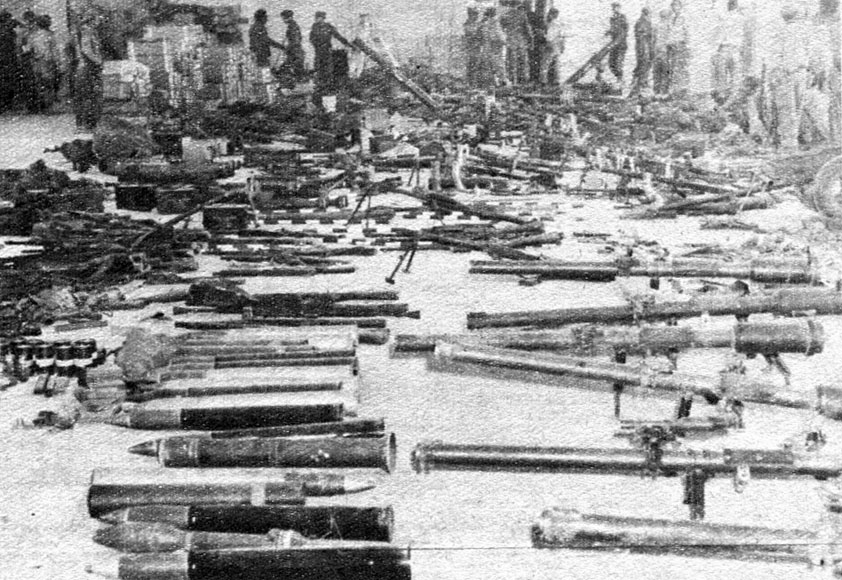
Knocked-out T34/85 Medium Tank
A bazooka man knocked out the first tank that appeared only 100 meters from his position but a second one advanced unable to be detected in the darkness. Máximo Cruz, who had spent the entire time on the front line leading his company, was the first to identify the Russian tank that had sneaked through. He stood up from his foxhole and began firing tracing bullets to mark the outline of the tank so his rocket launchers or 30-caliber machine gunners could locate it, already inside the company's defense positions, and try to knock it out. Beside Cruz was Adalberto Sánchez, a very young man who had left his family and his job as a designer in New York to join the Brigade. He had been working with Cruz as his radio operator. Earlier, Sánchez had been wounded and slightly burned. He had asked Cruz permission to go back to the rear to have his wounds treated. Cruz had replied: There is no rear Adalberto, there is only water at our backs ...we stay here and fight, this is the rear. It was after that brief exchange that Cruz stood up again and began firing frenetically his weapon at the enemy tank. Only a second later, the tank fired back at them and the shell exploded only a few feet from their location. Both Cruz and Sánchez fell to the ground. Cruz was knocked down bleeding profusely from his back and having been severely wounded severely in four different areas of his body. Two brigadistas jumped out from their trenches and helped to carry the unconscious company commander back to the Task Force's first aid station where Dr. René Lamar, the Chief of my medical section, took care of him. Sánchez died immediately as his body was torn apart by the explosion. The enemy tank was finally destroyed by another alert brigadista with a bazooka. The day before, our units had made good use of the unusual high number of bazookas that we were able to bring ashore from the Houston during our hasty landing. The Bon-Blin, with its heavily armored trucks had also brought from Girón additional anti-tanks weapons that had been supplied to the other units of my Task Force.
Around five o'clock, when the sky was beginning to brighten, and dawn spread across the sandy beach, the battlefield became relatively quite. The shapes that in the darkness had assumed unreal forms, turned out to be trees and construction materials. The empty houses where the enemy had found protection against our fire the night before were now clear to our view. For the members of the Second Battalion, the area was already familiar. After they had landed under the assertive command of Hugo Sueiro, they were deployed to different positions of the established beachhead. They had been shown the terrain, their respective fields of fire, and the locations of the other members of my Task Force. However, the Fourth Battalion, the Bon Blin that I had proudly commanded for a few months at Trax and Garrapatenango Bases, now led by Valentín Bacallao, had been sent by Pepe San , the Brigade Commander, to reinforce my forces late the previous evening, just before the night battle. Valentín's battalion had been deployed in complete darkness to the portion of the beach area that I had assigned them. The disoriented brigadistas were instructed by their unit commanders and platoon leaders to dig in and prepare, as well as they could, to defend the swampy area in front of them. They only knew the general direction of the expected enemy attack. Since they had had arrived so late, Valentín had not been able to reconnoiter the dangerous terrain that his troops were supposed to defend. As a result, his men were shooting all night long at whatever seemed to be moving in front of their poorly protected positions.
In the morning, the men from the Bon-Blin looked for the first time to the ground where they had been repelling, without interruption, waves of enemy attacks. Since eleven o'clock the night before, more than 2,000 artillery shells had been fired against our positions. We were very lucky that the inexperienced artillery men of Fidel Castro had not been able to pinpoint our positions. Over a dozen shells had landed inside my area of operations, one very close to my tent in which three brigadistas were wounded and Juan Figueras, a mortar gunner, lost one of his legs. Fortunately, he survived his wounds. The other shells fell short or over our heads into the dark sea. It was difficult for me to understand their failure to conduct an effective "fire-for-effect" on our beachhead, even if they did not have the excellent Cuban maps that the Americans had furnished us. They must have known that terrain like the palm of their hands. Besides, their artillery commander was a recognized expert in the matter. I already knew that the enemy artillery batteries were commanded by "el Gallego" Fernández, my former artillery professor at the Military Academy where later, after he was jailed for conspiring against President Batista, I had been appointed to the same position that he had occupied as a professor.
The battle at Playa Larga had begun in complete darkness and it ended the moment that the first hint of new day swept into the east. More than eight hours of continuous fighting. I was moving all night long with Eric Fernández, my radio operator, and Pedro González, my security escort, often jumping inside the brigadistas' foxholes sharing with them the information that my staff had gathered from the enemy's radio transmission. At the beginning of the combat phase, I had ordered radio silence within the Task Force to avoid possible enemy detection of our communications. All my instructions to Hugo and Valentín were sent by foot messengers. I was not aware at that time of the operational situation at Blue Beach or in any of the areas already occupied by Brigade forces. I had completely lost communication with the Pepe San since the previous evening.
When I was able to clearly see all of our positions, I asked Eric and Pedro to follow me to inspect the defensive perimeter. At that time, only sporadic fire could be heard from different directions. I assumed that a few snipers had been left behind by the enemy main force commander to harass us or facilitate the withdrawal of his troops which were already retreating from Playa Larga at a fairly good clip. I wanted to talk to every man who I had not seen during the night battle, to assure them of my presence in the battlefield, and, at the same time, make my own assessment of the situation.
We had walked for a while when we found ourselves very far from my command post. Suddenly, I heard someone yelling at me by my call sign from a hidden foxhole. "Maceo, Maceo, what are you doing here? This is the most forward position in my sector. There are a few snipers on top of those trees down there." The caller said pointing to several trees about five hundred meters from our positions. The brigadista was a good old friend from the training camps, Juan Montolla, who was there with his weapon ready and alert for whatever was moving in front of him. He was happy to see me and gave me a big bear hug. I was amazed to see the conspicuous coolness, and energy showed by that man and the other members I had seen of the two battalions under my command. Not many weeks before, those men had been laborers, college students, businessmen, or office workers, but there, at Playa Larga, they had fought as courageously as any professional soldier could have done under the circumstances.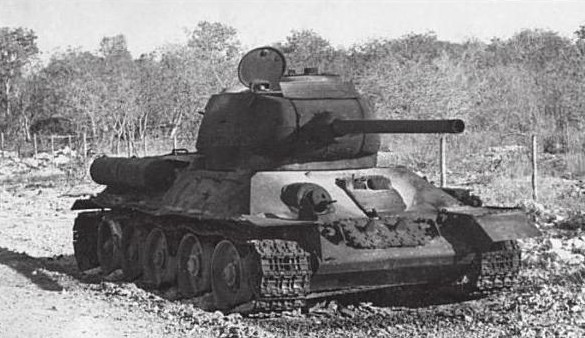
When I arrived at La Rotonda, I called Hugo, advised him of my location, and asked him to join me as soon as possible. I looked at my wristwatch, it was 5:30 a.m. Throughout my inspection, I had seen the brigadistas scattered in different directions, seated or lying on the curves or around the circle at La Rotonda, taking a well-deserved break from the previous tough combat. They seemed to be in a very bad physical shape, tired, hungry but with their morale very high. Many asked me when the new supply of ammunition would arrive and showed me the few ammo cases they had inside their improvised foxholes. However, the great majority showed concerned about the unconfirmed news of friends who had been killed or wounded. Many asked what had happened to their brave commander, Máximo Cruz. On my way back to my command post, I found several men dead inside their trenches, others wounded and bleeding without the required medical assistance, the rest simply terribly tired. Our fighters had no water, no food, and no ammunition; most were down to their last pistol rounds. It was a desperate situation very difficult to describe; worst than I really thought when I began my inspection. Then Hugo arrived. He informed me that he had received a message from Oscar Acevedo who commanded the company protecting our Western front. He said that his company commander had reported that he could not resist another enemy attack because he was lacking ammunition and his men were mentally and physically exhausted. Hugo instructed him to pull back his company inside the Task Force command area of operations, closer to his CP located near the Tourist Center.
After I finished my quick assessment of the situation, I asked Hugo to walk with me to my command post which was located in an unprotected site, under a few small trees that Juan Santamarina had found south of the highway leading to Blue Beach (Playa Girón). There, the experienced Juan had positioned our radios and heavy equipment. With his staff officers, he had been working continuously since the landing, only 24 hours before but what seemed now to be an eternity. Juan and his staff, still inside the command post area, had also been involved in the fighting. Without question, every brigadistas at Red Beach, including myself, had fired their assigned weapons many times during the previous night.
76. TUESDAY MORNING OPERATIONS
While walking with Hugo, we discussed the enemy's strength, capabilities and possible future scenarios, checking notes, without any immediate pressure for the first time after that long, long day and night. Suddenly, the peaceful atmosphere was broken. Hearing yelling and cursing behind our backs we turned around to see six members of Hugos's Second Battalion running toward our location without their assigned weapons. After fighting valiantly and with extreme heroism against a numerically superior army, those men had finally lost their nerve. They had abruptly abandoned their positions at La Rotonda, screaming that a Stalin tank had penetrated their forward positions and that it was coming behind them at high speed. The men looked desperate and fearful. I thought they had not recognized us because they ran towards the rear past Hugo and me without even a passing glance. We began cursing and yelling at them, ordering to return to their positions. But our commands were ignored. Honestly, I could not blame those men for their actions; after all that they had gone through during their first combat exposure of the last eleven hours, any human being would have reacted in similar fashion. None of them had ever killed a man or themselves had felt the threat of death, I thought.
Without thinking twice, I grabbed a 57mm recoilless rifle that was on the ground in front of my command post and Hugo, without any hesitation or comment, picked up one of the shells that was resting close to where the recoilless rifle was and joined me. We both ran side by side to the middle of the highway to confront the Stalin tank that now appeared at the curve. When I was in a kneeling position facing the direction from where the tank was coming, Hugo tapped my head to let me know that the weapon was loaded. I aimed the rifle at the tank, which was then only about fifty yards from our position. As I was about to pull the trigger at the giant armored vehicle with its long cannon aiming directly at us, the unexpected happened. It came to an abrupt stop. Well our guardian angels were with us that day, because suddenly the tank turret opened and its commander's head emerged. He immediately jumped to the ground yelling and waving a dirty handkerchief as he approached us with his hands held high in the air. A moment later two members of his crew jumped out of the tank and followed behind him. "Are you the 'jefe' of these men?" The tank commander nervously asked me. "Yes", I replied. "Mister, I congratulate you because these men are truly heroes, they were never afraid of our tanks. We would like to have the privilege of fighting at your side in the future if the opportunity arises." The men of the Second Battalion who had run past us to escape from the tank had stopped when they had seen Hugo and me running with the recoilless rifle to confront the tank. They had returned to position themselves at the side of the road behind us. Other members of the Task Force, who were manning positions around my command post, were also there, standing close to their trenches and watching what had happened. They were as astonished, as Hugo and I were, of the whole unbelievable incident. It did not take long for the men to react and without saying a word all the brigadistas, including the six who had originated the drama, ran again to their foxholes.
The enemy tank leader and his two "compañeros" (the gunner and the driver) were our only prisoners during that full day of combat. After the fight, we had found many men dead on the curves or in the middle of the road or inside their destroyed tanks; the others had disappeared from the picture. From the three prisoners, we learned about the size of the enemy forces that our Task Force had faced and completely defeated the night before at Red Beach. They said that Castro's troops were comprised of over 2,500 men, which included regular soldiers, militiamen and policemen. The infantry was supported by three or four 122 mm artillery batteries and forty Stalin and Sherman tanks. I asked them what had happened to the men and heavy equipment. One of them replied: "A lot of our troops are dead as you can see," he answered while pointing with his finger to the spot in the curve in front of us where a couple of militiamen lay dead. He also looked at the hundred yards of open space between the highway and the thicket where many enemy soldiers were badly mauled; they rested on the ground, still holding their personal weapons. "A lot of them are wounded, and the rest are going back to join Fidel's forces at the Central Australia," the tank leader said. "This is why we decided to join you; your men have taught us how to fight."
One of the 2506 light M41 tanks stuck
Of the 40 enemy tanks that Fidel Castro had sent against us, we counted nine that were completely destroyed inside and outside La Rotonda and we could see others resting on the main highway.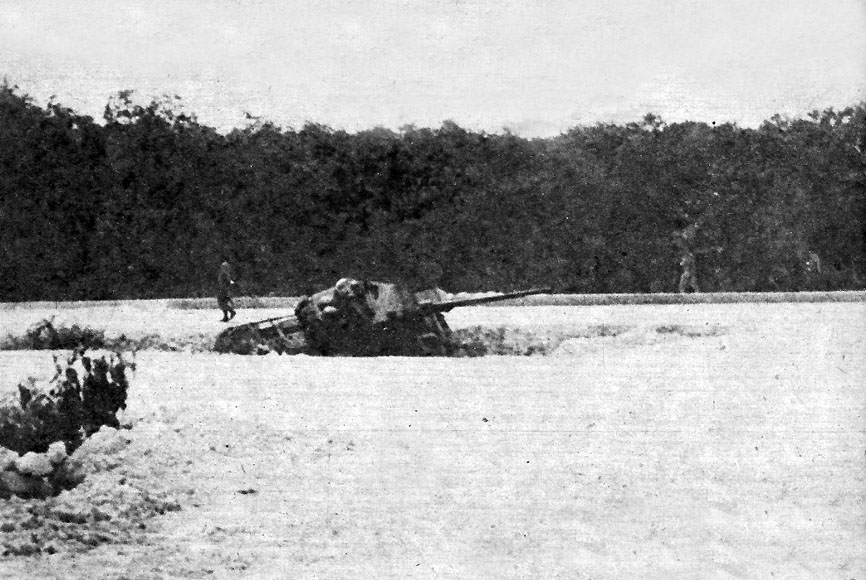
Some rebel officers, who later defected from the Castro revolution and fought at the Bay of Pigs, have written stories about their experiences in the combats held at Playa Larga. They had estimated that at Red Beach, during the first day and morning of the second day, in particular during the clash the previous afternoon that we had called the "Battle of the Lost Battalion," over five hundred of Castro's men lost their lives and almost one thousand were wounded. Even 48 years after our failure to bring democracy to Cuba and save our people of almost 50 years of dictatorship, we do not know the exact number of dead and casualties suffered by the Castro brothers' troops during the invasion. Throughout all this time, the government had only released the information it thought would fit its political propaganda. They never explained to their followers or the world why so many of their troops died in combat, facing only a few hundred Cuban exiles. As usual, Fidel Castro wanted to diminish the effect of our military action against his "mighty" revolutionary army, and had tried by all means at his disposal to ridicule the Assault Brigade 2506 as a bunch of "untrained mercenaries who were easily defeated in seventy two hours." After the nigh combat, my Task Force, numbering less than four hundred men, had suffered an almost unbelievably low number of casualties: fifty wounded and twenty five dead, excluding those killed in the Houston the morning before. The Brigade that night at Red Beach had demonstrated its combat readiness, which had been recognized and praised by our civilian leaders, the members of the Frente Executive Committee, three months before in Guatemala, when they reviewed the training of our Brigade at Base Trax.
Since my units were depleted of their ammunition and I was expecting a new, fresh enemy assault from the north and left flank, and possibly from the east, at 6:00 a.m. I sent a message to Pepe San with a messenger using one of the five jeeps at my disposal. I advised my senior commander that my situation was desperate. I could not face a new attack without reinforcements and supplies to include ammunition, food and medical equipment. I told him that it seemed possible that the enemy was trying to encircle my Task Force and hit us from all fronts except the sea. Approximately one hour later, exactly at seven o'clock, a jeep arrived with Jorge Fernández, the Fourth Battalion S-4 (Logistics) officer. He brought the Brigade Commander's reply. It read: "RESIST UNTIL THE LAST MINUTE-THE MOMENT OF DEATH. NO AMMUNITION IS AVAILABLE, OUR SUPPLIES ARE ALMOST DEPLETED." How in the hell did he expect me to fight a war without ammunition and supplies, I yelled at Juan who was standing at my side, waiting for my orders. Did he really mean that he wanted all my troops to be massacred at this beach without having the means to defend ourselves? I again wondered aloud. At this time, Hugo was already in his battalion command post waiting for further instructions on how to deploy his men for what it seemed to be an inevitable major enemy assault.
By the time I had received the message, the enemy had completed their retreat. However, some brigadistas manning forward defensive positions had already detected some snipers and scouts, who protected by the dense vegetation, had been moving outside our perimeter. It looked like they were trying to determine our strength or the locations of our defensive positions. For the first time since the landing, the small weapons fire began to increase sharply on the eastern flank. That led me to believe that I was correct when I assumed that Castro field commanders were trying to encircle my forces. The snipers fired to whatever was moving inside our beachhead. I fully realized that it was a clear signal that the temporary brake in the fighting was ending quickly. The enemy for sure would regroup, as fast as they could, and would be hitting hard again at our positions with all their newly acquired strength.
CHAPTER XIII THE LAST STAND
87. THE LAST DESPERATE HOURS AT RED BEACH (PLAYA GIRON)
Silently and undetected, an enemy American-made Sherman tank that had moved behind enemy burning tanks and armored vehicles, previously knocked out at the distance by our Brigade forces, began firing its 76mm cannon against our positions. One of its first rounds made a direct impact on Alemán's tank turret. Alemán, who was at that time standing on top of the tank, trying to observe through his binoculars the enemy movements, was killed instantly. That brave and patriotic brigadista did not have time to react. The explosion threw him from the tank to the ground, only a few yards from my command position.
The fatal blast sent pieces of metal flying through the air over our heads. One fragment sliced off Jorge Alvarez's top right ear. Alvarez was the driver of one of the three tanks that Pepe San had sent at my request to protect the Western Front troops now under my command. It was not my responsibility to be there, I should have been in the Brigade CP, with the commander and his staff. However, the commander of the Sixth Infantry Battalion, Paquito Montiel, was injured and I volunteered to take his place and defend the Western front. Pepe and Manolo Artime agreed with my request. At the time of the explosion, Alvarez had his head outside his tank, talking to a brigadista who was positioned in a near foxhole. Reacting quickly, González Carmenati, the chief of the other tank, fired a single round and destroyed the enemy tank.
As a result of the shell explosion, Alemán's tank began to get fire in the midst of our defensive positions and in close proximity of the other two tanks that I had positioned on step formation, less than fifteen yards apart from each other. The crew of the damaged tank miraculously escaped from it. One of them, José Fajardo (the father of the famous Cuban singer Gloria Estefan), was the tank driver. He had come out stumbling from the burning tank and walked a few yards before falling, unconscious and seriously wounded, inside the trench that I was using as my new command post. Since Fajardo was bleeding profusely from his head and face, I thought that he was dying. I sent him immediately to the rear with the only jeep available to be attended by Brigade°s physicians. Fortunately, he survived his deep wounds.
The others members of the tank crew, shocked by the tremendous blast, were helped by members of Hugo, the brave and courageous commander of the Second Infantry Battalion. Two brigadistas got fire extinguishers and began fighting the flames of the tank, but it was not enough. I shouted to any one who knew how to drive the tank to move it away from our defensive positions. Jorge Alvarez, still bleeding profusely from his right ear, jumped out from his own tank and climbed into the burning Sherman. After a few unsuccessful tries, he was able to start the tank and drove it away, down the road toward Blue Beach with flames shooting up from the back and smoke pouring out from the turret.
Since Alvarez did not know where to park the burning tank, he stopped a few hundred yards behind our forward positions. He thought that the location was clear and far enough from our defensive line. However, he was not aware that swampy terrain had been occupied by Hugo's mortar platoon. The mortar platoon leader began screaming and yelled at Alvarez to "get the hell out of here, get your burning thing away from our positions before it blows us all to the kingdom come."
The platoon leader was correct in his assessment of the dangerous situation. They had more than one hundred mortar shells piled up only a few yards from the place where Alvarez had stopped the tank. Justifiably enough, the brigadista was afraid the shells could explode by the heat and flames coming out from the tank. Alvarez, without hesitation, jumped again into the tank, pulled its automatic fire extinguisher, and extinguished the threatening flames.
About fifteen minutes later, the "Little Egg," as Alvarez was called, soaked with blood from his wounded ear, came running back to my positions, saluted me and asked permission to return to his tank. I congratulated him and he began climbing into his tank. But, before he got inside the vehicle, I stopped him. I saluted the brave man and told him he was promoted to captain for the courage demonstrated in combat and possibly saving the lives of many of his comrades in arms. At that moment, it seemed as an illogical reaction to a heroic performance but it was the only thing I could do to demonstrate my appreciation and recognition of that young man's exceptional valor and courage. It was the only battlefield promotion given to a brigadista for a heroic action in battle during the Bay of Pigs invasion. Many, many more individuals could have been acknowledged for heroism during the three days of intense combat at the Bay of Pigs, but that was the only opportunity that I, as the second-in-command of the invasion, had to recognize a member of Assault Brigade "2506."
CHAPTER XV "CAPTURED AND IMPRISONED
101. THE TRUCK OF THE DEATH
The next day, shouting and cursing outside my prison awakened me. I looked through a window and saw a large group of brigadistas who were lined up in a single file. One by one, they were called. When a name was mentioned, the prisoner had to stand in front of a small table where Osmani Cienfuegos was seated, close to another rebel officer that I immediately identified. He was Captain Fernández Vila, chief of the INRA office of the Matanzas province. From their well-guarded chairs, both men called the brigadistas cowards, mercenaries, war criminals, thieves, immoral, and shameless people. The one yelling harder was Fernández Vila. I was really surprised when I recognized that rebel officer because I thought that he had been discharged from the FAR. In January of the previous year, when I was still performing as an INRA General Inspector. At that time, my teammate Lieutenant Leonel Fuentes and I were instructed to investigate a theft in Captain Vila's office. Vila was under suspicion to be the one who took $ 25,000 in cash from his desk's drawer. The money had disappeared overnight without-a-trace. Everyone we interviewed during our investigation thought that Vila had taken the money. However, we were not able to review all the information gathered and reach any final conclusion because, after returning to Havana, we were relieved of our assignment by another INRA team, comprised of only rebel (revolutionary) officers, that took over the investigation. We understood the Section Chief's decision, Captain Rodolfo Villamil. Both, Leonel and I had been members of the Constitutional Army and he thought that our findings, even if they were correct, could be "considered biased" by the bearded men "barbudos", as the members of the revolutionary army were commonly called.
The truck waiting to transport the brigadistas to a new location had been built in the United States, a refrigeration type, the type used on American express highways made of aluminum, plywood stripping inside and with two big doors, one on each side in the middle of the truck. When over one hundred prisoners were inside the truck, four militiamen came to the small house where I was guarded and ordered me to go with them. As soon as I reached the small wooden table, Fernández Vila, with a sense of importance said, "this is Oliva, the Second-in-Command of the mercenaries."
Osmani Cienfuegos gave me a very dirty look and asked me what I had to say. I replied, "my name is Erneido Andrés Oliva, I am the Second-in-Command of the Brigade, my number is 2641." Vila did not like the tone of my answer and shouted that I was insulting Cienfuegos, "a minister of the revolution." It is not my intention to be disrespectful to anyone, I snapped back. I am only providing the information I am required to give you according to the Geneva Convention of 1864. Besides, I added. You better keep your mouth shut because I remember when I interrogated you for stealing money from the INRA. In the midst of the heated argument, Cienfuegos screaming and looking very upset, ordered the militia guards to push me back to my improvised prison cell. "He will be shot tonight," he angrily shouted.
It seemed that Cienfuegos, unwillingly, had saved my life or at least spared me from going through the rough experience that would be lived by those brigadistas who were already inside that truck. I later thought that Osmani never forgave himself for pulling me from over one hundred members of the Brigade who made the trip to Havana in that sealed truck. No one could ever forget the inhumane and murderous treatment he gave to those brave men. I was later told by many of my friends about their many horrifying experiences inside "The truck of the death."
During the seconds I walked back to the small house, pushed, hit and kicked by a dozen of armed rebels, I could hear the members of the Brigade shouting and complaining: "No more, no more, we cannot breathe." In a moment of sanity, Fernández Vila told Osmani Cienfuegos that the prisoners could die if he put one more man inside that truck. Cienfuegos angrily replied: "Let them die! It will save us ammunition when we shoot the whole Brigade later." He made a signal to a militia officer standing besides him and ordered " bring ten more pigs," as he called the brigadistas.
TABLE OF CONTENTS
GENERAL OLIVA'S UNPUBLISHED NOTES
CHAPTER I "EARLY DAYS"
1. THE CUBAN MILITARY ACADEMY
2. CHILDHOOD'S EXPERIENCES IN AGUACATE
3. FACING FOR THE FIRST TIME THE REALITIES OF LIFE
4. BATISTA'S COUP D'ETAT
5. THE SERGEANTS' 1933 REVOLUTION
6. THE OVERTHROW OF A CONSTITUTIONAL GOVERNMENT
7. FIDEL CASTRO'S ASSAULT TO THE MONCADA BARRACKS
8. GRADUATION (SECOND LIEUTENANT -- FIRST TIME) AND ARMY ASSIGNMENTS
CHAPTER II "SCHOOL OF AMERICAS"
9. ARRIVAL AT THE SCHOOL OF THE AMERICAS, FORT GULICK, CANAL ZONE
10. MY WEDDING IN AGUACATE
11. MY RETURN TO FORT GULICK
12. THE TRIUMPH OF THE CUBAN REVOLUTION
13. FAREWELL TO THE SCHOOL OF THE AMERICAS
14. RETURN TO CUBA AND DOWNGRADED TO SECOND LIEUTENANT (SECOND TIME)
15. MY FIRST ENCOUNTER WITH CHE GUEVARA AND THE CUBAN REVOLUTION
Che Guevara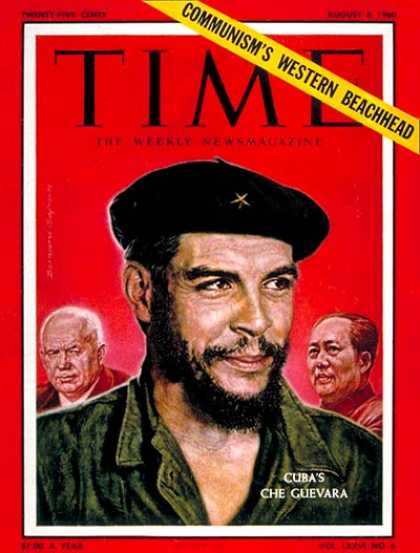
CHAPTER III "CASTRO REVOLUTION"
16. UNFRIENDLY WELCOME FROM MY OLD NEIGHBORS AND FRIENDS IN AGUACATE
17. FIRST ASSIGNMENT IN THE REVOLUTIONARY ARMED FORCES (FAR)
18. GRACE'S RETURN TO CUBA
19. FIRST ENCOUNTER WITH FIDEL CASTRO AND AN ATTEMPT AGAINST HIS LIFE
20. FIRST ACTIVITIES AGAINST THE REVOLUTION
CHAPTER IV "FIRST ACTIONS AGAINST THE CASTRO REGIME"
21. CONSPIRING WITH FORMER ARMY OFFICERS TO OVERTHROW THE REGIME
22. ASSIGNMENT TO THE INSTITUTE OF AGRARIAN REFORM (NRA)
23. RESIGNING MY COMMISSION IN THE FAR
24. FULL-TIME ACTIVITIES IN THE UNDERGROUND
25. ESCAPE FROM CUBA
CHAPTER V "CUBAN LIBERATION ARMY"
26. ARRIVAL IN MIAMI
27. JOINING THE CUBAN REVOLUTIONARY FRONT (EL FRENTE)
28. MY DEPARTURE FROM MIAMI
29. MOVEMENT TO GUATEMALA
30. MEETING OLD FRIENDS AND FORMER FOES AT GUATEMALAN CAMPS
31. BASE TRAX AND ASSIGNED AS A PLATOON LEADER (THIRD TIME A SECOND LT.)
CHAPTER VI "OUR FIRST MARTYR"
32. CARLOS (CARLAY) RAFAEL SANTANA OUR FIRST FALLEN HERO
33. ARRIVAL OF THE "HAWKS"
34. ORGANIZATION OF THE BLACK AND GRAY TEAMS
35. FIRST DISTURBANCES AT BASE TRAX
36. PUERTO BARRIOS' OPERATION
37. FIRING OF THE CUBAN BASE COMMANDER
38. BASE TRAX'S POLITICAL ENVIRONMENT
CHAPTER VII "THE ASSAULT BRIGADE 2506"
39. CHANGES IN THE BRIGADE'S OPERATIONAL PLANS
40. APPEARANCE OF FIRST CASTRO'S SPY AT BASE TRAX
41. THE GRAY TEAM OPERATIONS INSIDE CUBA
42. MOVEMENT TO A NEW TRAINING SITE (GARRAPATENANGO)
43. UNEXPECTED PROMOTION TO THE BRIGADE SECOND-IN-COMMAND POSITION
44. THE BRIGADE COMMANDER'S RESIGNATION
CHAPTER VIII "THE CIVILIAN LEADERSHIP"
45. THE CIVILIAN LEADERSHIP'S FIRST VISIT TO BASE TRAX
46. TOUR OF THE TRAINING SITES
47. CONCLUSION OF THE VISIT
CHAPTER IX "THE CONTINGENCY PLANS"
48. THE TRINIDAD PLAN
49. FINAL PREPARATIONS FOR THE INVASION
50. PROPOSED ALTERNATE PLAN
CHAPTER X "THE BRIGADE DEPLOYMENT"
51. BRIEFINGS AT "TRAMPOLINE," NICARAGUA
52. INSPECTION OF THE TRANSPORT SHIPS
53. THE INVASION BRIEFINGS IN NICARAGUA
54. REVIEW OF OPERATION ORDER "PLUTO"
55. BOARDING THE TRANSPORT SHIPS
56. FIRST AIR RAID OVER CUBA
CHAPTER XI "THE INVASION"
57. THE SHIPS'S RENDEZVOUS
58. THE BEGINNING OF THE LANDING
59. NEED TO CHANGE THE LANDING ORDER
60. ODYSSEY AT THE BAY
61. MONDAY MORNING OPERATIONS
62. SINKING OF THE Houston
63. FAILURE TO FULLY CONSOLIDATE THE BEACHHEAD
64. UNEXPECTED FINDINGS ON THE GROUND
65. THE BRIGADE'S FIRST PRISONERS
CHAPTER XII "THE BATTLE OF "THE LOST BATTALION"
66. BATTLE OF "THE LOST BATTALION"
67. HEROIC DIRECT AIR SUPPORT
68. MONDAY AFTERNOON OPERATIONS
69. PREPARATIONS FOR THE BATTLE AT "LA ROTONDA"
70. BRIGADE REINFORCEMENTS REACHED RED BEACH PRIOR ENEMY ATTACK
71. UNDER HEAVY ARTILLERY FIRE
72. A FIELD COMMANDER'S LACK OF LEADERSHIP
73. THE HEROIC BATTLE AT LA ROTONDA BEGINS
74. TANKS AGAINST TANKS
75. THE END OF THE HEROIC BATTLE AT LA ROTONDA
76. TUESDAY MORNING
77. HASTY WITHDRAWAL FROM RED BEACH
CHAPTER XIII "THE LAST STAND"
78. ARRIVAL AT BLUE BEACH HEADQUARTERS
79. RECOMMENDATION MADE FOR AN ALTERNATIVE ACTION
80. CONTACTS WITH THE AMERICAN HIGH COMMAND AT THE SEA
81. SAN BLAS' CRITICAL SITUATION
82. UNFORGETTABLE "AIR SHOW" OF U.S. NAVY SABRE JETS
83. TUESDAY EVENING OPERATIONS
84. MISSION IMPOSSIBLE TO ACCOMPLISH
85. VOLUNTEERING TO ASSUME COMMAND OF THE WESTERN FRONT
86. WEDNESDAY MORNING OPERATIONS
87. THE LAST DESPERATE HOURS AT RED BEACH (GIRON BEACH)
88. THE FINAL HOURS OF THE BAY OF PIGS INVASION
CHAPTER XIV "THE BITTER DEFEAT"
89. HASTY WITHDRAWAL FROM THE WESTERN FRONT
90. THE BRIGADE COMMANDER'S UNEXPECTED RETREAT TO THE SWAMPS
91. THE AGONY OF DEFEAT
92. DESPERATE ATTEMPT TO REACH THE ESCAMBRAY MOUNTAINS
93. SEEKING A ESCAPE ROUTE TO ESCAPE THE ENEMY ENCIRCLEMENT
94. A TRAP WITHOUT EXIT
95. OUR POOR PEASANT PRISONER
96. TAKEN PRISONER BY THE ENEMY
CHAPTER XV "CAPTURED AND IMPRISONED"
97. THE MOMENT OF TRUTH
98. MY FIRST JAIL
99. BITTER RETURN TO PLAYA GIRON
100. MY FIRST "VIP" VISITORS AFTER DEFEAT
101. THE TRUCK OF THE DEATH
102. FACING THE FAMOUS PAREDON AFTER THE CHE'S VISIT
103. THE TRIP TO HAVANA; NOT AS FRANK'S PREDICTED
104. THE BRIGADISTA THAT DID NOT GO TO CUBA TO SWIM
105. FACE-TO-FACE WITH A BRIGADE TRAITOR
106. RETURN TO THE SPORTS PALACE
107. BRIGADE "REUNION" AT THE NAVAL HOSPITAL
108. CASTRO'S RANSOM DEMANDS
109. FIRST VISIT BY MY WIFE AND BABY DAUGHTER
110. RETURN TO PRISON OF THE BRIGADE COMMISSION
111. HENRY WINSTON'S RELEASE ORDERED BY THE US ATTORNEY GENERAL
112. TRANSFER TO THE PRINCIPE CASTLE
113. AN INCREDIBLE CONFESSION OF TWO WOULD-BE ASSASSINS
114. THE BRIGADE COMMISSION'S DESERTERS WHO STAYED IN MIAMI
CHAPTER XVI "THE TRIAL"
115. THE TRIAL ORDEAL BEGINS
116. GOVERNMENT WITNESSES
117. SECOND DAY OF TRIAL
118. THIRD DAY OF TRIAL
119. FOURTH AND FINAL DAY OF TRIAL
120. WAITING FOR THE VERDICT
121. CASTRO'S UNEXPECTED VISIT TO PERSONALLY READ ME THE SENTENCE
122. THE FAMILY COMMITTEE'S RETURN TO CUBA
123. NEW SURROUNDINGS
124. FAMILY REUNION
CHAPTER XVII "THE ISLE OF PINES"
125. MY CAPTORS FULFILLED MY WISHES
126. TOTAL ISOLATION BEGINS AGAIN
127. PRISON ROUTINES TO REMAIN SANE
128. UNSOLICITED VISITORS, COMPANIONS AND CALLOUS GUARDS
129. NEGOTIATIONS FOR OUR RELEASE CONTINUED IN WASHINGTON
130. THE OCTOBER MISSILE CRISIS
131. AT LAST, FREEDOM RINGS
132. FIDEL CASTRO'S THREATENING FAREWELL
133. FIDEL CASTRO'S FINAL DEMAND
134. THE ORANGE BOWL CEREMONY
135. PRESENTATION OF THE BRIGADE FLAG TO THE PRESIDENT
CHAPTER XVIII "THE SPECIAL PRESIDENTIAL PROGRAM"
136. ROBERT KENNEDY'S STRONG DESIRE TO GET RID OF FIDEL CASTRO
137. STATE DEPARTMENT'S HANDS BEHIND OUR DEFEAT
138. PARTICIPATION IN OPERATION MONGOOSE
139. SPECIAL PRESIDENTIAL PROGRAM FOR THE BRIGADE
140. MEETINGS WITH A GREAT AMERICAN ADMIRAL
141. THE BRIGADE COMMANDER'S RESIGNATION
142. ASSUMING NEW RESPONSIBILITIES IN LEADING THE BRIGADE
CHAPTER XIX "ACCEPTING A DIRECT COMMISSION IN THE US ARMY"
143. A SECOND LIEUTENANT AGAIN (FOURTH TIME IN MY MILITARY CAREER)
144. MANUEL ARTIMES'S OPERATIONS IN CENTRAL AMERICA
145. GRADUATION CEREMONY AT FORT BENNING, GEORGIA
146. NEW OPERATIONAL PLANS TO OVERTHROW CASTRO
147. JOHN F. KENNEDY'S ASSASSINATION
148. THE LAST BETRAYAL
149. MEETING WITH THE NEW PRESIDENT OF THE UNITED STATES
150. PROBLEMS AMONG THE PILOTS AT CHANUTE AIR FORCE BASE
151. FINAL UNFORGETTABLE DEFEAT AT THE HANDS OF FRIENDS AND ALLIES
152- THE CUBAN REPRESENTATION IN EXILE (RECE)
Lessons to Be Learned
UPSTREAM
CONOPS COA #1--Leave Communist Cuba Alone

Castro with Ernest Hemingway
Of course, this is what we have been doing ever since we finally stopped instigating sabotage attacks. Castro has gotten older and the country's socialist-by-force economy is weaker, what do you expect?
This however is EXACTLY what Commander Ian Fleming suggested JFK do--don't obsess over Cuba, let it stew in its own juices. Obviously, Fleming was right.
However, let's step back into 1960 and see what the fear was. According to CIA BOP commander, Graystone Lynch in his book, reports were that Castro would soon be getting MiG jet fighters and once he had them our rebel s would be outmatched to such a degree they'd need obvious American jet fighter help and the myth that they were going to retake Cuba DIY would be gone.
OK, let's go downstream a bit and see what could have been done.
CONOPS COA #2--Free a Part of Cuba
With benefit of 20-20 hindsight, why couldn't Assault Brigade 2506 be given a smaller military task then immediately overthrowing Castro and taking over the Cuban land mass with just 1, 500 men and a dozen planes and a handful of light tanks?
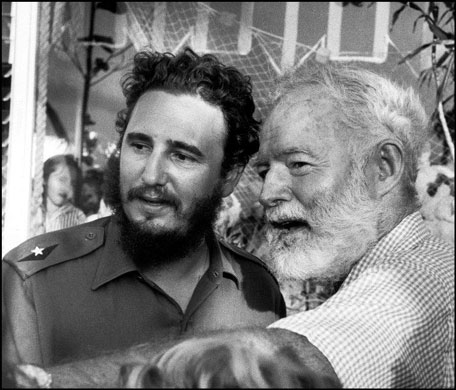
The Isle de la Juventud: South of Cuba (Click for full-size)
Why not instead take the island of Juventud (Youth) also known as the Isle of Pines? Once taken, it would become a defacto "Free Cuba" just like Taiwan is to Red China. The farmland there is said to be the best of Cuba, so grow cash crops of tobacco and sugar there. Put casinos and hotels on the island with nightclubs and dancers like old Cuba--but without the corruption. It would be too costly for Castro to invade and re-take the place over, so he might tolerate the Free Cuban island. The anti-Castro free Cuban exiles would have a homeland to call their own. Everyone wins.
Amazingly, I just found out from Newman's book, Oswald and the CIA that the powers-that-be were considering this exact same thing! On page 201 he reveals:
If local resistance is unable to accomplish the mission and the operation should expand, then there may be a requirement for air action. The plan would be to take the Isle of Pines or another small island for an ostensible base for operations of the [less than 1 line not declassified] forces. It is hoped that this may not be needed but we must be prepared for it."
Bissell added that eleven groups that had potential had been identified in Cuba. "We are in the process of sending radio communications to them at this time," he said! The air attacks were a significant escalation of the U.S. role. At the meeting, no one asked what the military impact of such CIA-backed air attacks would have in Cuba, and what the cost would be if this were discovered by the press.
In a historic decision remarkably like the one Kennedy would make after his inauguration, Eisenhower gave the go-ahead to proceed in Cuba, with a key condition attached. Eisenhower's decision and his reasoning are preserved in this passage of the minutes:
The President said that he would go along so long as the Joint Chiefs, Defense, State and the CIA think we have a good chance of being successful.
Therefore, the BIG QUESTION is WHAT HAPPENED TO TAKING THE ISLE OF PINES BETWEEN THE EISENHOWER ADMINISTRATION AND JFK's?
Taking a part of Cuba and holding it--like an island--makes perfect sense for a limited size force like Brigade 2506. What happened to this? Or was JFK only being set-up with a take all of Cuba only option?
CONOPS COA #3--Regime change Now
Havana-Raid
The question has to be asked; why not just land 2506 directly on Havana and take the governmental buildings? This is typically what a coup d'etat does. Go for the jugular. Havana has an airport and a sea port. Taking ports are possibly heavy casualty affairs, but this ain't Nazi Germany, either. An armored ship full of assault troops could have rammed into the piers and dropped boarding ramps so the commandos could get out and fan-out to secure the area. Multiple 2506 brigades would probably be needed and there wasn't time to create them if Russian MiGs were soon to bolster Castro's AF. So if you only have one brigade...
TRINIDAD-Ink Blot
I have to concur with Colonel Hawkins that Plan TRINIDAD should have been employed as it would have immediately married up Assault Brigade 2506 with actual anti-Castro rebels in the mountains and this could have been the first chunk of "Free Cuba" that could have been resupplied indefinitely. The common way to run an insurgency is to first take a chunk away from the corrupt nation-state government and build over time a larger and larger "ink blot". American impatience to take it all over immediately doesn't give time for the people to join in the overthrow if they haven't had much time to see how evil the current regime is. In 1961, a lot of people still believed in Castro who had only ousted Batista 2 years earlier.
However, if regime change now was to be done it had to be done powerfully since a popular Cuba-wide, anti-Castro uprising wasn't waiting in the wings to help.
The Battle Against the Earth
TBATE-TRINIDAD
A wise plan will not pit the forces of the earth against you. Landing in the flat, low ground of a swamp with slow foot-slogging troops who could not rapidly break-out of a beach head was asking for the force to become pinned down. Troops without tracked, cross-country mobility must be landed so they can take the high ground quickly so its in their "hip-pocket" as a defensive 3-to-1 ratio advantage if counter-attacked. The TRINIDAD Plan's location would have maximized the high ground of the Escambray mountains and the Assault Brigade 2506's training in the mountains/forest of Guatemala beforehand. In closed terrain, weapons engagement ranges are shortened and the ability to fire quickly would favor the higher marksmanship skill levels of the 2506 troops over the Castro troops.
TBATE-ZAPATA
However, by landing in open, flat terrain, 2506 troops were placed in tactical situations they had not trained in to gain weapons accuracy overmatch and it invited the Castro Cubans to precede their maneuver with high explosive artillery shells which fell amongst the 2506 troops who had no protection from armored vehicles or the earth's vegetation or folds in terrain. It appears that the 2506 troops didn't or couldn't dig-in to the swamp ground to withstand artillery impacts to hold on to a lodgement. If they didn't dig-in because of bad training and it was feasible from a TBATE perspective, then it was our own defective USMC-style line infantry narcissism that we inculcated into the 2506 troops that set them up for failure.
Landing Assault Brigade 2506 51 miles west of the Escambray mountains they needed to be in to conduct a long-term guerrilla warfare campaign ("A Beach-Head Too Far") smacks of the Arnhem situation of being dropped 8 miles west of the bridges they needed to take intact for follow-on ground forces.
What could 2506 gotten ahead of time so it could have driven-on (GIDO) to a success if to be an "Assault" Brigade and not a "Guerrilla Brigade"?
Yes, the switched locations caused bad planning just like the "A Bridge Too Far" Arnhem operation that was also not well-thought out. Haste makes waste--if you are not prepared. A force to march on Havana needs to be MECHANIZED to have overmatch superiority--men with hand weapons will be no better and a lot worse than Castro-istas with FN FAL 7.62mm automatic rifles backed by T34/85 and SU-122 turret-less medium tanks and 122mm artillery. A general purpose force with overmatch and an ability to adapt doesn't need perfect plans--a force that walks without armored mobility and firepower cannot afford to be wrong.
GIDO-1: Tracked, Armored "Mechanized" Cross-Country Mobility
If landing in the open, a force must have armored hull protection and mobility from tracked vehicles to get out of the mess. In the desert you are always in this exposed situation which is why units that prevail there are all-tracked. M3 half-tracks were U.S. Army surplus and could have been the bread & butter of 2506--so the entire brigade was "armored". Obviously, a mechanized force couldn't be foisted off as DIY and would be U.S. supplied--but this is exactly what is required to overcome landing in the open swamps.
A mechanized 2506 would be the only type force with a hope in hell of marching rapidly on Havana and toppling the government but at only 1, 500 men and at the most 300 vehicles its undersized no matter what. The much larger, 1st Cavalry Division did this in 1944 to take the capital of the Philippines, Manila.
GIDO-2: Wheel, Unarmored, "Motorized" Road/Trail Mobility
A motorized 2506 could drive itself out of trouble--if not annihilated by air and ground ambushes on roads/trails. It might be an one-timer movement with vehicles lost at first enemy contact resulting in foot-slogging thereafter.
The typical anti-vehicle bias of a foot-narcissist marine planning the operation probably insured these two GIDO options were not even considered.
The Battle Against Man
TBAM-ZAPATA-Artillery
Setting aside the need for moral courage to say "NO!" to landing on untenable flat lands without tracked APC transport or to order B-26s to strike down Castro T-33 jets in a beg forgiveness later mode, if one were to land in such handicapped open, flat ground, the potential of what an enemy could do must be ascertained. Colonel Hawkins was mostly a Japanese POW during WW2 and did not suffer enemy artillery and mortar bombardment as other marines did on Tarawa and Iwo Jima for example. He apparently lacked an appreciation for what INDIRECT FIRE weapons lobbing high explosive (HE) shells could do to a foot infantry caught in the open with mainly direct-fire weapons to fight back. Castro's 122mm artillerymen could lob HE shells onto the exposed men on the flat, open ground from a stand-off safe from their longest ranged 107mm heavy mortars.
GIDO-3: Bring Direct-Fire Tube Artillery
A Colonel Gavin type of commander would have thought ahead and anticipated the key threat to the beach landing troops like he did on Biazza Ridge when hge insisted on 75mm pack howitzers and NOT MORTARS be taken to blast possible German tanks. Likewise, Hawkins should have from his intelligence reports realized Castro had medium-range 122mm tube artillery that could have its fires directed onto his men. To counter this, it should have been Priority #1 that a recon & security line be established with our own tube artillery--perhaps direct-fire 75mm pack howitzers that would race forward towed by jeeps alongside the M41 Walker BullDog light tanks to keep the beachhead outside of Cuban artillery range. All of those mortars should have been pushed as far forward as possible to win the counter-battery fight. What I propose had already been done before at Arnhem in 1944 and it successfully held off German Panzer divisions for over a week--without any friendly light tanks due to General Browning refusing the offer of the 6th Recce Squadrom to Hamilcar glider airland in with their Tetrarch light tanks. With a handful of M41 light tanks, a screen line ahead with 75mm pack howitzers would have worked even better. The 75mm pack howitzer can also knock out the T34/85 medium tanks Castro had. We are not even factoring in the 2.36/3.5" bazookas and 75mm recoilless rifles 2506 had to assist in tank-killing.
GIDO-4: Drop Paratroopers into Deeper Blocking Positions
However, it seems that 2506 floundered at the water's edge and did not constitute itself into a coherent blocking line groups--least of all where it was needed most to keep Castro Cuban 122mm artillery out of range. Castro says the 2506 paratroopers should have dropped farther inland to block his mobile forces from getting close. I concur.
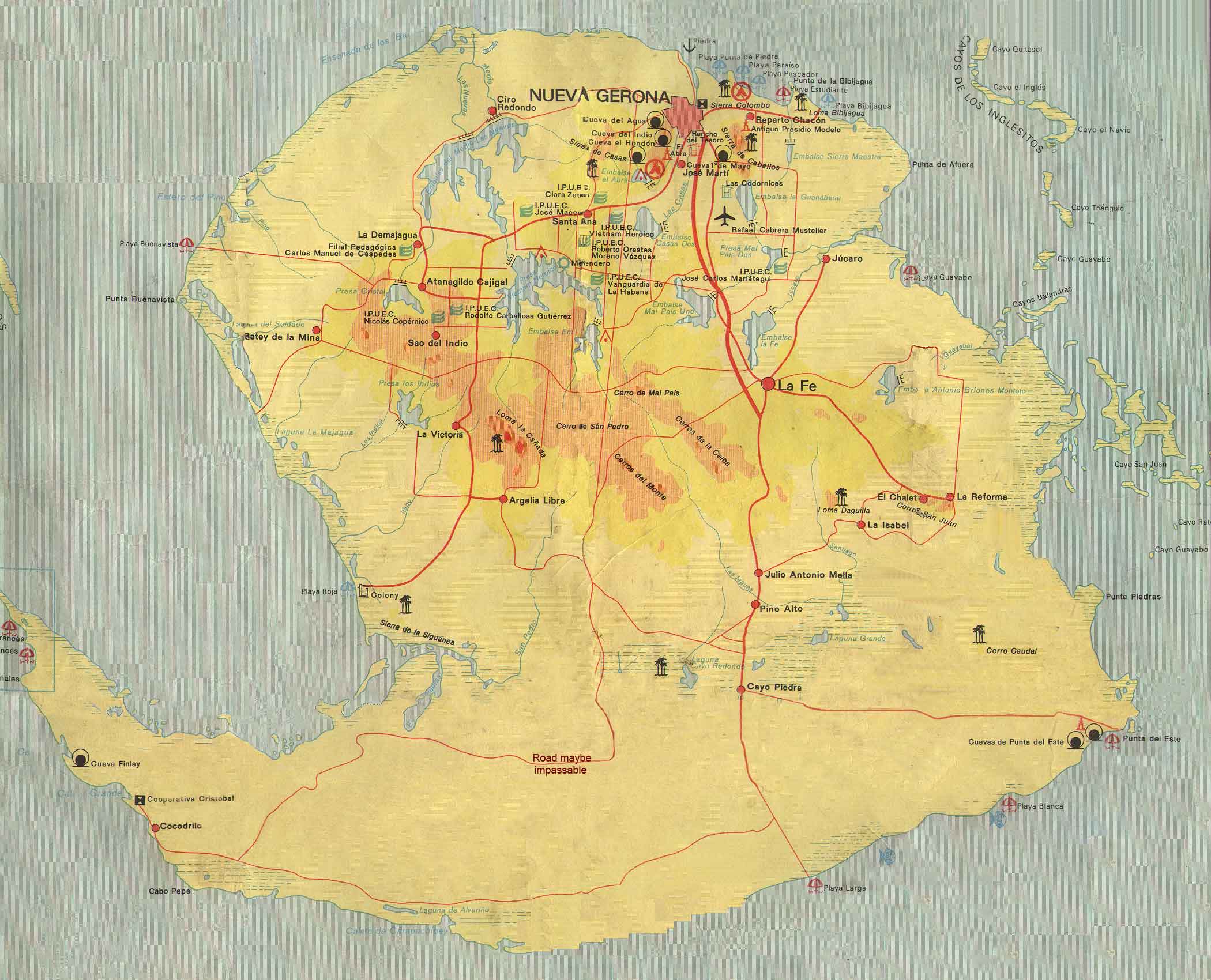
The minutes of the White House meeting indicate that the Joint Chiefs "saw no problem" with Bissell's request for American troops to train the Cubans. Dulles said that he hoped five hundred Cubans could be finished with their training by "the beginning of November," a prediction possibly meant to fit with Nixon's election schedule. Dulles then added this:
"The FRD is acquiring some B-26s. The aircrews for these could be all Cubans. Mr. Bissell then said that it is possible that the initial para-military operations could be successful without any outside help. He pointed out that the first phase would be that of contacting local groups over a period of perhaps several months and in this period no air strikes would be undertaken. The plan would be to supply the local groups by air and also to infiltrate certain Cubans to stiffen local resistance.
Castro's 122mm towed howitzers must be kept out of range of any beachhead or airhead
GIDO-5: Create your own Indirect Fire Artillery Fan
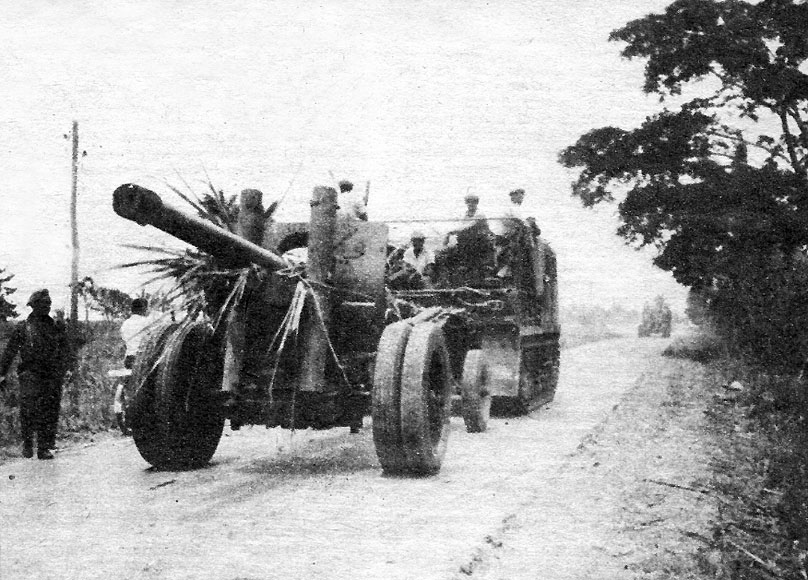
Another option would be to supply 2506 their own 105mm tube howitzers and have them take-up firing positions aggressively to begin firing upon landing and then displace as far forward as possible to create an artillery fan that forward observers could call in fire missions with and shut-down Castro's red legs from firing. Since Hawkins lacked this military expertise, the best Red Leg officer in the U.S. Army should have been brought in to strengthen this part of the plan. As a sign of CIA military incompetence, they didn't even know what they didn't know.
What happened at the BOP is almost exactly what befell the French at Dien Bien Phu just 7 years earlier--VietMinh General Giap closed the airhead resupply the base camps situated in the low ground where a flat runway could be built. After Dien Bien Phu, the communists became very aware that artillery was a weak area of the Western military's practices and saw to it that their client states were well-supplied with tube artillery to close down Western narcissists doing their flashy airborne or amphibious Schtick without prudence and superior combined-arms.
The need to have a flat airfield and damn the entire operation into the flat, low ground is fatal and un-necessary. Had 2506 landed at Trinidad and moved into the mountains supplies could have been easily parachute dropped to them--in fact with less exposure to air crews than if they have to airland and have their large aircraft exposed on the ground as a huge target as we found out ourselves at Khe Sanh 7 years later as if the French experience at Dien Bien Phu wasn't clear enough.
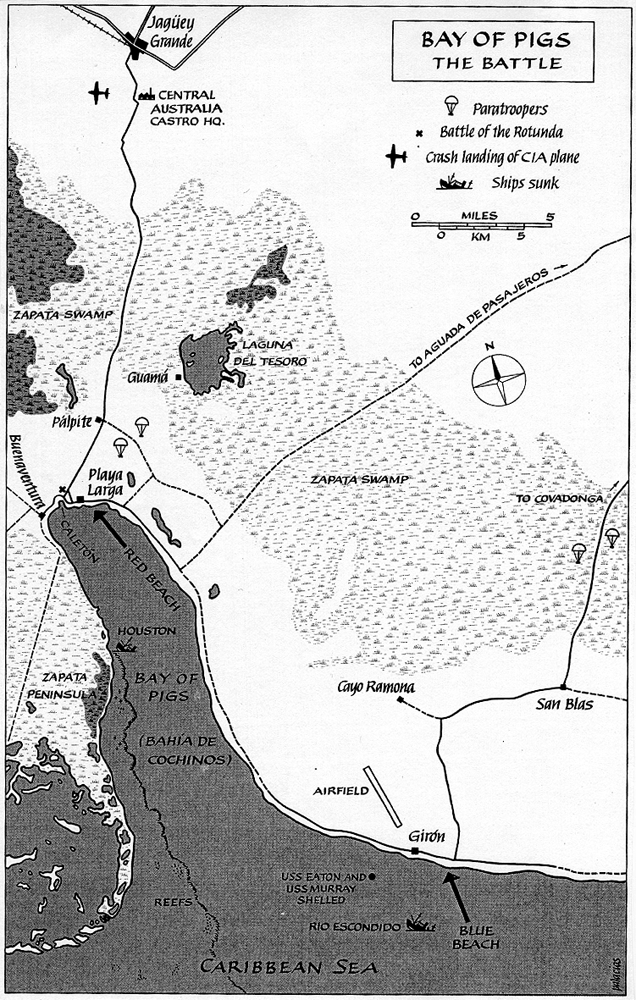
The Tenable TRINIDAD Plan: the Reconnaissance Line would need to be powerfully manned by light tanks and AT weapons to keep Castro's tanks away and an artillery fan of our own established to keep the low ground airfield from being bombarded.
TBAM-Air

Much, in fact most of the wailing about the BOP centers on the whole lack of air cover thing. Let me be clear. IMHO even if we had wiped out the last of the Cuban T-33 jets, or even wiped out all of the Castro Sea Furies, too the invasion would still would have failed because of the artillery battle failure. Notice how the road blocks were busted through by Castro's forces preceded by artillery fires.
The typical lazy American wants war to go all his way and frankly, if you have air supremacy and a lot of planes to attack your enemies you can get away with almost any stupidity on the ground; you could ride around in ice cream trucks if you wanted to. That's the whole problem; the U.S. Army ands marines are pampered and used to having air supremacy to subsidize their incompetent methods and force structures and when we passed on our practices to the 2506 brigade and air supremacy was gone it got them creamed. Now you can say, "we would have aircraft carriers" yadda yadda in typical, smug American triumphalist form. Saying this we are not learning. In a future war with a worthy opponent, we will NOT have aircraft carriers; ours will be sunk because they are too obvious and vulnerable. We will discuss how to insure we have air supremacy in a bit, but first let's see how the BOP invasion plan could have been done differently had we been more realistic and not expected to own the air.
So you don't have air superiority, what do you do?
GIDO-6: Landeth by Air by Night

You land at night.
Which is exactly what the SEABORNE parts of Operation ZAPATA did....the AIRBORNE part dropped during the daytime--no problem, they all landed safely, all 177 of them.
The question is why only 177 Paratroopers?
The failure of the Cuban invasion at the Bay of Pigs in 1961 was NOT just due to the failure to gain air supremacy from the Cuban Air Force but the slow build-up of combat power endemic to the use of SHIPS. If you study the battle closely, you will see the use of ships to deliver WWII-style mass stockpiles of ammunition was a handicap and not a help--because the ships ended up being firepower magnets and targets for the Cuban Air Force. Better a little supply in hand to fight than a lot that can't reach you.
The U.S. marine corps advised Bay of Pigs failure is a warning to us all of the fallacy of relying on slow to be delivered ship troops and supplies while a fight is in progress.
Examine the map of the Bay of Pigs area above.
Notice that a 4,190 foot Giron runway was right behind the beach areas!
THINK ABOUT IT!
Why didn't we drop Paratroopers to set up road block positions and mark the landing strip with lights and then FLY IN and AIRLAND the main invasion force by C-46s, all done at NIGHT---so the Cuban Air force couldn't even think of interfering? As the C-46s and C-54s landed, they could have off-loaded 4x4 jeeps with 75mm Recoilless Rifles and mines to destroy Cuban tanks. They could have also off-loaded 20mm anti-aircraft guns to shoot down Cuban Air Force T-33s and B-26s that tried to strafe the Brigade during the day time.
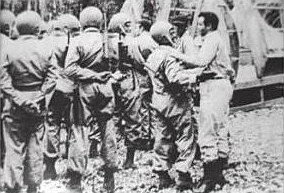
Even Batista's troops could airland to pursue Castro's Rebels in 1956
By air-delivering the troops, we would simplify and declutter 1-4 ships so they could off-load their supplies faster under the cover of night. As day approached, they could sail away from the island and hide over-the-horizon if they were not finished off-loading yet. Again, the USMC bias of Hawkins to land quasi-marines from the vulnerable cargo ships was yet another fatal error in the plan that slowed the expansion of the force onto land and worse, delayed supply offload from the ships making them linger in the area into daylight hours where they were creamed by Cuban planes.
Once a toe hold was secured, the JFK shenanigans over whether to authorize a strike or not strike the Castro Cuban Air Force on the ground would be moot. Air resupply (airdrop or airland) could take place at night regardless whether the Cuban T-33s were not downed by gunfire or not. THEN---bring in ships to resupply the force. In other words, fly our planes at night for resupply but during the day put a wall of lead in the air to get rid of the remaining Cuban air force planes.
The Cuban 2506 Brigade would use its own B-26s operating safely from nearby Nicaragua to take out the Cuban Communist tanks/artillery on night missions until the AIR and sea lines of resupply were secure for day time missions. Then when the lodgement was secure enough, they could displace to the new airfield on Cuba and then do CAS missions from there.
That was a FIDO approach to infiltration invade at night working around a lack of air supremacy. LTG Gavin did the same thing many times during WW2 since his C-47s could fly farther than his fighter escorts could. Now let's look at how we can get the fighters to show up to the fight--without aircraft carriers that will get sunk anyway.
GIDO-7: Seaplane Fighters
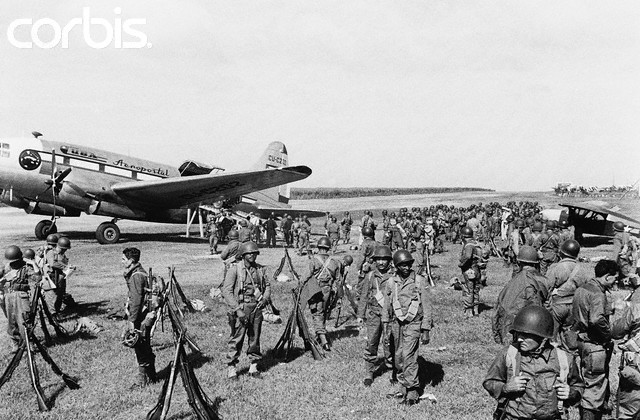
One of the lies the USN/Mc WW2 re-enactment racket has foisted upon us is that the only way we can get airplanes to sea is by recreating a land mass through an aircraft carrier with a dry flight deck. This is a lie. The first naval aviators used SEAPLANES that could land on water. At one time, the USN was the world's leader in seaplane operations until WW2 ended--which they helped immeasurably to win--but the ingrate aircraft carrier mafia rubbed seaplanes out of existence. First, they eliminated the catapult-launched SeaHawk 300+ mph seaplane fighter from battleships and cruisers in 1949 and after a couple decades, long-range patrol seaplanes in 1967.
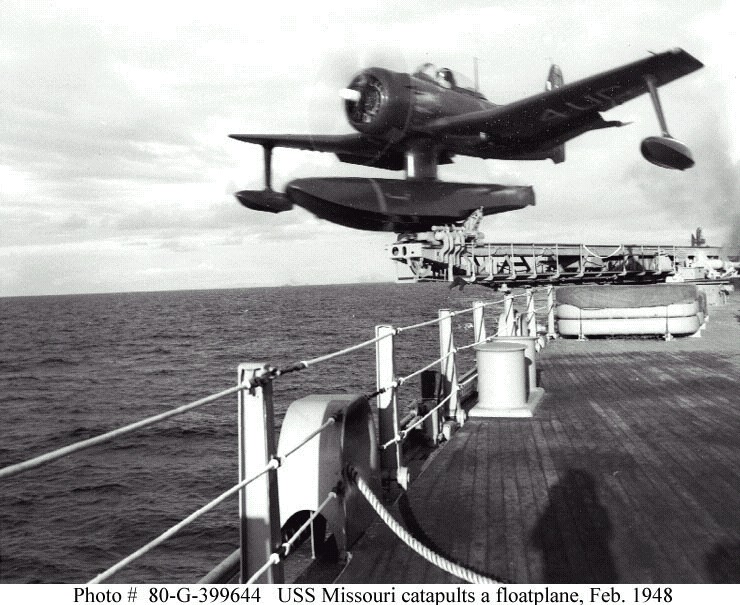
A Modernized SeaHawk with AMRAAM AIM-120 missiles
The bastards. Had the USN aircraft carrier mafia not ruined seaplane fighters they could have been available for the Cuban invasion operating from the cargo ships or from one designated seaplane tender from over-the-horizon. That Operation ZAPATA had ZERO FIGHTER support and depended upon bombers catching fighters on the ground was unrealistic and unsound. You have to be ready to fight to take control of the air--and/or do without.
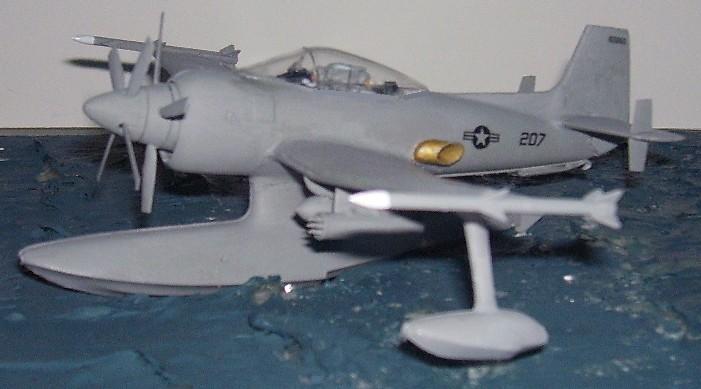
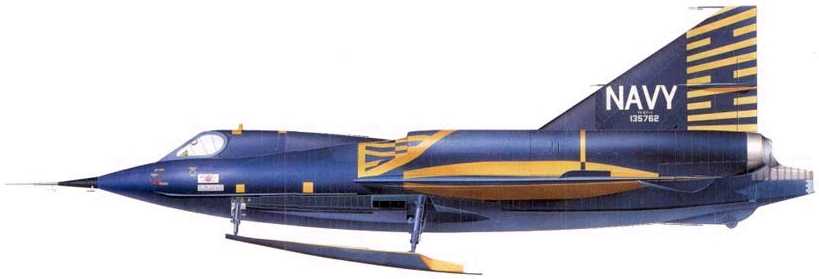
Jet seaplane are also another possibility...
GIDO-8: Sea-Launched Fighters
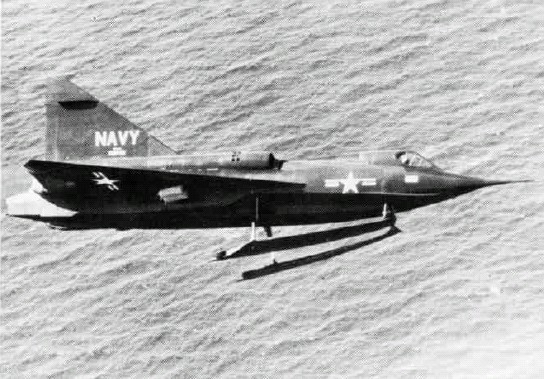
Hurricat
Had Hawkins & company been more creative and less reliant on land-based planes to show up, fighter planes could have been launched from the cargo ships using rockets like the Hurricats were in WW2 to ward off Fw200 Condor patrol bombers. The fighter planes wouldn't even have to ditch in the water; there was a 4, 000 foot runway that was under Assault Brigade 2506 control by dawn!
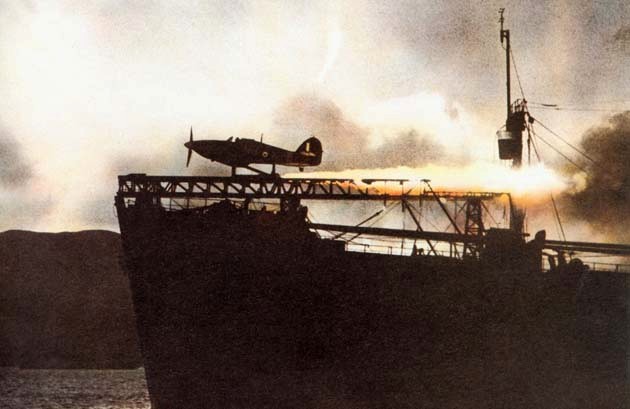
We could have placed F-86 Sabres with swept-wing speed/maneuverability 6 x .50 caliber heavy machine gun superiority over the Castro straight-wing T-33 jets with just 2 x .50 caliber HMGs on a rail on each ship and shot them off with a rocket motor as dawn broke or upon first sign of inbound Cuban planes. After the air cover mission, the SeaSabres would land on the 2506 controlled-Giron air strips and be refuelled and re-armed. The SeaSabres could even have been armed with Sidewinder air-to-air missiles (AAMs) if we didn't mind dropping the DIY pretense.
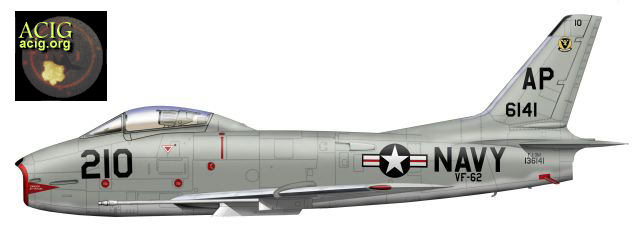
Artist's Conception of Assault Brigade 2506 SeaSabre (painted in FAR colors) launch from Cargo Ship to Gain Air Supremacy
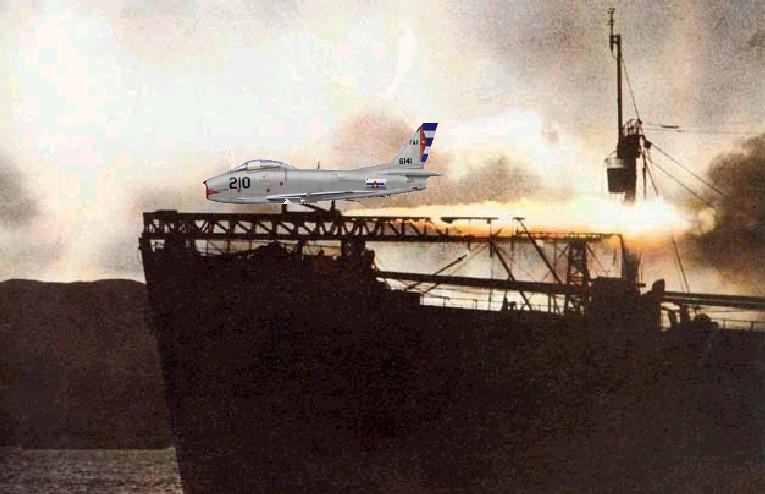
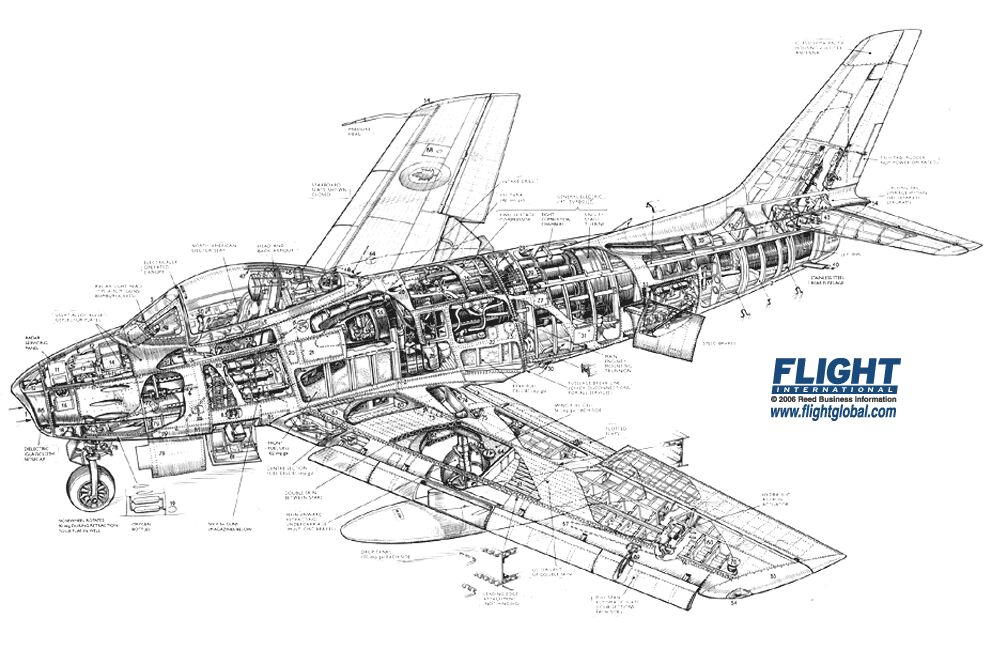
GIDO-9 Tow Fighters to Cuba
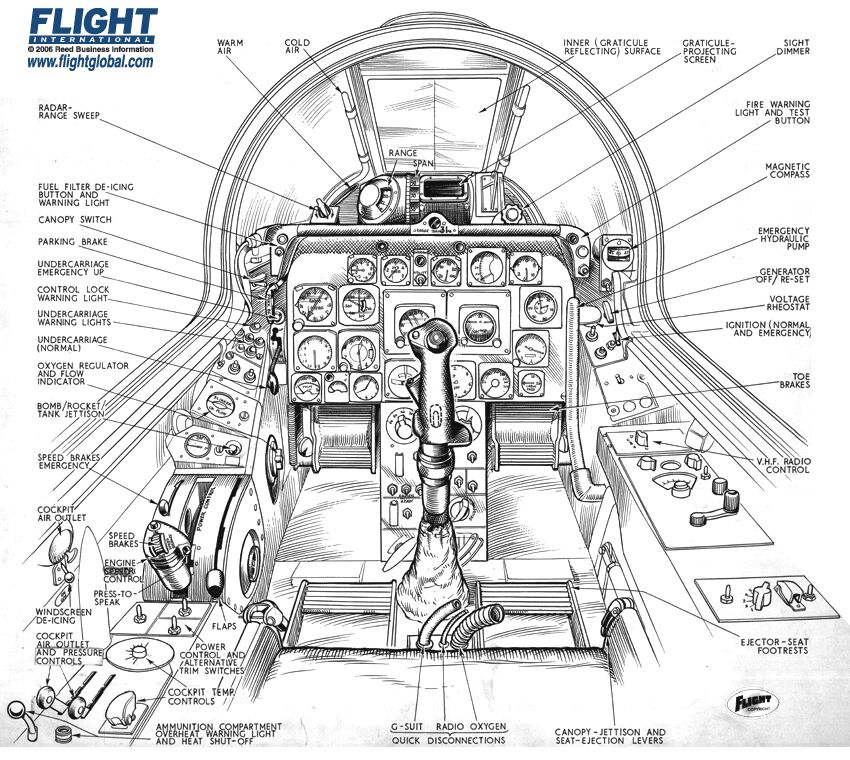
Another option is the FIGHTER TOW (FIGHT-TOW) concept.
combatreform.org/FIGHTTOW.ppt
We have known for a long time that towing an aircraft makes it fly with no power needed from it. Many of us have towed a damaged car for example. If you have, you will notice the problem is braking with a tow rope; if you are not careful the car towing if it slows down, the car being towed will slam into it unless someone is inside to brake it. In aerial towing, the air itself brakes the aircraft being towed because its dead weight that doesn't want to fly unless its propelled by being dragged forward by the tow plane. While its true a tow BAR would be best as it would hold the towed aircraft at a set distance regardless, in the BOP scenario there isn't time to develop such things, but a tow ROPE was well within their grasp as its a proven WW2 means.
Thus, Cuban exile 2506 pilots in F-86s could have been towed by their C-46 or C-54s (probably best by the tail-dragger C-46s) to Cuba to arrive just before dawn, released and then flown fighter CAP protection for the Paratroop drop and allowed the sea cargo ships to off-load.
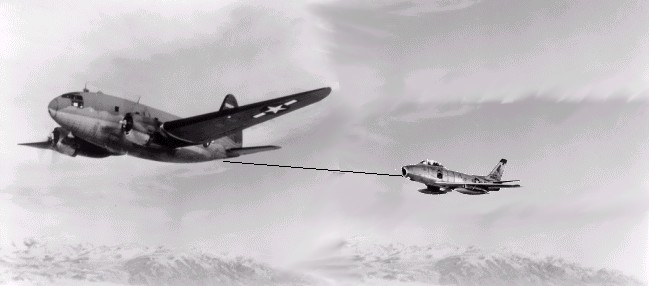
2506 Cuban Exile F-86 Pilots could have Controlled the Skies over Cuba Long Enough for the Brigade to Maneuver to the Escambray Mountains.
GIDO-9B: Helicopter Air-Launch of Jet Fighters from Cargo Ships
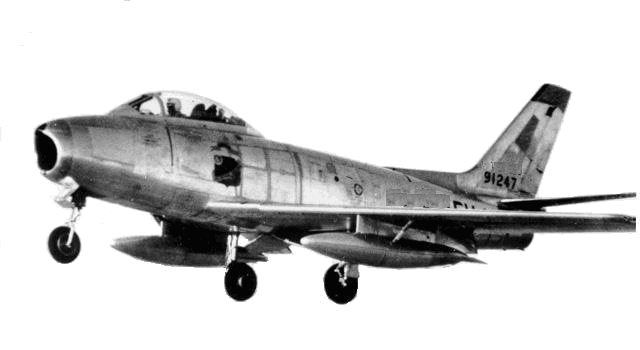
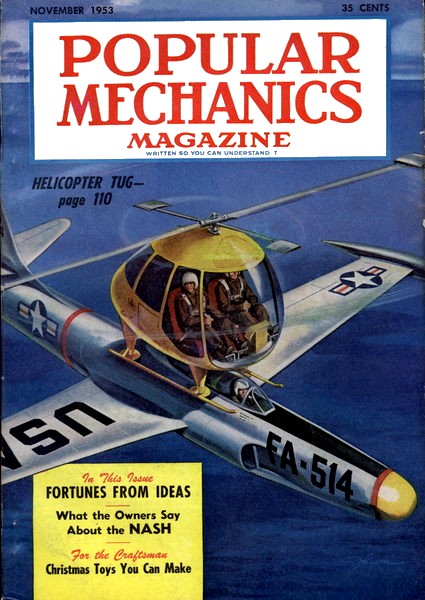
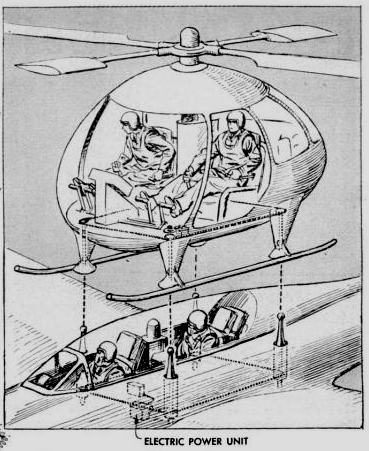
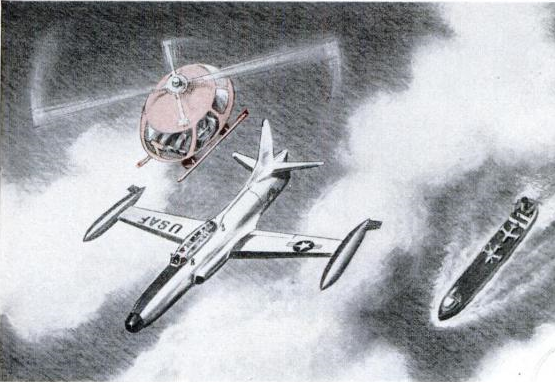
During the AmeroNazi Allen Dulles reign over the traitorous CIA, he had unlimited budgets from Rockefeller man President Eisenhower. Had the "company" thought of it, they could have had purchased special helicopters whose sole purpose would have been to vertically-lift jets like F-86 fighters with engines running idle piloted by Free-Cuban pilots from cargo ships to air-launch them for the Bay of Pigs invasion.
GIDO-10 Air-Mech by M22 Locust Light tank & C-54
C-54s could have delivered M22 Locust Light Tanks to Giron Airfield
The BOP op was damned because MARINE Hawkins conceived it with a fundamental amphibious bias that took too long to get ashore and exposed the entire force to enemy destruction and defeat by supply denial.
2506 could have gotten WW2 surplus M22 Locust light tanks
www.robertsarmory.com/m22.htm
...and used their C-54s to FLY them to Giron airfield after some of their Paras seized it quickly to claim it as theirs to get JFK to release the B-26s to finish-off the Castro T-33s and SeaFuries. The chassis of the M22 would be carried under the fuselage as depicted below and the turret inside the fuselage and lowered on to it after landing. They would have all night to do this.
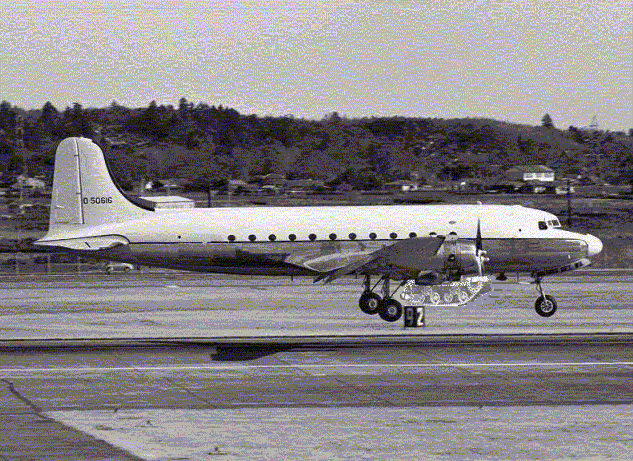
M22 Locust chassis under C-54
They could have marked the runway with lights or even fires if necessary to get inexperienced 2506 pilots to find the runway to land. By sunrise, Giron airport would be under 2506 control, their B-26s would be finishing off the Castro T-33s and SeaFuries and they'd have at least a better than 50-50 chanced to fight their way into the Escambray mountains.
Moreover, the M22 could have been drastically improved in firepower by the 106mm RR turret depicted here: 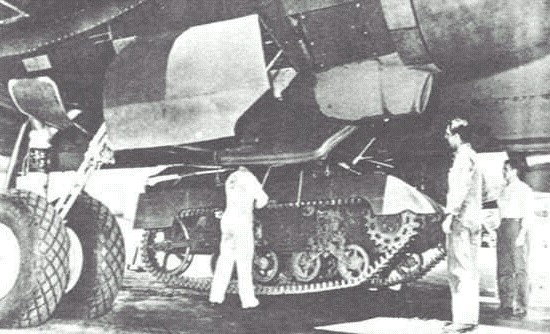
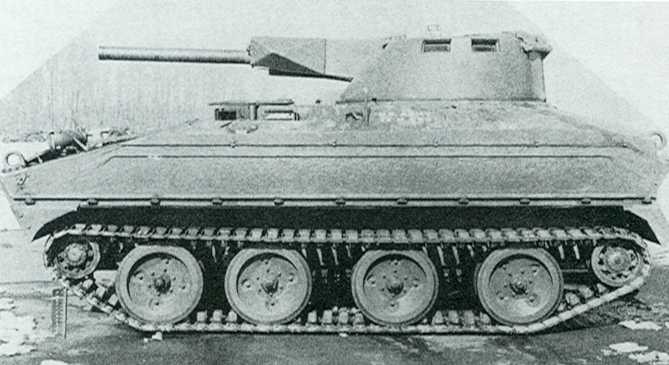
3-Shot, Rapid-Fire 106mm RR Turret developed by the U.S. Army
A 2506 Air-Mech Force could then have helped contain Castro's forces--or better yet acted as a CAVALRY to lead the way to the Escambray mountains.
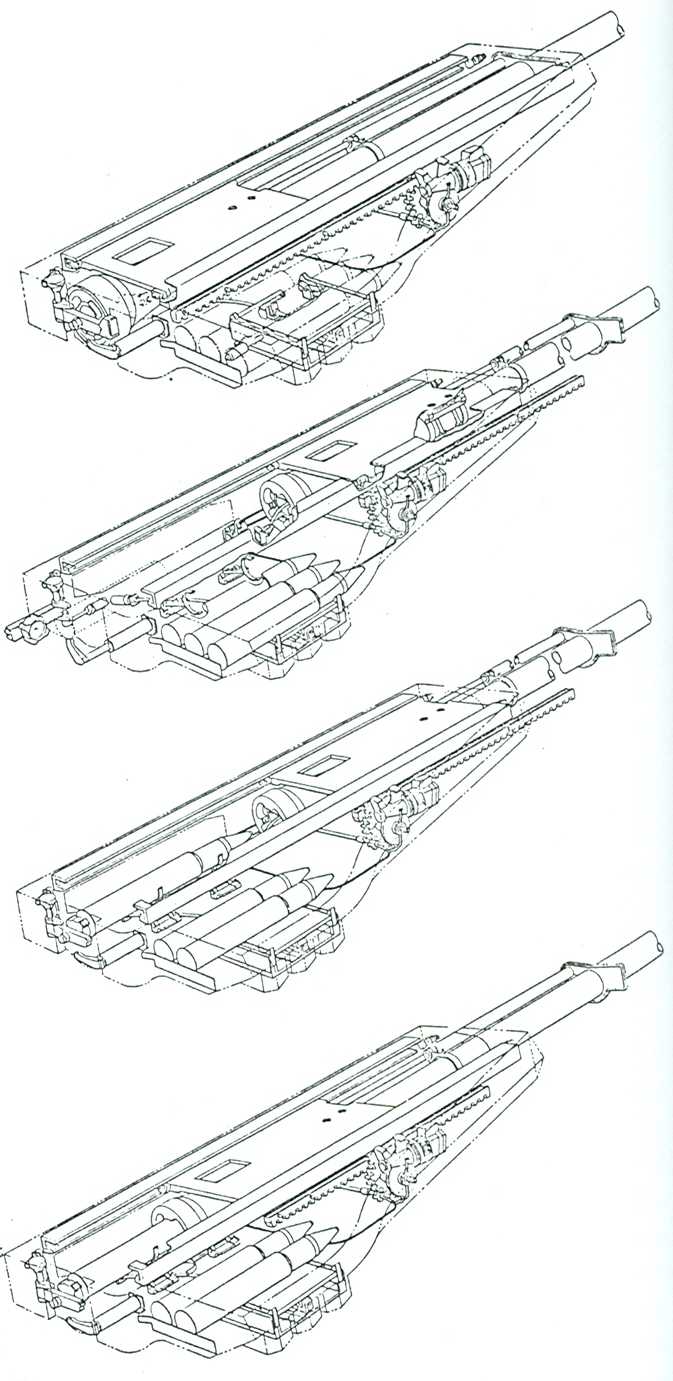
Assault Brigade 2506 Troops and M22 Locust Light Tank Leading the Way!
A retired USAF MSGT writes:
youtube.com/watch?v=AVytnawCRxE
youtube.com/watch?v=FfDxCNIo9Xc
youtube.com/watch?v=EwZU6Kq9F_M
youtube.com/watch?v=lRr14Wd1AtY
Nice size, and certainly could have been better executed.
Note that Detroit diesel engines were in common use prior to BOP and would have
been just as useful to retrofit older AFV hulls
as they currently are in military service.
"While there were difficulties with turret handling mentioned at the time, after
looking at pics of the tank I would have tried a few very simple and dirt-cheap
fixes. They'd be useful on any system whose removable parts make it too tall to
fit desired airlift or container transport.
I'd weld four lifting eyes (tabs with holes for shackles) at the outer edge of the turret. This would make for easy hoisting both into the aircraft and onto
the tank.
The jib crane would be broken down into a set of round tubes in a rack on the
hull. The jib crane boom would have a pulley on the end, and a hand winch would be fitted at the 'operator end' of the boom.
Unload tank hull, drive away, unload turret to the ground, drag the turret
pallet from under the aircraft using the M-22.
Quickly assemble the jib crane, drive tank next to turret, one man winches the
turret while two or three others swing it using ropes and the gun as a handle.
I would have four short tubing sockets welded to the hull just outside the
turret rim that splayed outward a few degrees. Drop four short pieces of pipe
into these and manually rotate slung turret to match with four painted guide
lines on the turret itself. Lower into place, secure turret, pull tubes, done.
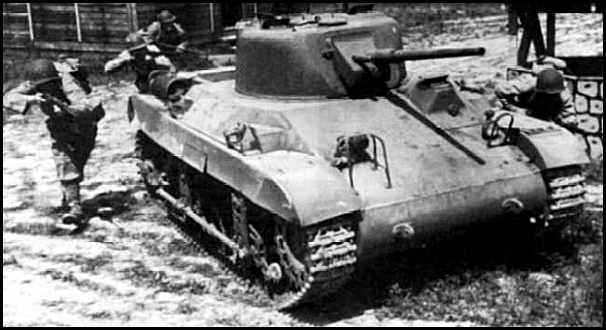
 M22 Locust videos:
M22 Locust videos:
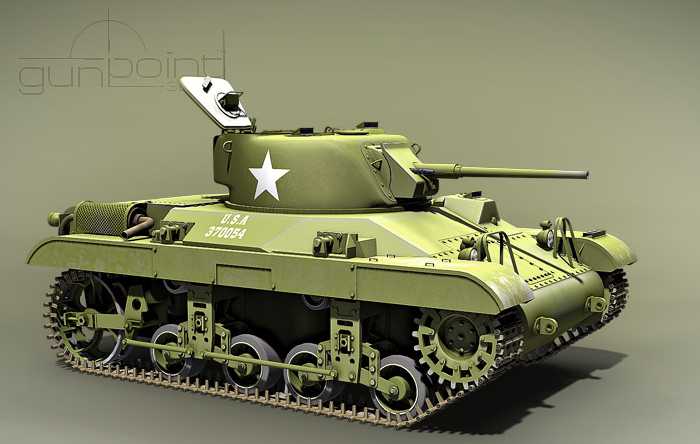
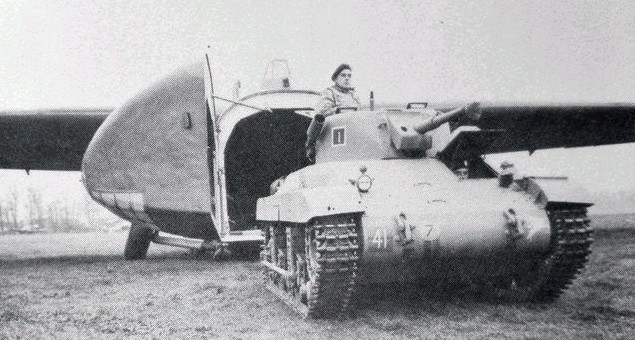
The Locust wasn't a particularly good tank; but much better than no tank at all. Building a better machine in that size would have been easy enough to do by the time of BOP because powerplants had advanced greatly by then.
It could be considered a 'spiritual ancestor' of the Sheridan."
Downstream
OK, you didn't do any of the above GIDO options, your ships with ammo are sunk, your planes are shot down, you are running out of ammo.
What do you do?
In this segment we examine worse-case situation options. What could 2506 done to FIDO (Fuck It, Drive On) a solution?
Amazingly, second-in-command (2IC) Oliva had the right idea.
JFK, Commander San Roman and his excellent 2IC, Oliva
He offered to Commander San Roman that they break-out to the east 51 miles to the Escambray mountains and wage a guerrilla war from there. There were still all their C-46 and C-54 transport planes available to parachute drop supplies to them; crews were qualified to do it in daylight, and eventually with practice could do it at night--OJT.
It was a fantastic and militarily sound idea.
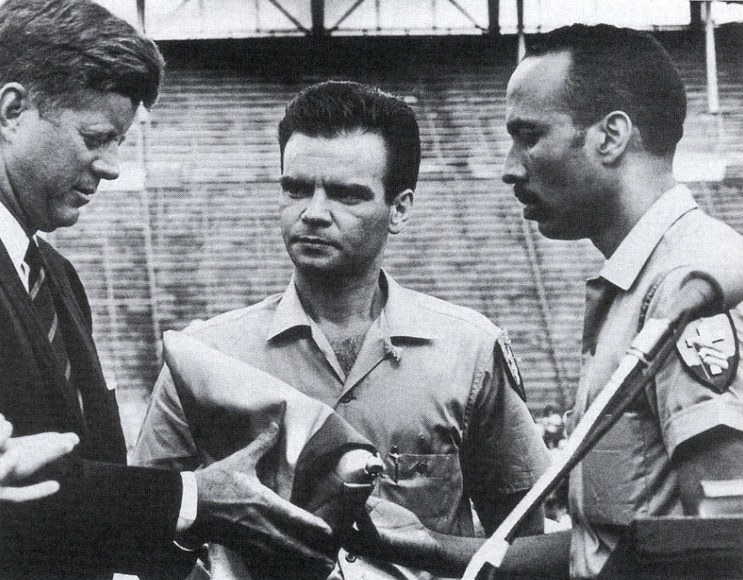
FIDO-1 Use Bicycles

In fact, if the CIA was clever and studied their military history they could have brought folding bicycles to maneuver--just like the Japanese did on Malaya and could have been at the Escambray mountains in a day. Do it at night to avoid Cuban AF attacks even if we didn't have air supremacy.
FIDO-2 Use all your motor vehicles
From what I can tell so far, 2506 had 5 x light tanks, 10 x armored cars and at least 4 x large trucks and 4 x jeeps.
5 x light tanks = 20 men on top = 100 men
10 x armored cars = 20 men on top = 200 men
4 x large trucks = 25 men = 100 men
4 x jeeps = 6 men on top = 24 men
______________________________________________________
Around 500 men or 1/3 of the brigade could move by motor vehicles with 114 dead, it comes to almost half.
Make 2 trips?
51 miles is not going to empty the vehicles fuel tanks to accomplish; nor would a trip back to Giron +51 miles and one last sortie to the Escambray mountains (+51 miles). Do this at night to avoid Cuban AF attacks. 2506 used their motort vehicles to reposition themselves all during the 3 days of battle, so WTFO?
Break-out by fighting to the east, then make your sprint to the Escambray mountains. Leave a rear guard to keep the Castro-led forces coming down from Australia plantation at bay.
FIDO-3 Walk
At 2:30 p.m., brigade commander "Pepe" Perez San Roman ordered radio operator Julio Monzon Santos to transmit a final message from Assault Brigade 2506. "We have nothing left to fight with," San Roman said, his voice breaking, "how can you people do this to us, our people, our country? Over and out."
Sadly, commander San Roman did not heed his subordinate's suggestion and was stubborn and inflexible--to be expected from a former Batista COMBAT ENGINEER officer. Rather than live to fight again, he decided to stay put and continue to let his pinned-down men get pummeled by Castro Cuban artillery and tank-infantry attacks while they were out of ammo. Didn't they teach what "decisive engagement" is at his Army schools? Look at Roman's bio. The CIA did psychological assessments on 2506 leaders to see who would be inclined to stay put and who would move out and fight. They put COMBAT ENGINEER Roman in charge of a maneuvering brigade to make it static-minded to force it into a situation in the open where JFK would have to send-in the U.S. military to rescue it. What's doubly tragic is in 1989 Roman committed suicide--which was totally unnecessary--it was not his fault 2506 failed nor his responsibility because he was not allowed to even plan the operation. He was a COMBAT ENGINEER; he belonged commanding his sappers not maneuvering a brigade. YES, over time a Combat Engineer officer could learn to maneuver a brigade. However, 2506 didn't have the time a regular army unit has to develop itself in peacetime. If we want 2506 to win, you put the most aggressive, flexible, adaptible man in charge, which was clearly Oliva. Have Roman as his deputy or in charge of engineers to block Castro forces with mines/obstacles etc.
http://en.wikipedia.org/wiki/Jose_Perez_San_Roman
José Alfredo Pérez San Román (1930 - 10 September, 1989), known as Pepe San Román, was the commander of
He enlisted in the Cuban Army in 1949 after graduation from high school, when financial problems forced him to give up studying architecture at the
In 1958, he was appointed a professor at the Military Academy. That same year, he was promoted to Captain and named G-3 of the Infantry Division, a post equivalent to Lieutenant Colonel. He was arrested in December 1958, accused of conspiring against the powers of the state. He had been involved in an assassination attempt against Batista. Because of that and his clean service record, San Roman was later released and regained his rank after the Revolution. He formed part of the commission that was created to cleanse the Armed Forces, but was arrested and accused in Case 39/59 in April 1959. San Roman had helped former Commander
In May 1960 he was one of a group of ten former Cuban officers in Miami planning a campaign against the Castro regime. They were graduates of Cuba's military academy, the Cadet School. On 2 June 1960, San Roman and nine fellow "recruits", including his brother Roberto San Roman, were transported by CIA agents to Useppa island off Fort Myers, Florida, for physical and psychological assessments. On 22 June 1960 San Roman and 27 others were taken by land and air to Fort Gulick in Panama for paramilitary training. On 22 August 1960 he flew via CIA C-54 aircraft to San Jose, Guatemala.
At the CIA-run infantry training base known as "Trax Base" in the mountains near Retalhuleu, Pepe San Roman was in charge of weapons and demolition training. In about November 1960, he was appointed Brigade 2506 commander with about 430 recruits in training.
After the Brigade had ceased fighting on 19 April 1961, the third day of the Bay of Pigs Invasion, San Roman and his men scattered into the woods and swamps. He was captured by Cuban militia on 25 April 1961. He was finally released from prison and flown to Miami on 24 Dec 1962.
On 29 December 1962, Pepe San Roman was on stage next to the 35th U.S. President, Pepe San Roman committed suicide in Miami on 10 Sep 1989
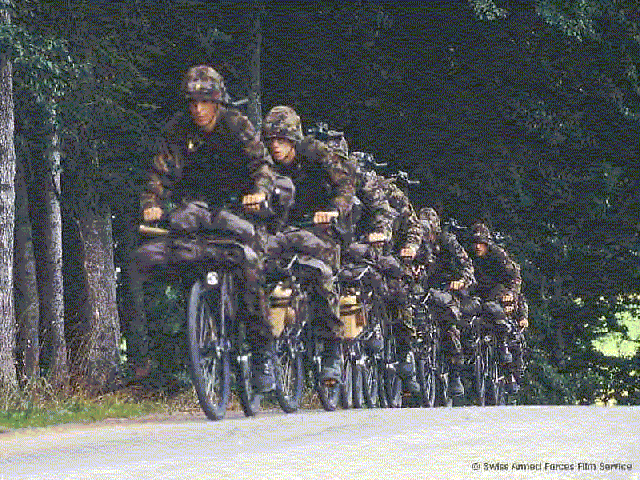
Jose Perez San Roman
References and notes
Bibliography
- Johnson, Haynes. 1964. The Bay of Pigs: The Leaders' Story of Brigade 2506. W.W. Norton & Co Inc. New York. ISBN 0393042634
- Rodriguez, Juan Carlos. 1999. Bay of Pigs and the CIA. Ocean Press Melbourne. ISBN 1875284982
OK, even if you didn't have ANY form of mechanical advantage transportation you can WALK 51 MILES; it will take 3 days but you can do it. Moreover, THIS IS EXACTLY WHAT CASTRO DID IN 1956 when he was defeated in a battle with Batista forces and fled to the Sierra Maestro mountains to recover. And after this, his rebels MARCHED ALL THE WAY ACROSS THE ISLAND TO HAVANA to take the place.
How Castro's Rebels Took Cuba--on foot: How about the 2506 doing something similar from the Escambray mountains (right under Santa Clara caption)
Come on now.
You are telling me 2506 couldn't walk a mere fraction of the distance Castro & company did?
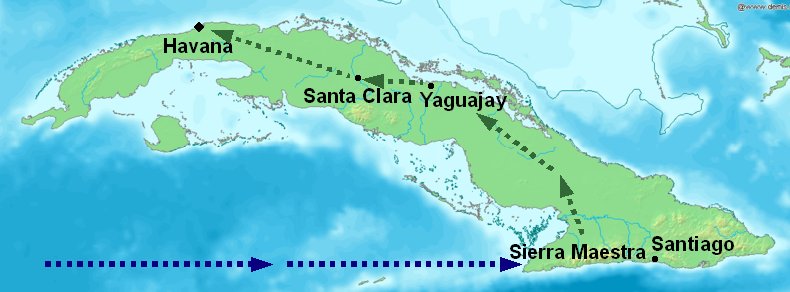
Castro could do it--and he ain't tiny
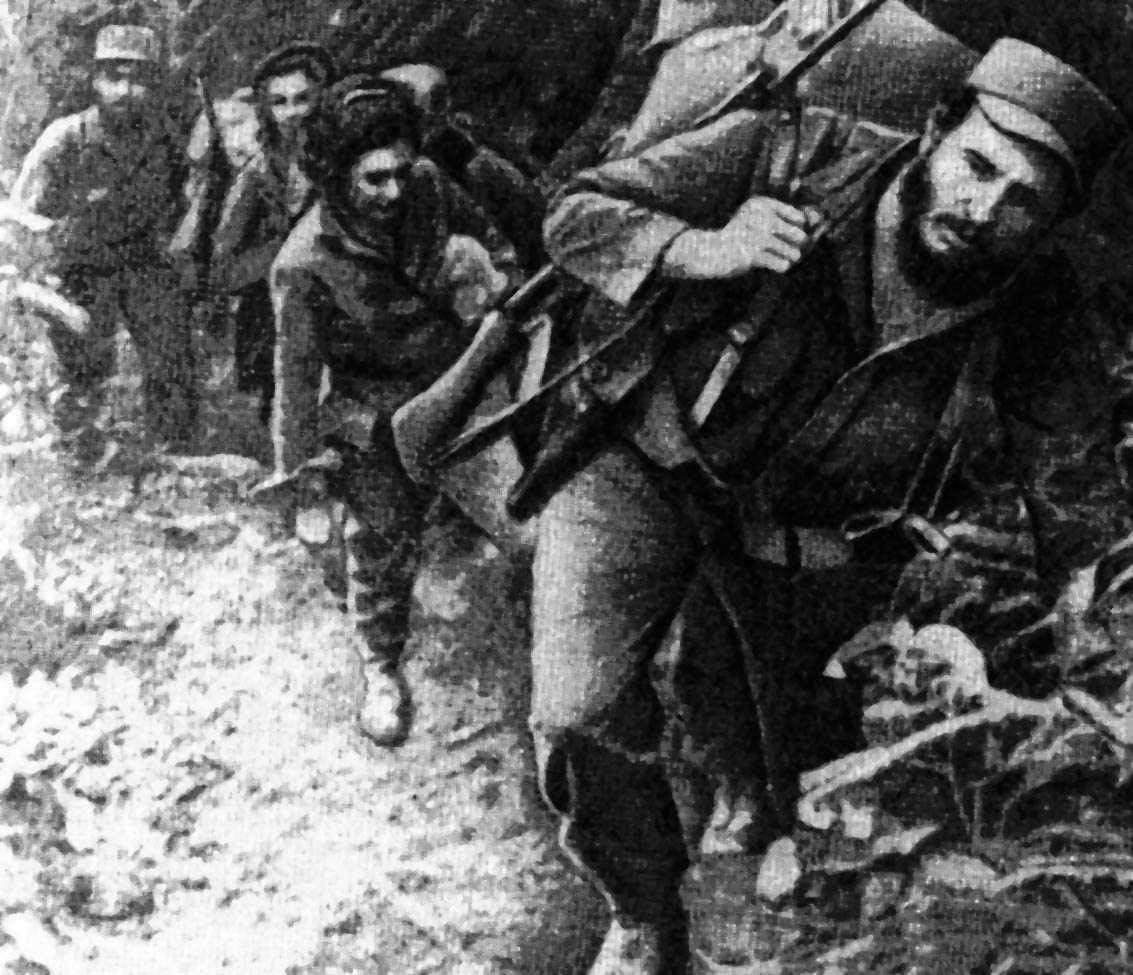
51 miles from Giron' to the Escambray Mountains
Now take a look at the terrain they could hide in once there.
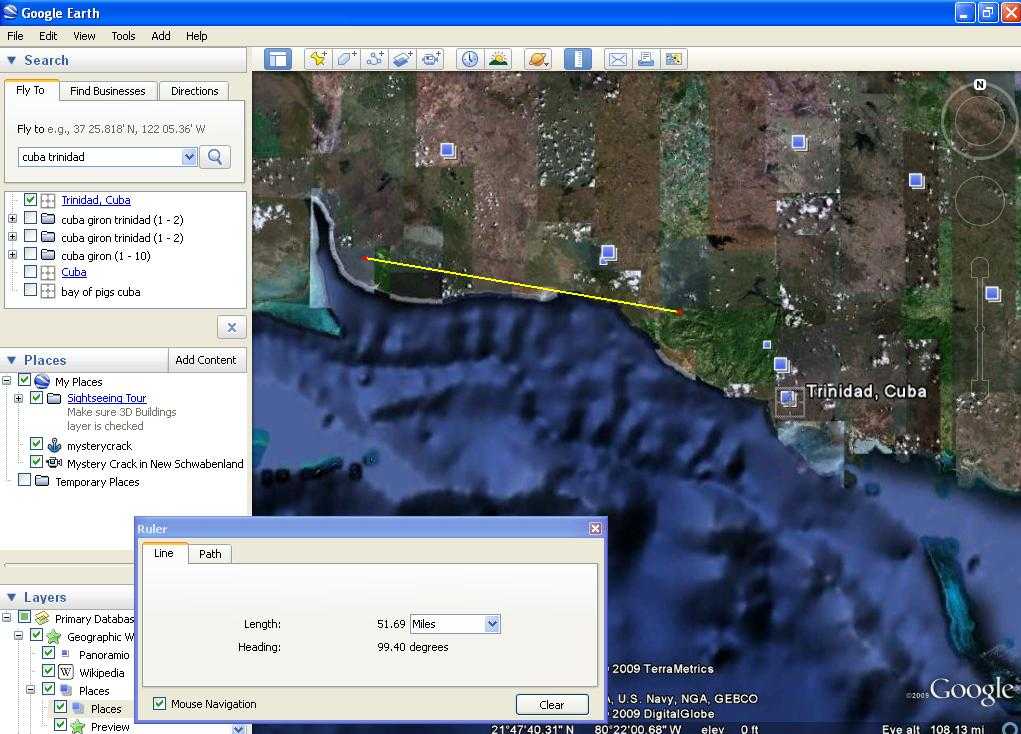
Was JFK Set-up for Failure by the CIA?
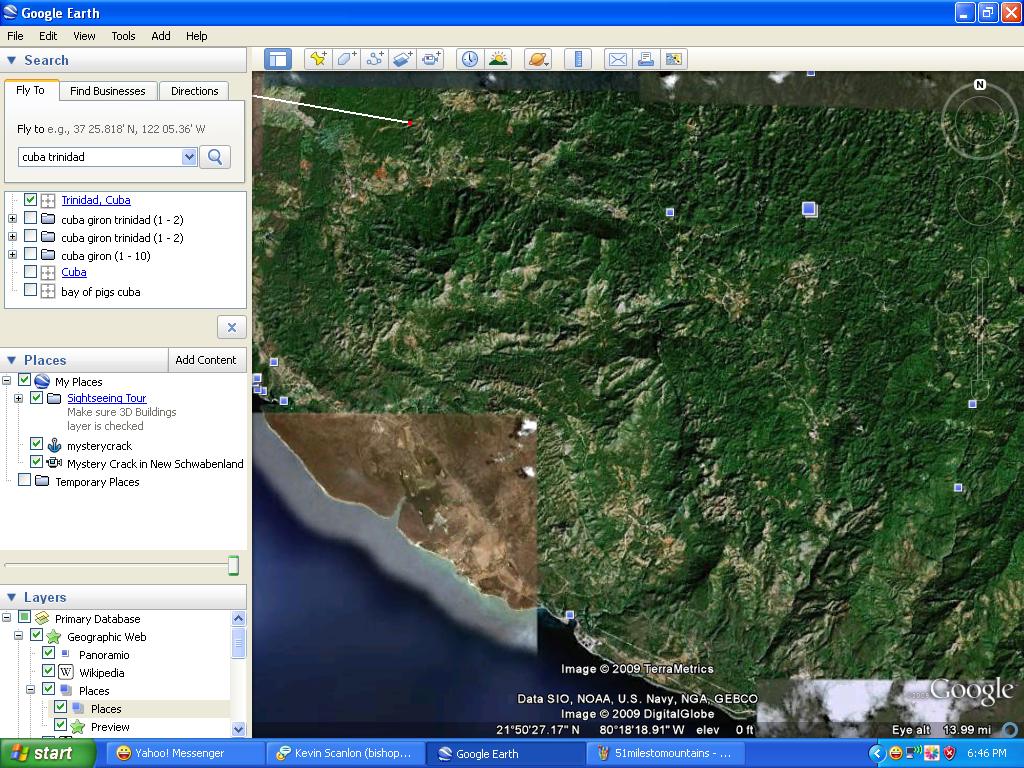
"Ask not what your country can do for you...."
We now know that there WERE ways to win even with JFK's restrictions. Yet:
1.) There was no follow-on sub-plan for 2506 to do anything after landing--no march on Havana; 2506 leaders were not allowed to form the Operation ZAPATA plan and demand this course of action (COA) be included. They were given a set-up for failure.
2.) If there was no uprising, there was no "PLAN B" to move east to the Escambray mountains to wage long-term, guerrilla war. Again, 2506 leaders were locked-out of the planning process to insure they were not shafted--which they were.
3.) The CIA put a COMBAT ENGINEER in command knowing he was inclined to seize & hold rather than maneuver to the Escambray mountains.
Thus, either JFK knuckled under and sent in the U.S. military to rescue 2506 and topple Castro or he would sacrifice 2506 and make them his mortal enemies.
The only conclusion that could be drawn was that the CIA was forcing JFK to do what they wanted--a quick take-over of Castro by the U.S. military or be ruined as "weak on communism". The 2506 heroes should have realized it was the CIA that had screwed them first by a lack of human decency and military respect to have them participate in the plans and allowed that plan to be one with back-up COAs to insure at the very least they withdrew in good order.
Tarpley writes:
www.tarpley.net/bush8b.htm During the early 1950's, E. Howard Hunt had been the CIA station chief in Mexico City. As David Atlee Phillips (another embittered JM/WAVE veteran) tells us in his autobiographical account, The Night Watch, Howard Hunt had been the immediate superior of a young CIA recruit named William F. Buckley, the Yale graduate and Skull & Bones member who later founded the National Review. In his autobiographical account written during the days of the Watergate scandal, Hunt includes the following tirade about the Bay of Pigs: "No event since the communization of China in 1949 has had such a profound effect on the United States and its allies as the defeat of the U.S.-trained Cuban invasion brigade at the Bay of Pigs in April 1961.
Out of that humiliation grew the Berlin Wall, the missile crisis, guerrilla warfare throughout Latin American and Africa, and our Dominican Republic intervention. Castros' beachhead triumph opened a bottomless Pandora's box of difficulties that affected not only the United States, but most of its allies in the Free World. These bloody and subversive events would not have taken place had Castro been toppled. Instead of standing firm, our government pyramided crucially wrong decisions and allowed Brigade 2506 to be destroyed. The Kennedy administration yielded Castro all the excuse he needed to gain a tighter grip on the island of Jose Marti, then moved shamefacedly into the shadows and hoped the Cuban issue would simply melt away." [9]
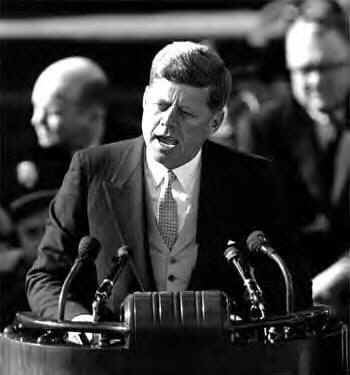
In response to the failed BOP invasion, Castro had Soviet Russia place Surface-to-Surface ballistic Missiles (SSMs) in Cuba causing the crisis in 1962 that almost lead to nuclear WW3
Hunt was typical of the opinion that the debacle had been Kennedy's fault, and not the responsibility of men like Allen Dulles and Richard Bissell, who had designed it and recommended it. After the embarrassing failure of the invasion, which never evoked the hoped-for spontaneous anti-Castro insurrection, Kennedy fired Allen Dulles, his Harrimanite deputy Bissell, and CIA deputy Director Charles Cabell (whose brother was the mayor of Dallas at the time Kennedy was shot).
During the days after the Bay of Pigs debacle, Kennedy was deeply suspicious of the intelligence community and of proposals for military escalation in general, including in places like South Vietnam. Kennedy sought to procure an outside, expert opinion on military matters. For this he turned to the former commander in chief of the Southwest Pacific Theatre during World War II, General Douglas MacArthur. Almost ten years ago, a reliable source shared with one of the authors an account of a meeting between Kennedy and MacArthur in which the veteran general warned the young president that there were elements inside the U.S. government who emphatically did not share his patriotic motives, and who were seeking to destroy his administration from within. MacArthur's warned that the forces bent on destroying Kennedy were centered in the Wall Street financial community and its various tentacles in the intelligence community.
It is a matter of public record that Kennedy met with MacArthur in the latter part of April, 1961, after the Bay of Pigs. According to Kennedy aide Theodore Sorenson, MacArthur told Kennedy, "The chickens are coming home to roost, and you happen to have just moved into the chicken house." 10 At the same meeting, according to Sorenson, MacArthur "warned [Kennedy] against the committment of American foot soldiers on the Asian mainland, and the President never forgot this advice." 11 This point is grudgingly confirmed by Arthur M. Schlesinger, a Kennedy aide who had a vested interest in vilifying MacArthur, who wrote that "MacArthur expressed his old view that anyone wanting to commit American ground forces to the mainland [of Asia] should have his head examined." 12 MacArthur restated this advice during a second meeting with Kennedy when the General returned from his last trip to the Far East in July, 1961.
It cannot be the task of this study to even begin to treat the reasons for which certain leading elements of the Anglo-American financial oligarchy, perhaps acting with certain kinds of support from continental European aristocratic and neofascist networks, ordered the murder of John F. Kennedy.
Kennedy was acting like a man who thought he was president of the United States, violating the collegiality of oligarchical trusteeship of that office that had been in force since the final days of Roosevelt. Kennedy furthermore had two younger brothers who might succeed him, putting a strong presidency beyond the control of the Eastern Anglophile Liberal Establishment for decades. George Bush joined in the Harrimanite opposition to Kennedy on all of these points.
Bay of Pigs: Implications for Future War
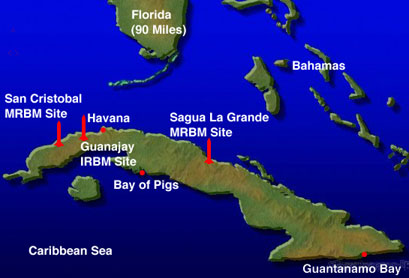
It would be comical--if it were not tragic and involving the destruction of human lives.
Bureaucracies want QUANTITY--it may not be enough
The U.S. military has NOT learned from the BOP in 1961, nor the Vietnam war thereafter as best expressed by James Gibson, author of TechnoWar.
Playlist
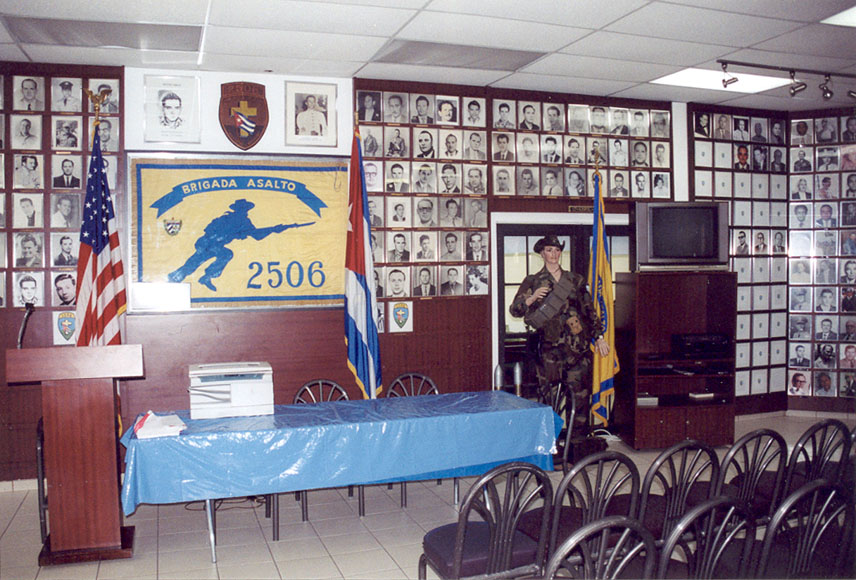
 www.youtube.com/view_play_list?p=09D70D12D6216847
www.youtube.com/view_play_list?p=09D70D12D6216847
The essential problem in the U.S. military is its a BUREAUCRACY--not a profession that thinks. Without this, none of the details will matter to racketeers who want to QUANTIFY every problem to maximize greed and ego. The CIA is of course a bureaucracy, most people realize and accept. What most people do not understand is the subtle but hugely pivotal reality that THE CIA IS NOT WORKING ON THE AMERICAN PEOPLE'S BEHALF. The CIA bureaucracy that we wink at and tolerate its dirty deeds is actually working for the EVIL GOALS of the secret elites. In the BOP fiasco, its hard to with certainty figure out the secret elite's goals because both JFK and Dulles were incommunicado as the operation unfolded--making it likely to FAIL. Fail as in COMPLETELY--not fail a little bit and then the U.S. military takes-over and topples Castro.
What do the Secret Elites Want?
Commonthink is that the secret elites wanted Cuba back to get their gambling rackets back, but there is also the possibility that the Rockefeller and Rothschild Illuminatis in co-operation wanted Castro to remain in power to be a convenient thorn-in-America's side to increase defense budgets and if a war broke out like a nuclear one--depopulate the planet as per their goals. In other words, there was and is a bigger bogeyman pay-off if Cuba remained communist than if it were free. The small secret Mafia elite's wishes are trifles to the Illuminati's goals.
Win TBATE First
Beach at the BOP
Stepping back from what the secret elites want and going downstream into military application, the BOP shows again the U.S. military bureaucracy's penchant to QUANTIFY war and reject professional military art, which is no surprise. Castro had bigger numbers, so we needed even bigger numbers, couldn't get it with 1500 men in 2506, so we used them as bait to get the U.S. military to add their superior numbers. The same "surge" mentality was tried in Vietnam and failed because it doesn't correct the QUALITATIVE problems like in the case of South Vietnam, the government there was corrupt and unpopular and its borders were not secured by a physical line of fortifications, making it open to all kinds of infiltration from North Vietnam. We need a sensor-security fence on the AFPAK border like was successful for the French in Algeria (Morice Line), the Finns against the Red Army (Mannerheim Line) secures Israel today and is under construction in Saudi Arabia to keep Iraq's problems from spilling over into them. The U.S. military populated by gunslinger MANEUVER narcissists be it flood-the-place-with-foot-gunslingers or stampede armored tanks like cattle, refuses to accept the primacy of the Earth itself to human behavior and employ COMBAT ENGINEERING means so it works for us and not the enemy. Ironically, sound maneuver advice from the U.S. military was embedded in the TRINIDAD Plan in a qualitative, economy-of-force way using the Escambray mountains of the Earth in our favor--but was rejected by JFK for a secret spy, covert action principle of deniability--that was not plausible for a force of 1500 men with tanks, airplanes and ships. Quantity--even as low as a brigade simply cannot pass off as a small rebel band coming together using private funds.
As a bureaucracy, the U.S. military does not understand the moral, qualitative aspects of human life as it seeks to regimentize all the people inside its ranks and throw bodies and machines and money at every problem. The current USMIL bureaucracy does not understand the moral plane of war nor wants to. Its no surprise that its surprised at the popularity of a Castro or a VC or a NVA nor miscalculates and expects uprisings to sprout on their cue. The re-emergence of the Taliban rebels in Afghanistan plays right into secret elite goals for drug profits and to de-stabilize the area to the point of an Indo-Pakistani nuclear war for de-population purposes. That we have resorted to bribing rebels to not attack us in Iraq is no surprise. The CIA has long used bribery to recruit traitors in our enemy's midst when the TRUTH of our cause should be our primary means. Our Freedom cause, corrupted by secret elite profiteering and depopulation doesn't convince people in the Third World as it once did and requires we get our house in order and remove them from steering our nation's course. A professional U.S. military/CIA could have convinced JFK to take a better COA like having 2506 take an island or part of Cuba. Cuba is a huge island surrounded by water asking for invasion by sea and air; once a rebellion to Castro had grown from the rival Free Cubans, we could always invade the main island when ready.
TBAM--U.S. Military in same Predicament as 2506?
On an even more ominous note, the U.S. military itself is headed for a replay of the plight of 2506 in its first military invasion against a foe with precision-guided munitions that will sink our bloated surface ship WW2 re-enactment club. Our USN bureaucracy has placed all our at-sea air cover onto too few baskets--huge aircraft carriers that will be spotted and easily sunk when swarms of PGMs flood their meager defenses. The cocky and corrupt, foot-slogger USMC will possibly find itself stranded ashore like it was on Guadalcanal in 1942, but suffer an unhappy 2506-like ending when its overwhelmed on the ground by enemy tanks and artillery. This warning was later given in the 1982 Falklands war:
www.combatreform.org/falklandslessonsnotlearned.htm
The USMIL has the same gene of TBAM weakness as 2506 had--if it cannot get the necessary means to the fight in an ego-gratifying and grandiose way, it will not do it at all, inviting military defeat. When 2506 was faced with no fighter plane air cover, the unimaginative planners chose to solely rely on striking the enemy air force on the ground instead of improving their technotactical means by seaplane fighters or towing fighters by long-range transport planes. The USMIL wants the expensive aircraft carrier, the large air bases, the bloated surface ship to project power in style and 3 square-meals-a-day comfort. And this comfort is going to kill us. When the USMIL goes ashore, its so lazy it wants to not have combat vehicles to maintain and live in tents for a short duration war. If the war lingers, they demand permanent bases be built to transplant their comfy garrison lifestyle ashore. Instead of being fully tracked, M113 Gavin and larger tank mechanized, portable and fully climate and enemy weapon protected in ISO shipping container BATTLEBOXes, the USMIL wants to increasingly foot-slog from comfortable FOBs. We are asking to be overmatched by an enemy who combines his arms with a fully armored and cross-country-mobile infantry force in tanks that can maneuver against us as artillery drops to keep us pinned down. Our kinetic energy (KE) gunslinging has totally overlooked the reality that High explosives (HE) dominate the modern battlefield:
www.combatreform.org/highexplosives.htm
So many in the USMIL scoff at the BOP as a "bargain basement" amphibious/airborne operation not realizing we are likely to place ourselves in the same kind of out-numbered and out-classed position in the near future. What happened to 2506 has already happened to the USMIL:
1941: Wake Island (no Plan B for escape)
1942: Bataan/Coregidor (out of food)
1950: Task Force Smith (wrong type of weapons, ammo, vehicles)
1983: Beirut: (no ammo, wrong weapons, no obstacles)
So don't even try to say the USMIL would not react exactly as San Roman did and wait for a mythical "Great Pumpkin" to come save the day. We passed on American military malpractice onto the 2506 Cuban exiles and they paid for it with their lives. Our turn to pay for our stupidity is coming unless we wake up and reform our attitudes and methods and equipment into a humble, objective, professional approach.
NOTES
Isla de la Juventud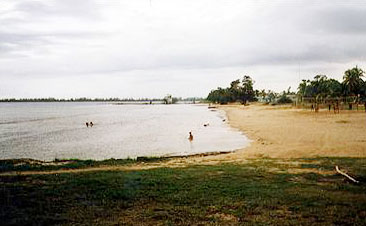
www.cubahotelbookings.com/travel-guide.asp?lID=1&pID=3
Cayo Largo del Sur
Cayo Largo del Sur, also known simply as Cayo Largo, although only a relatively small 17 miles (27 Km) long island it is blessed with an almost continuous stretch of pretty beach, notably along its south coast. There are six beaches all of which will be able to satisfy your sun and sand lust: Playa Sirena, Playa Lindaman, Playa Blanca, Playa los Cocos, Playa Tortuga and Playa Luna.
Isla de la Juventud (Isle of Youth), is situated about 100km off the south coast of mainland Cuba, is home to some of Cuba's most important agricultural farmland and is a key producer of citrus fruits for export. The standard of living is generally higher, largely due to the preponderance of well-cultivated, arable land which makes the problem of food shortages less pronounced than on the mainland.
The Isle of Parrots, The Isle of Pirates, The Isle of Treasure, The Isle of Pines and nowadays, The Isle of Youth are the different names that this island has received. Columbus discovered it on his second journey to the New World.
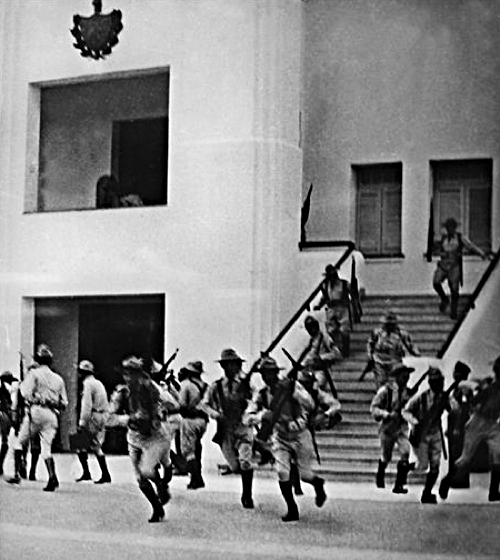
Moncado
Barracks Soldiers React to Castro's Rebel AttackFrom 1953 to 1955, Cuban leader Fidel Castro was imprisoned in the Presidio Modelo on the Isla de la Juventud by the regime of Fulgencio Batista after leading the failed July 1953 attack on the Moncada Barracks in the Oriente Province.
Castro without a beard (!) and on the far right (ironic choice of words, huh?)
The island is split into two fairly distinct topographical sections, north and south, and is dissected by a large swamp which runs from the southeast coast to the southwest coast. The north is generally flat and dry although there are a few marble hills near Nueva Gerona and the area is heavily farmed for citrus fruits. The harvesting of the grapefruit in January is marked by one of the country's biggest and best festivals.
The beaches in the north are black sand and generally disappointing, in the south there are some superb white sand beaches, so if you want a holiday centered around palm-fringed beaches and calm crystal-blue seas then the south coast of the Isle of Youth is a good a place as any.
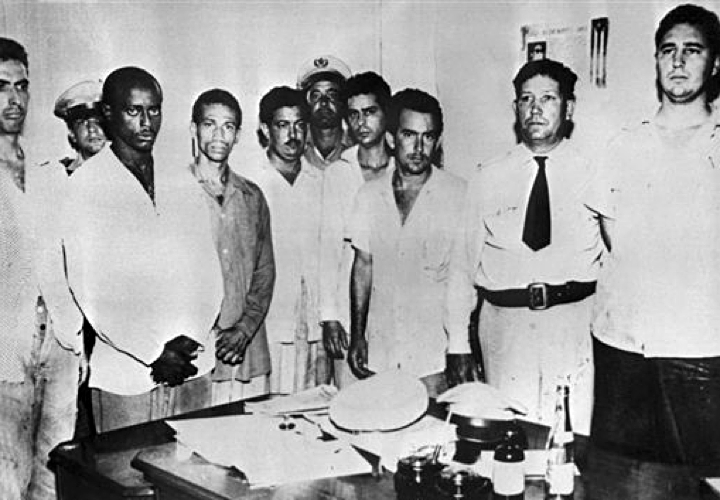
FEEDBACK!